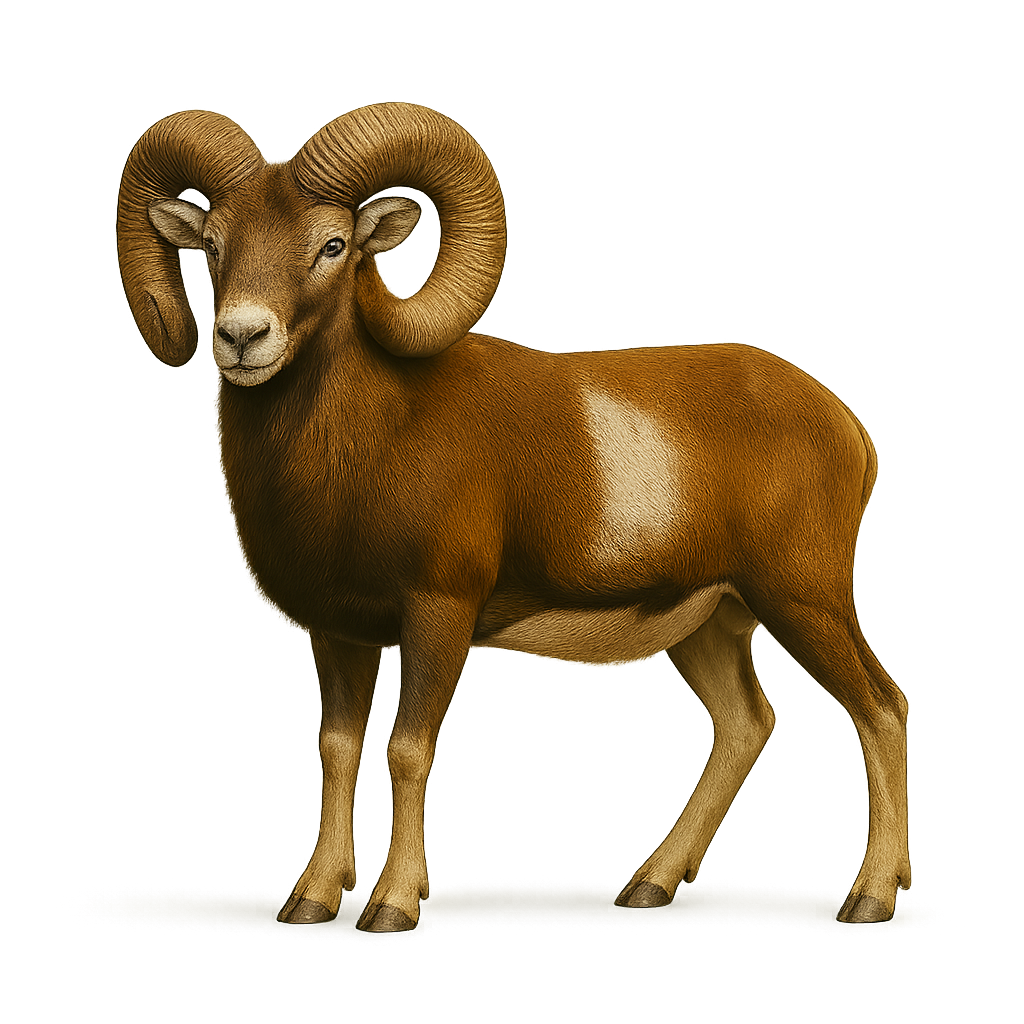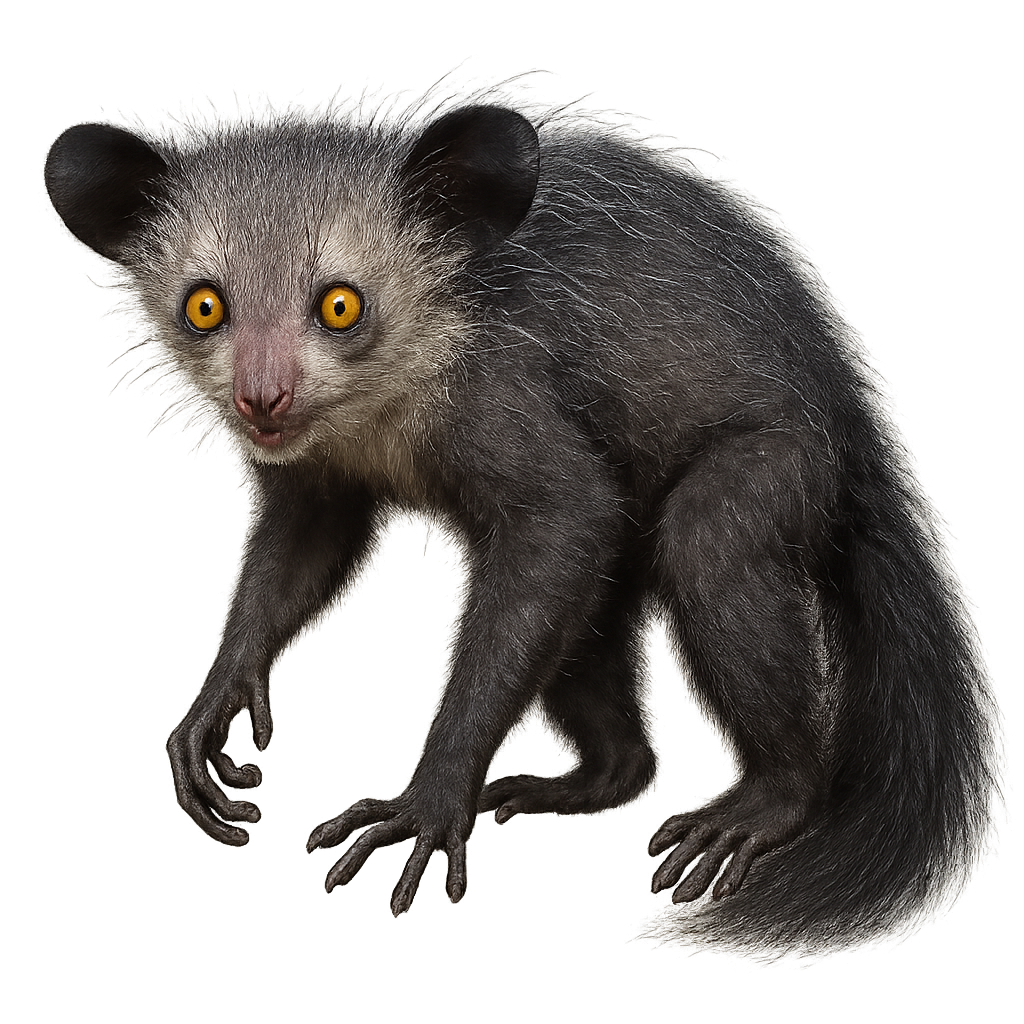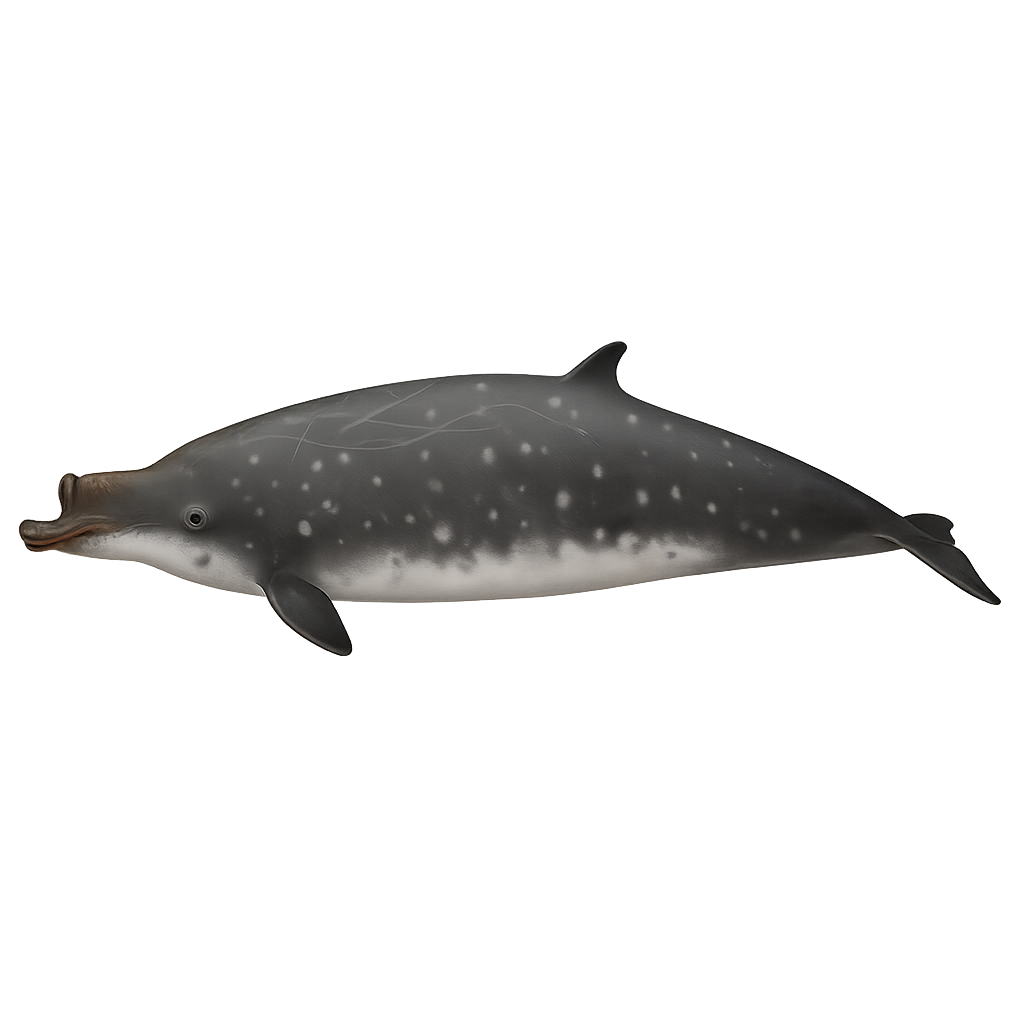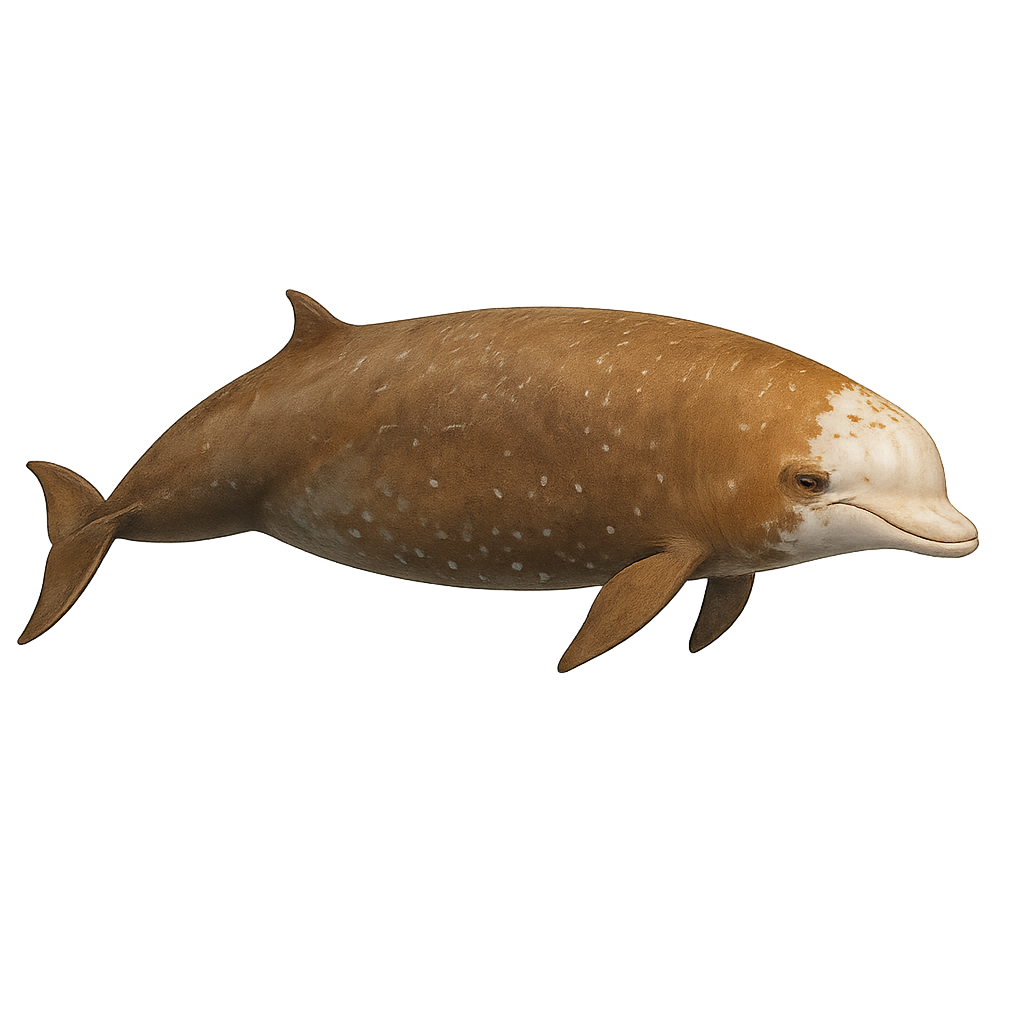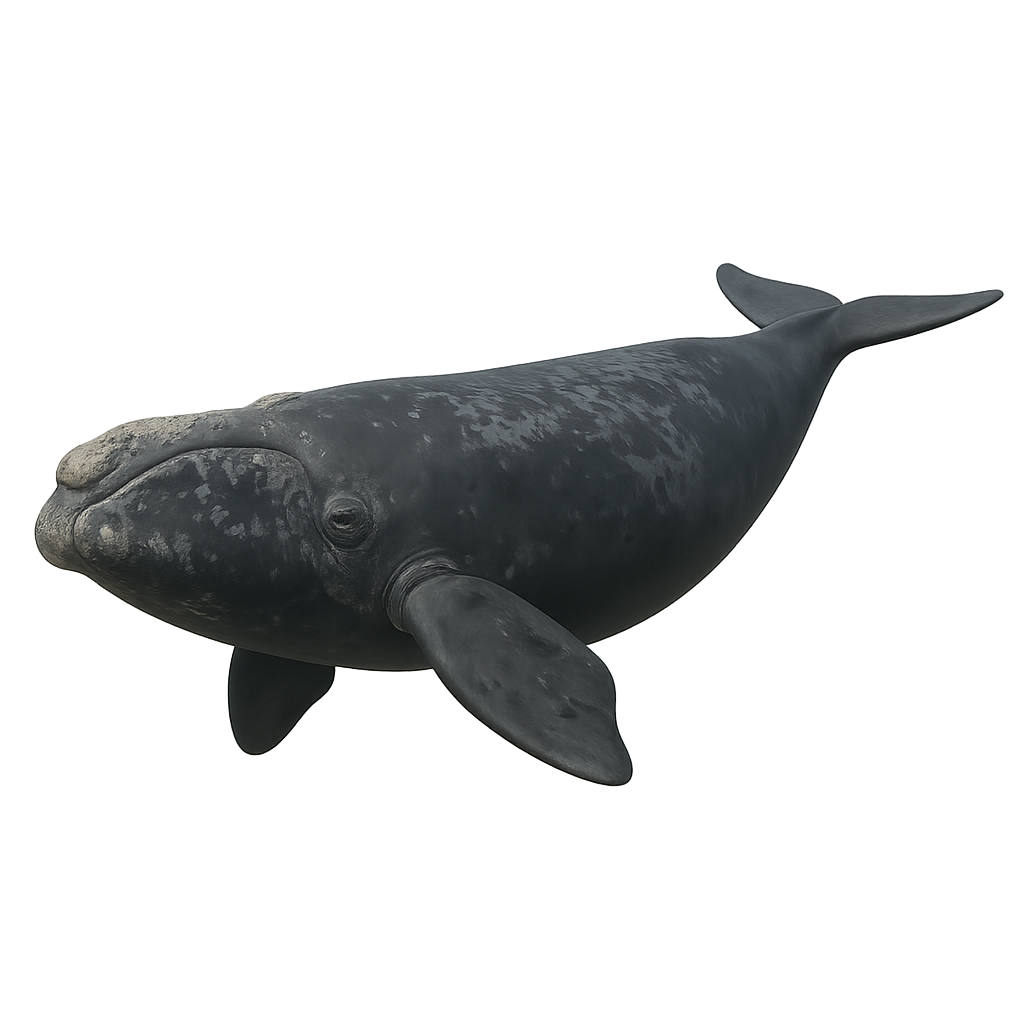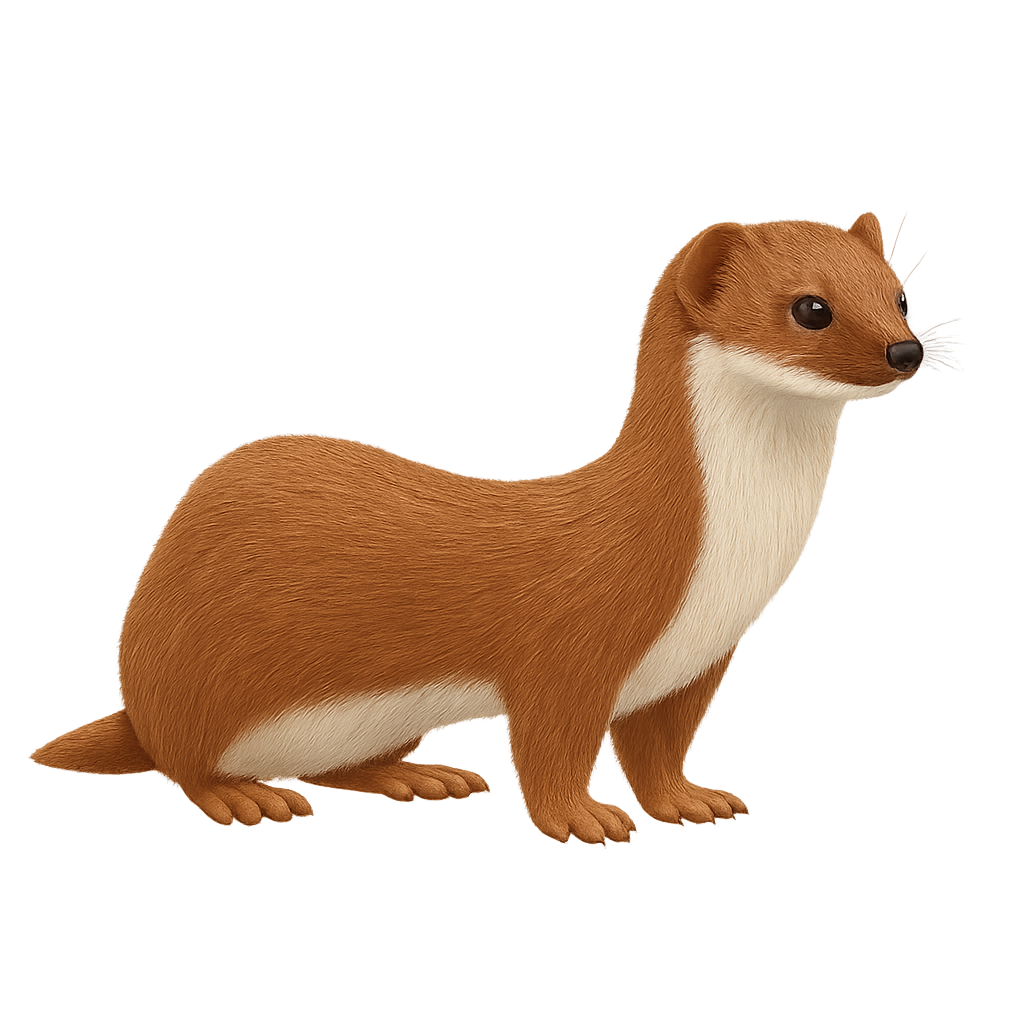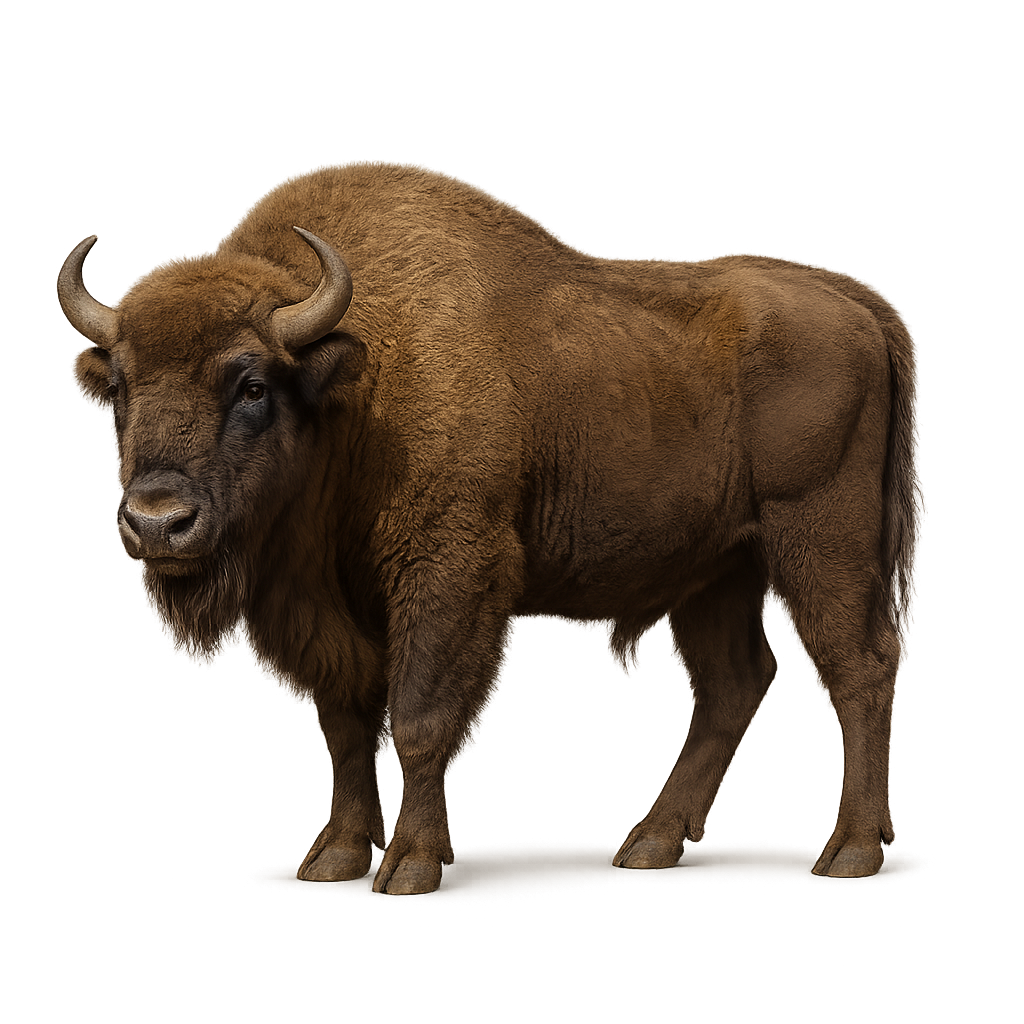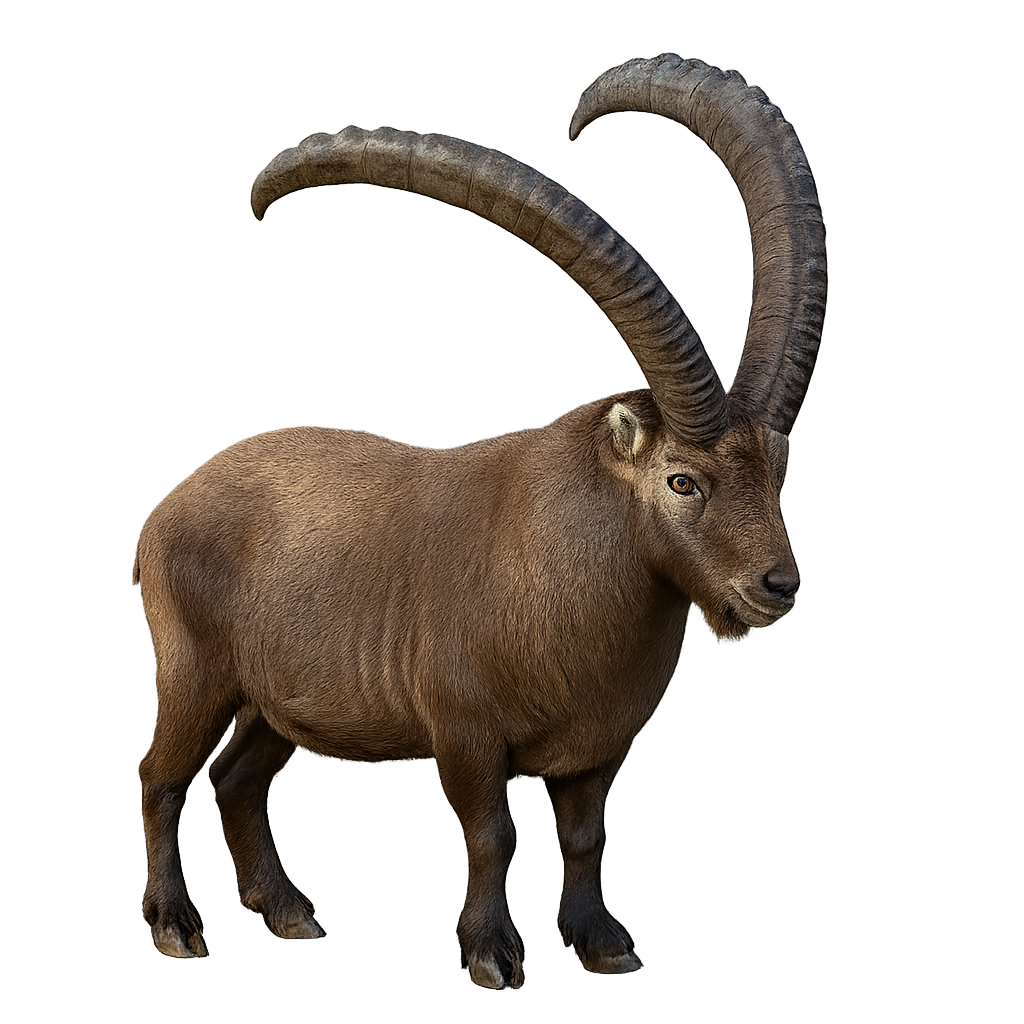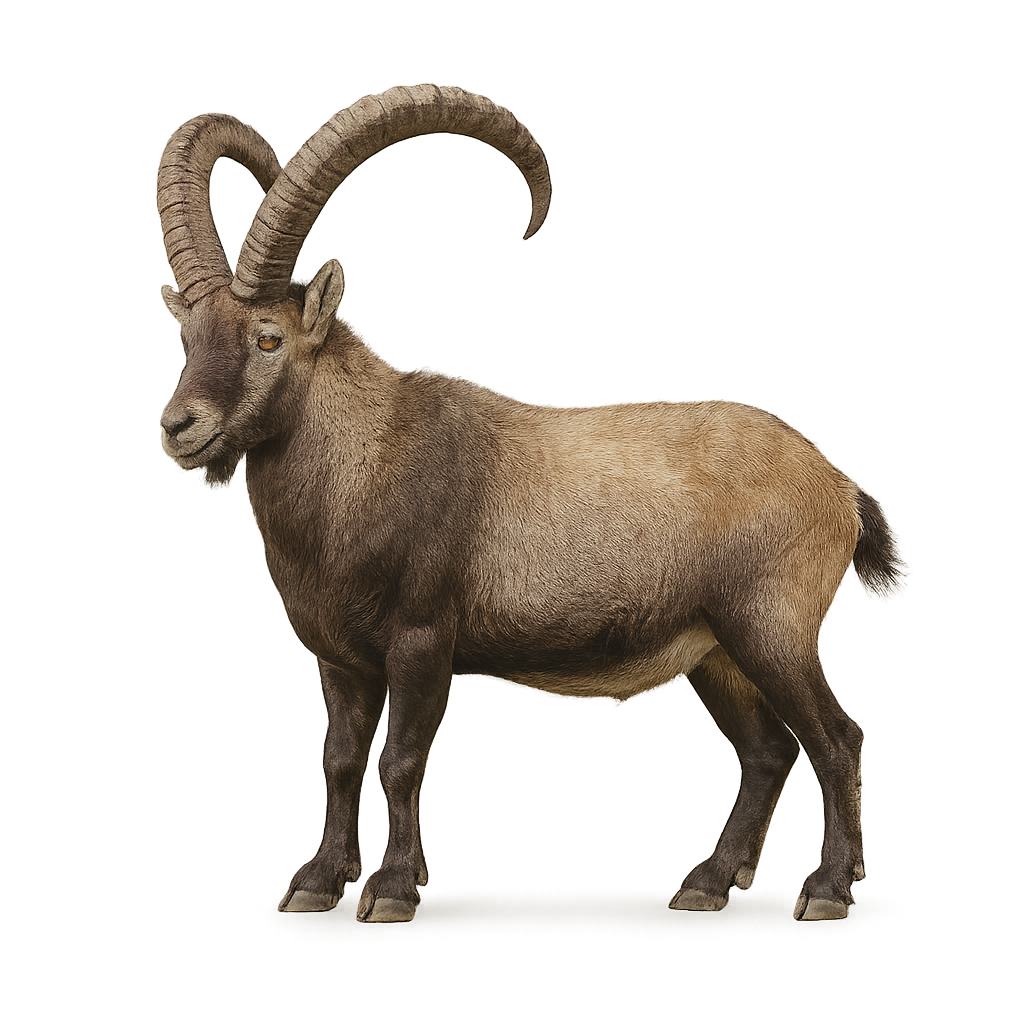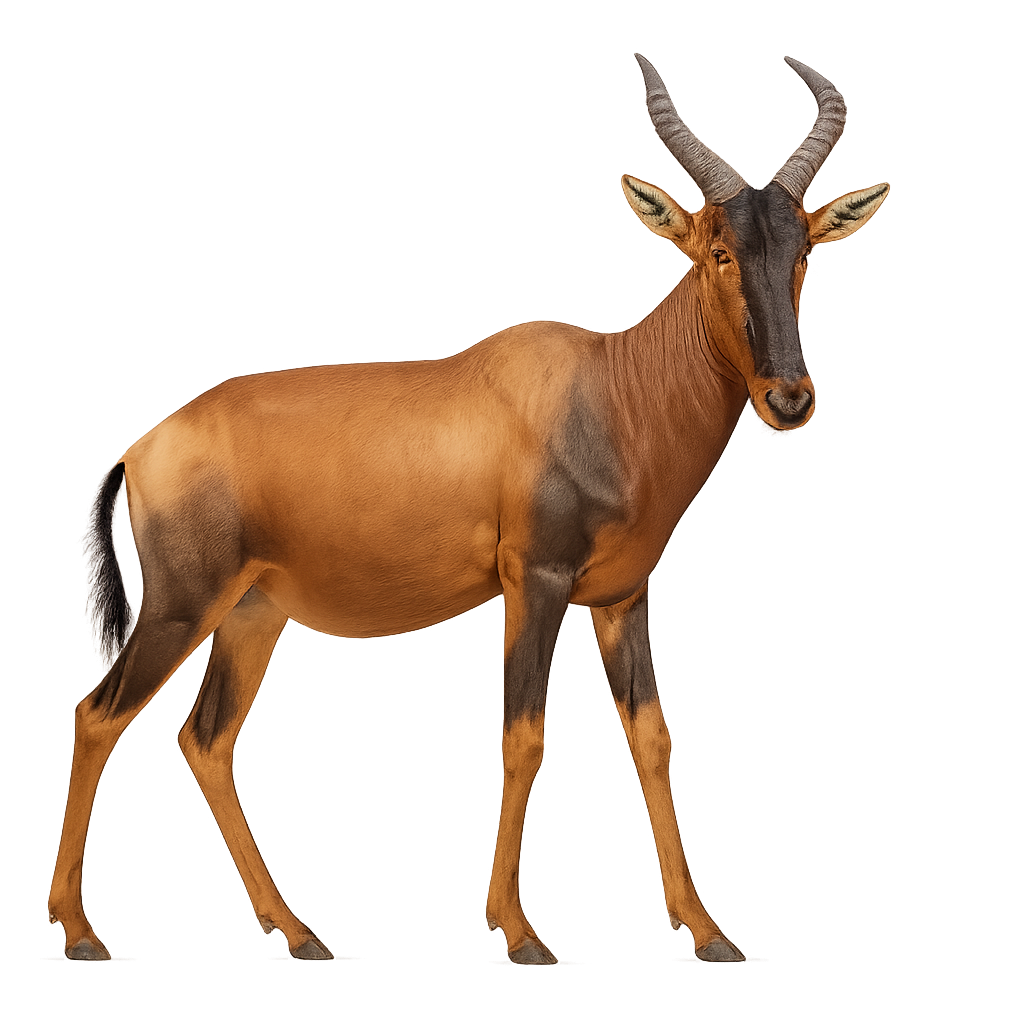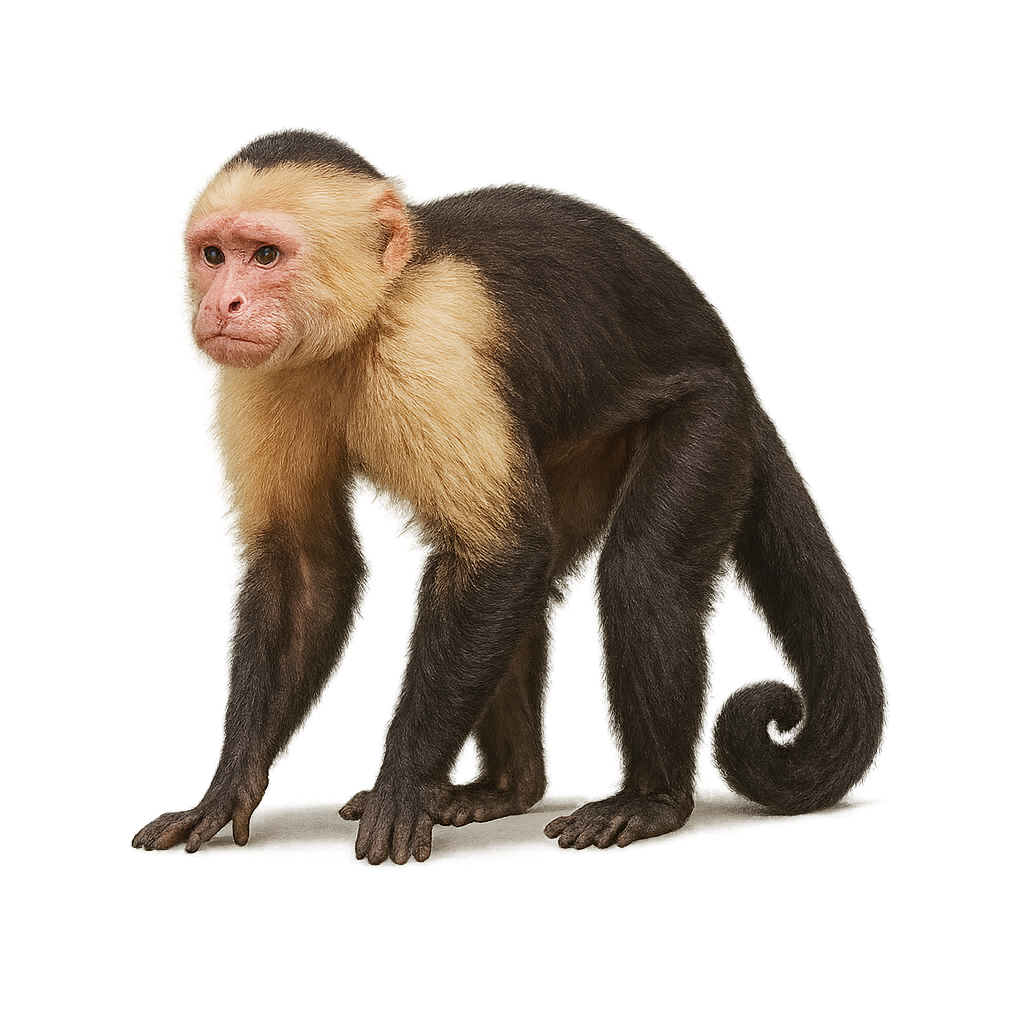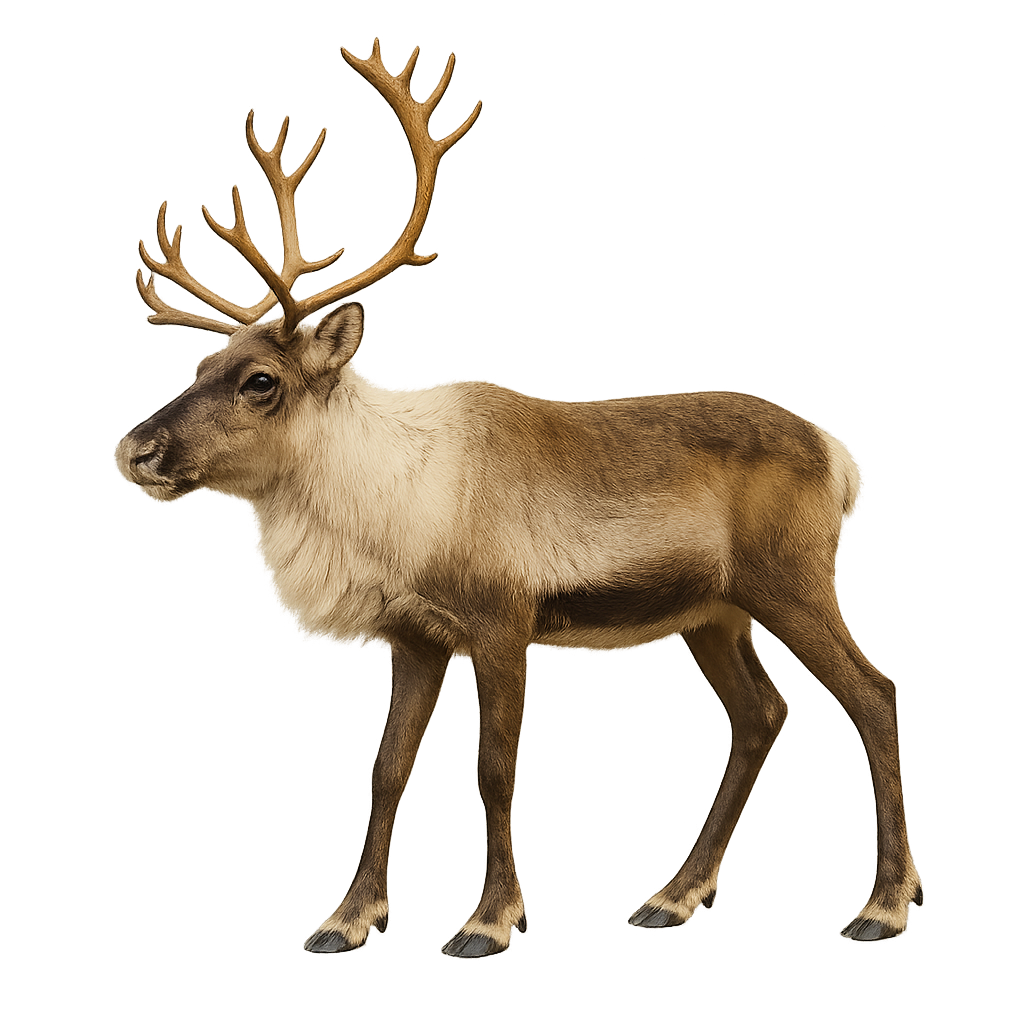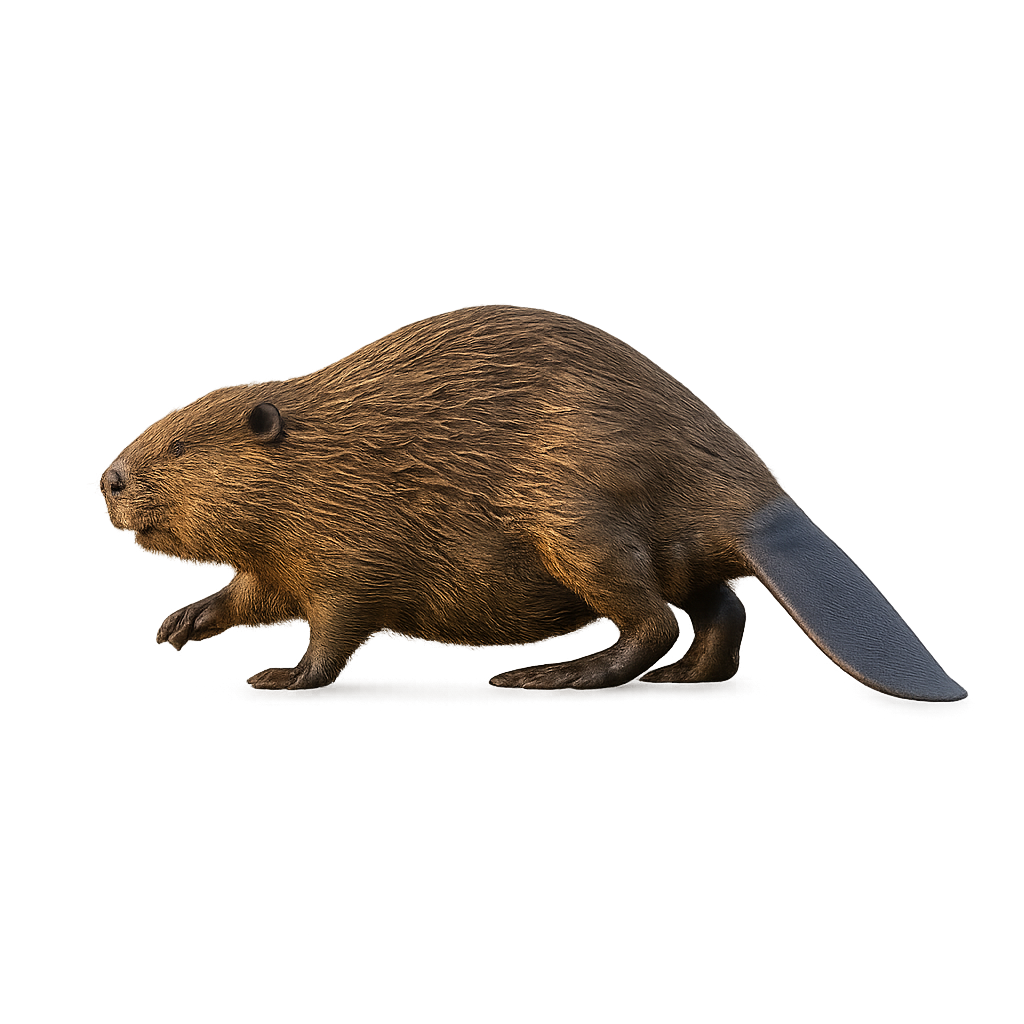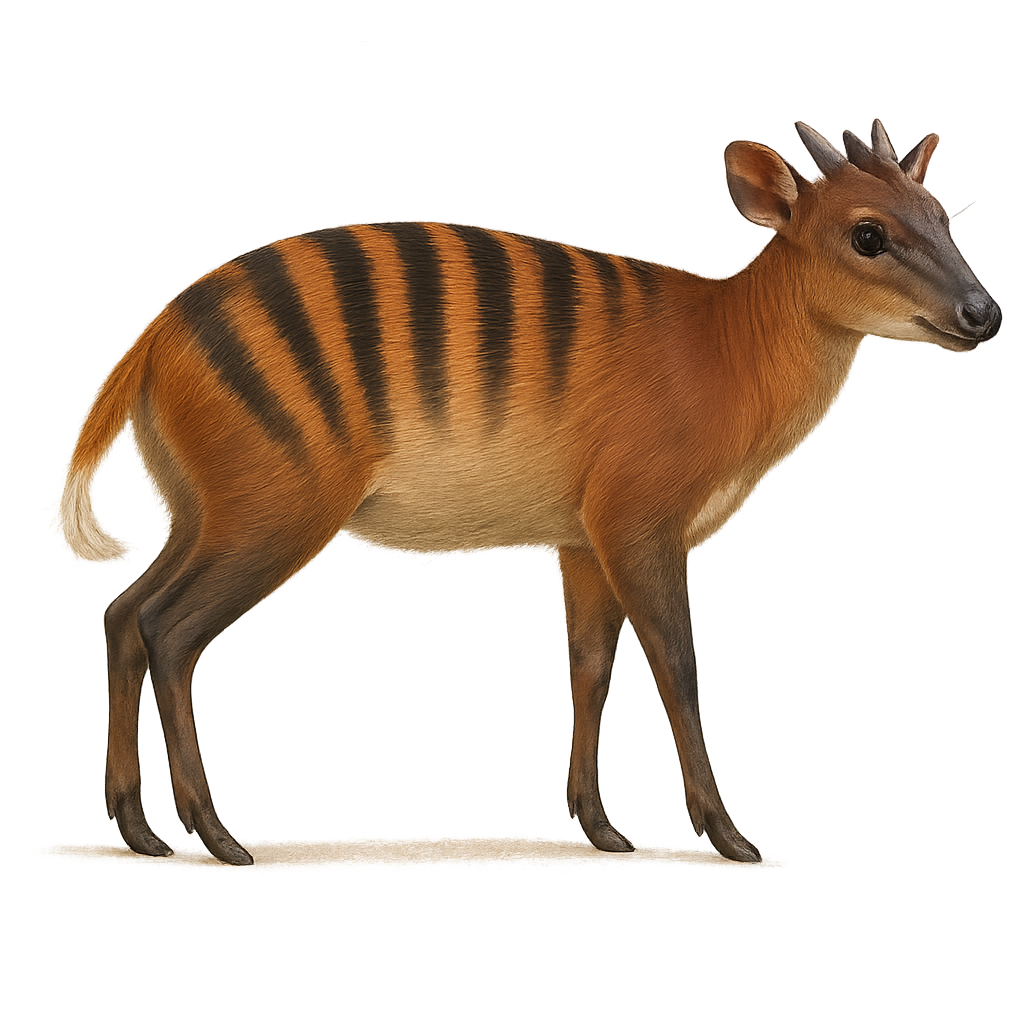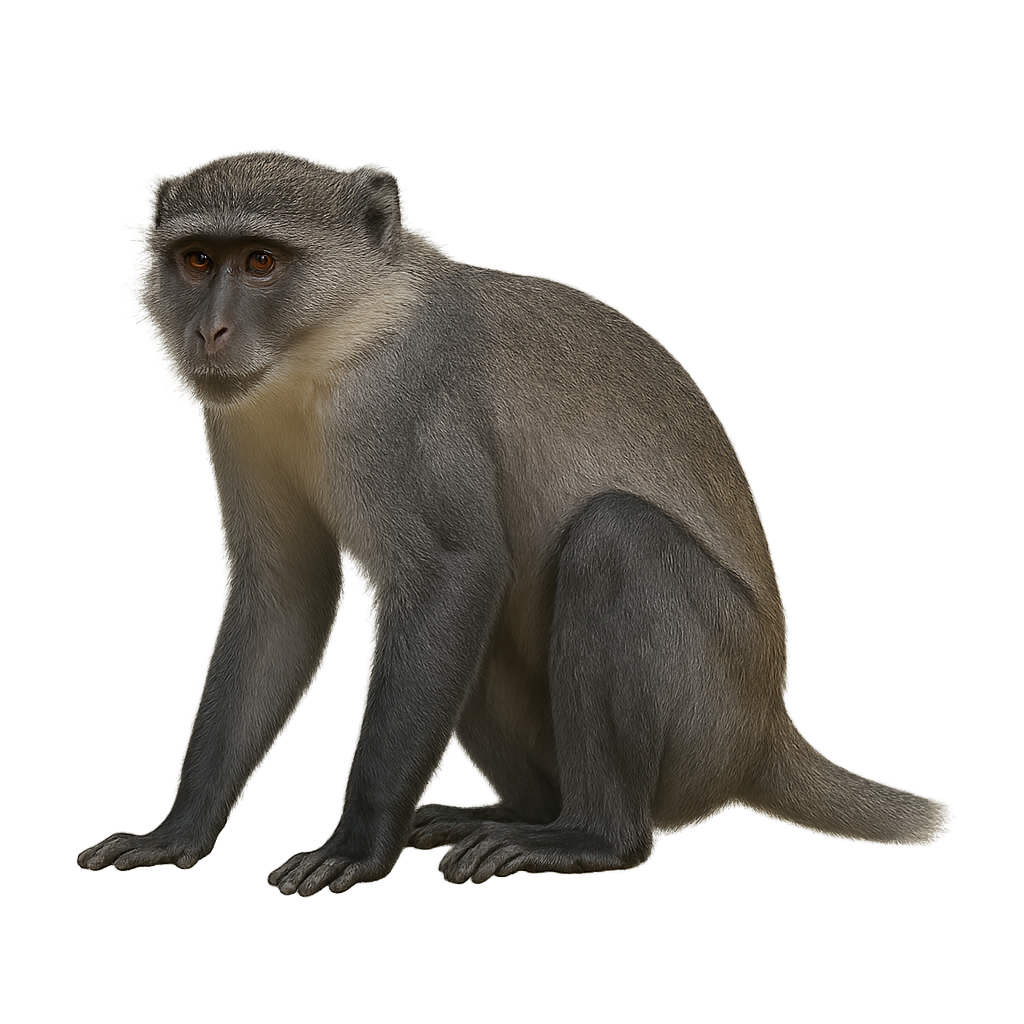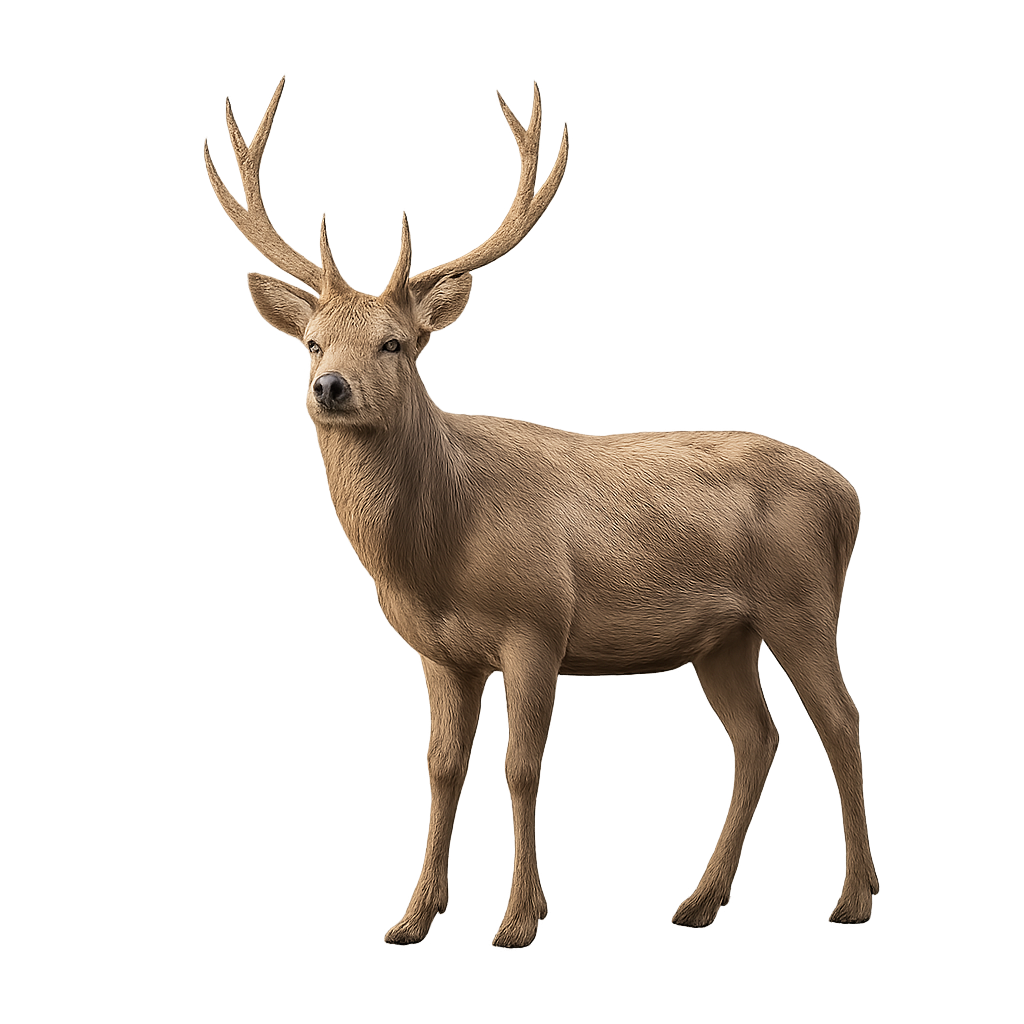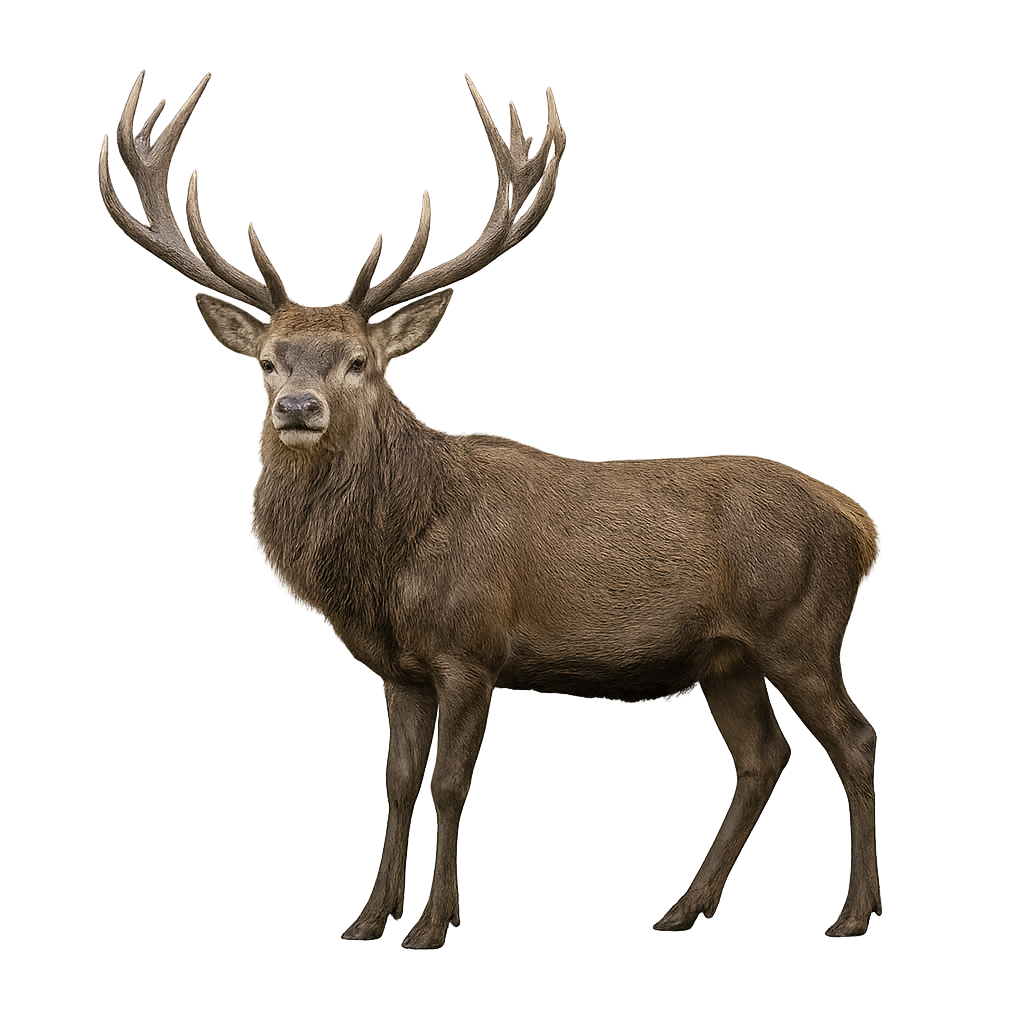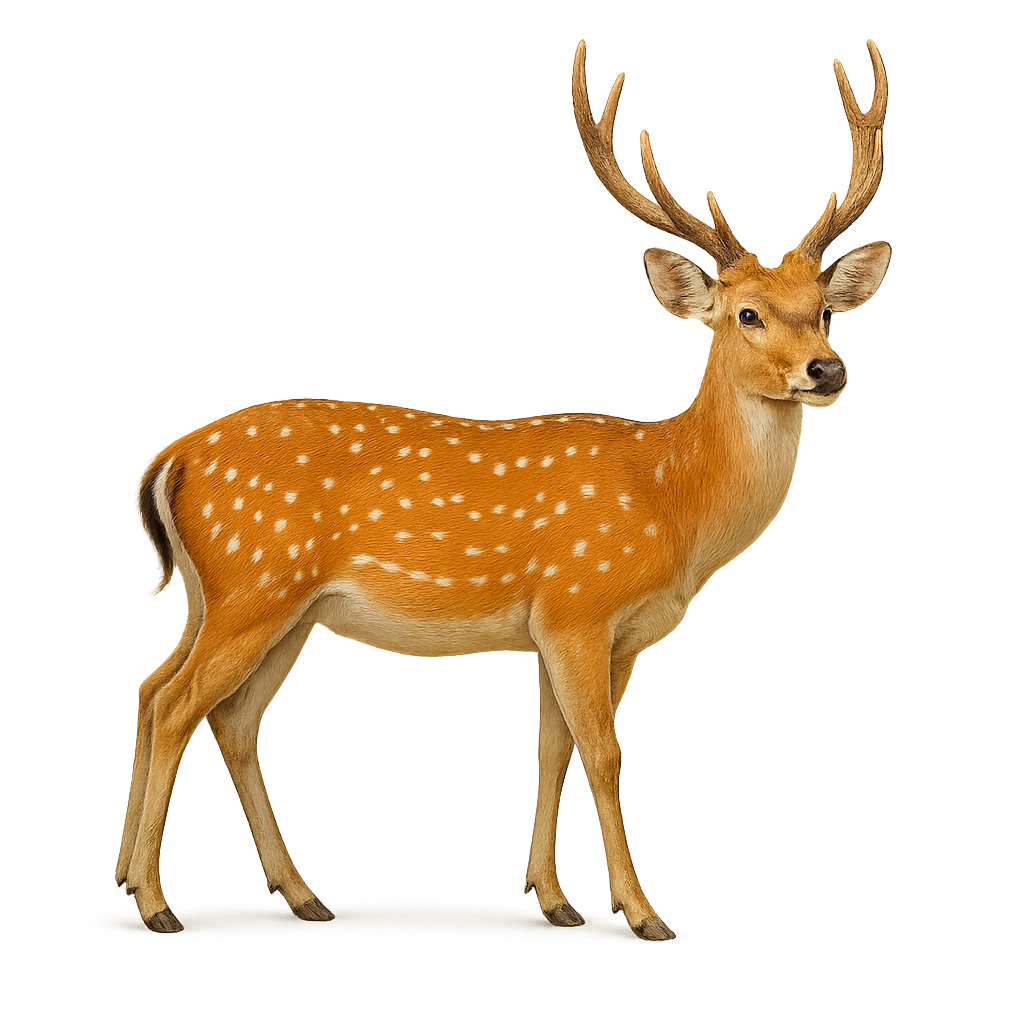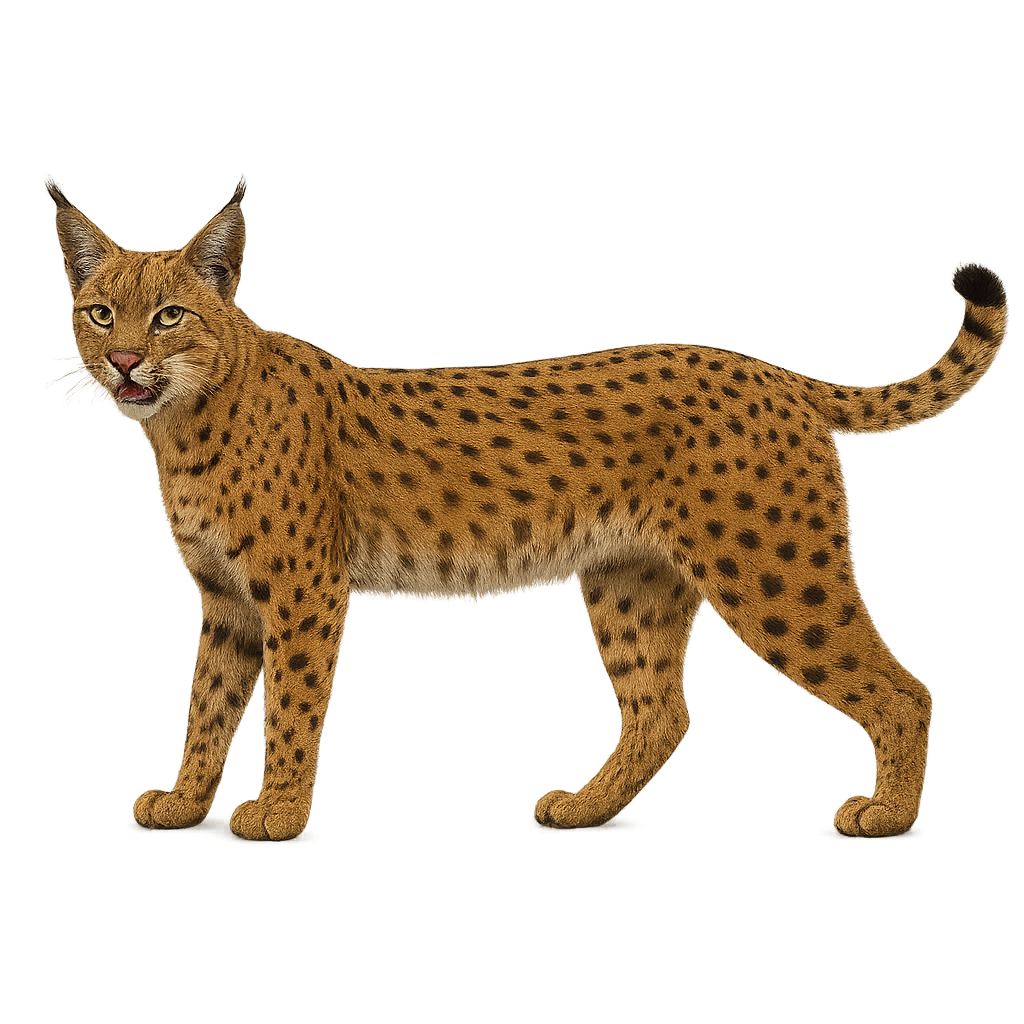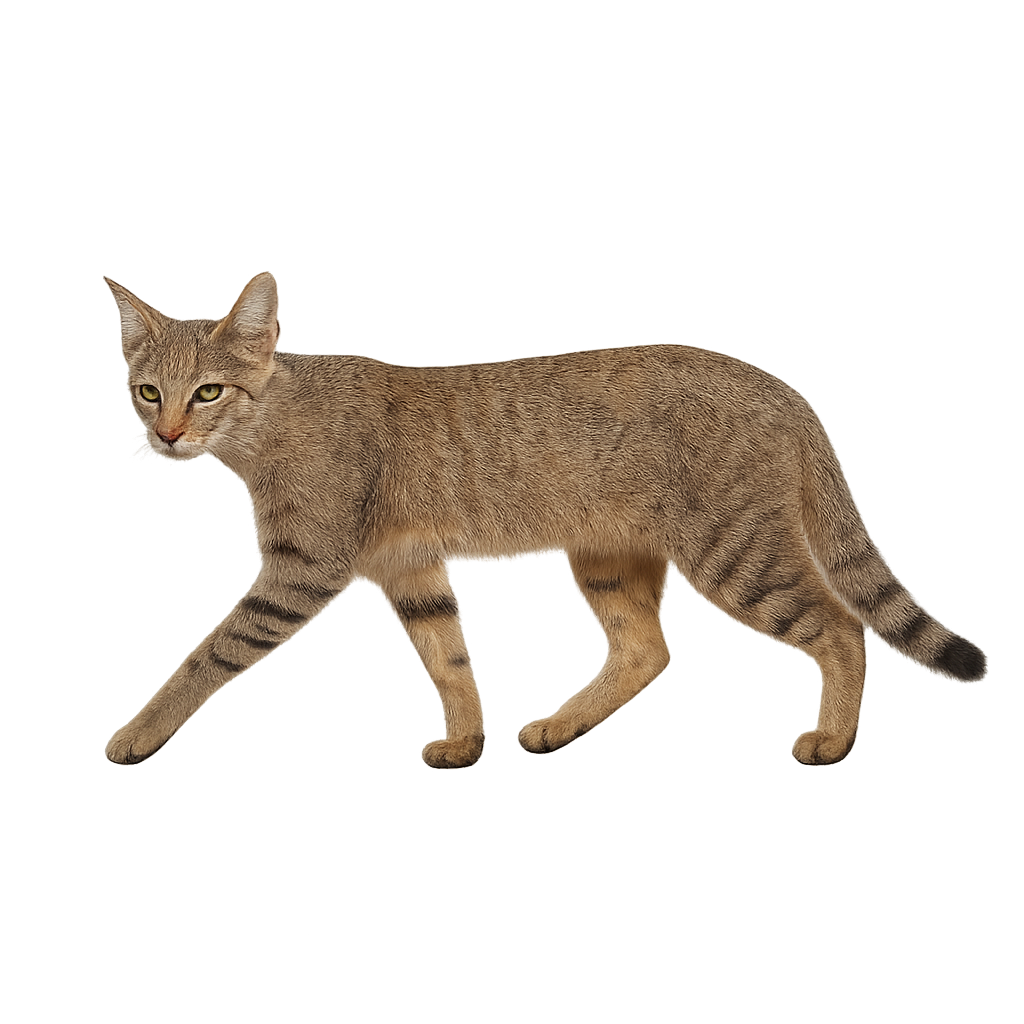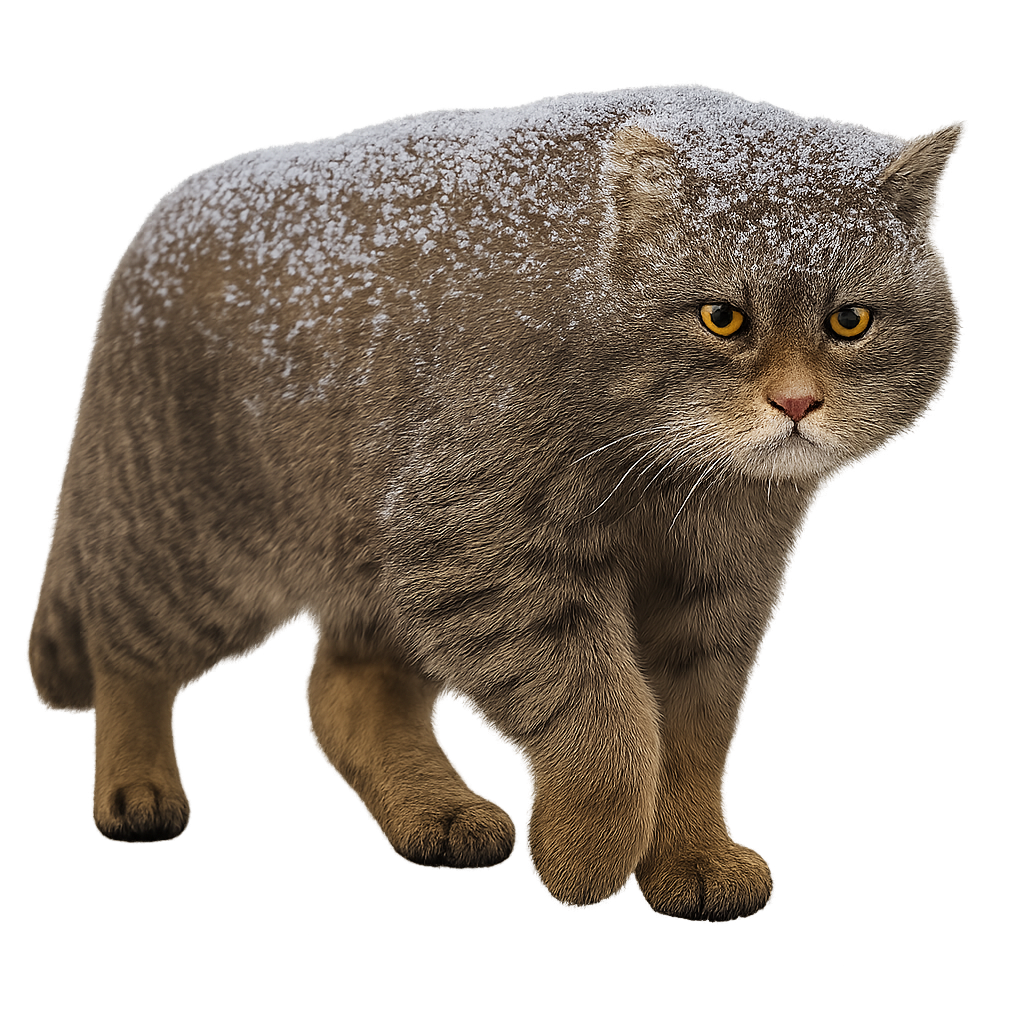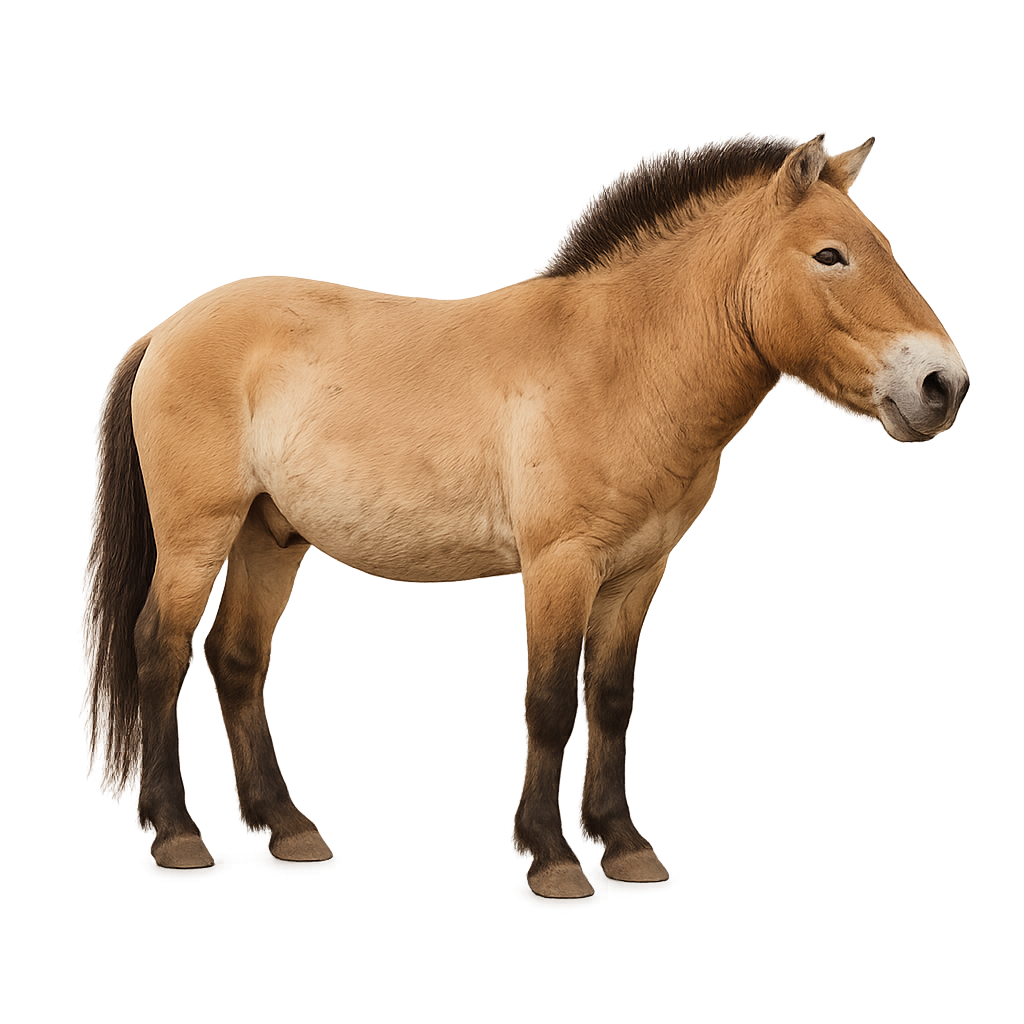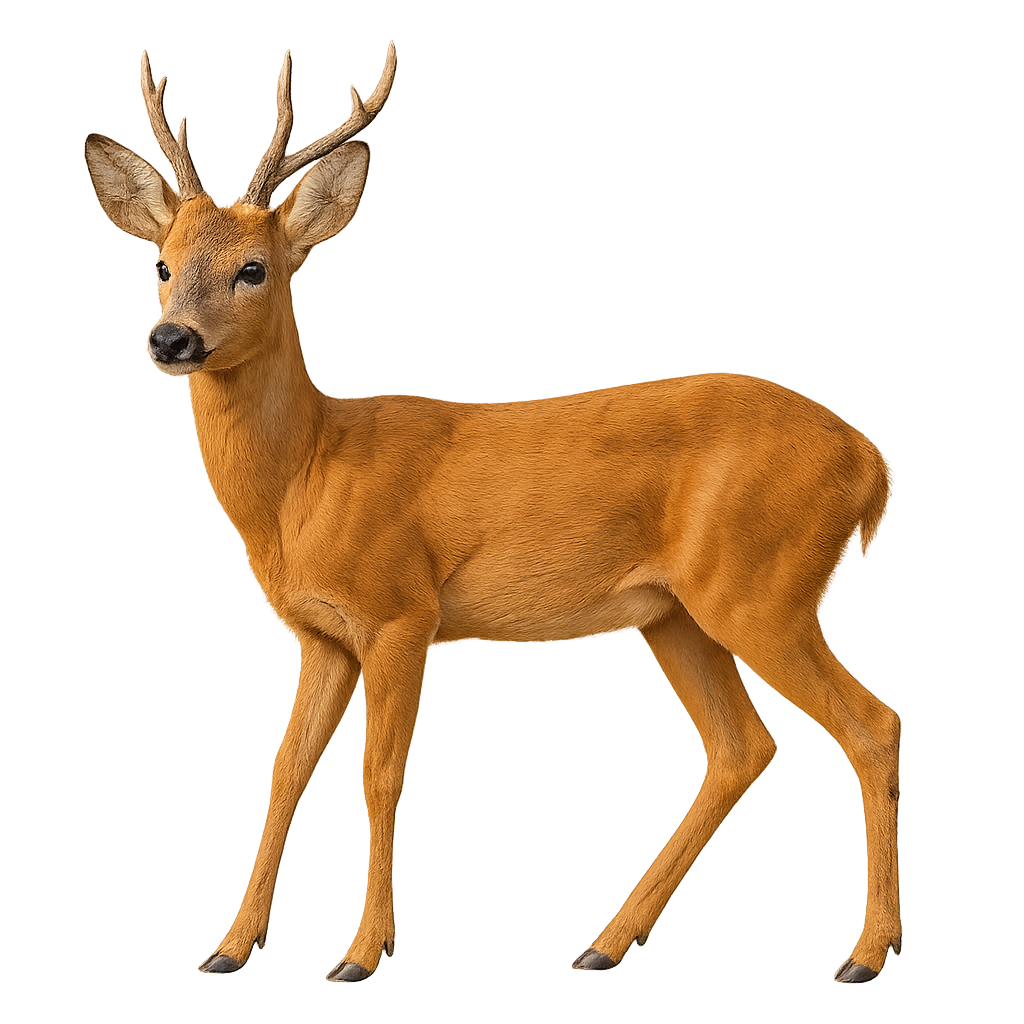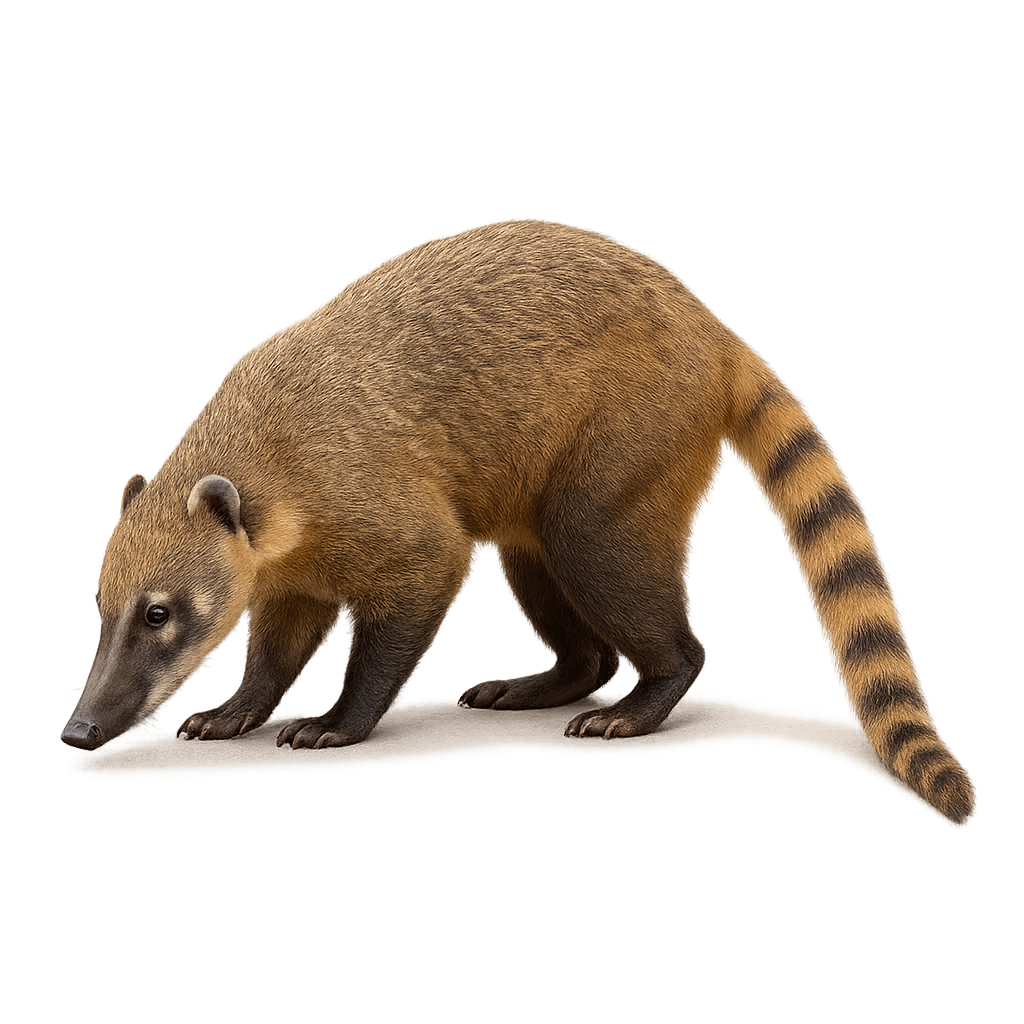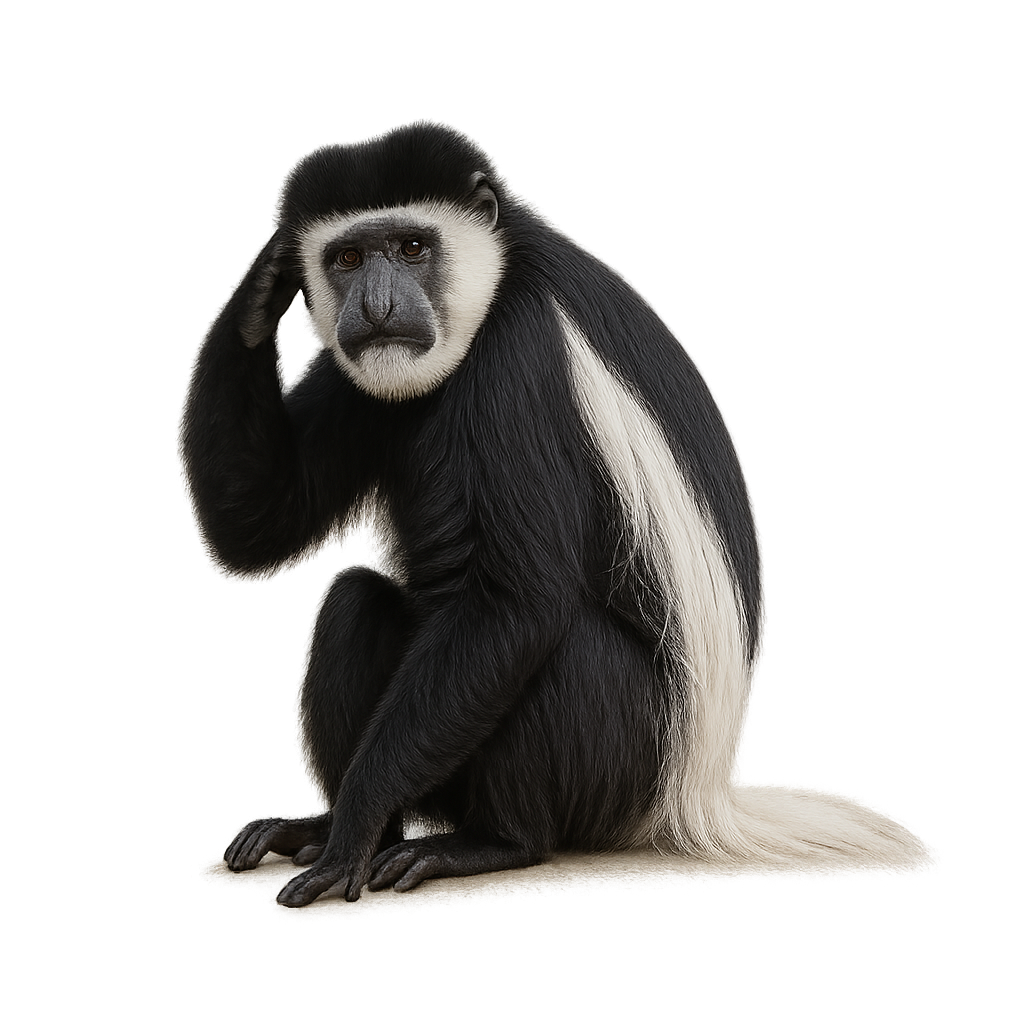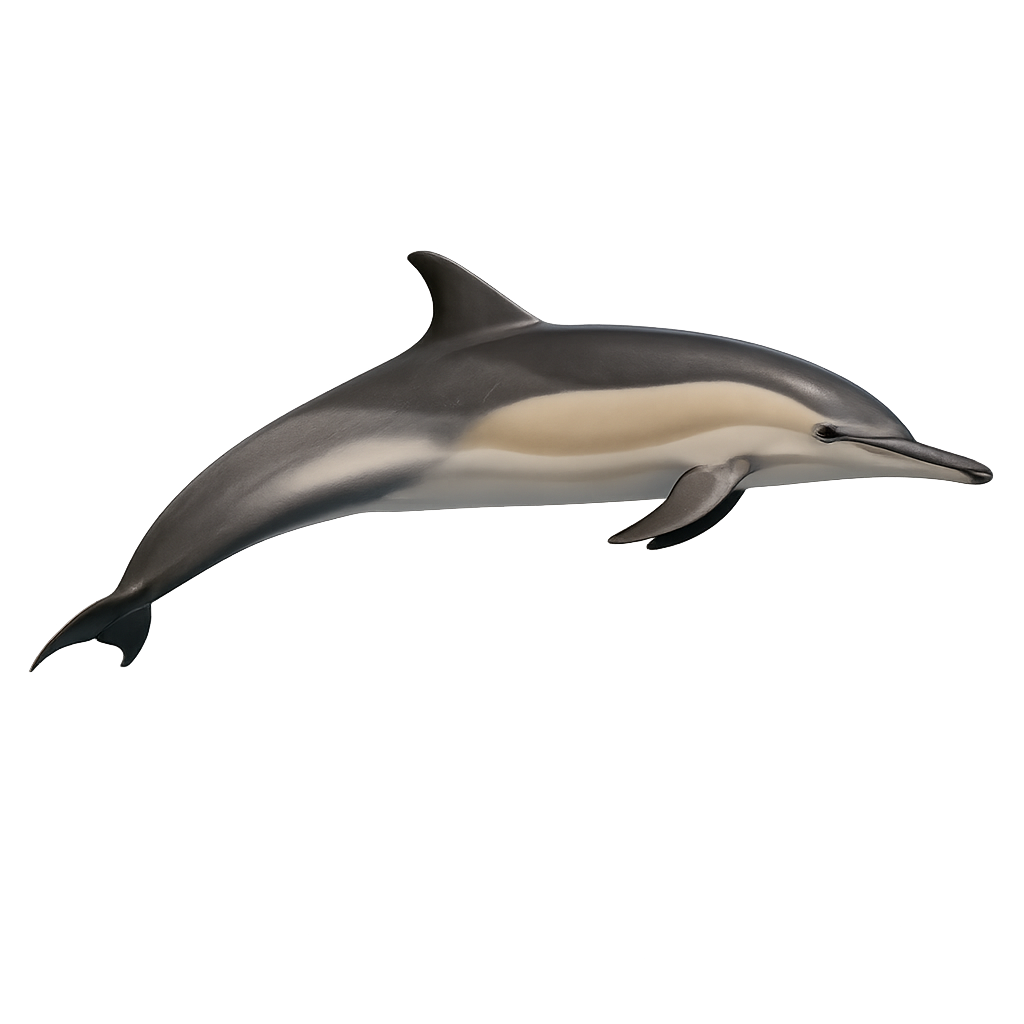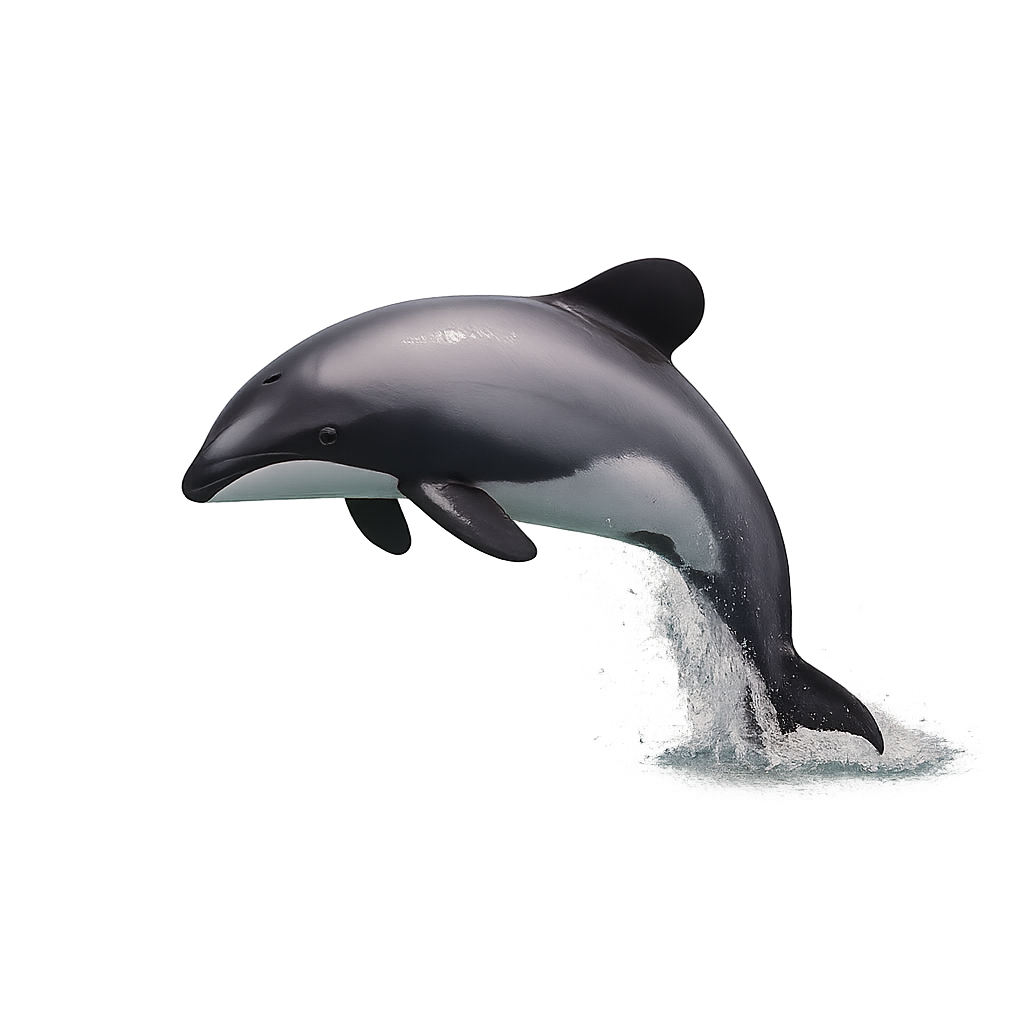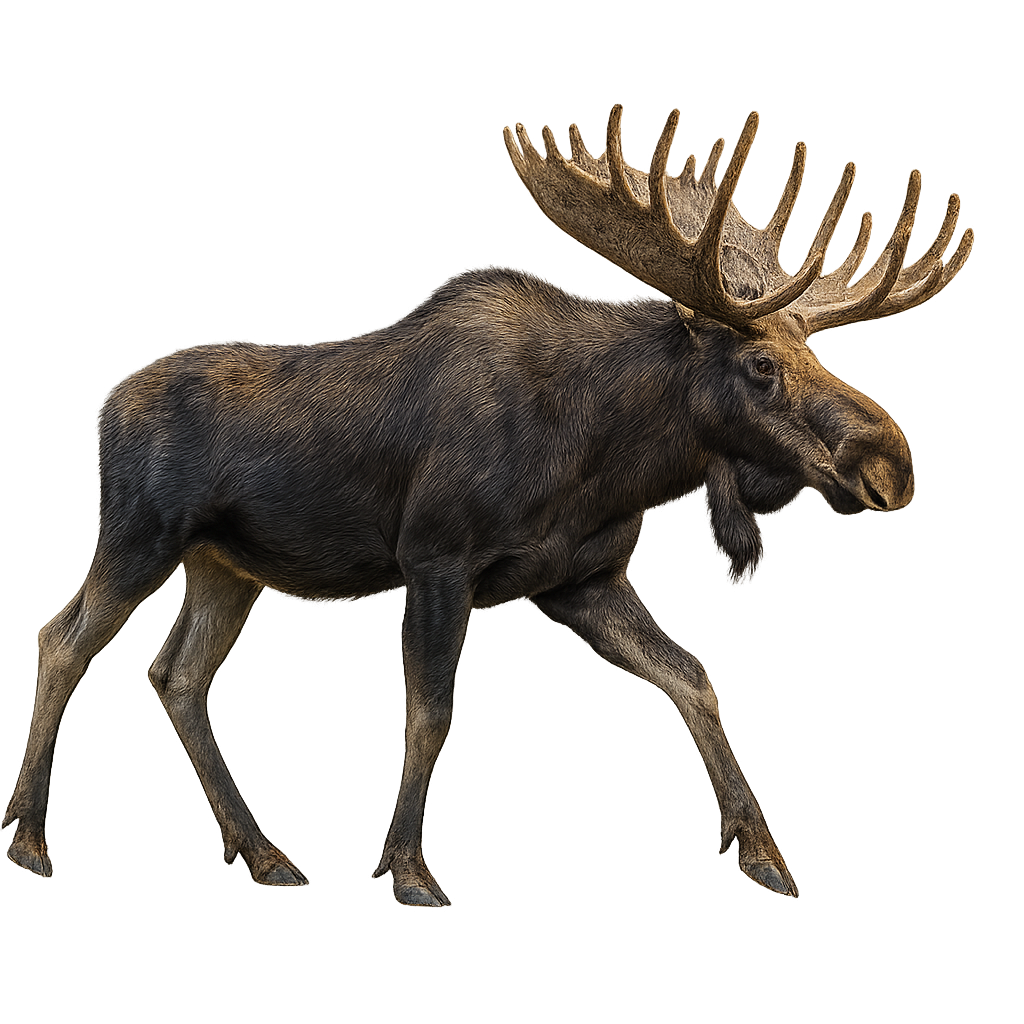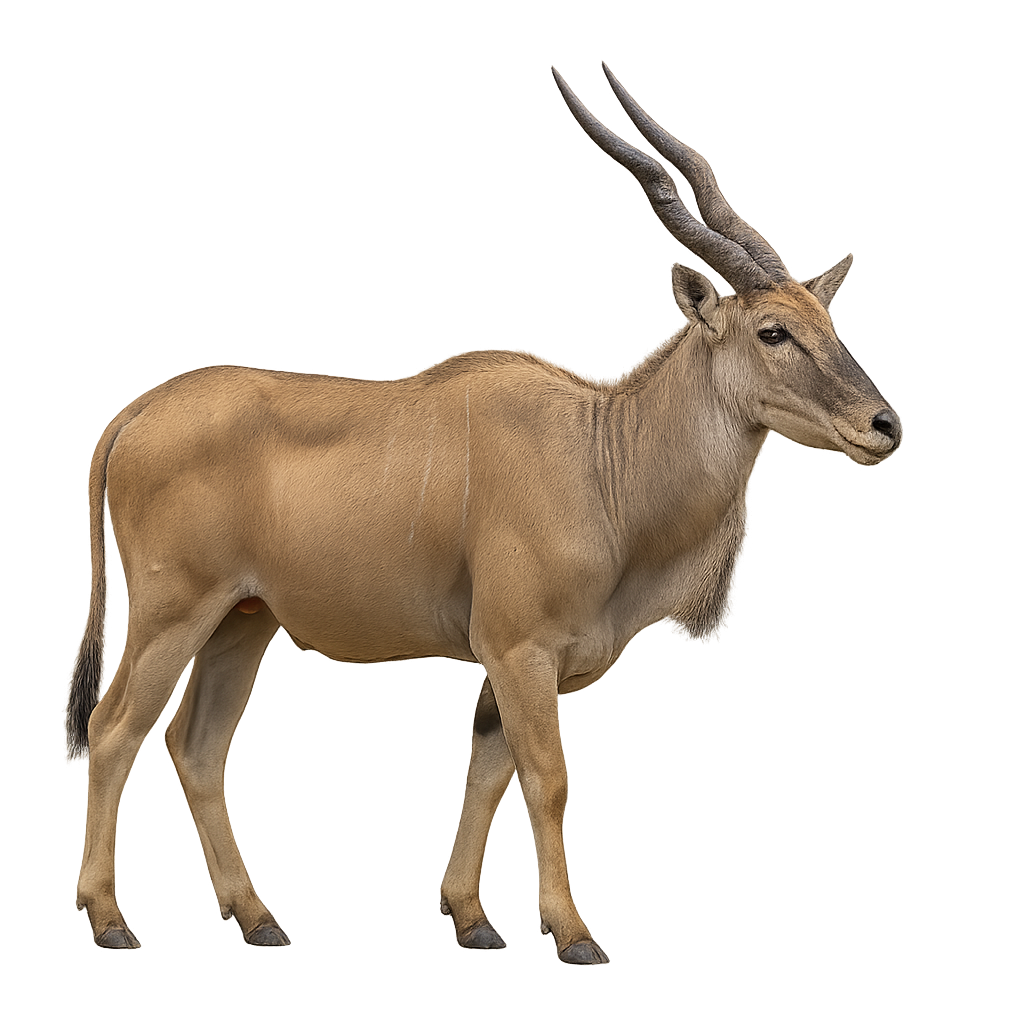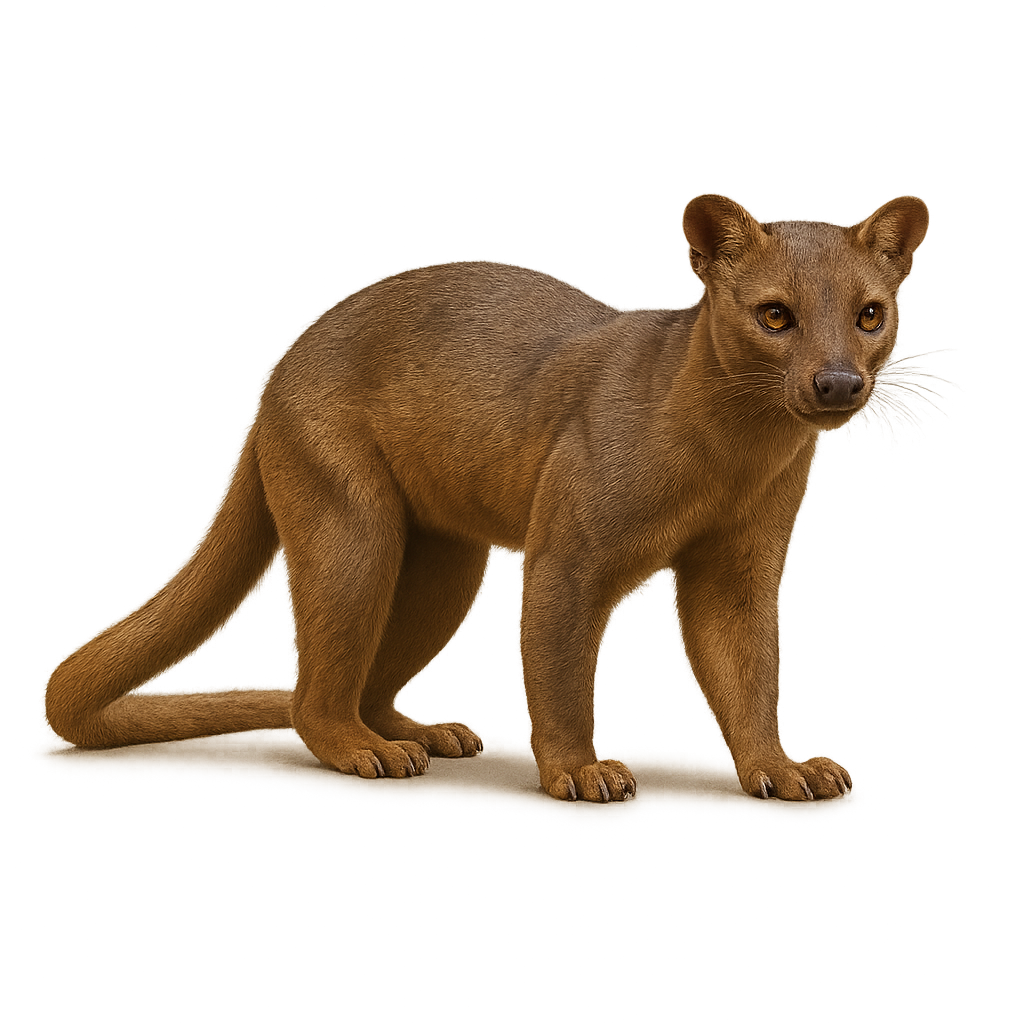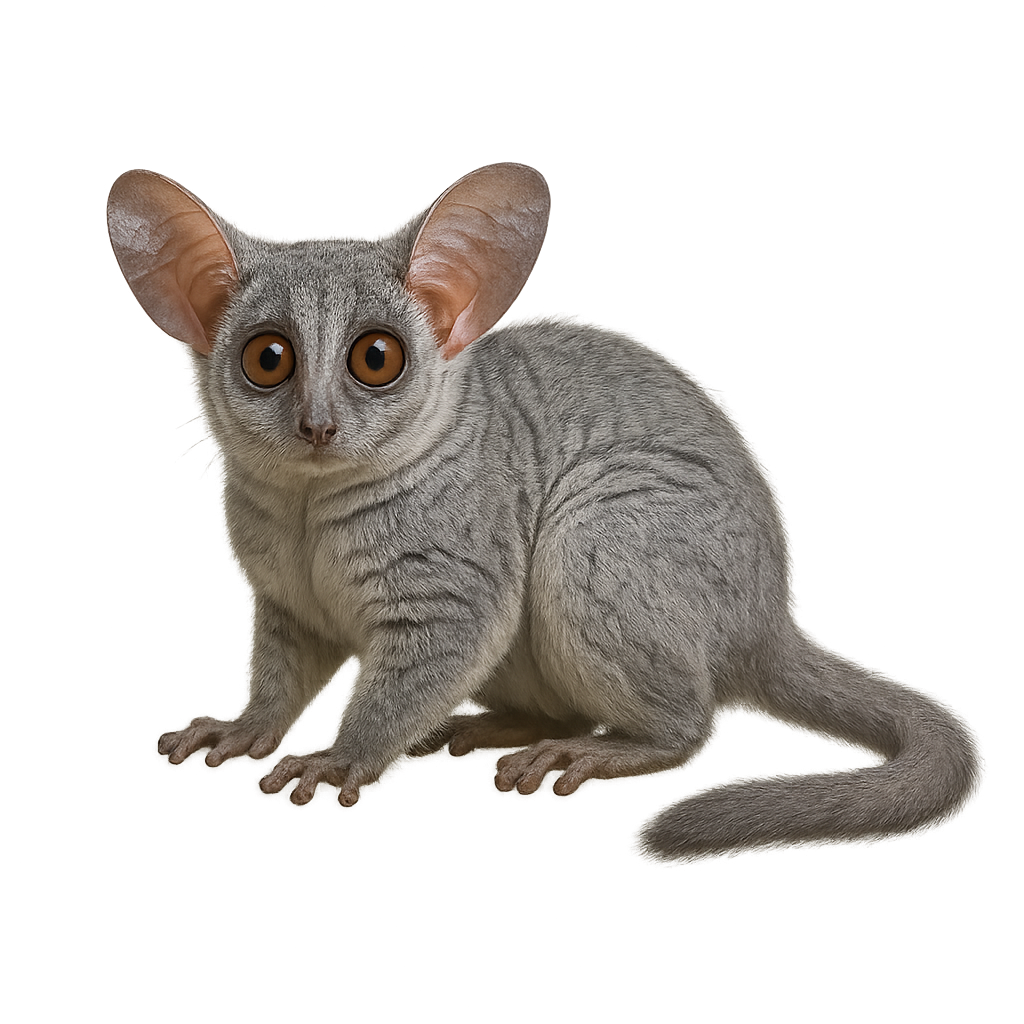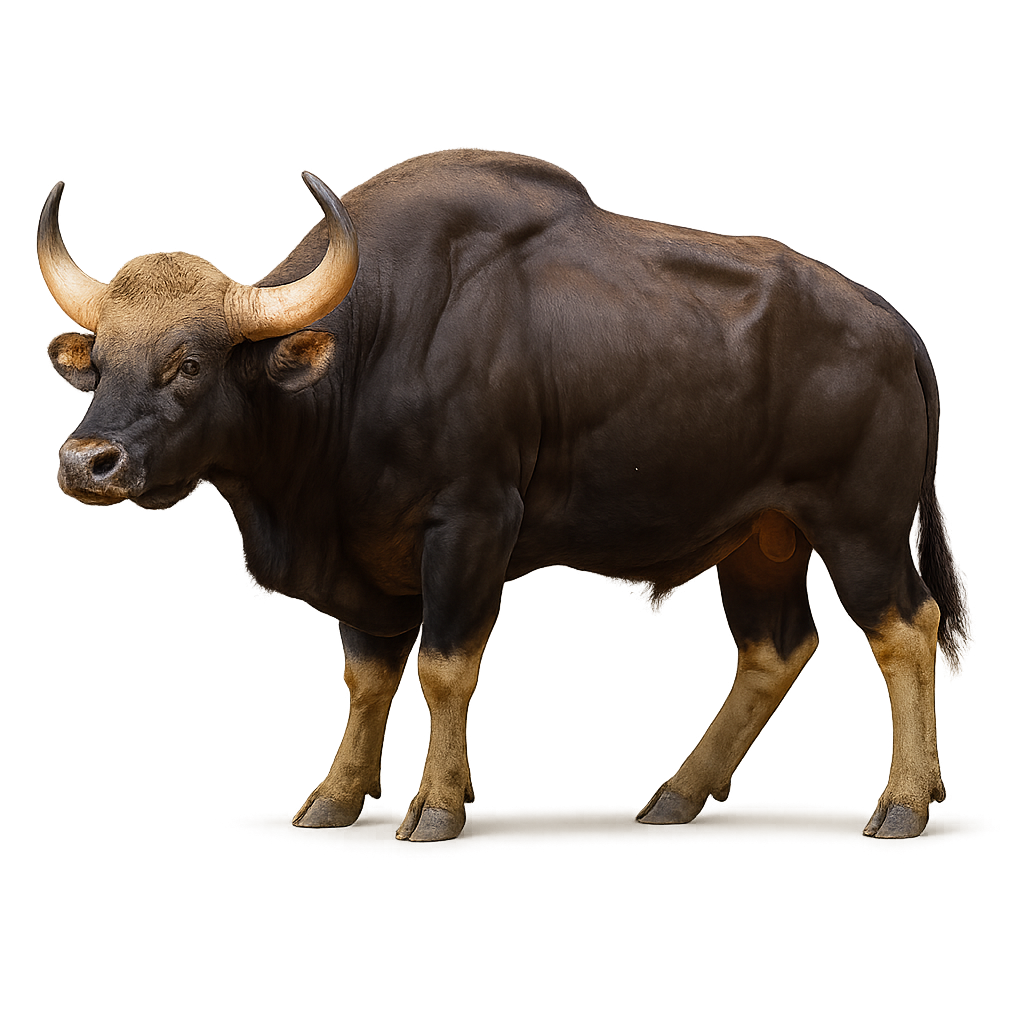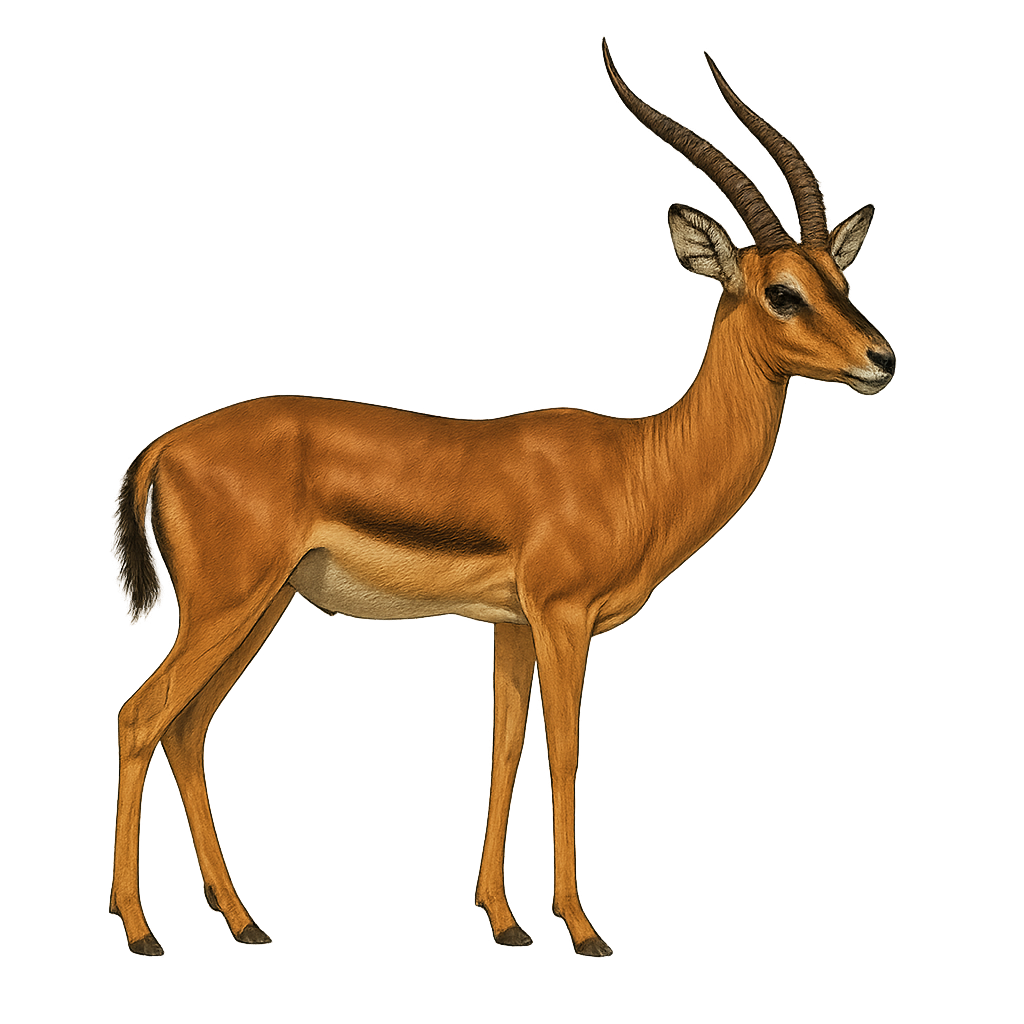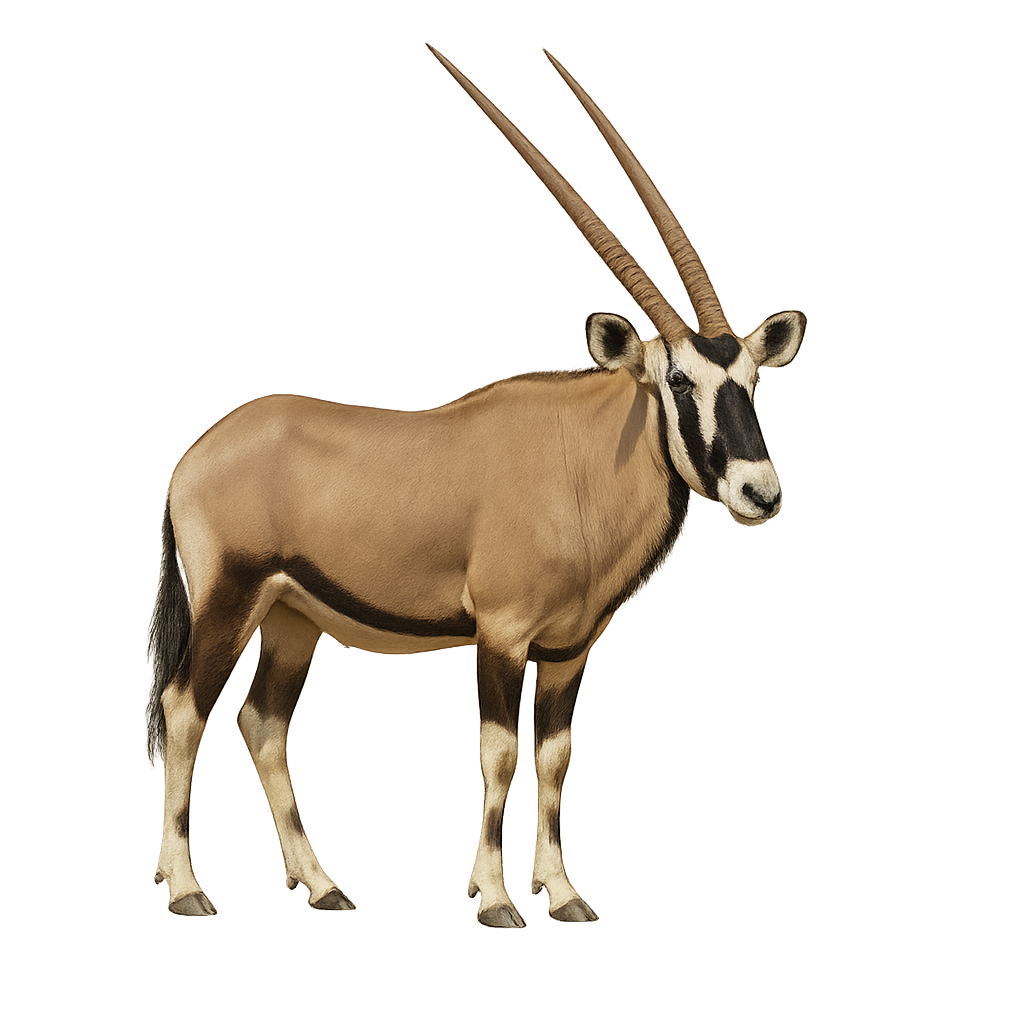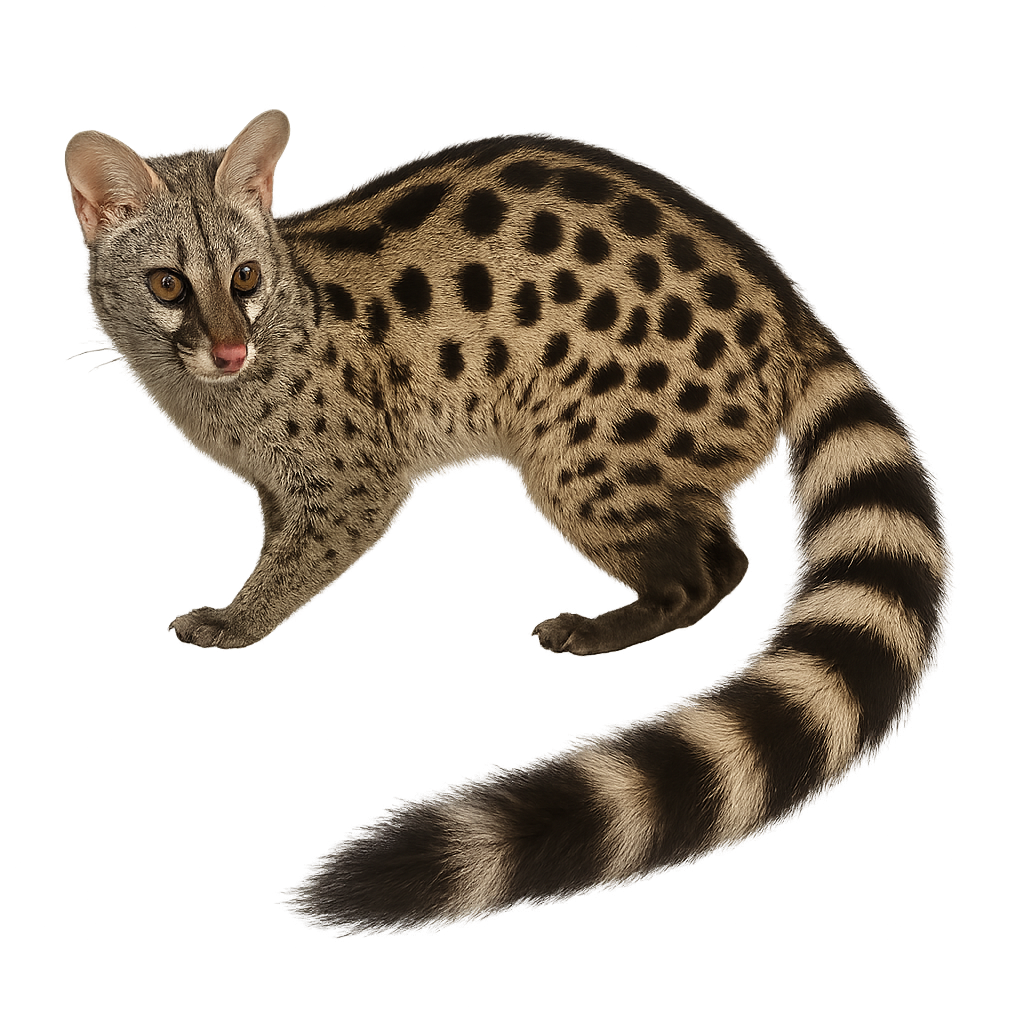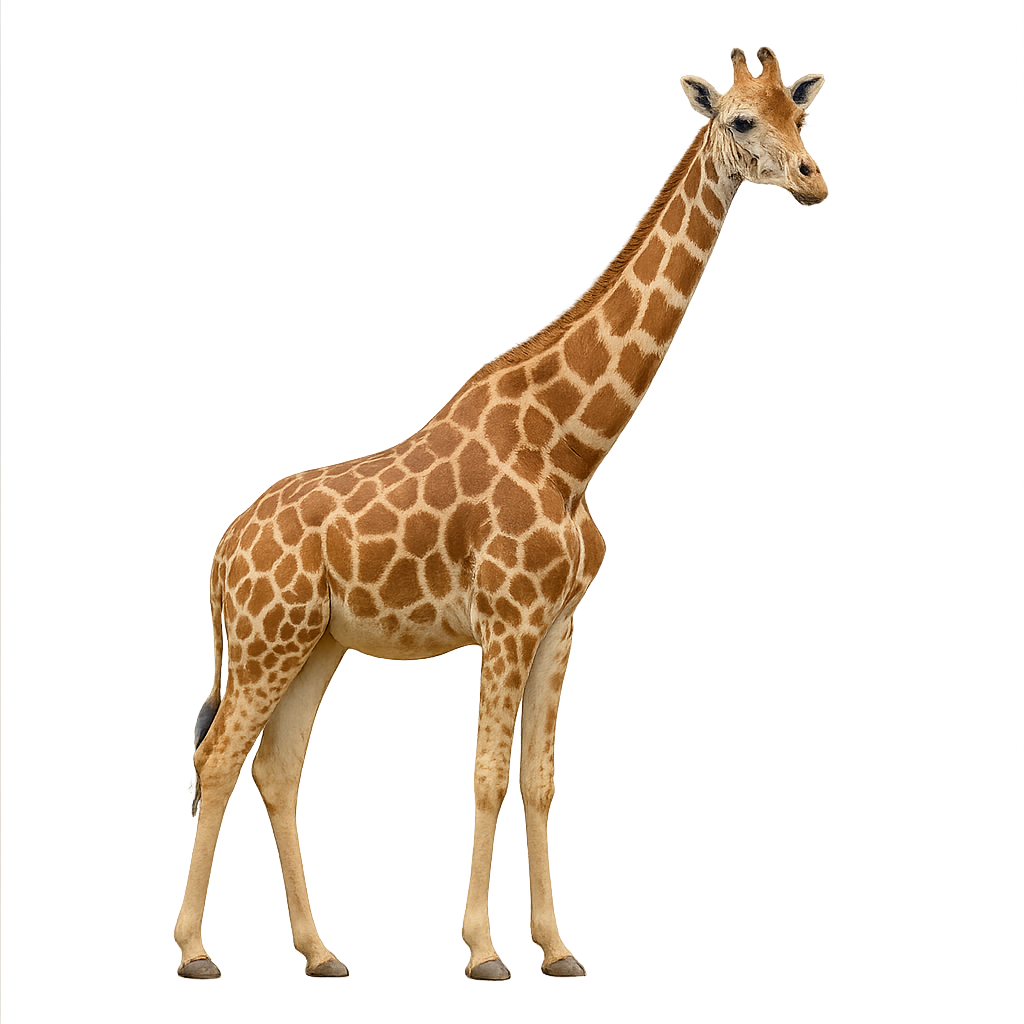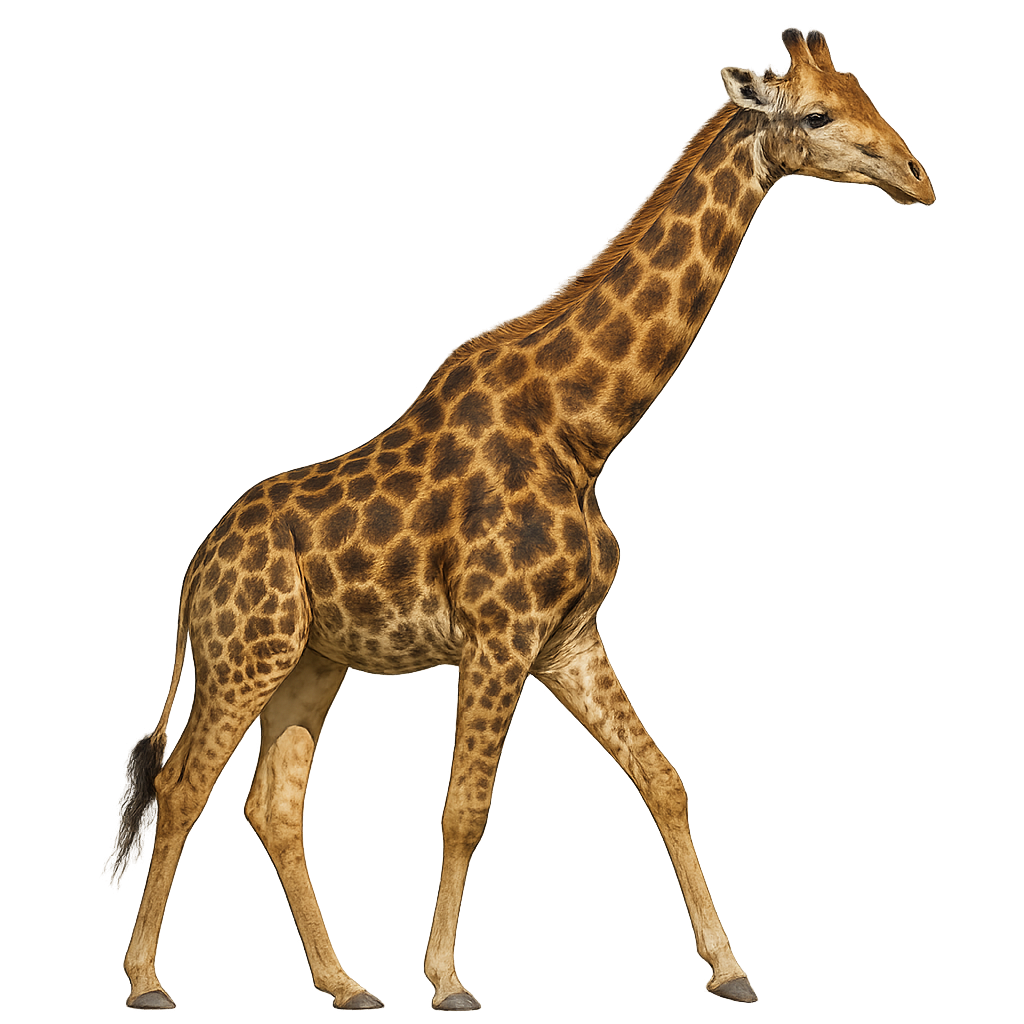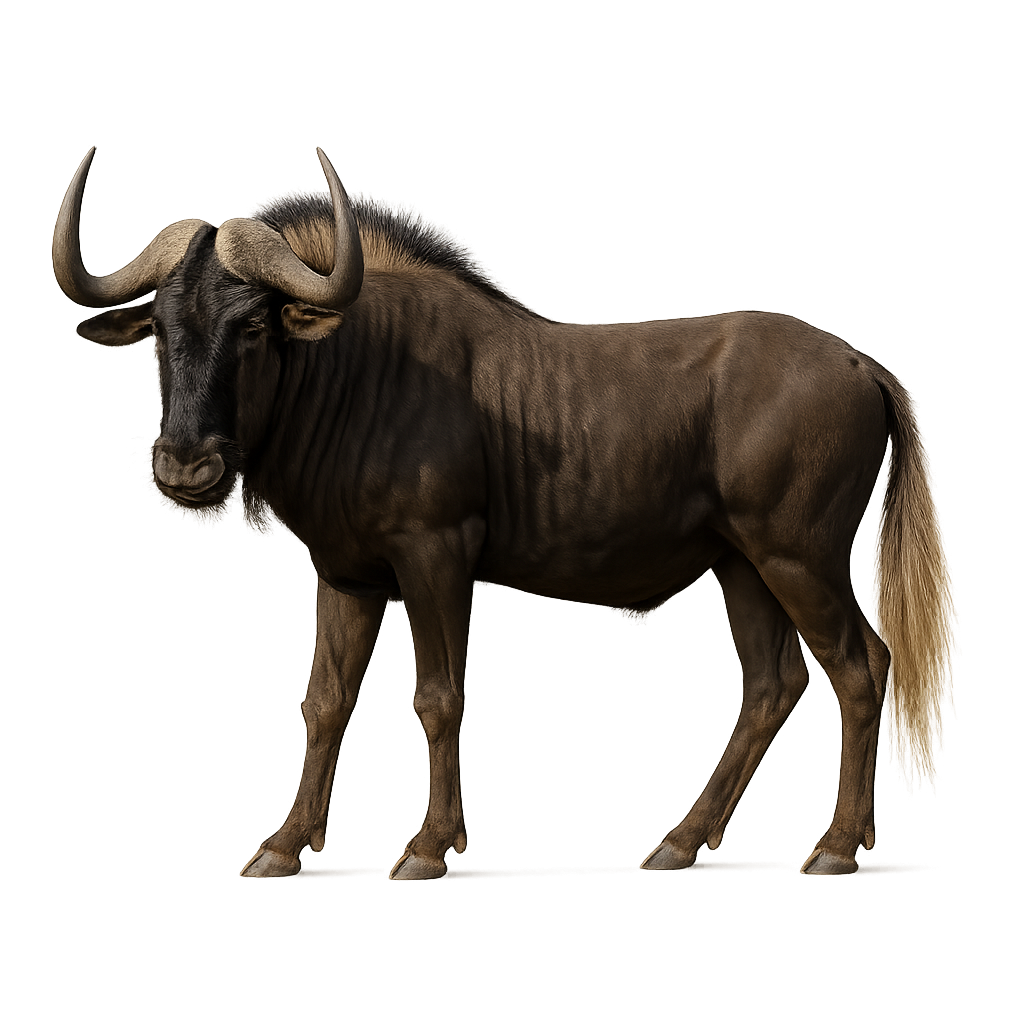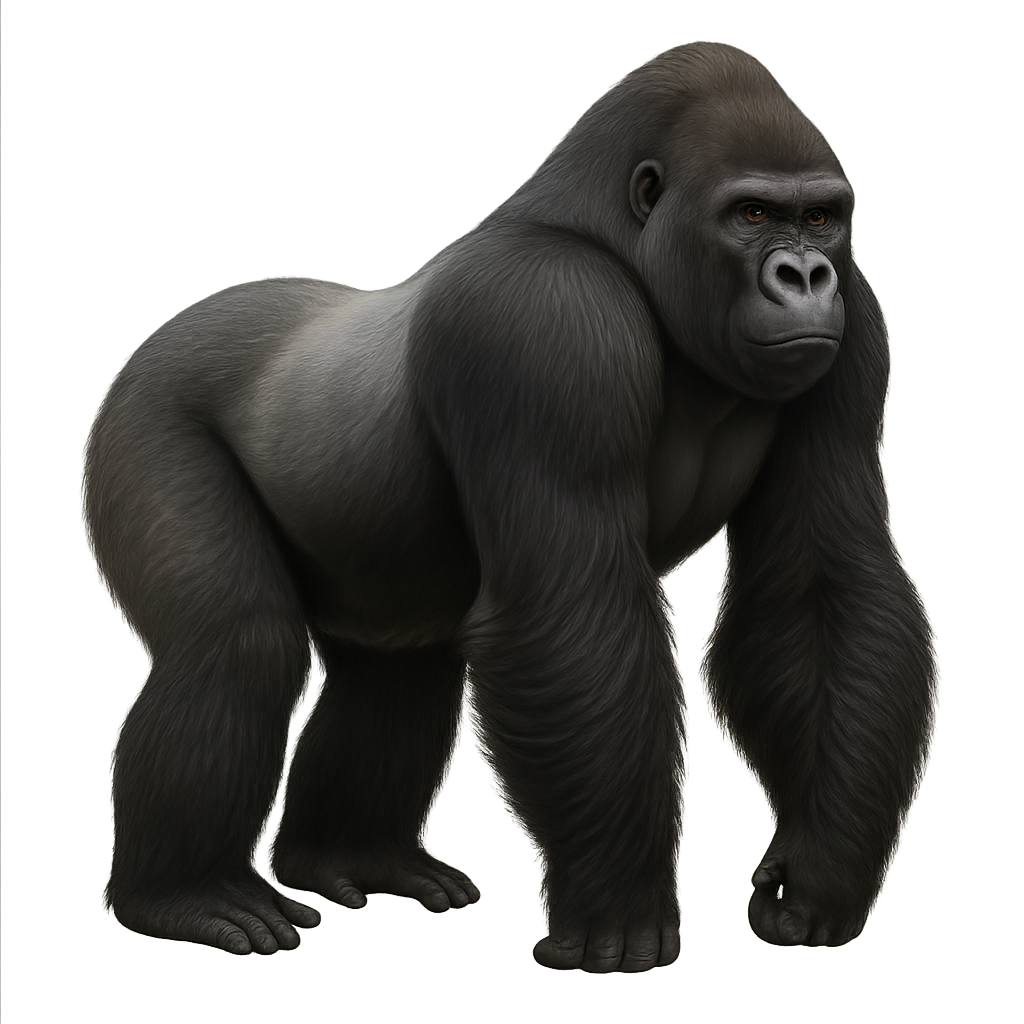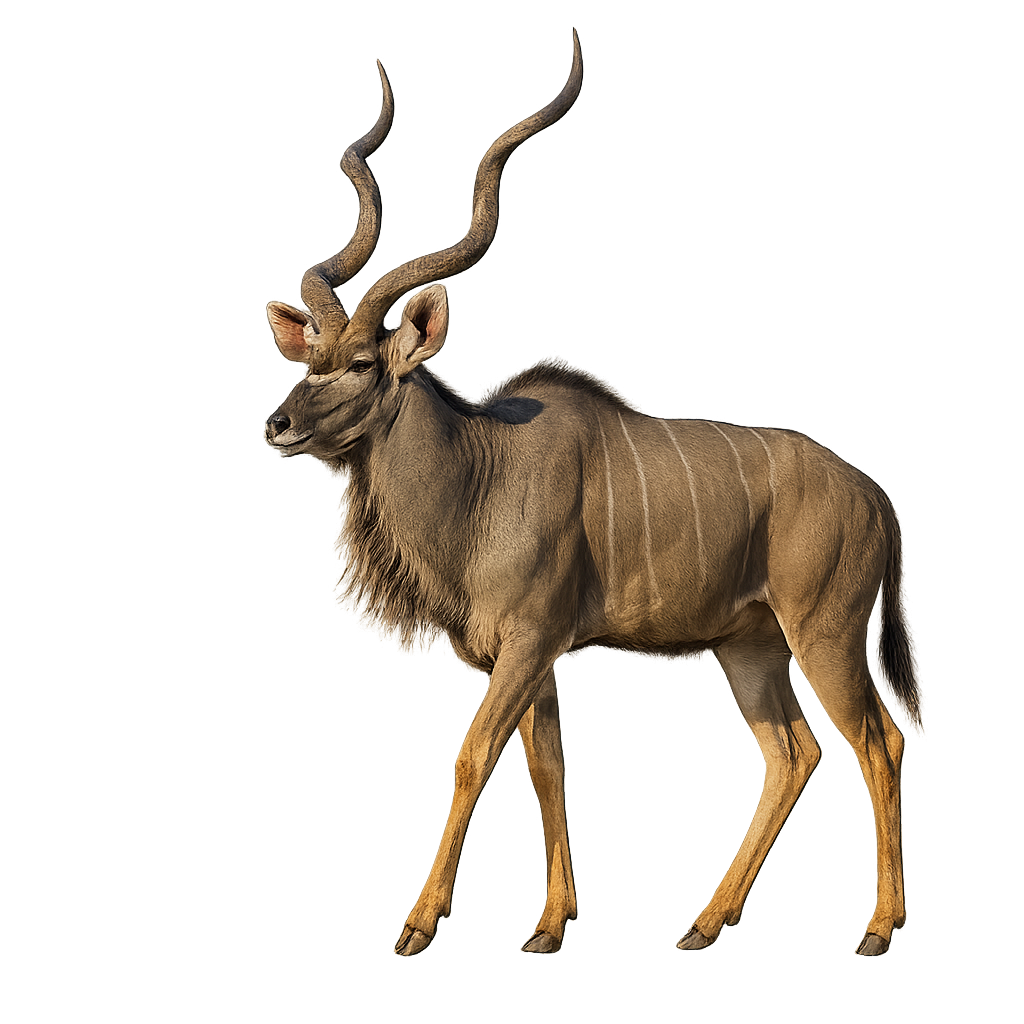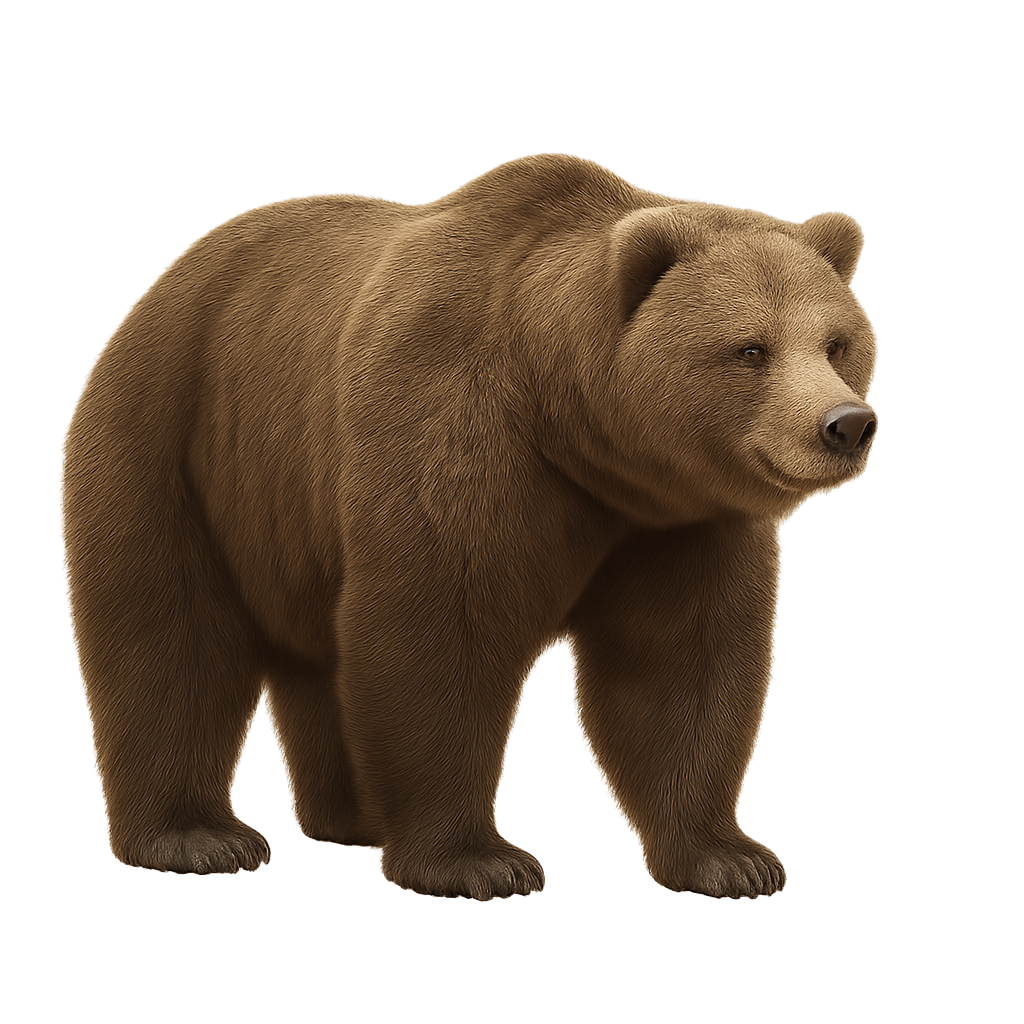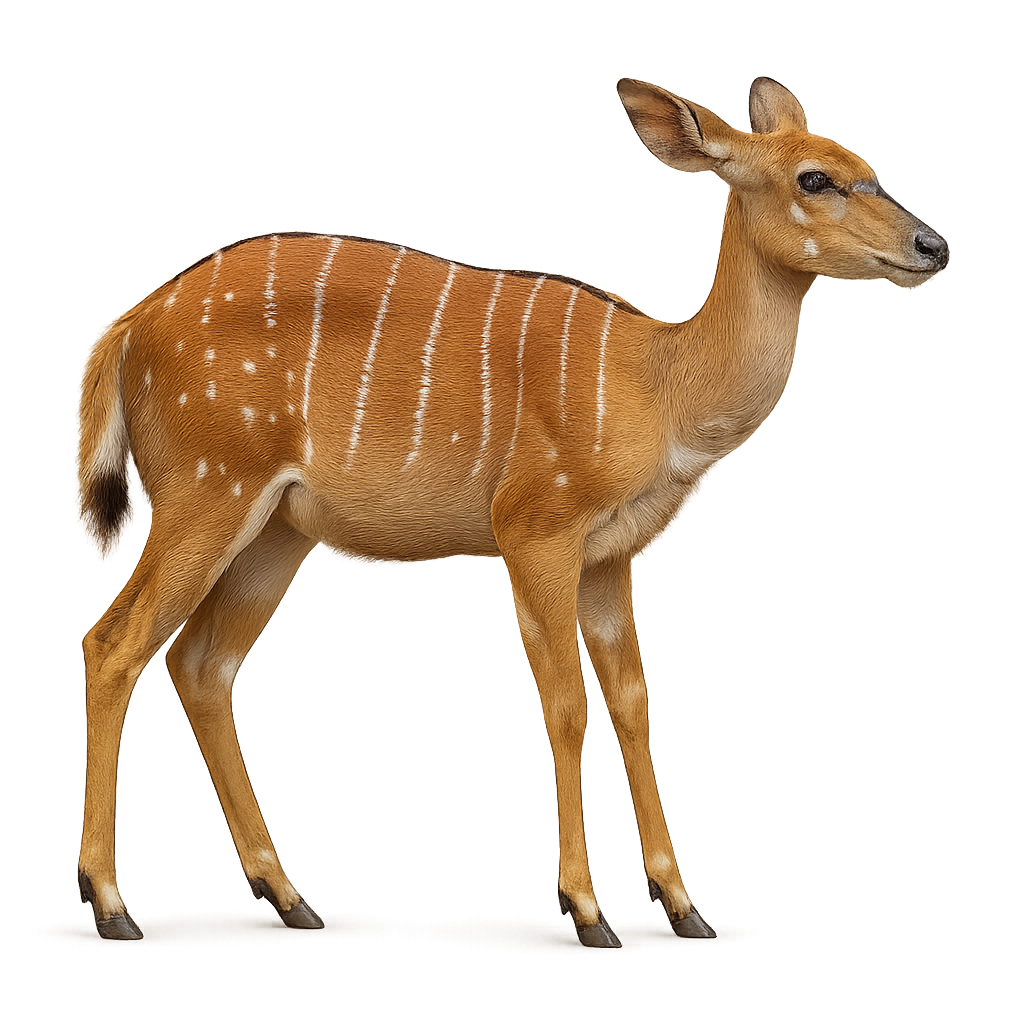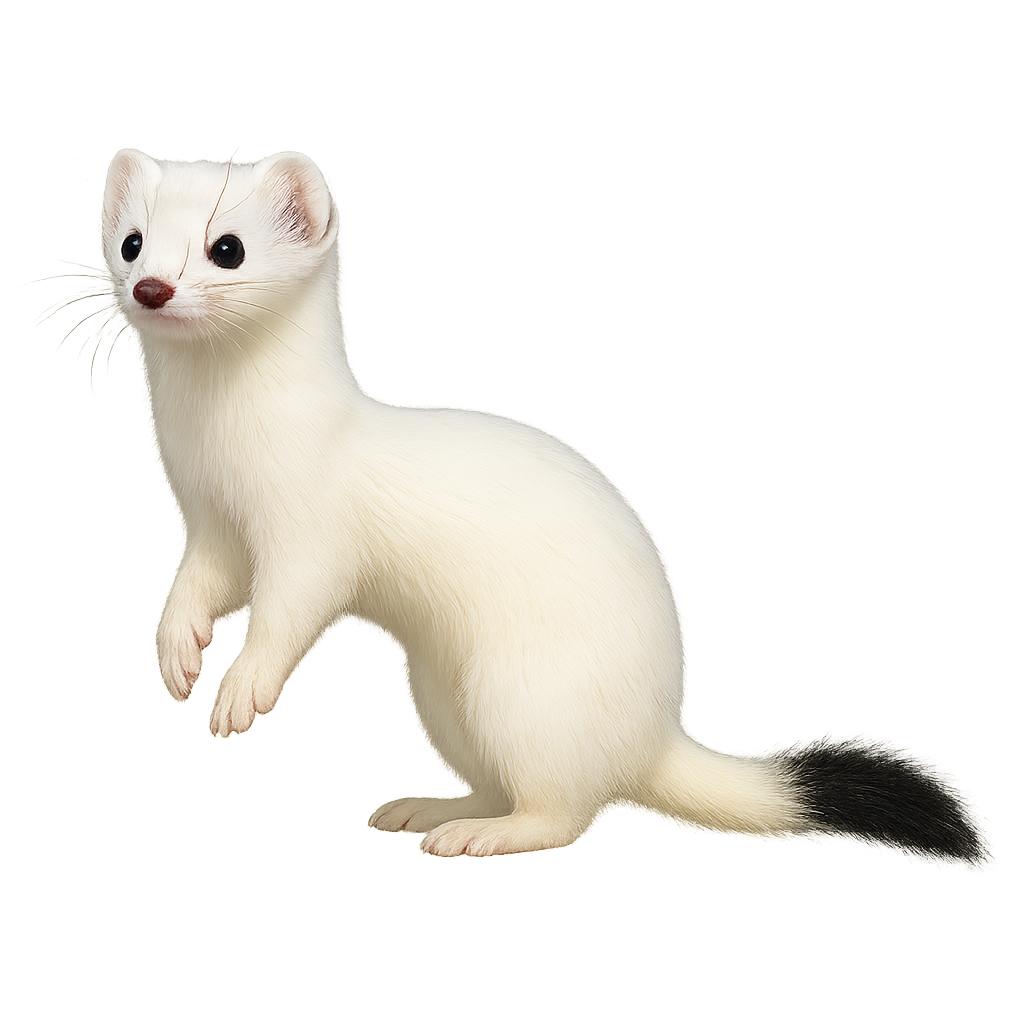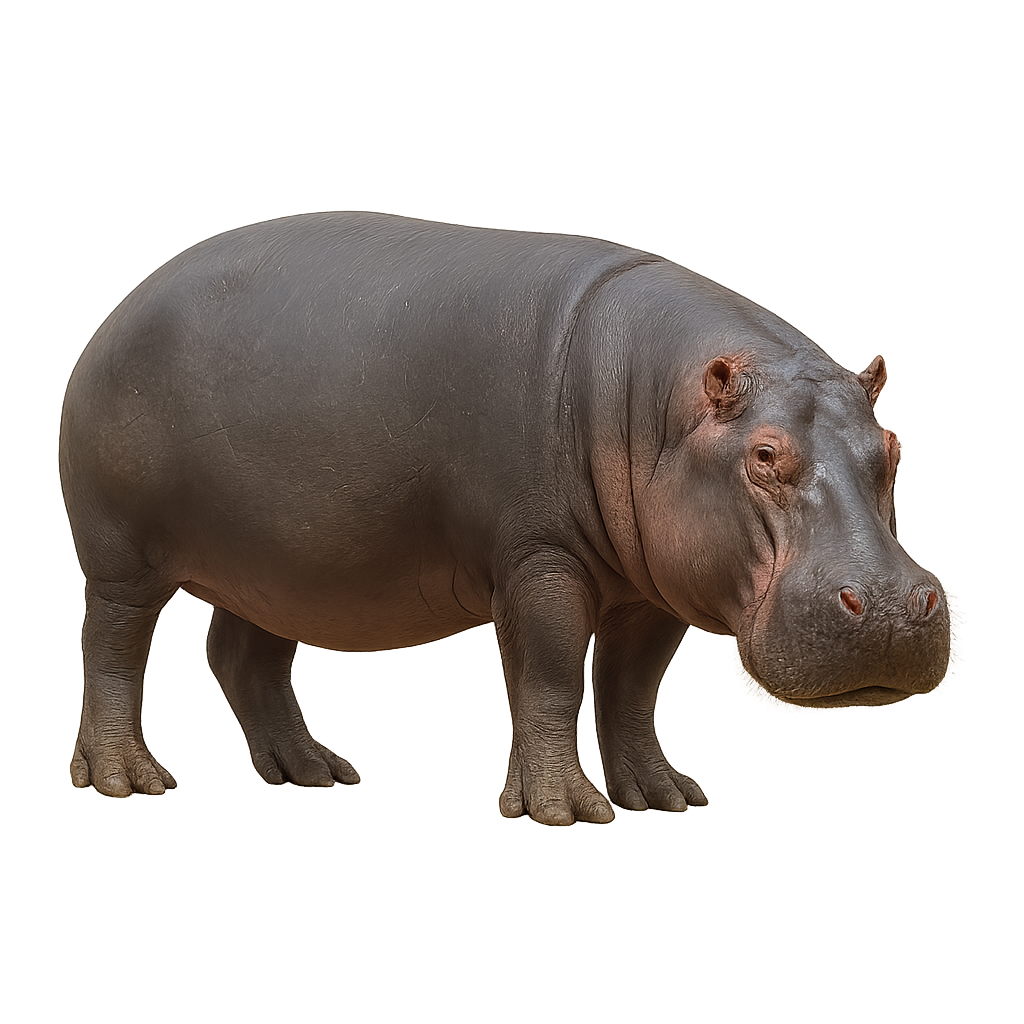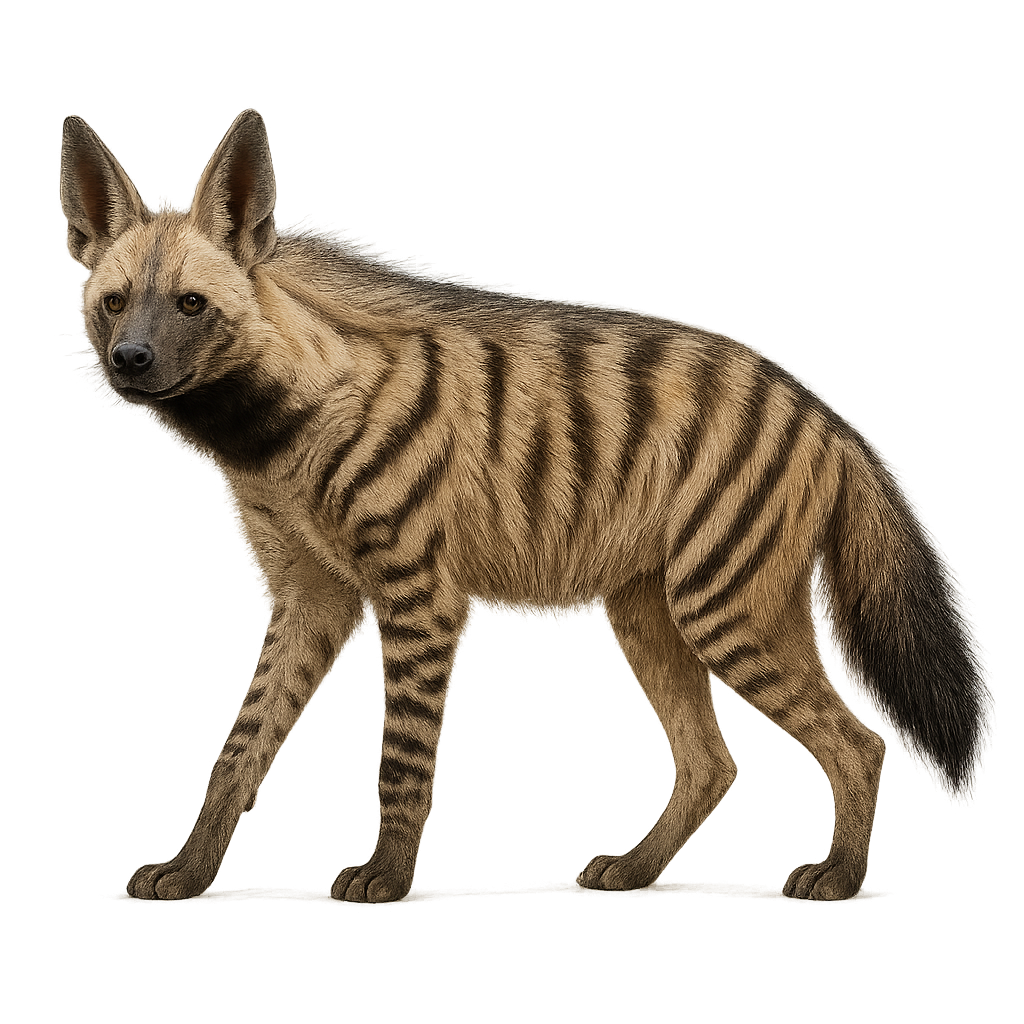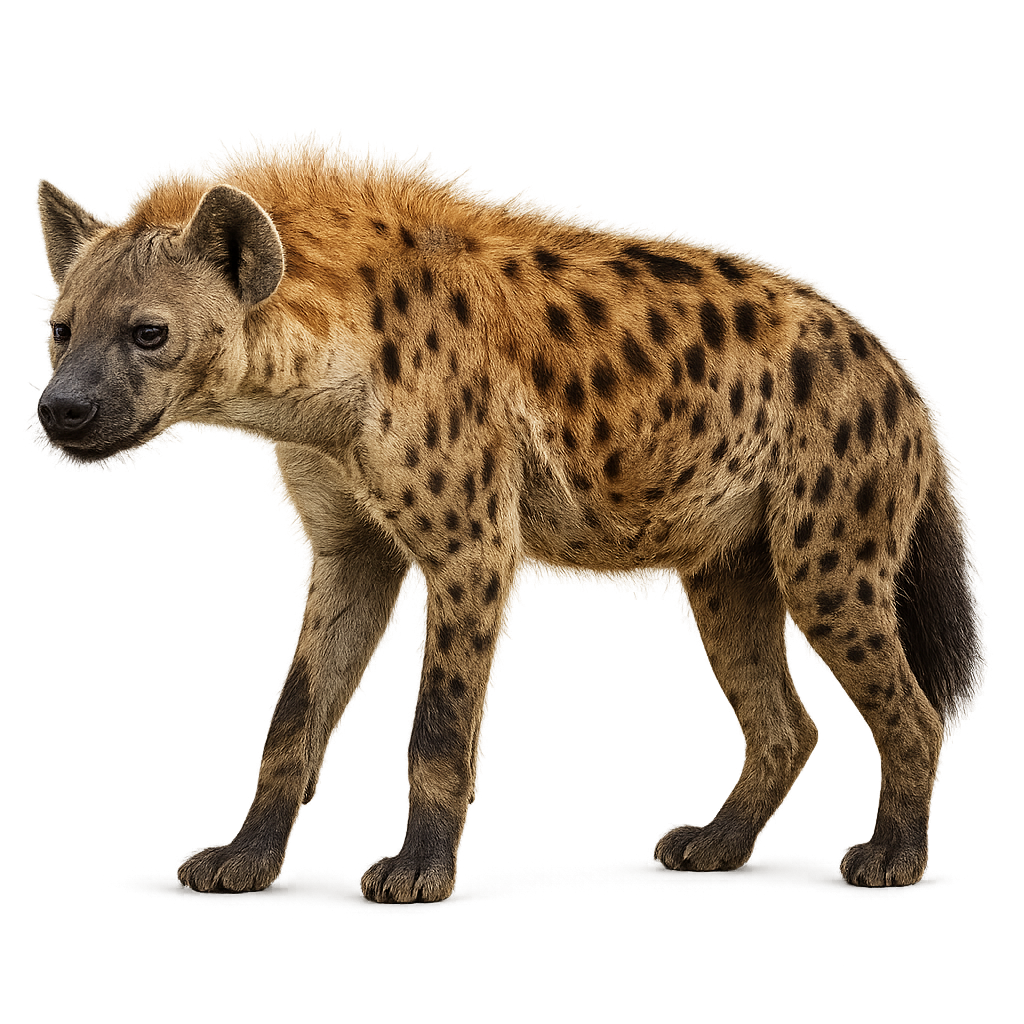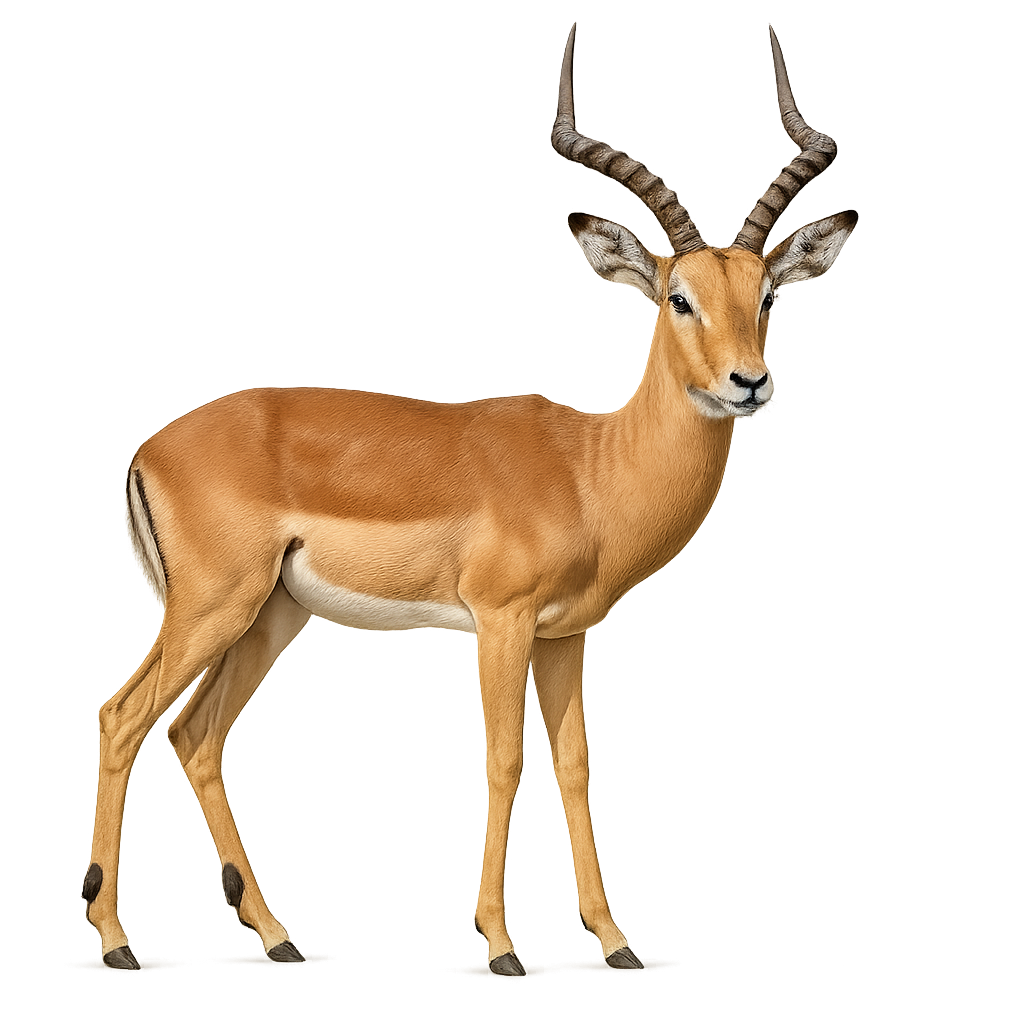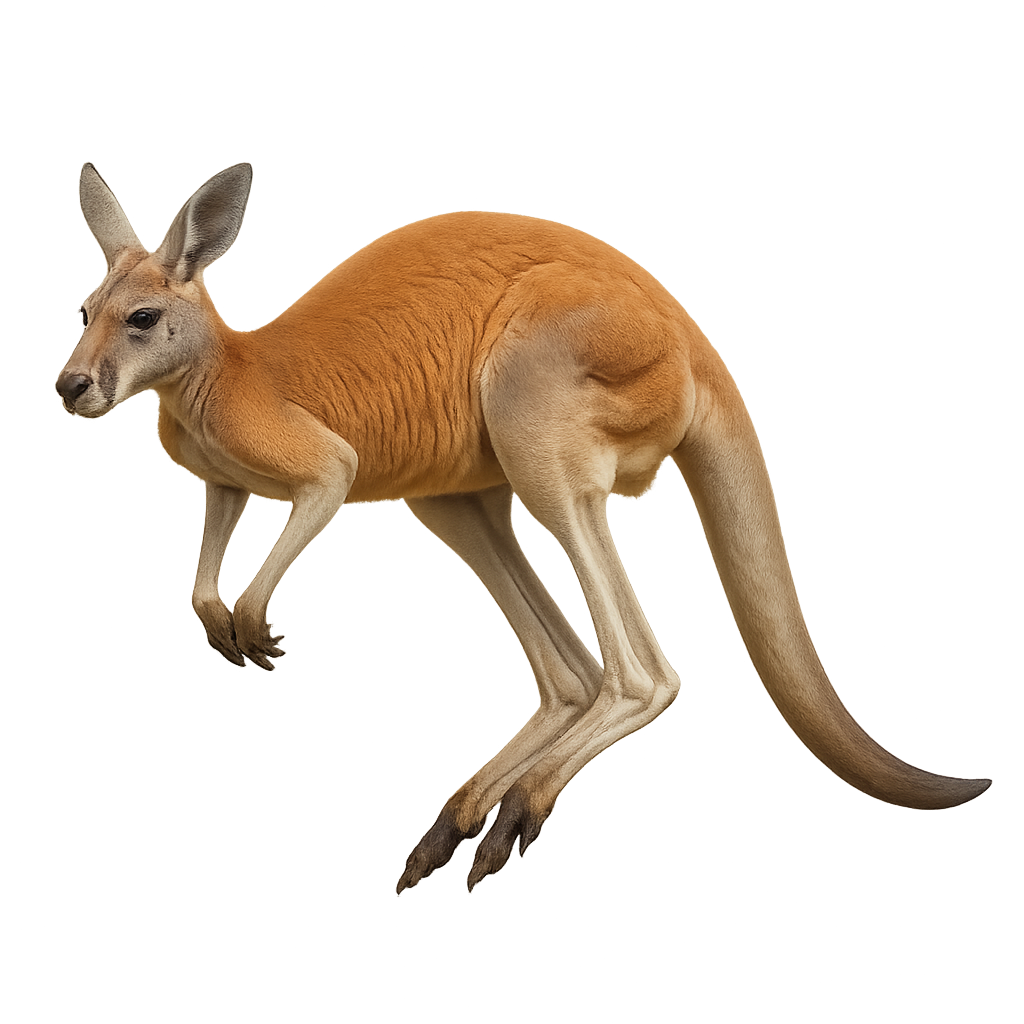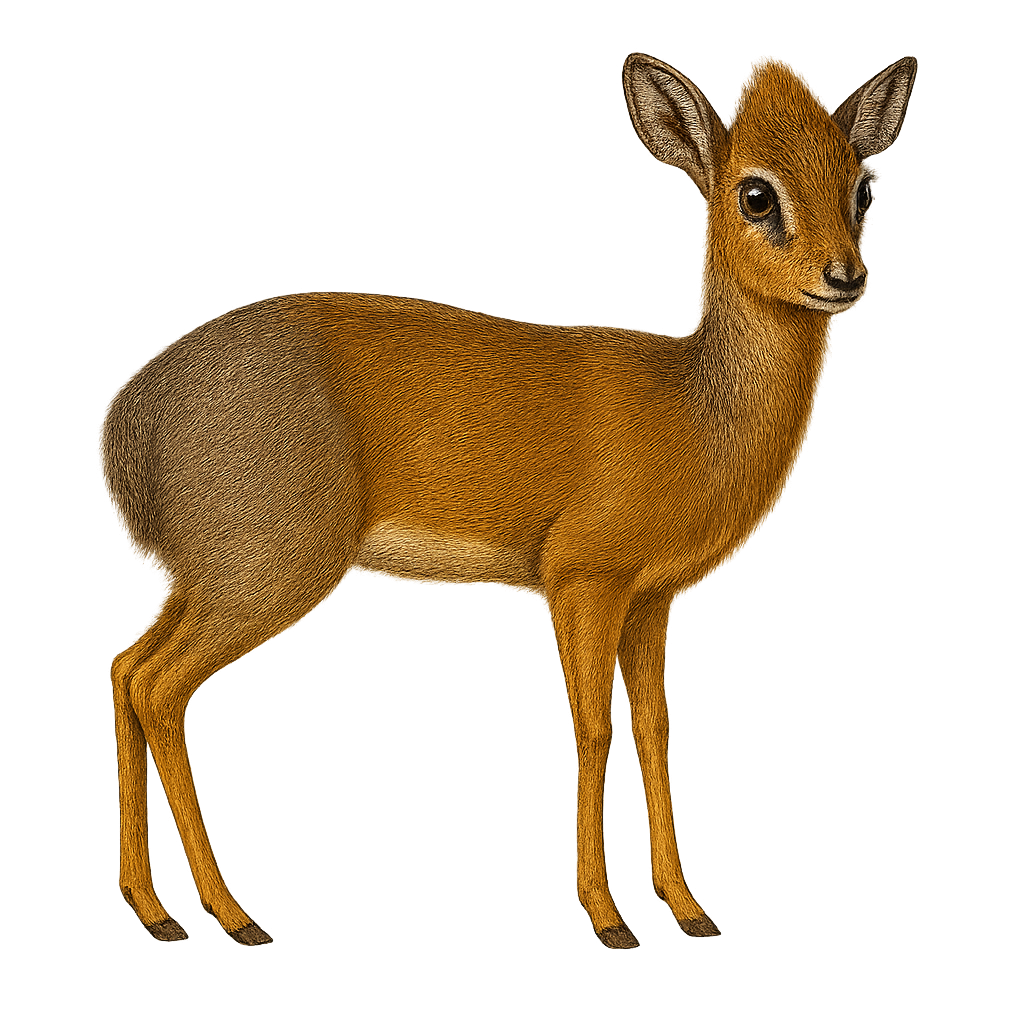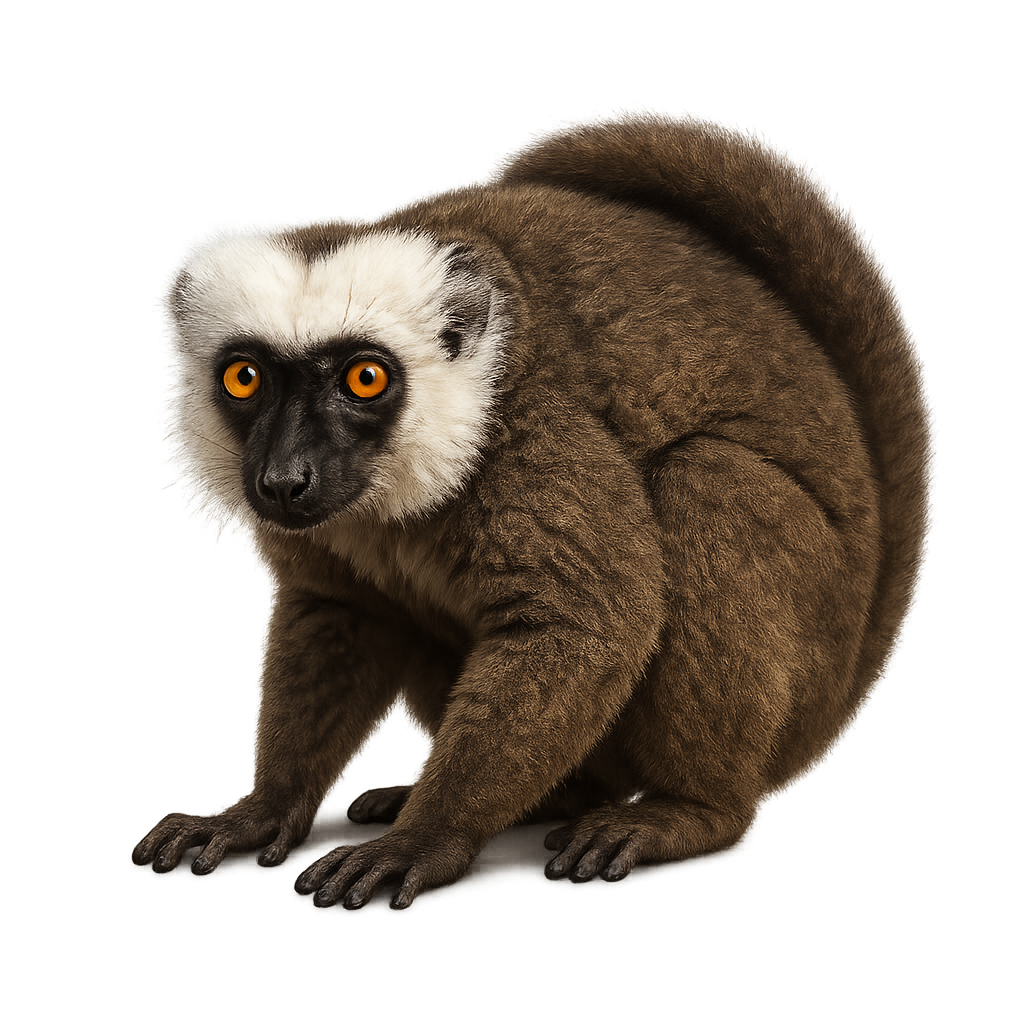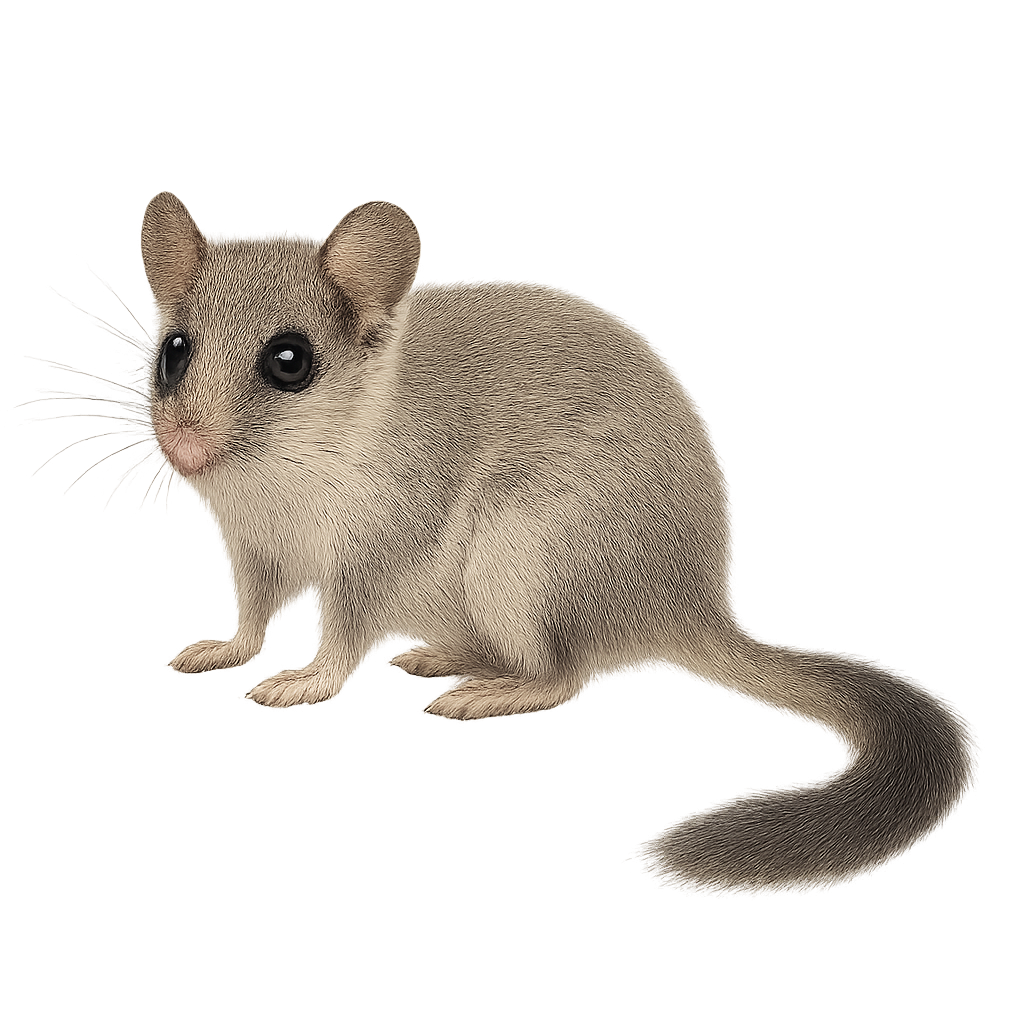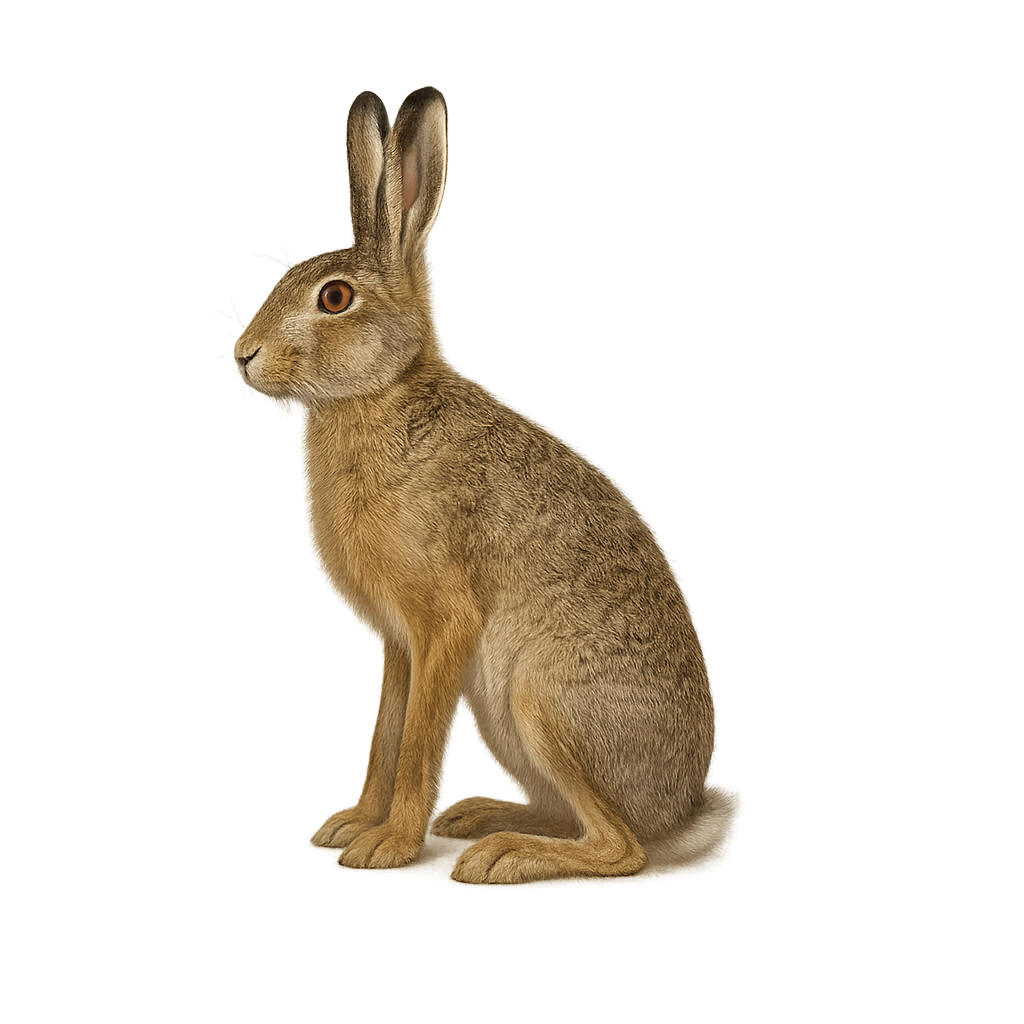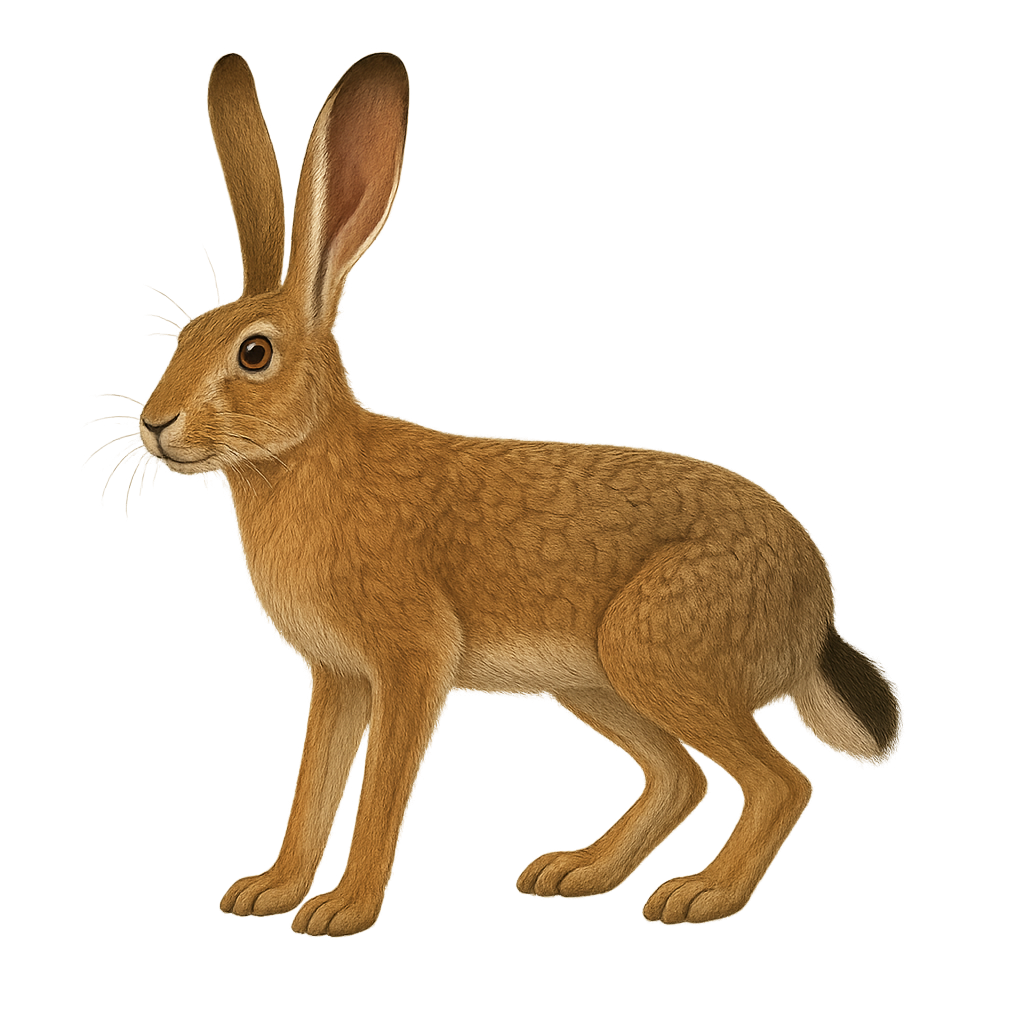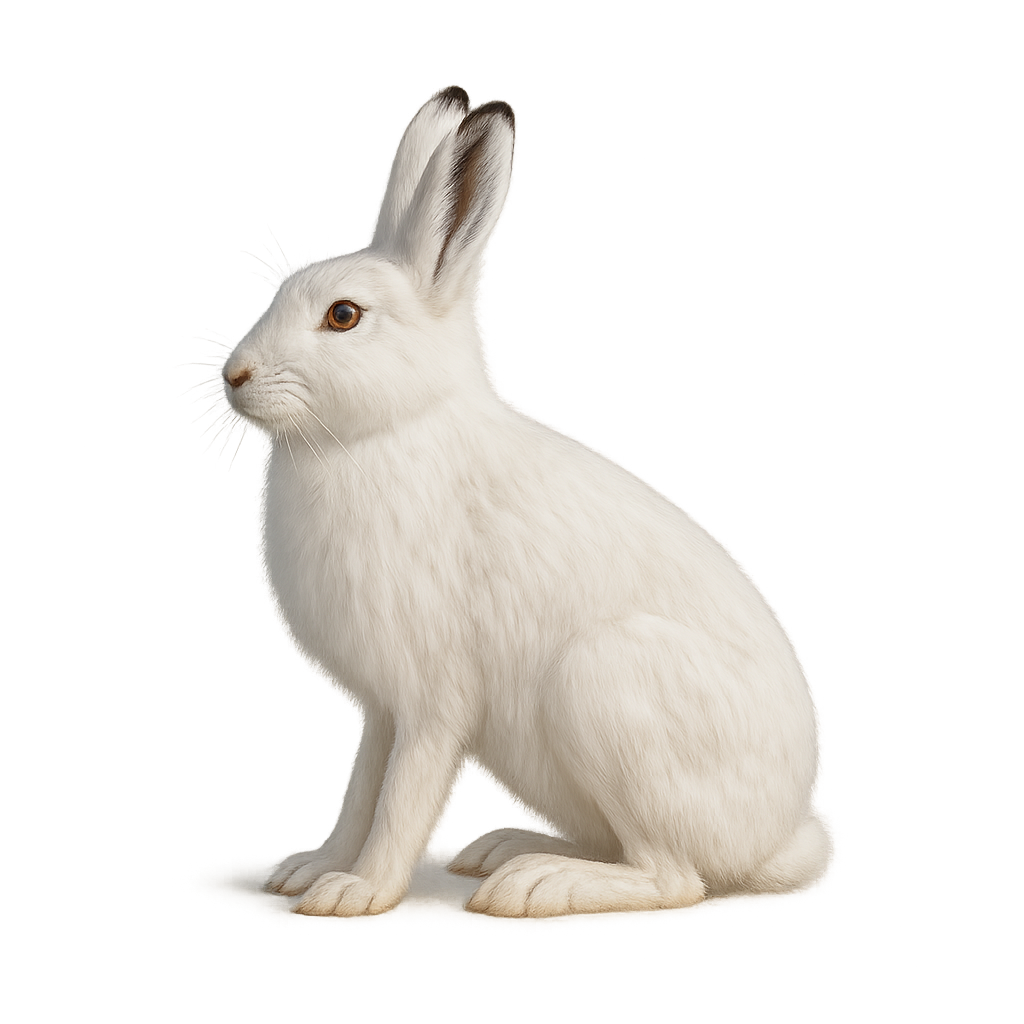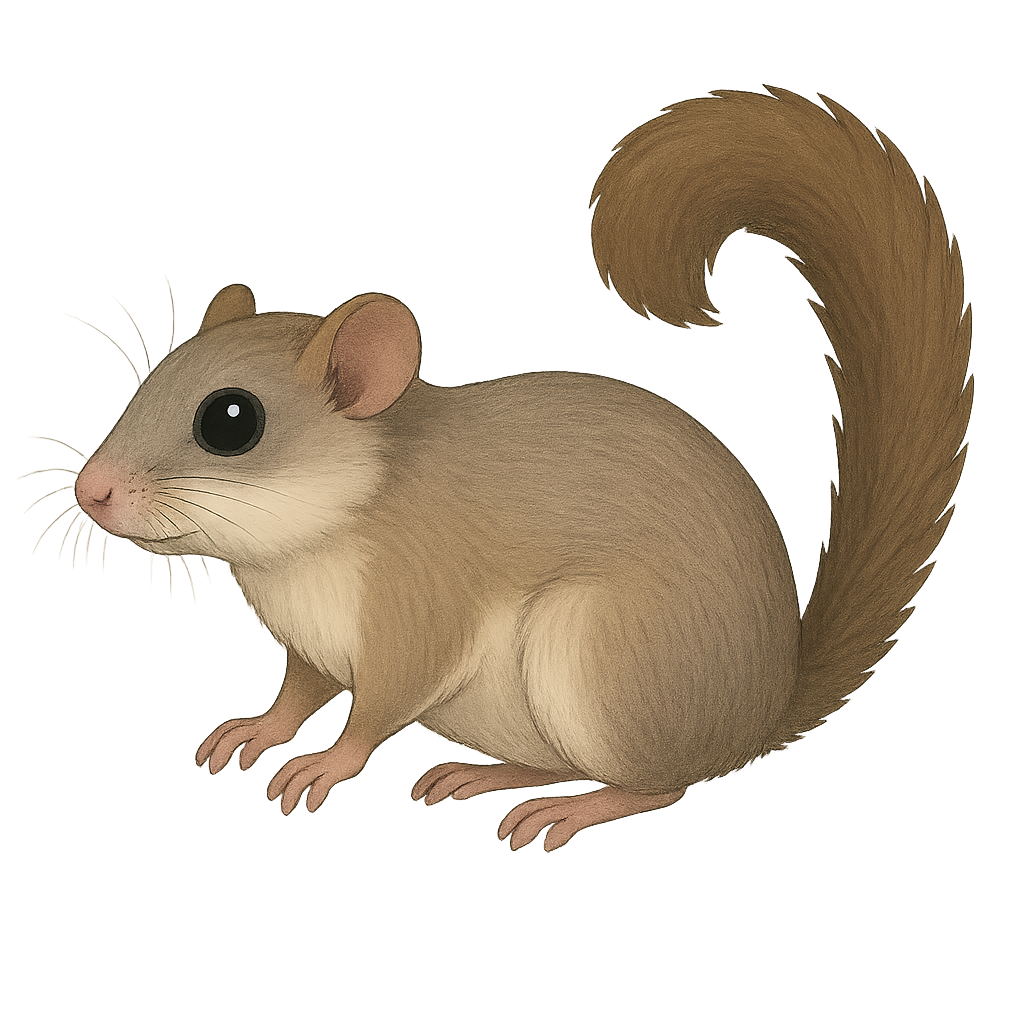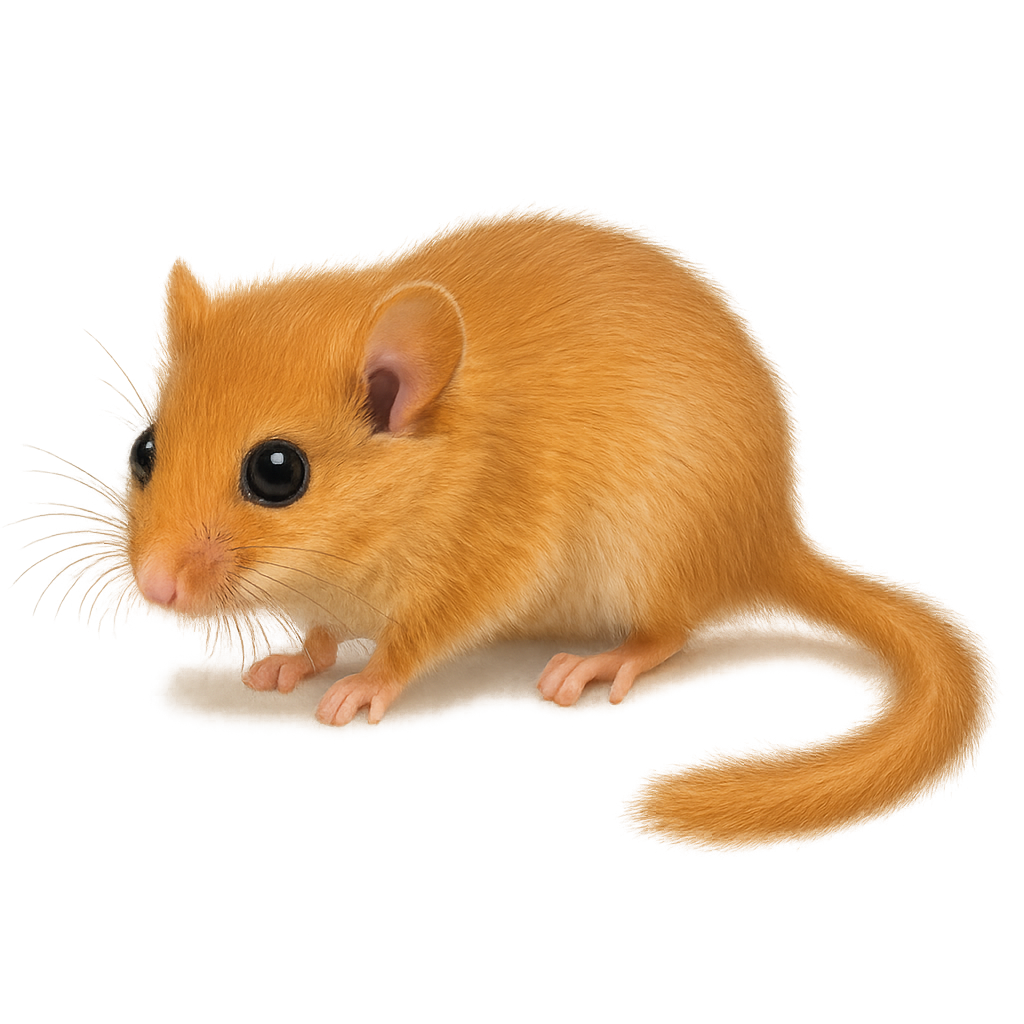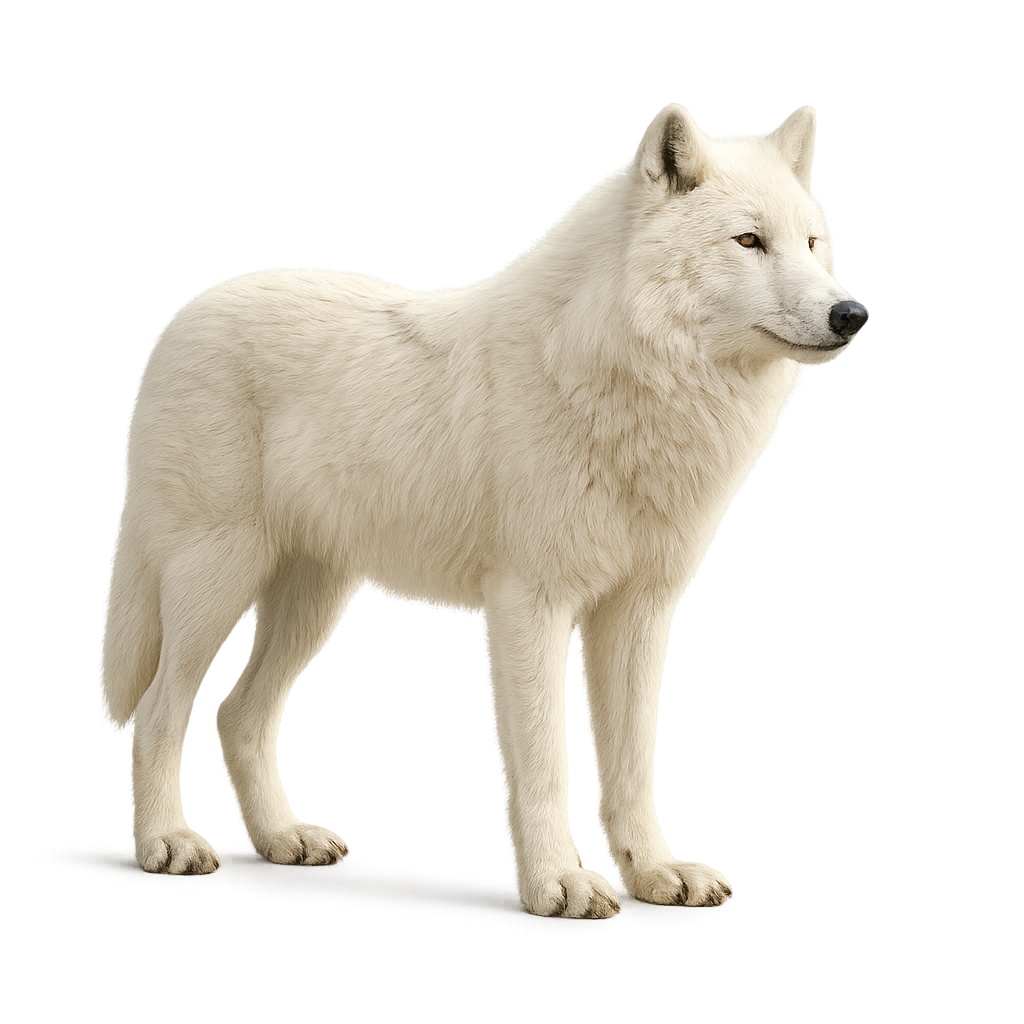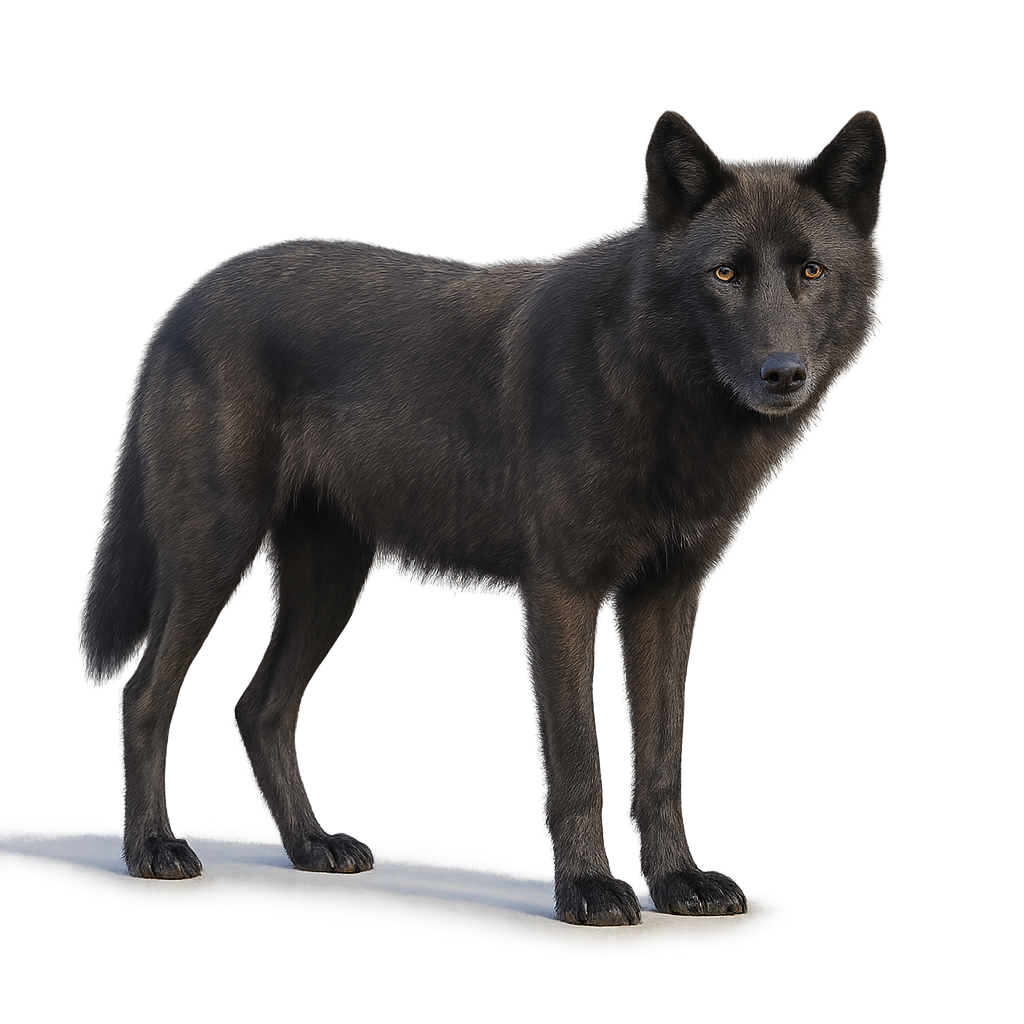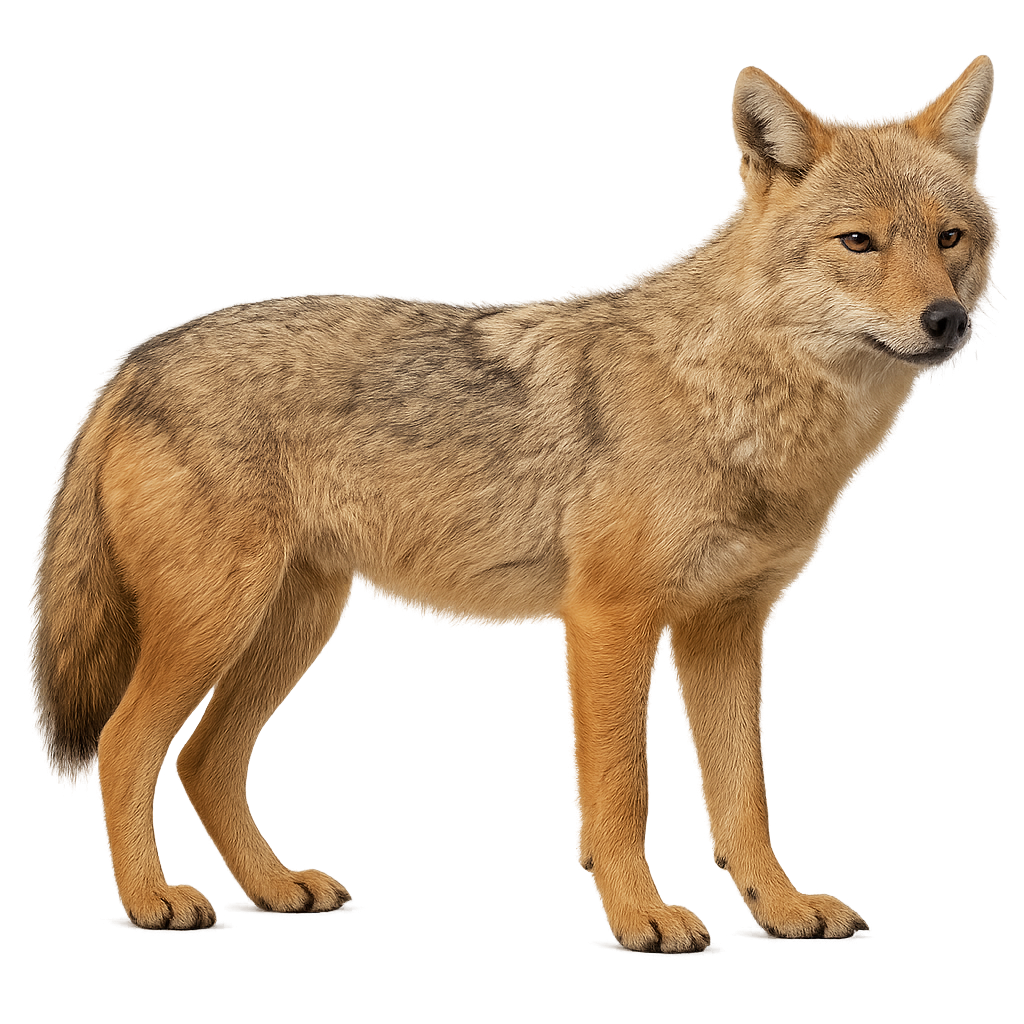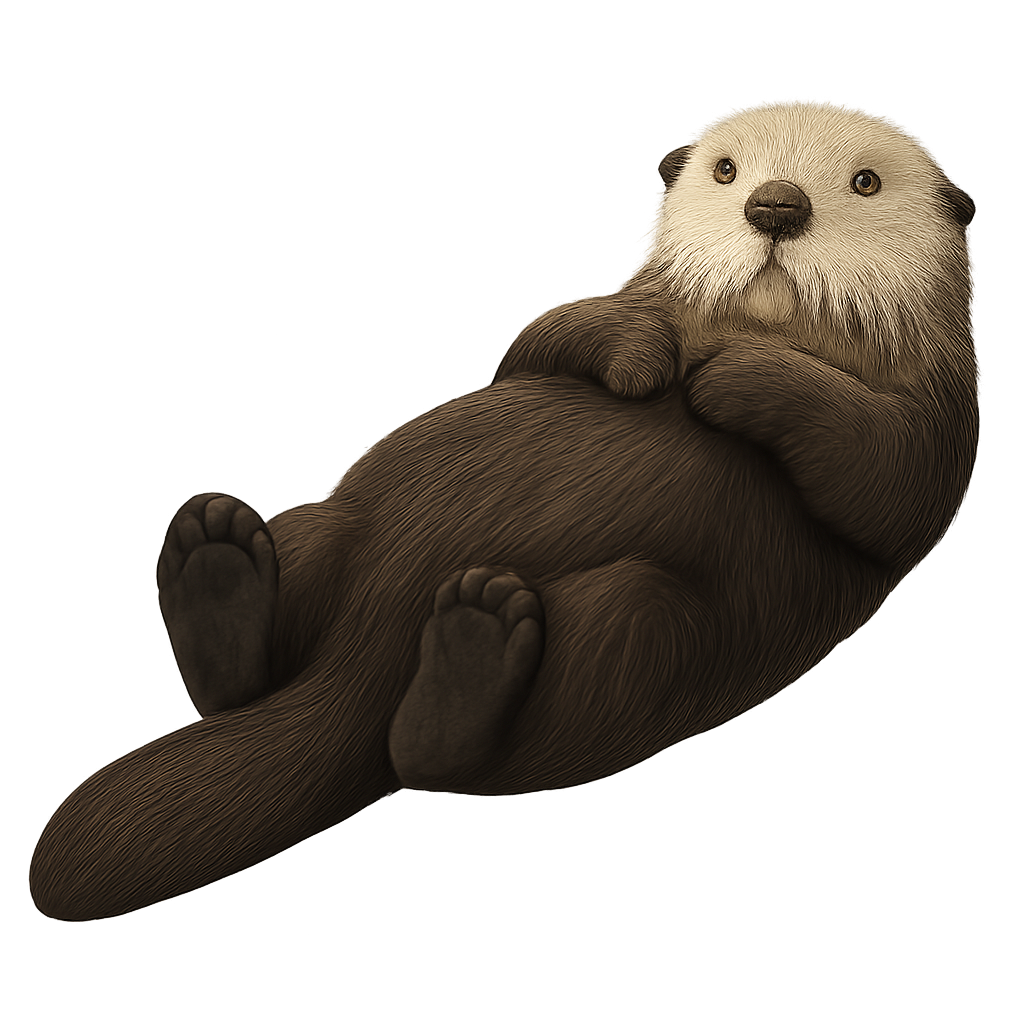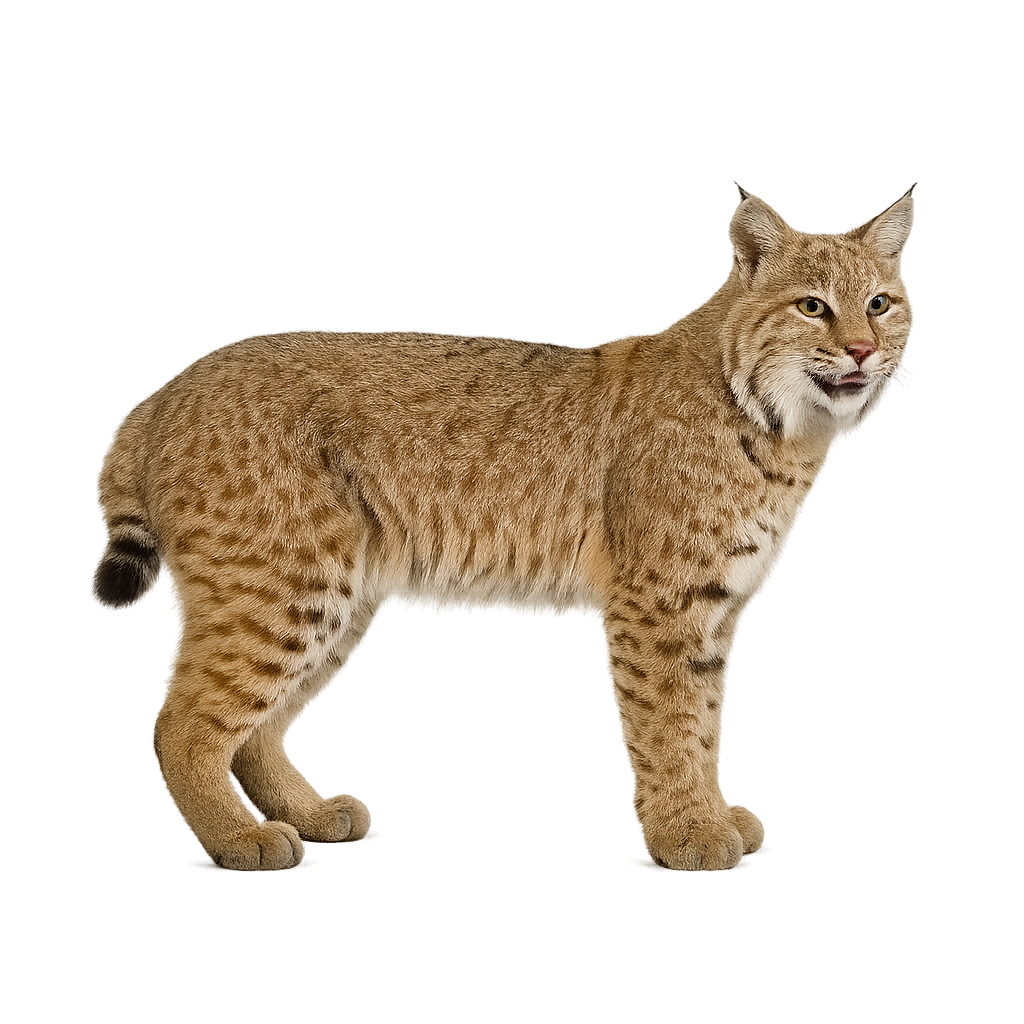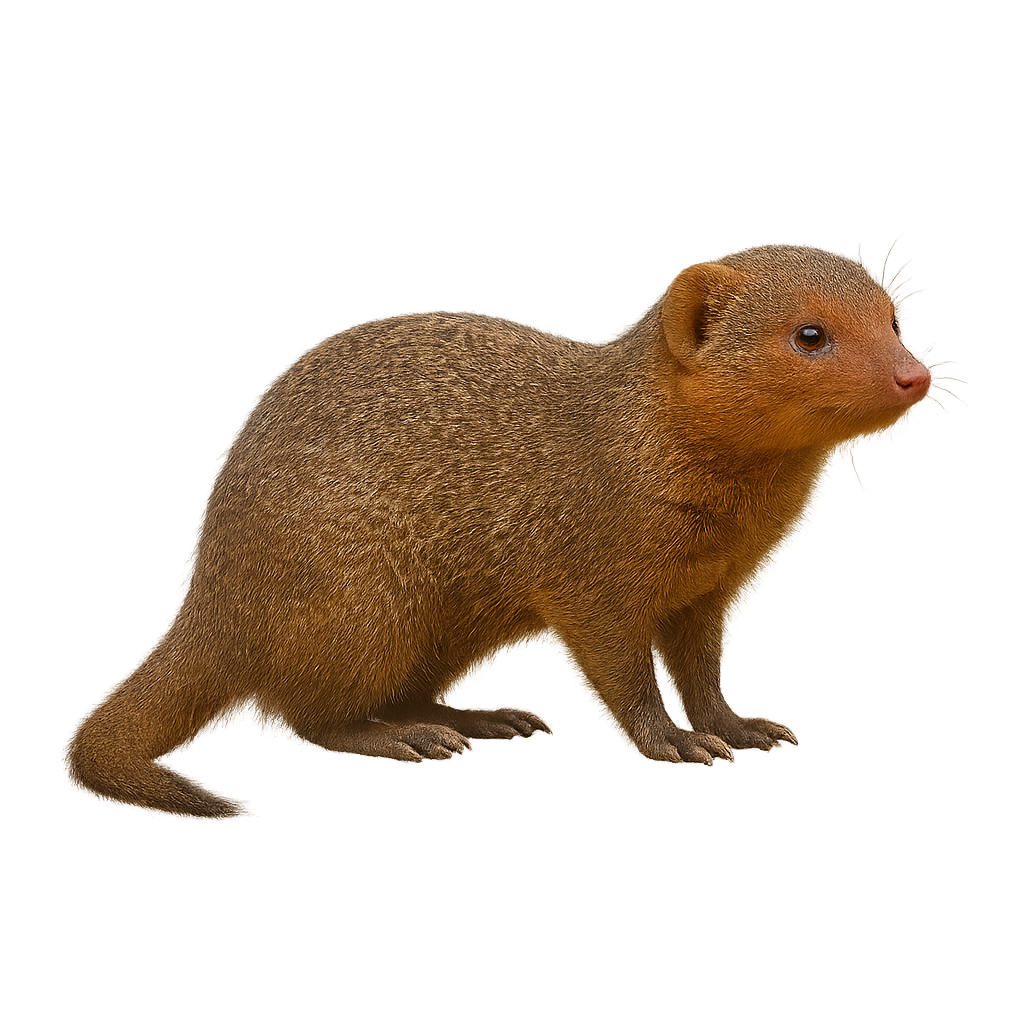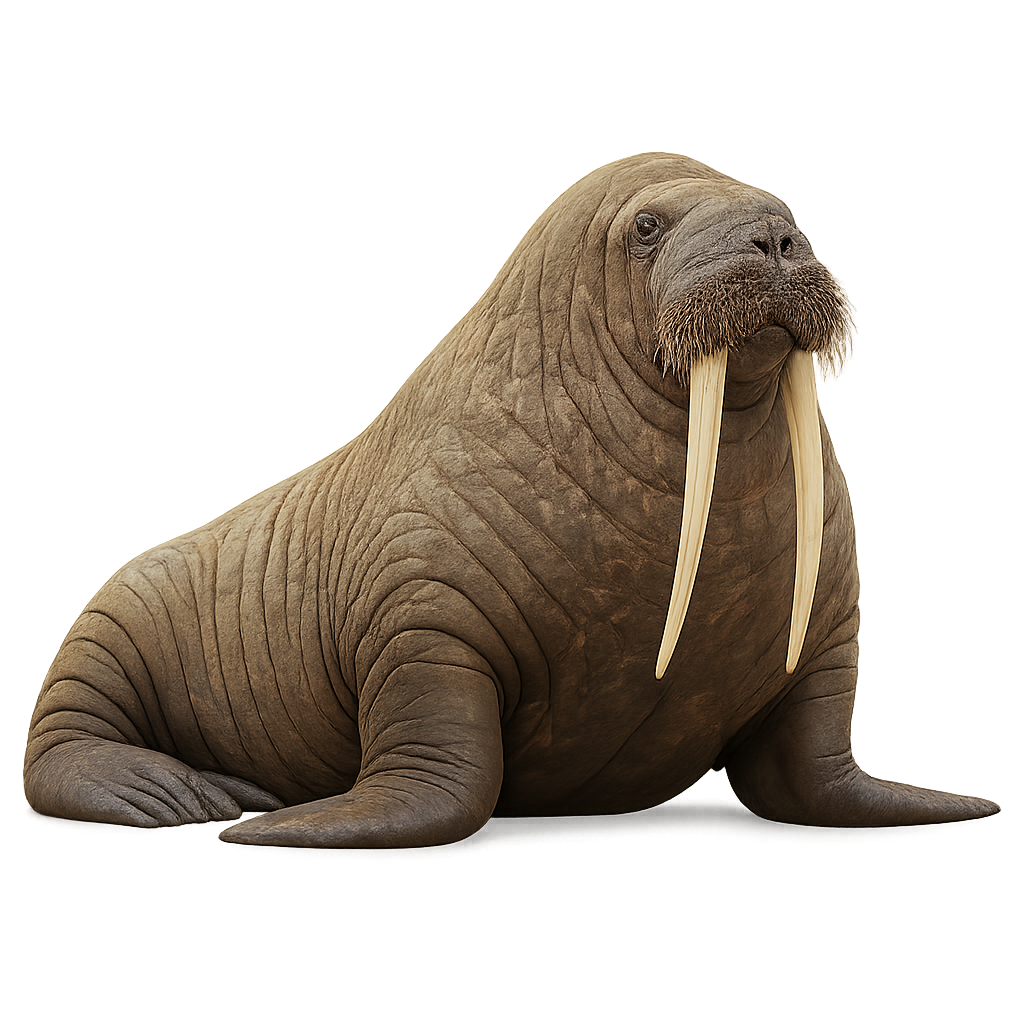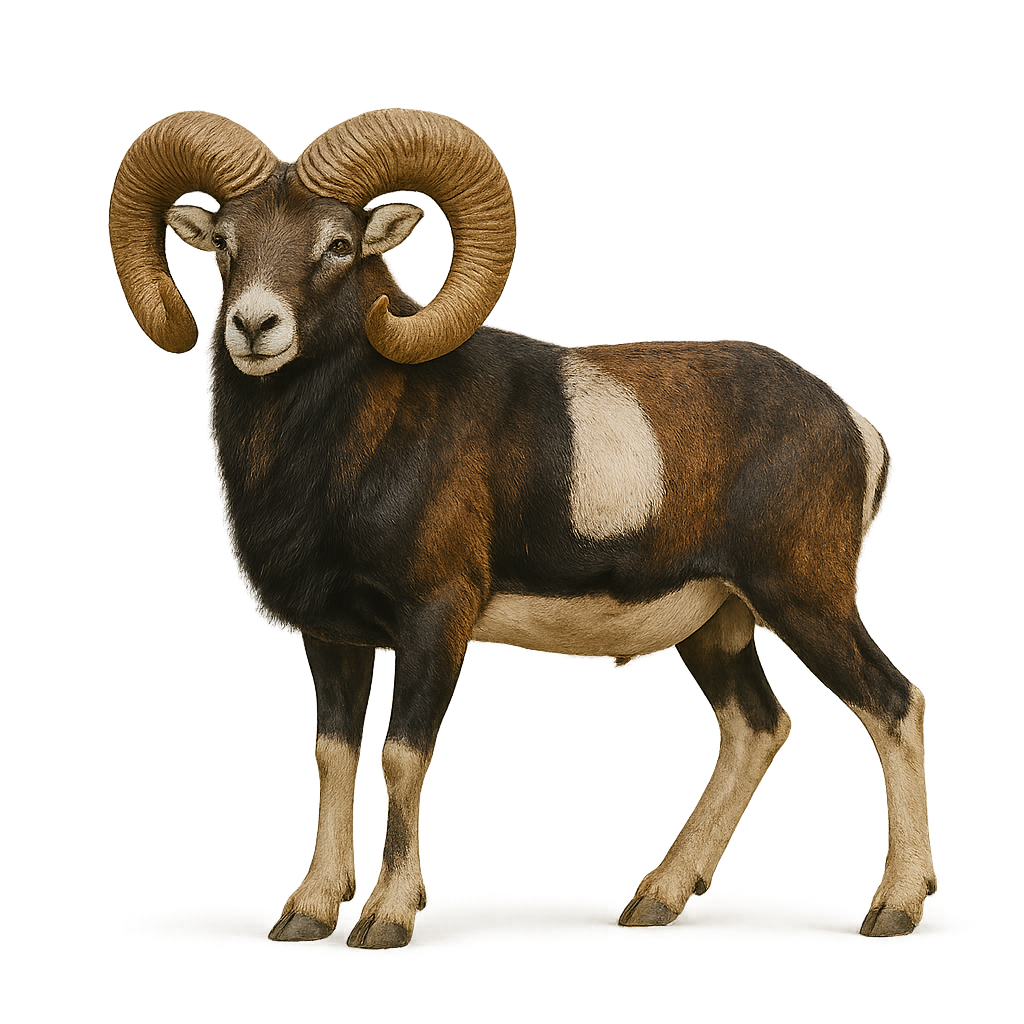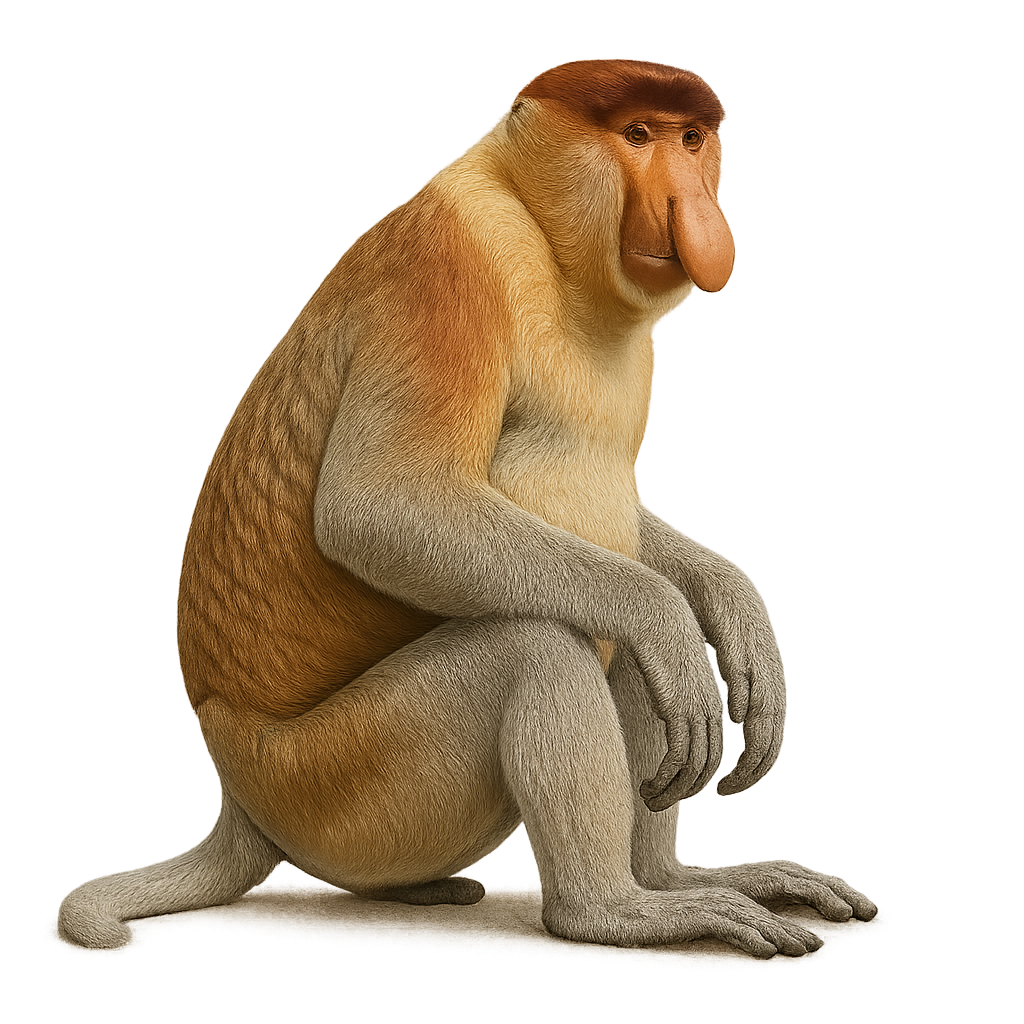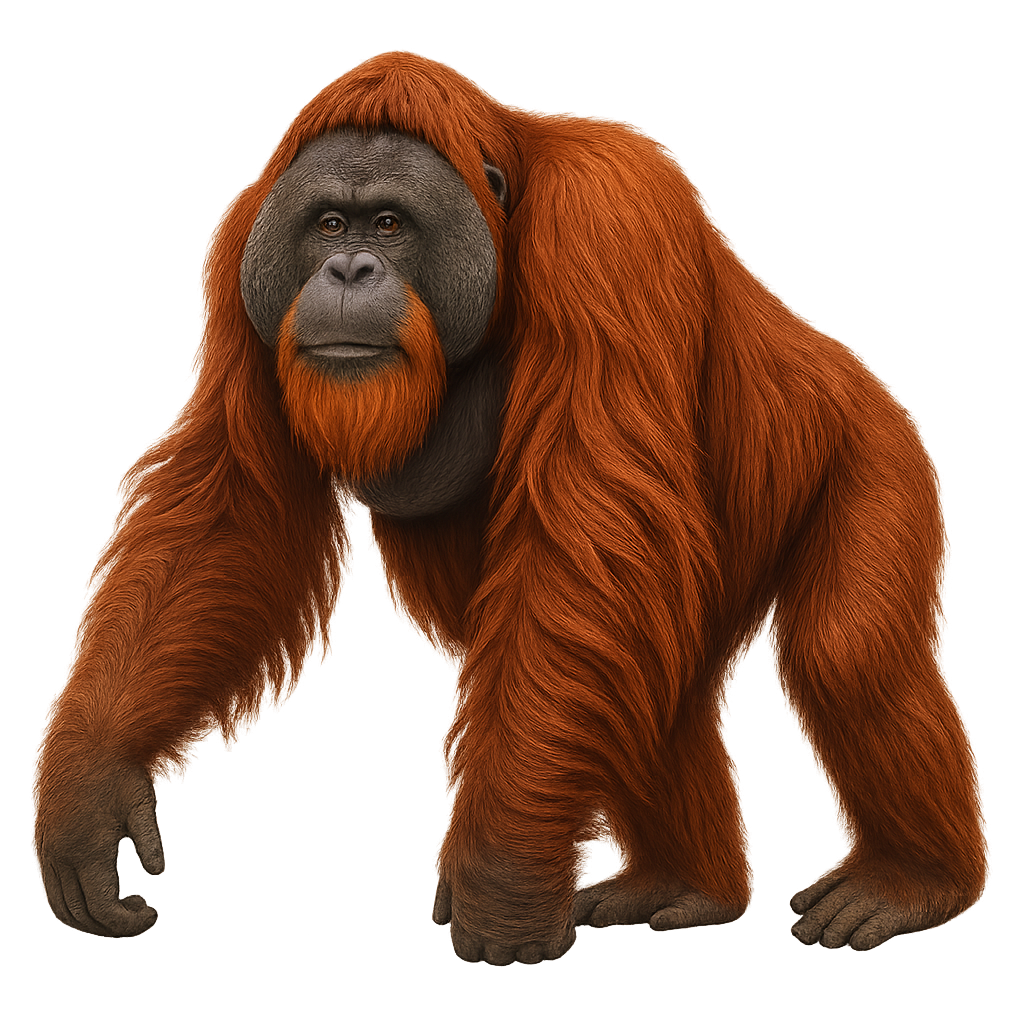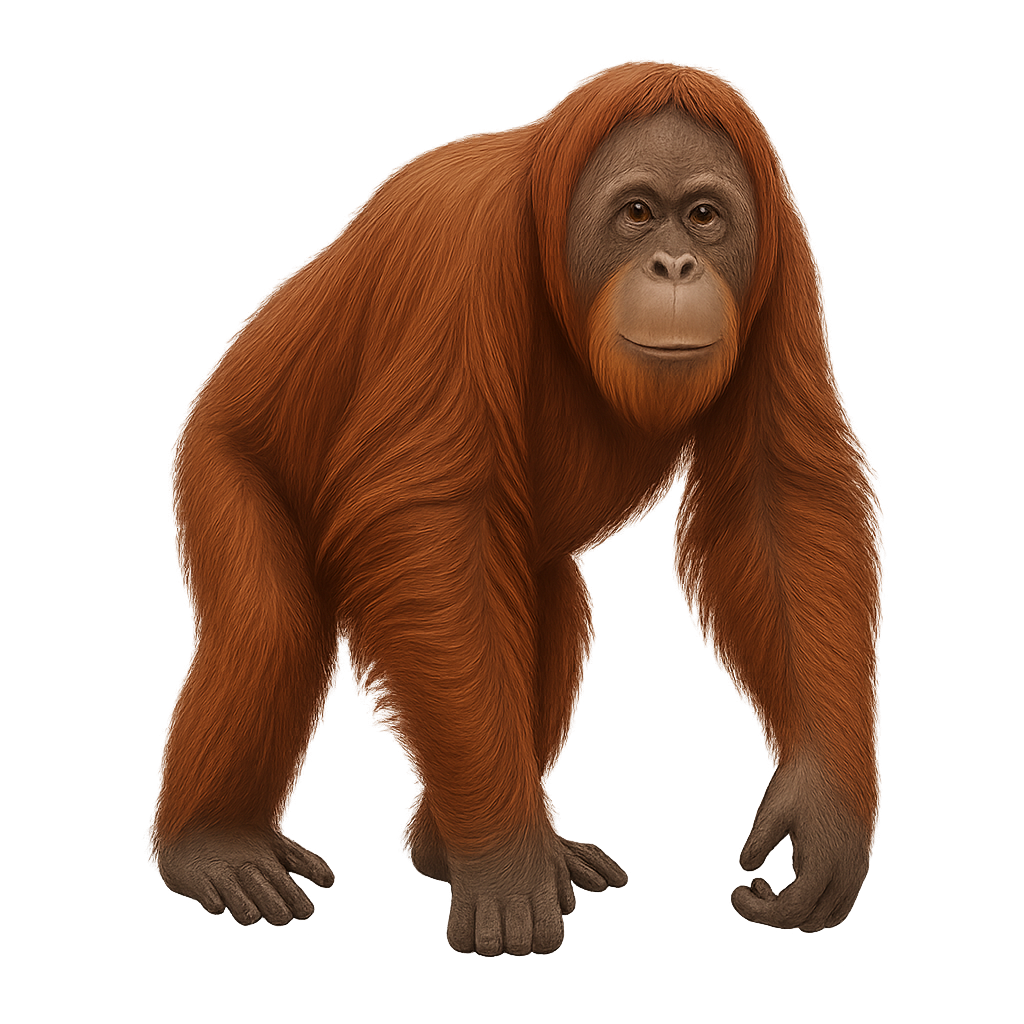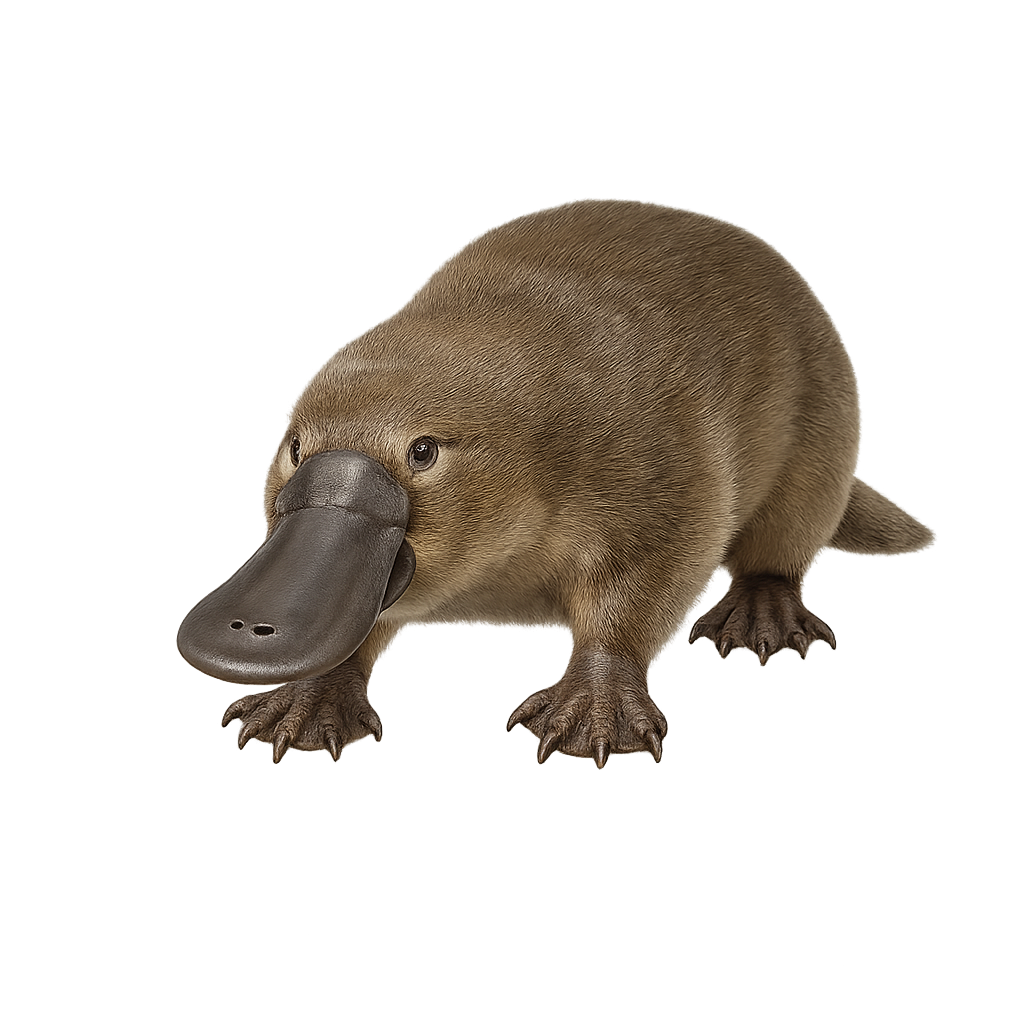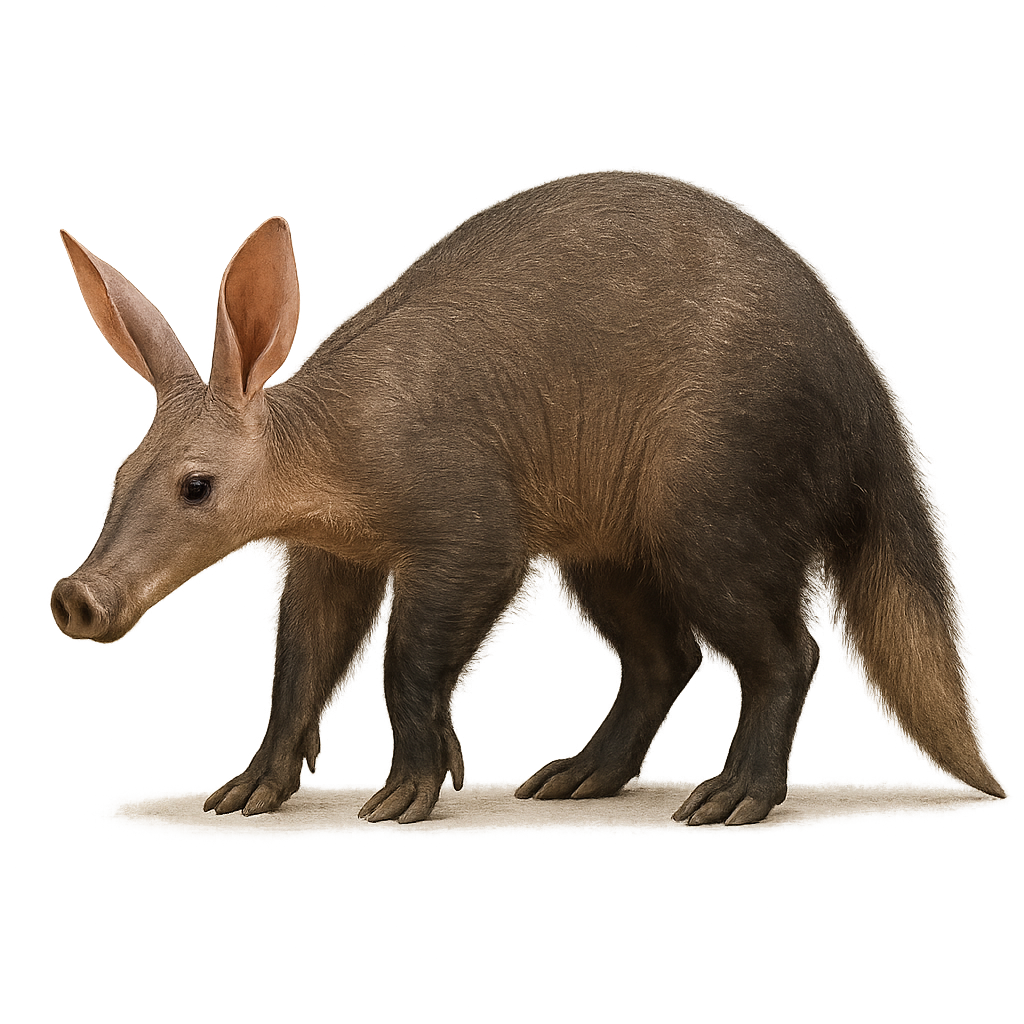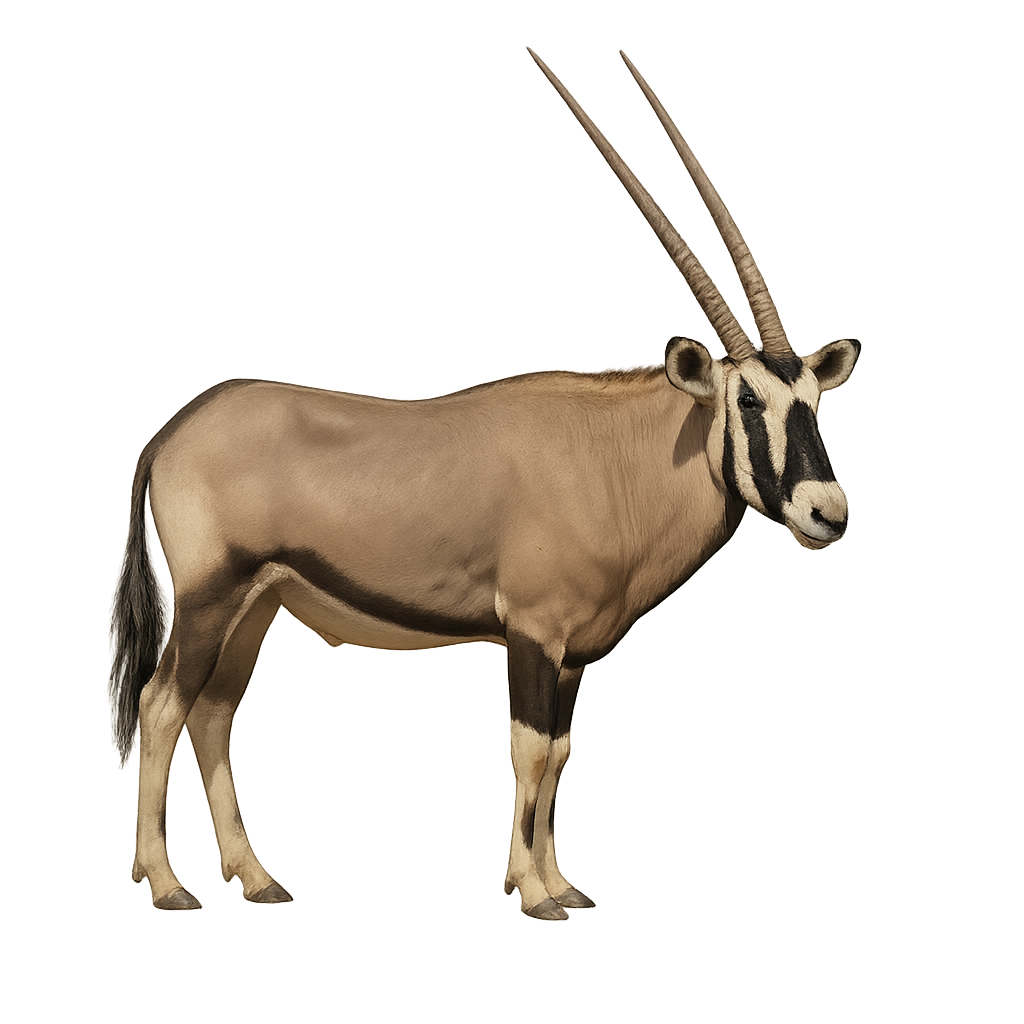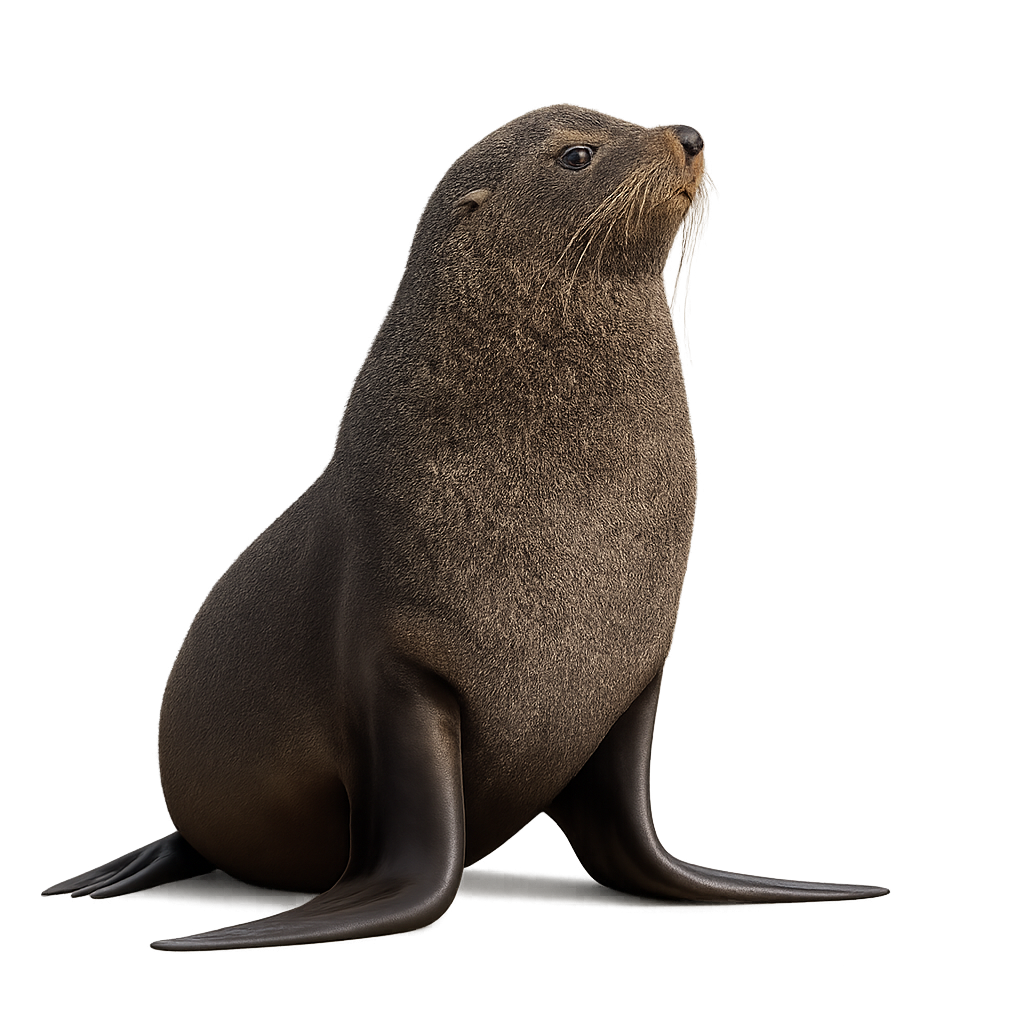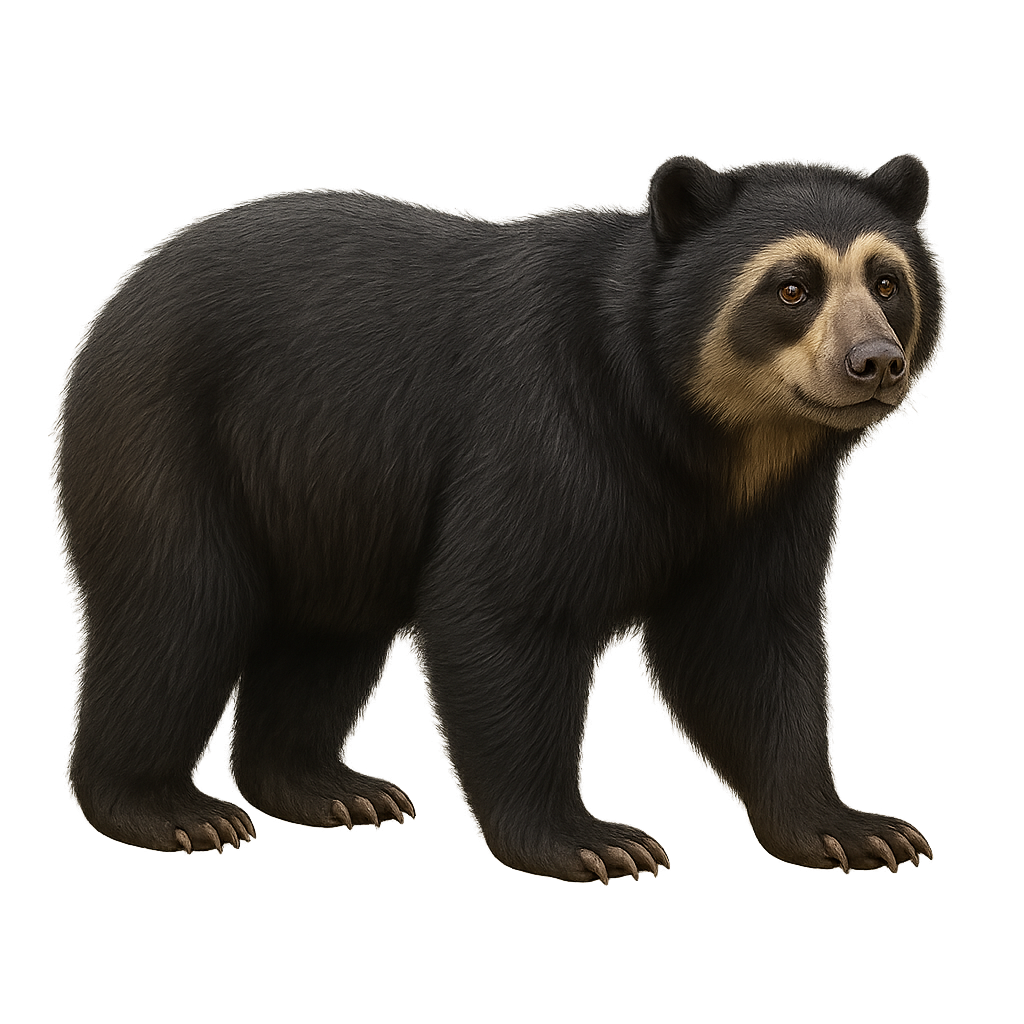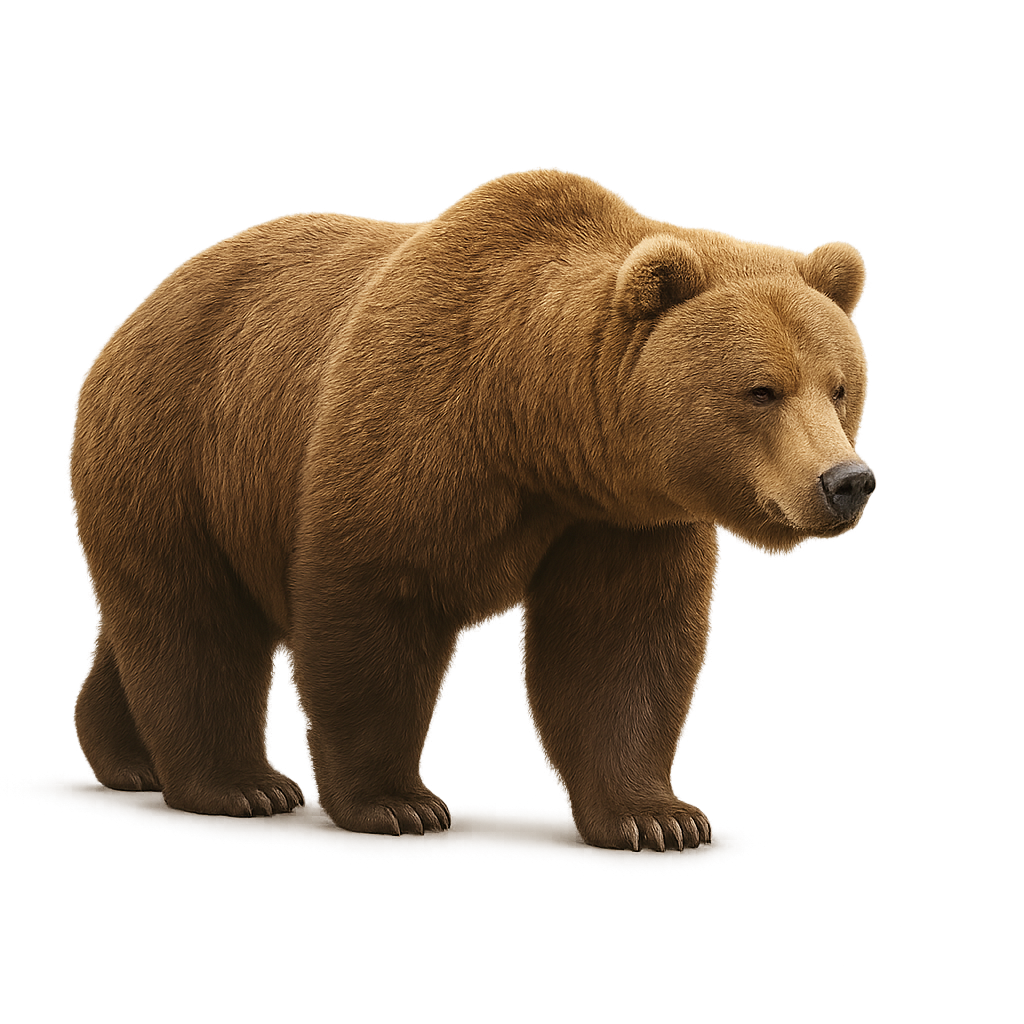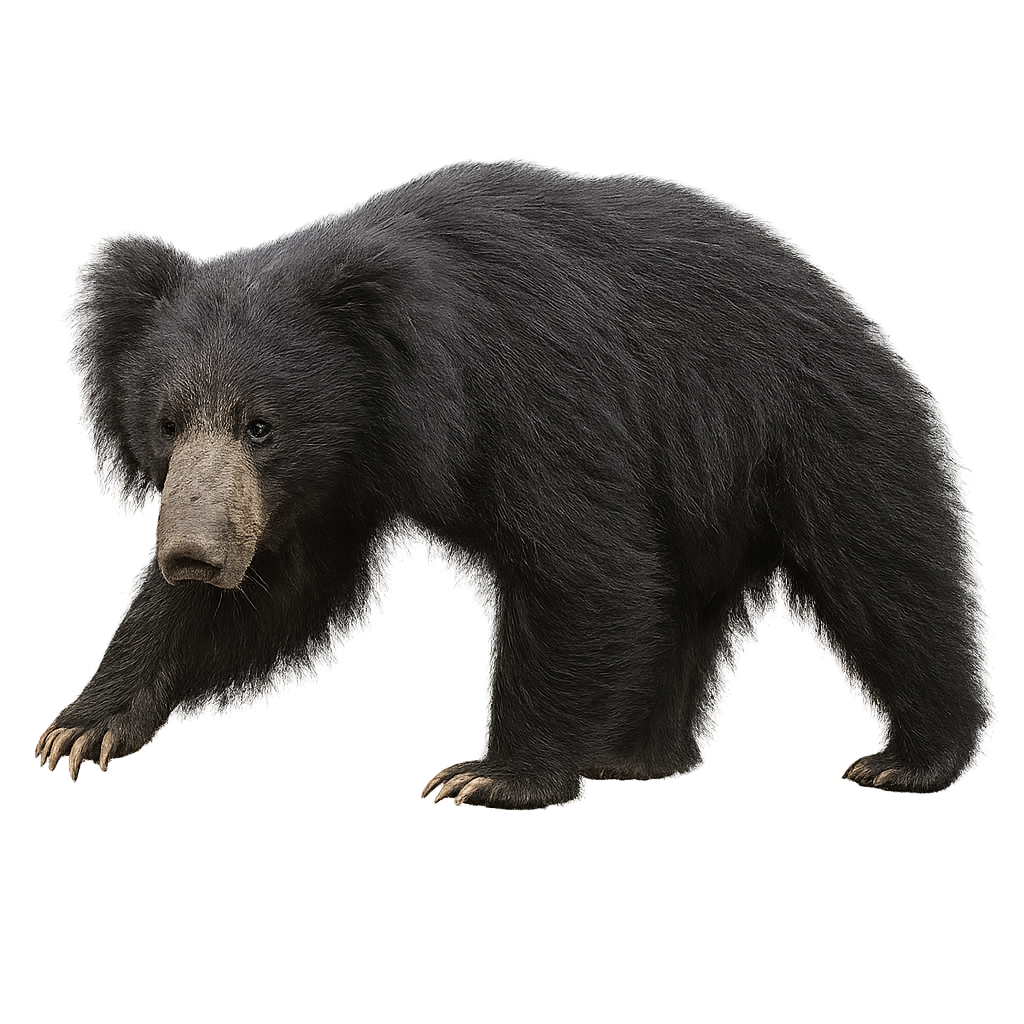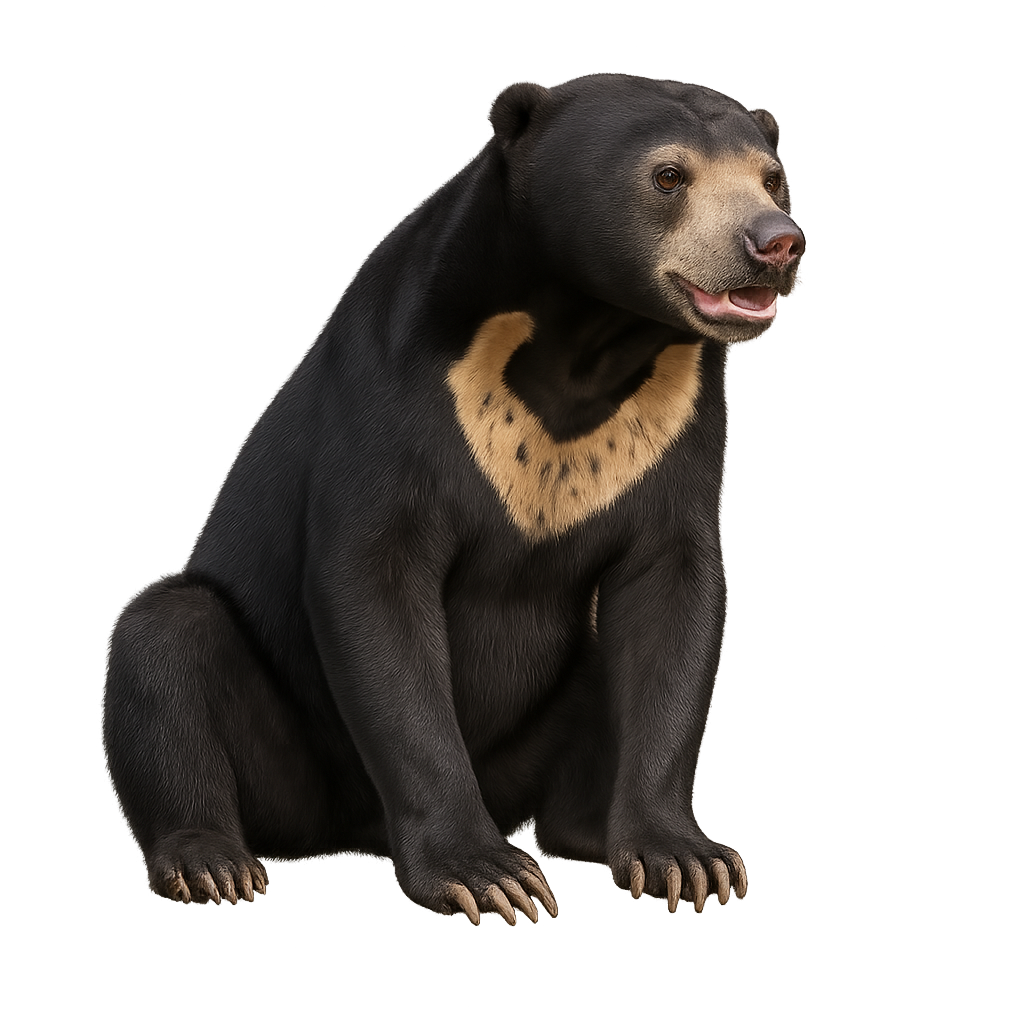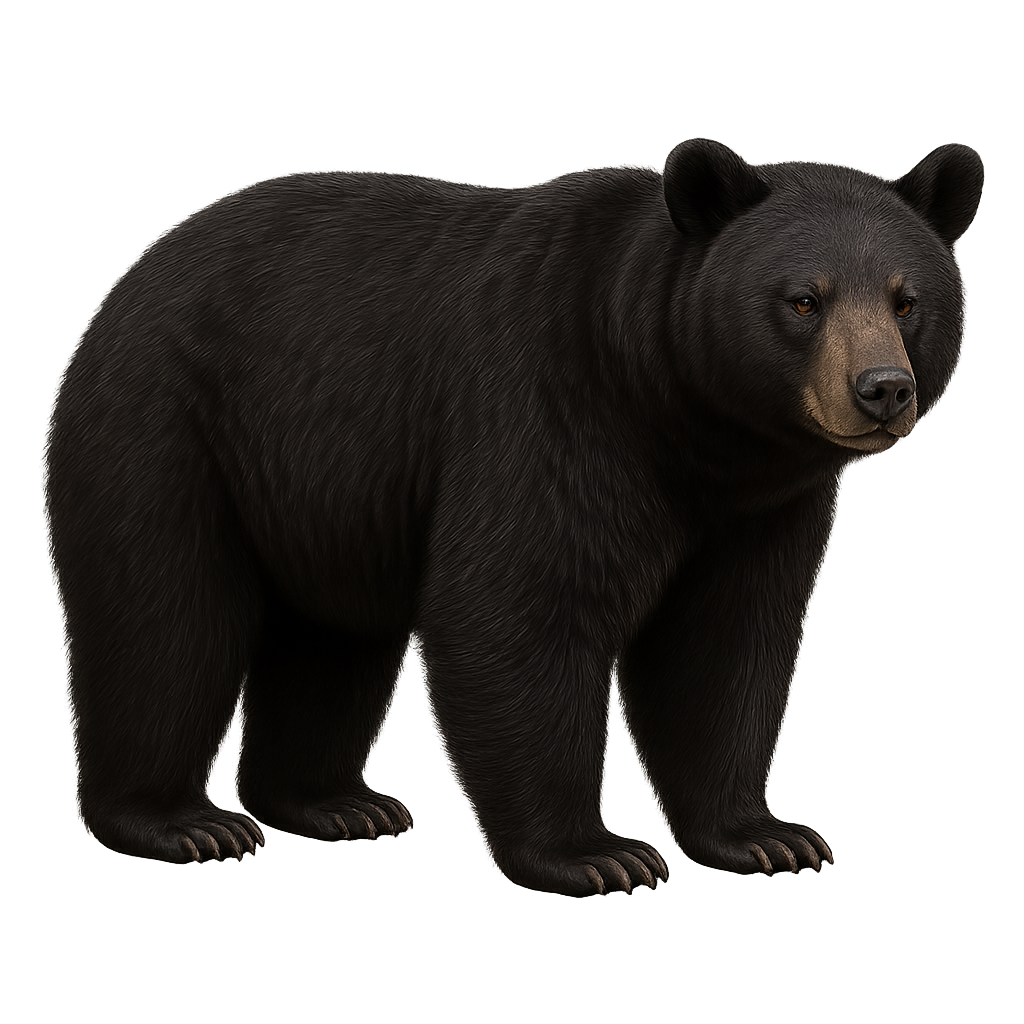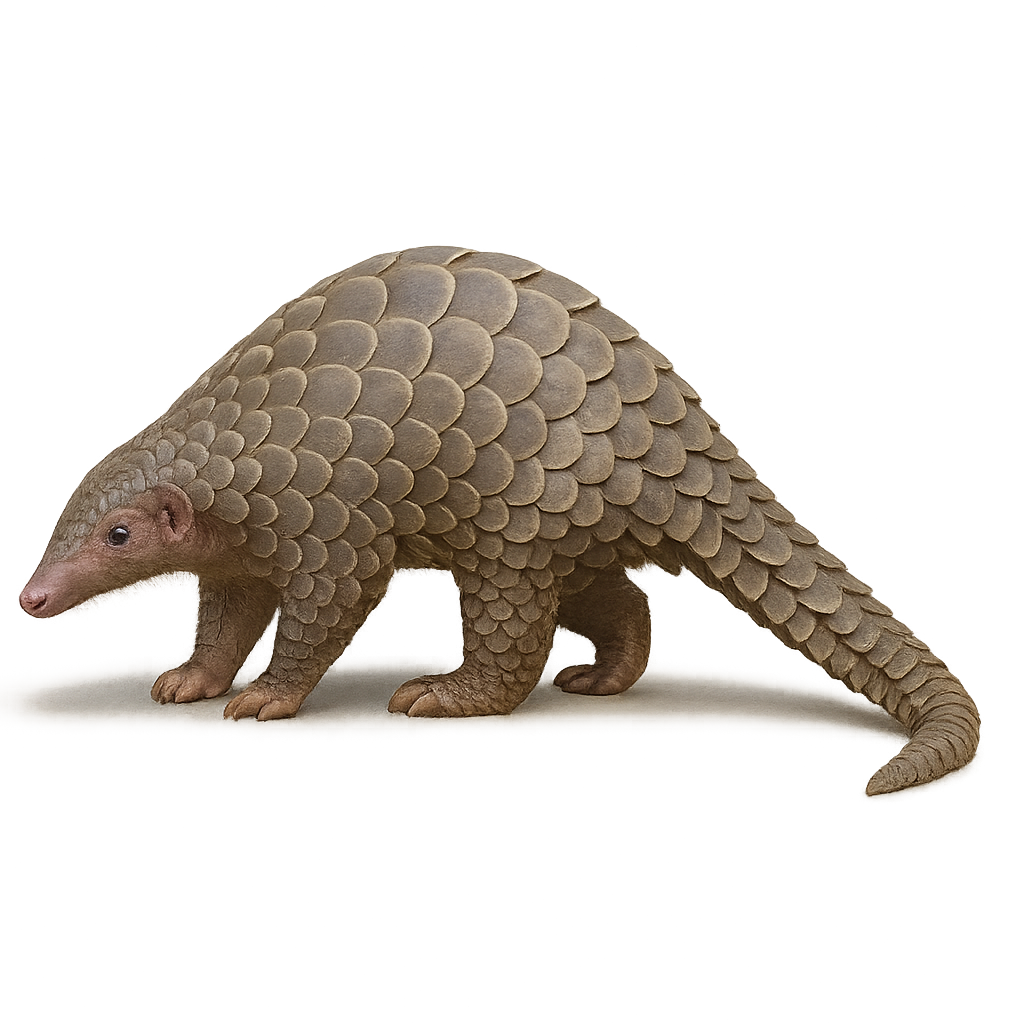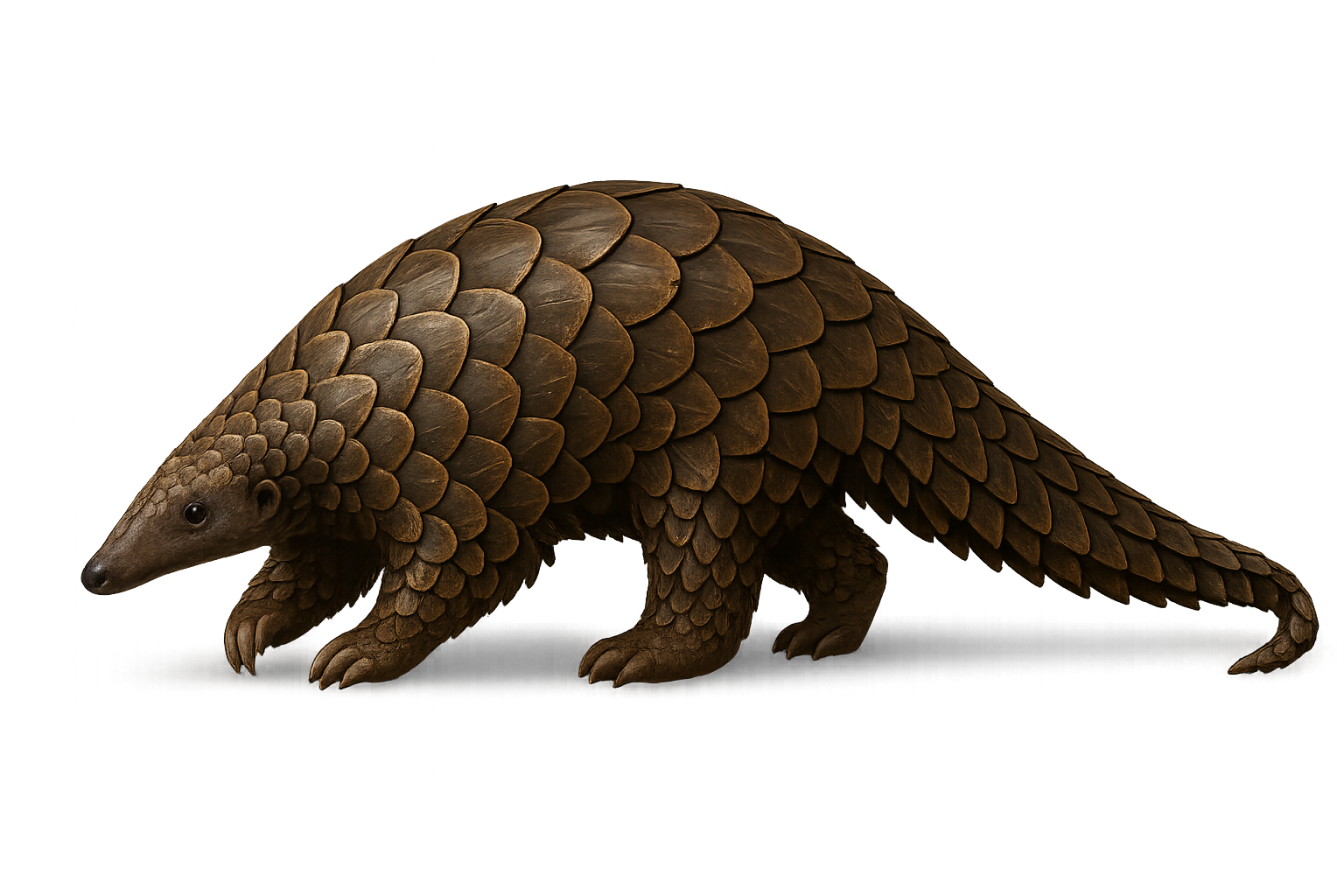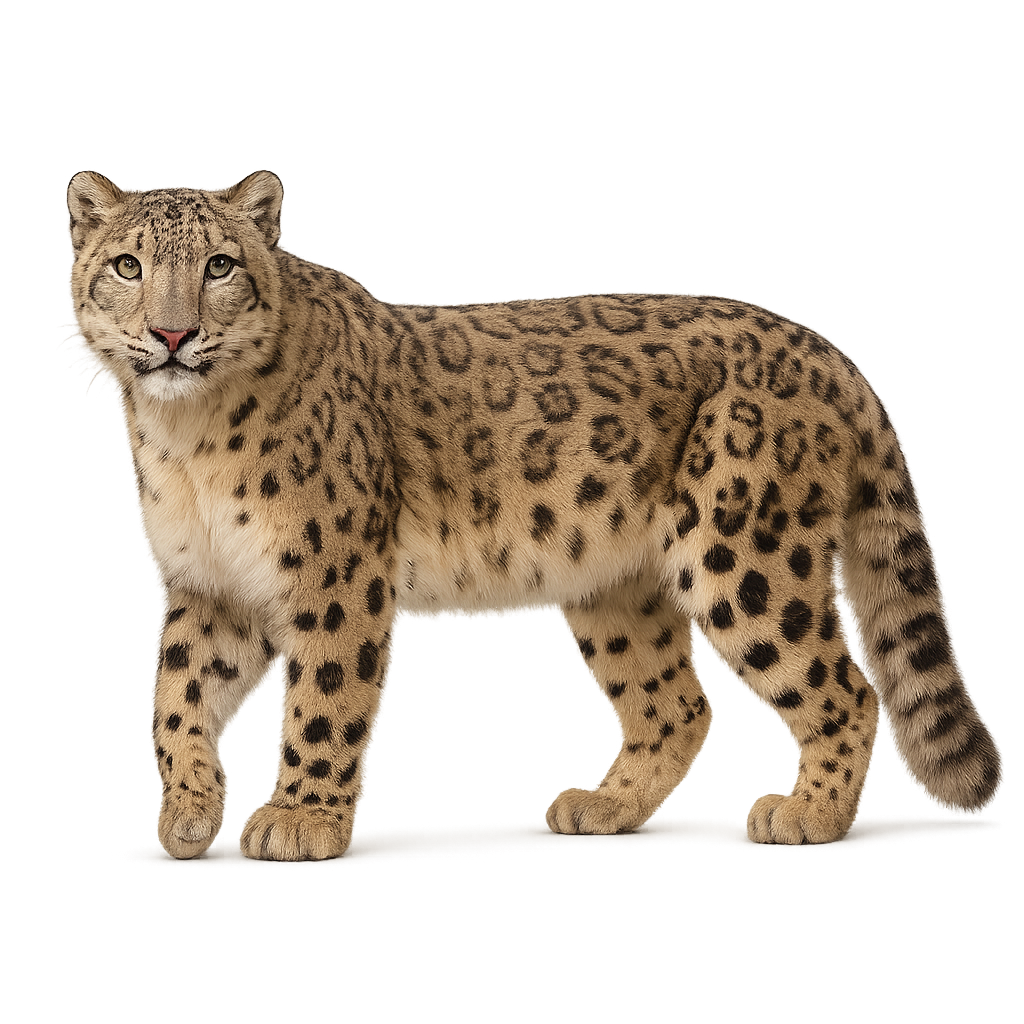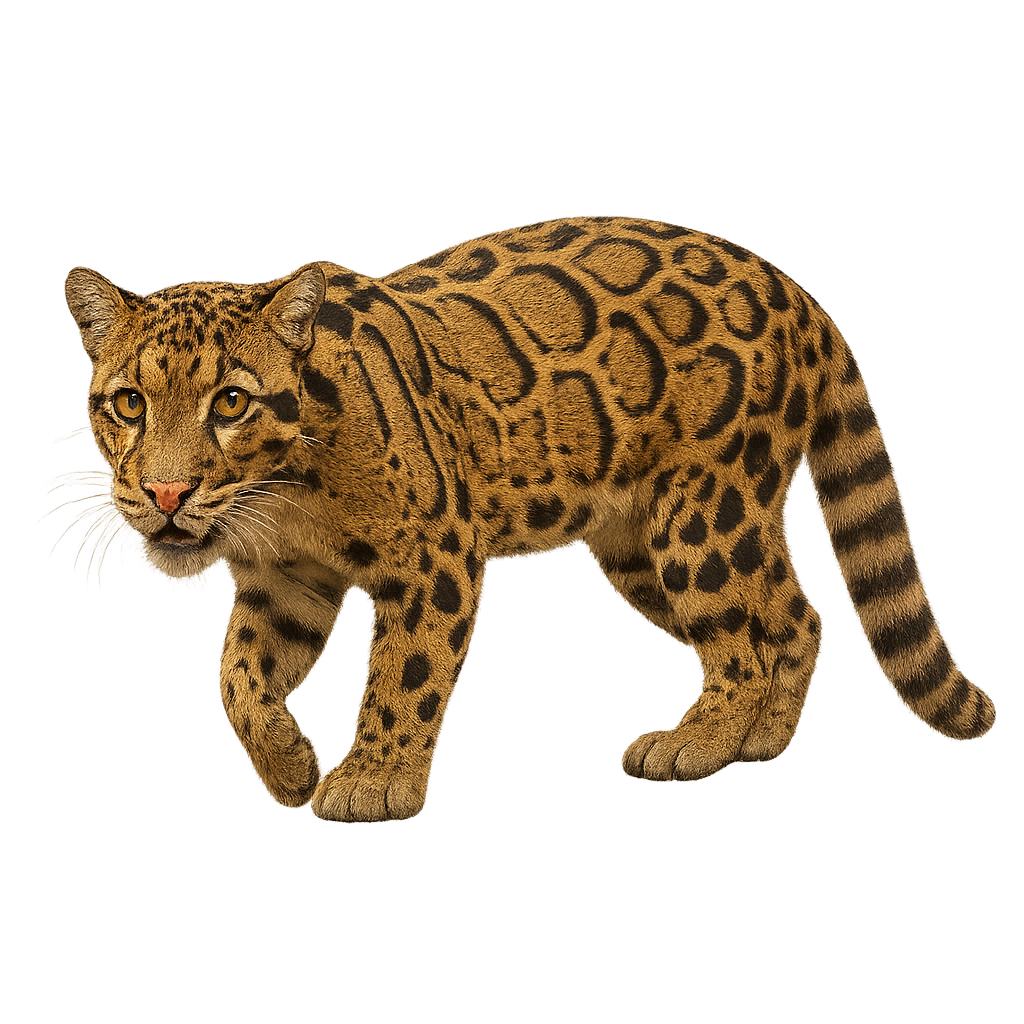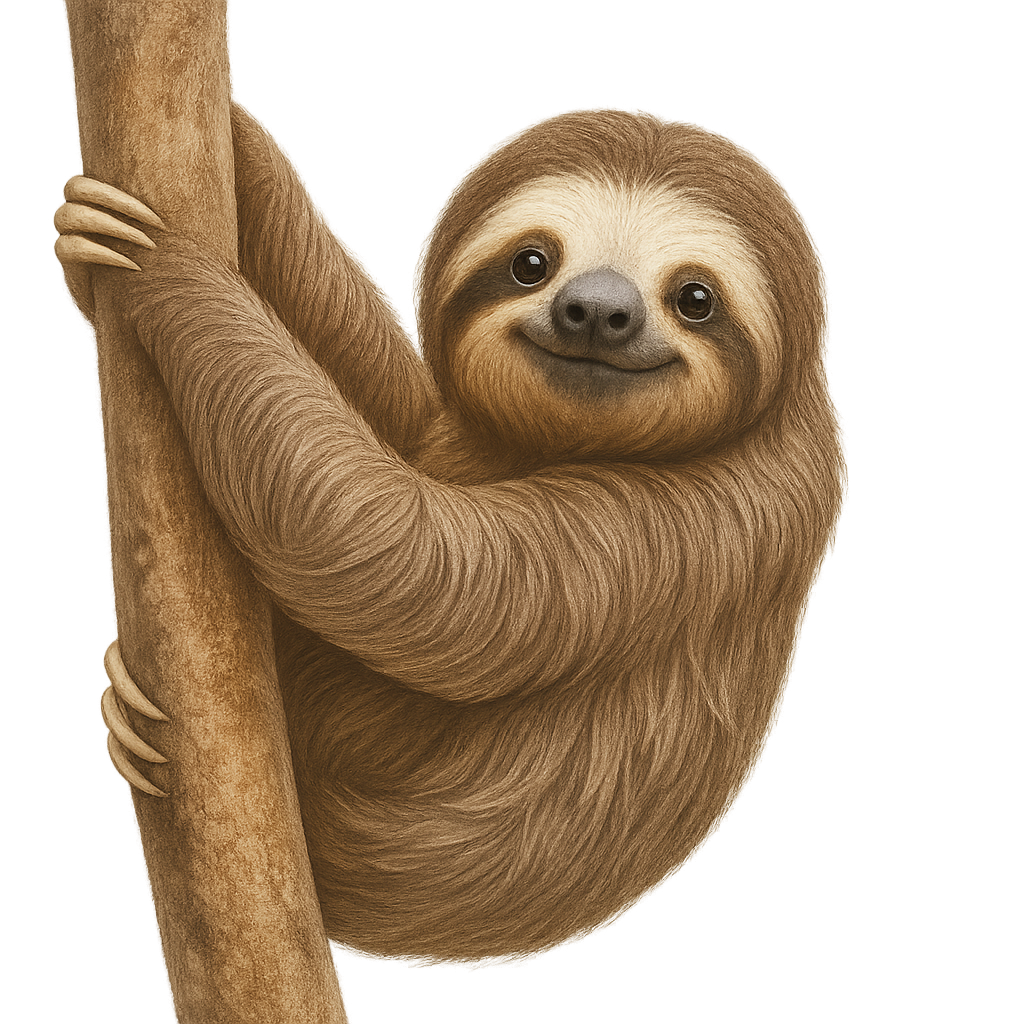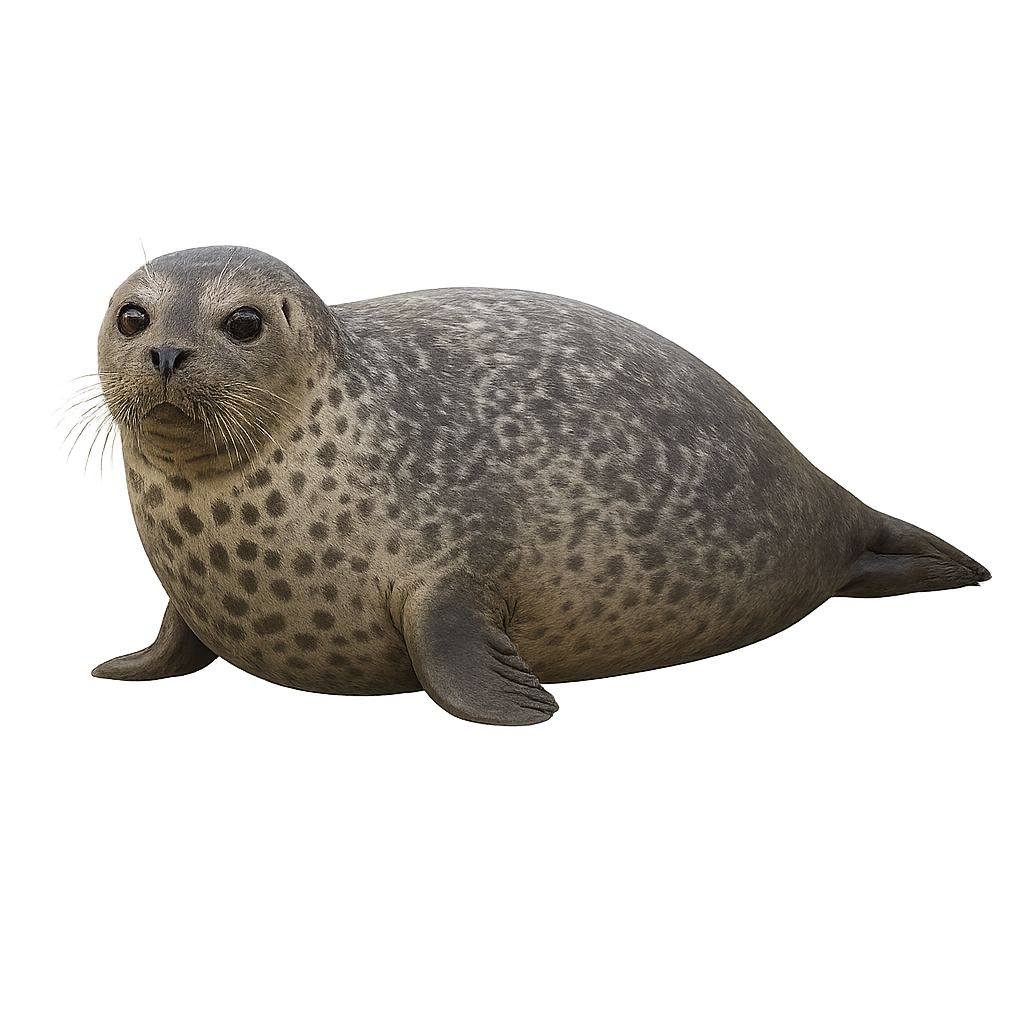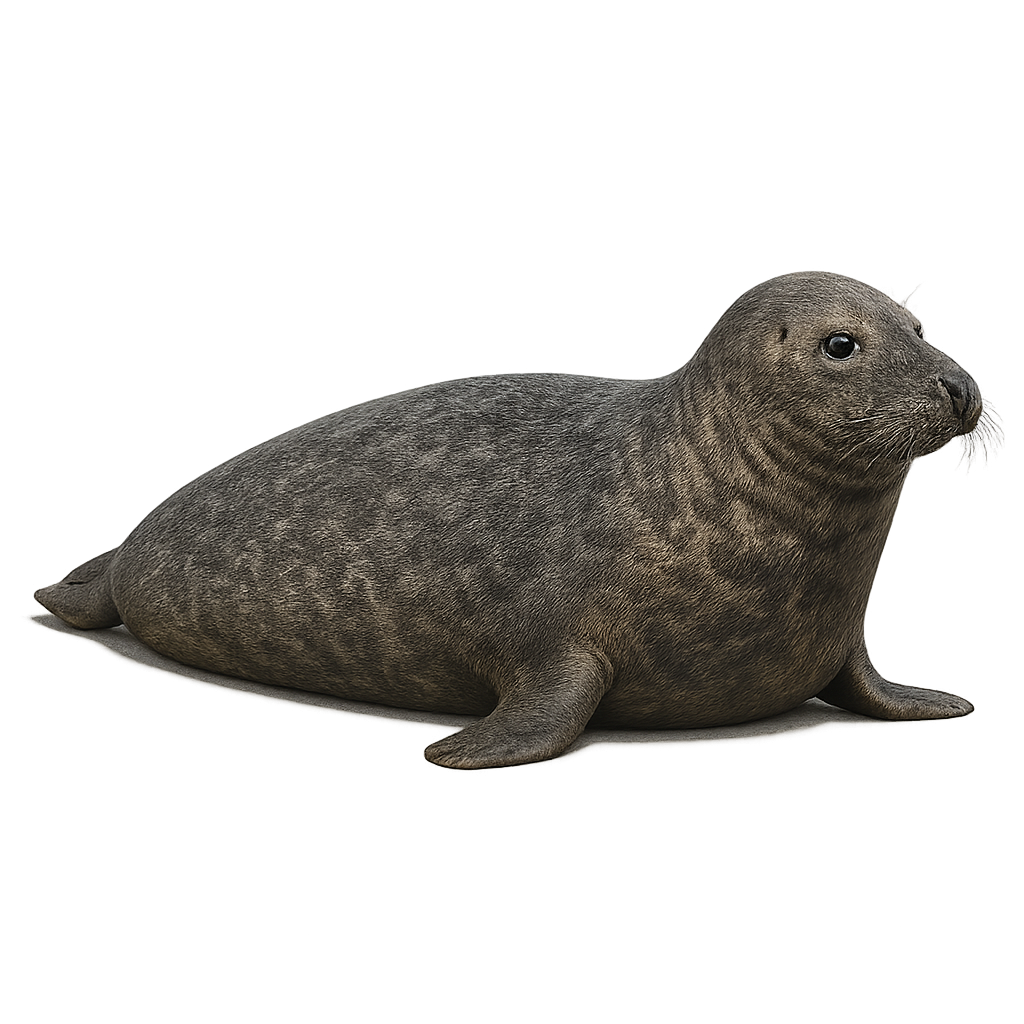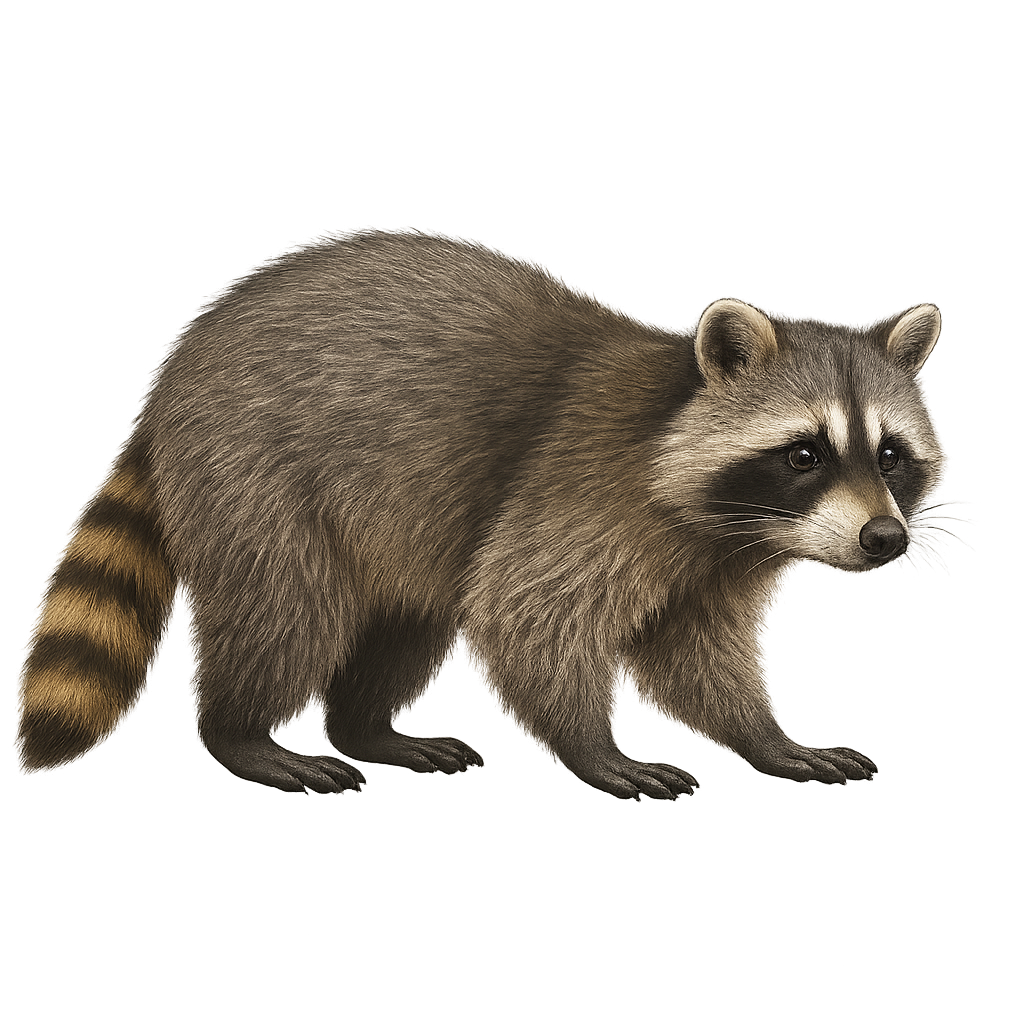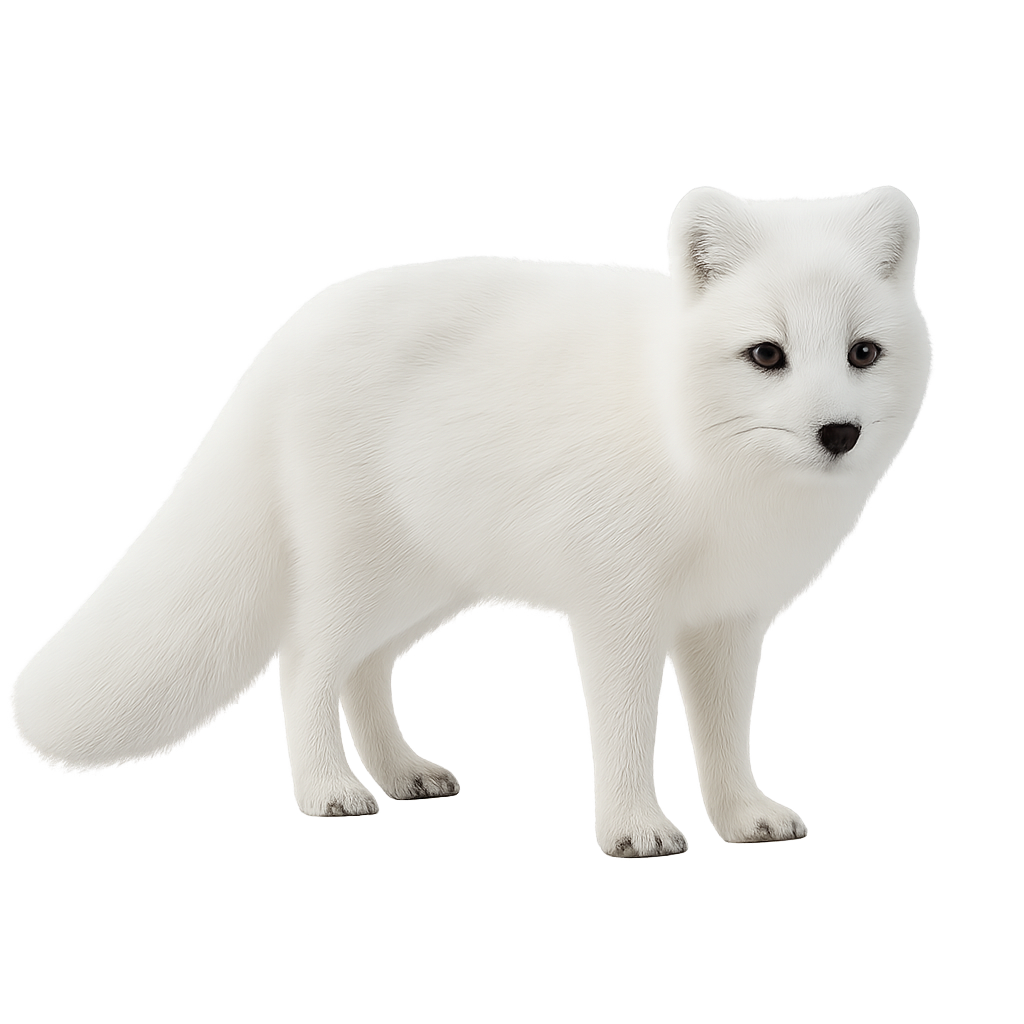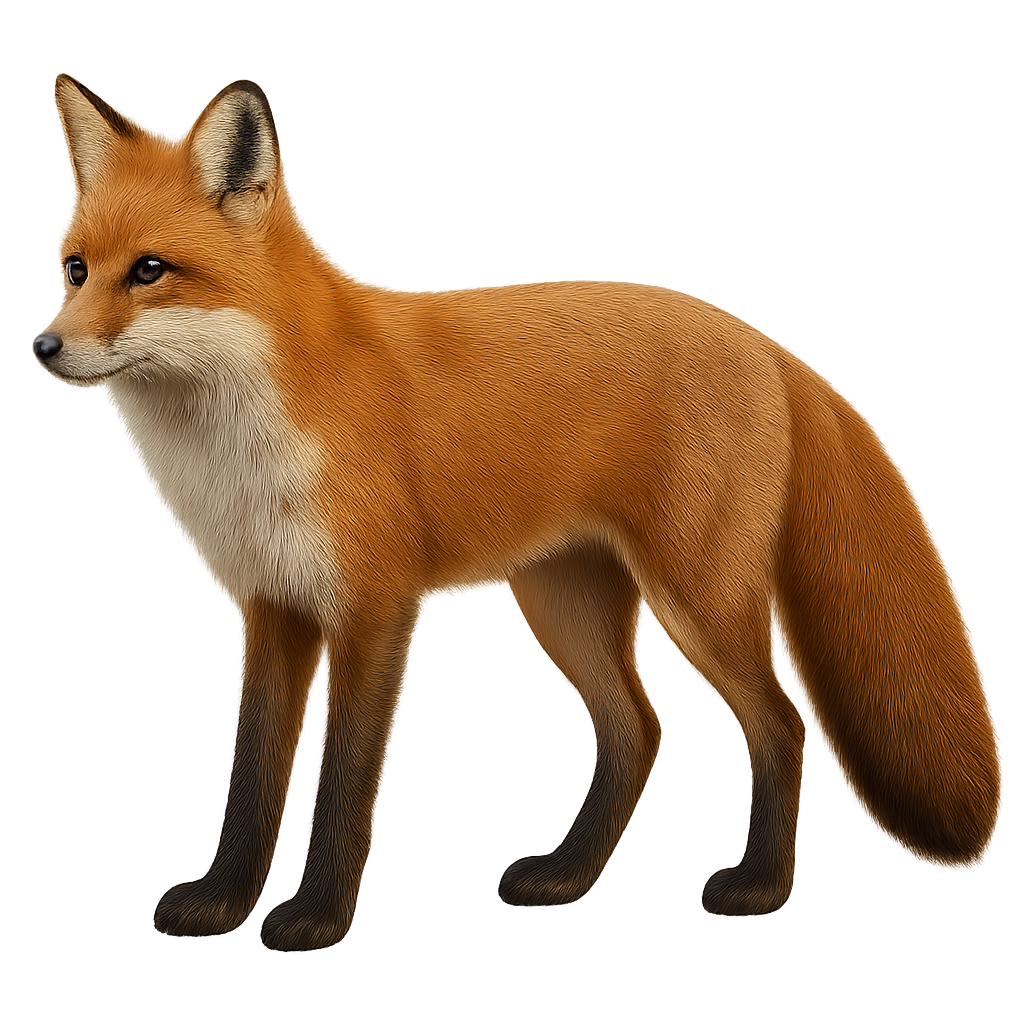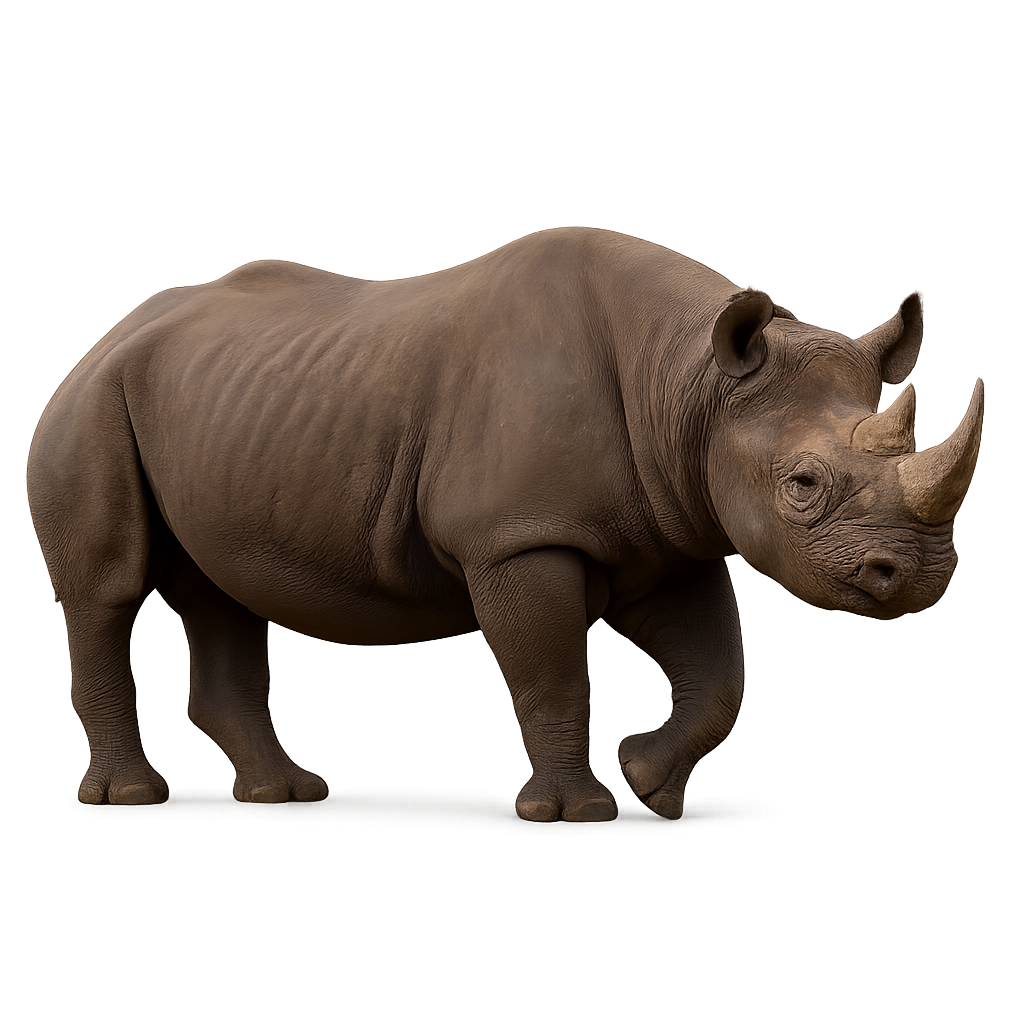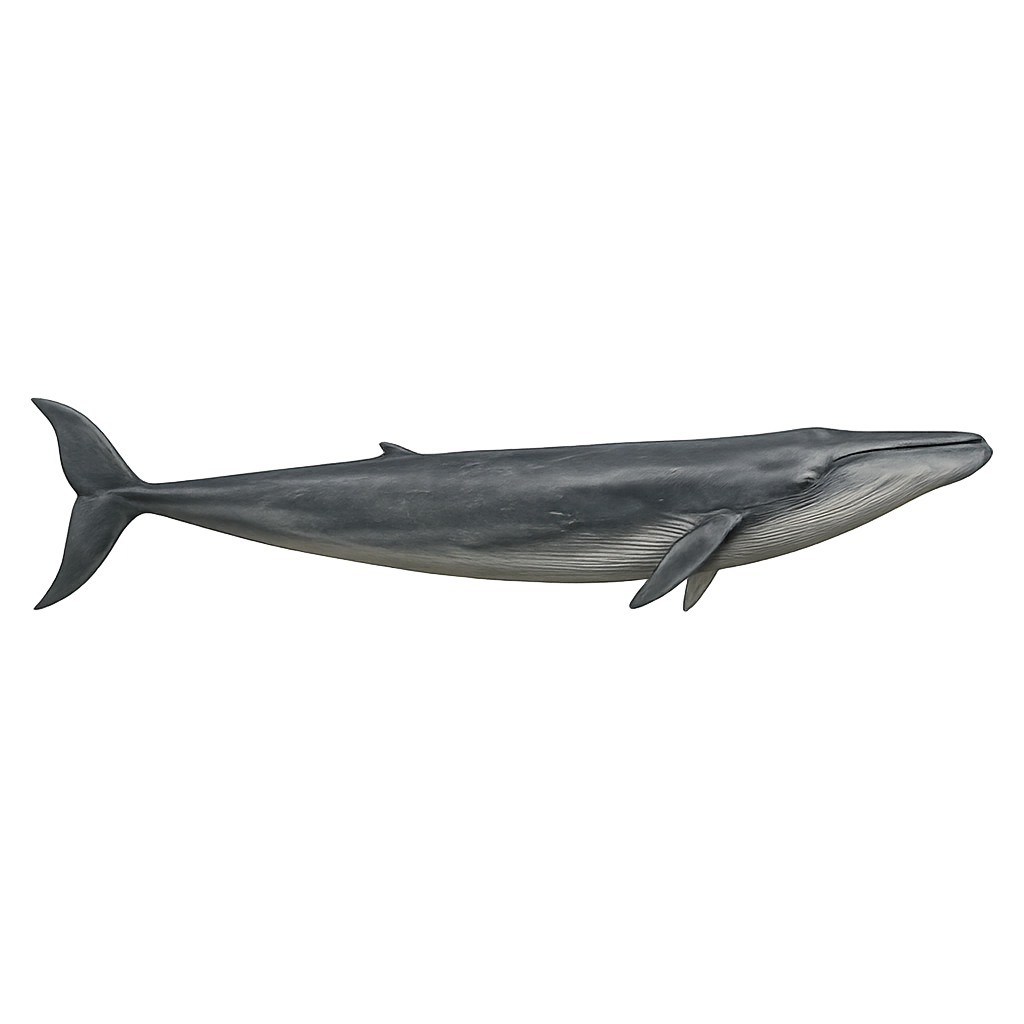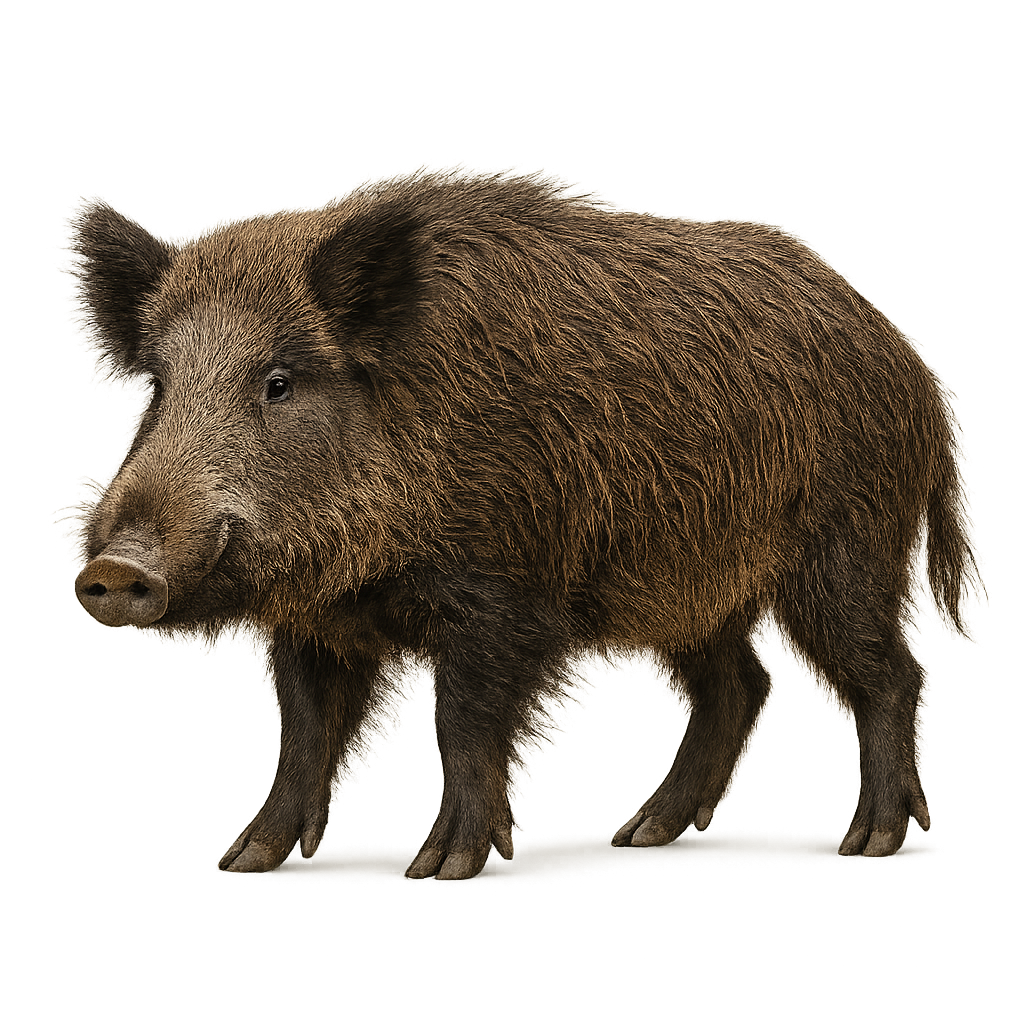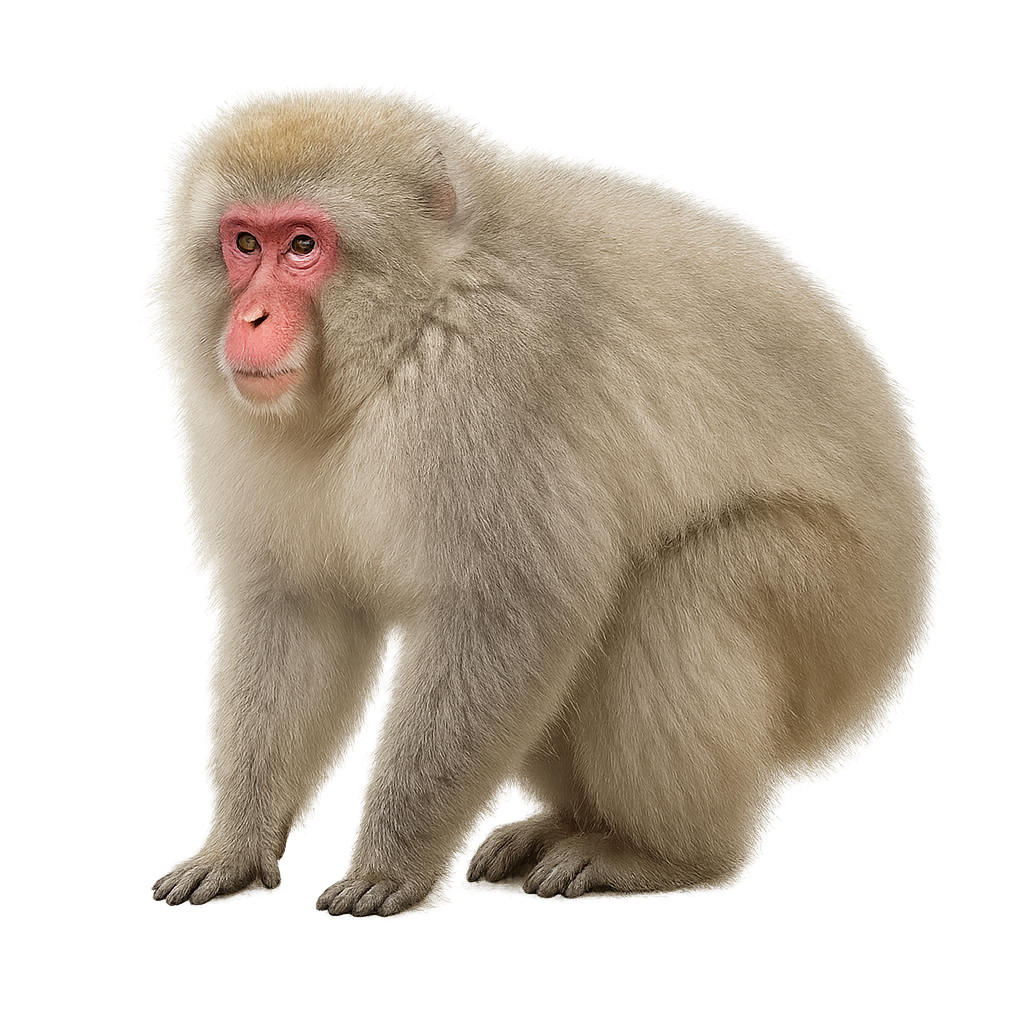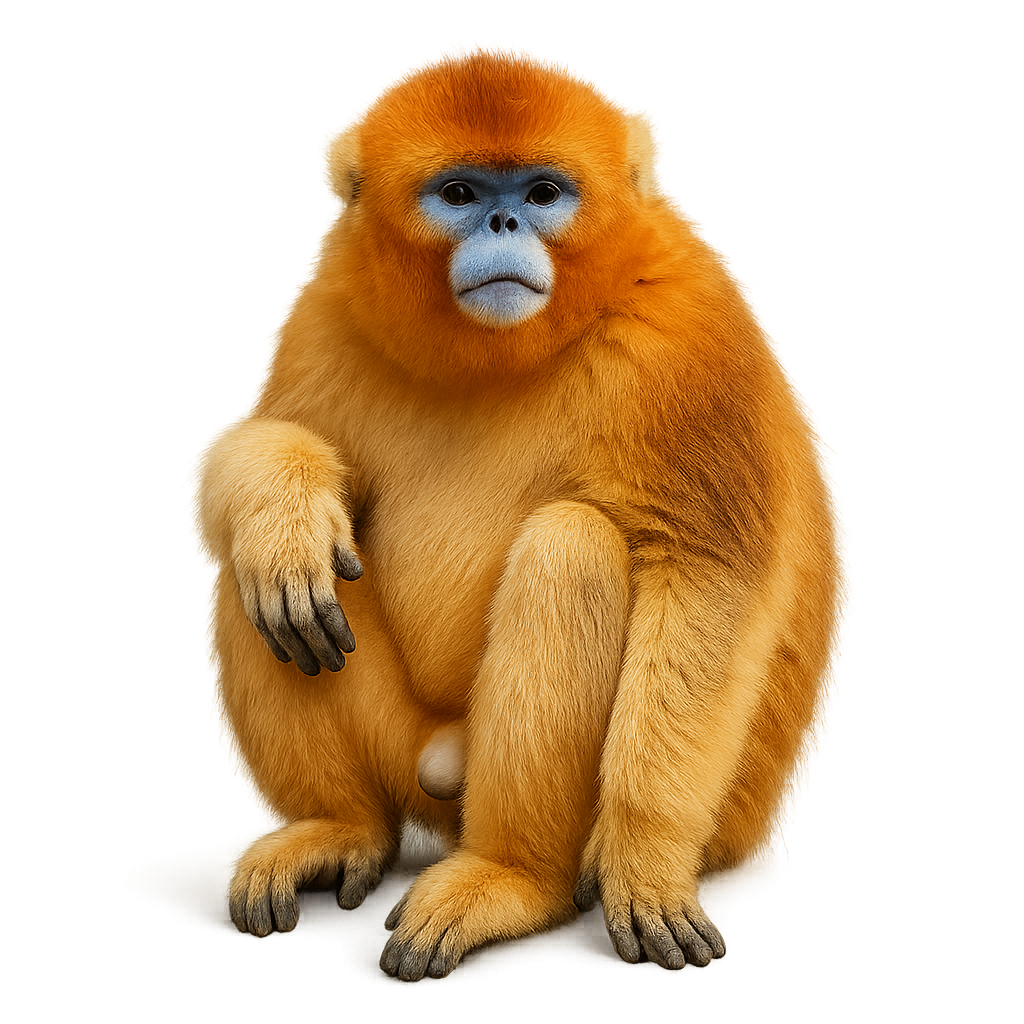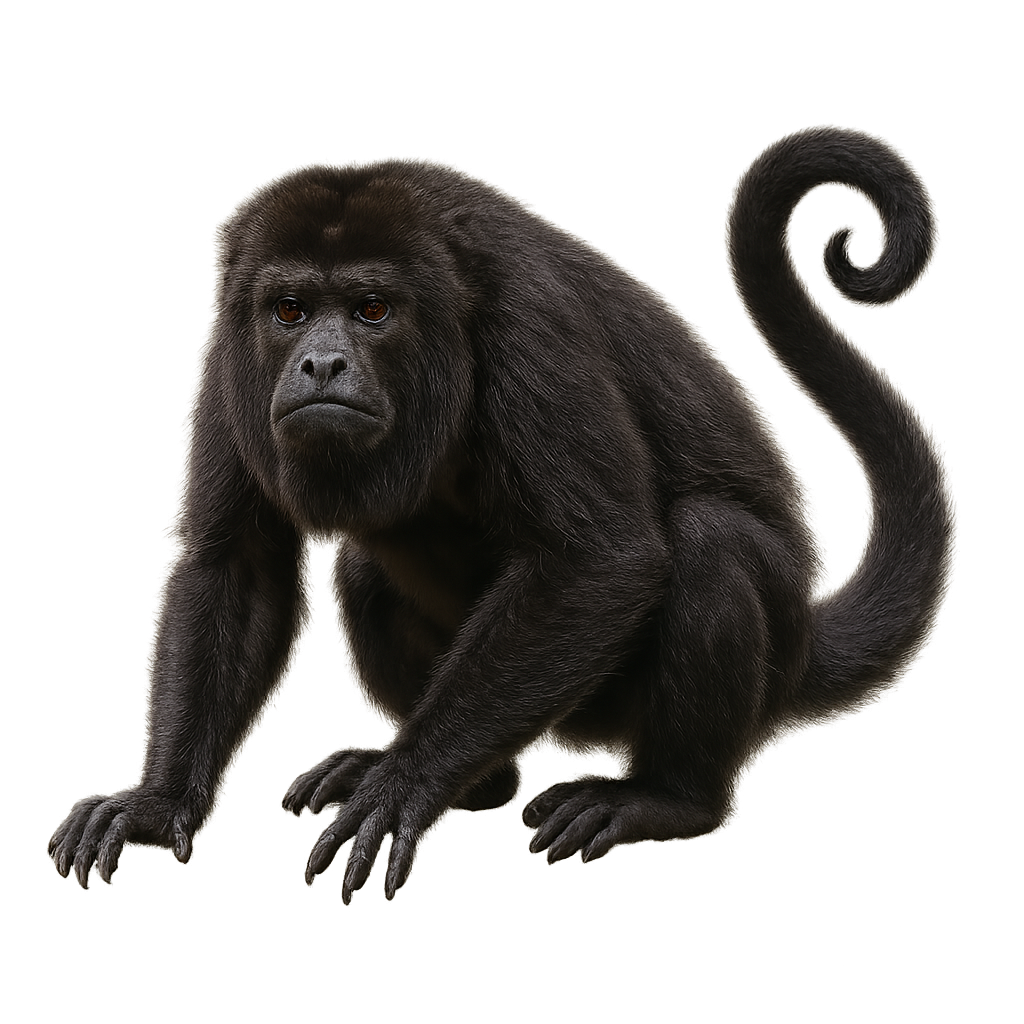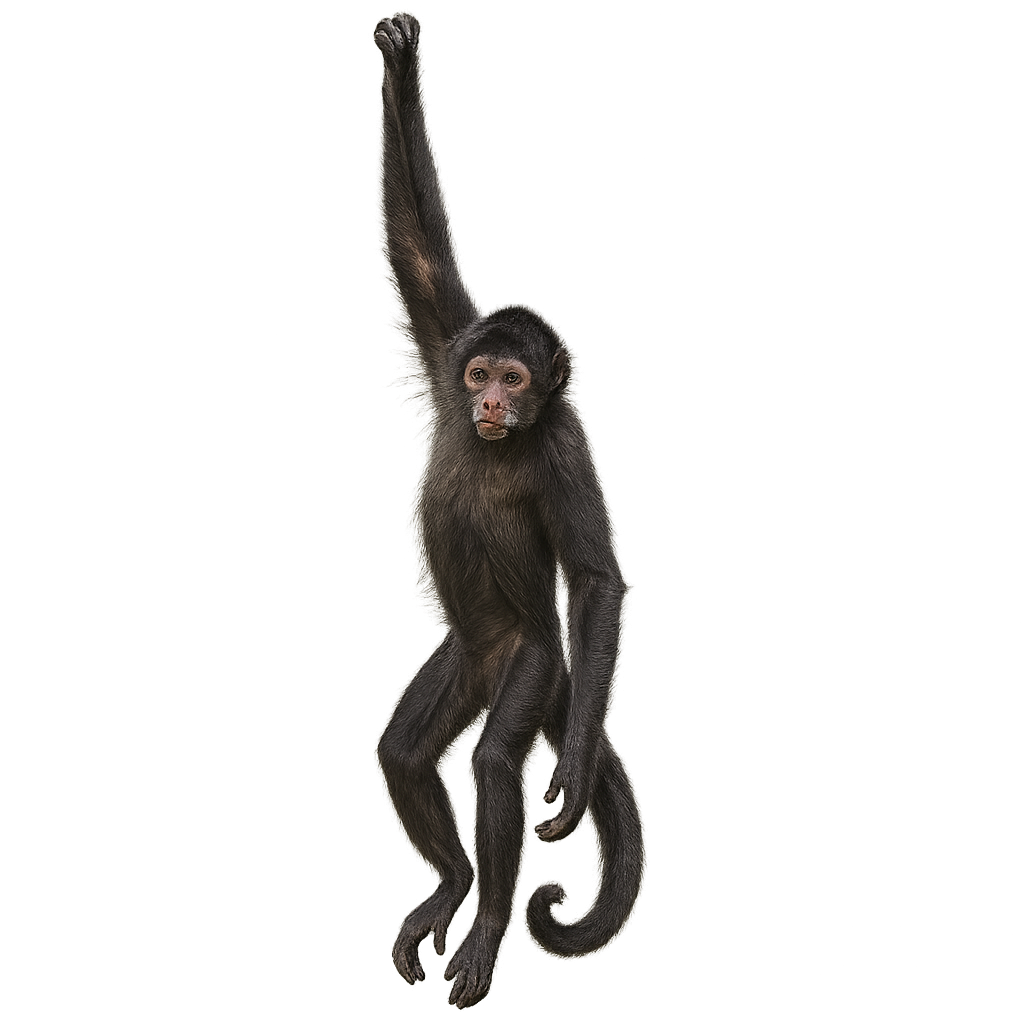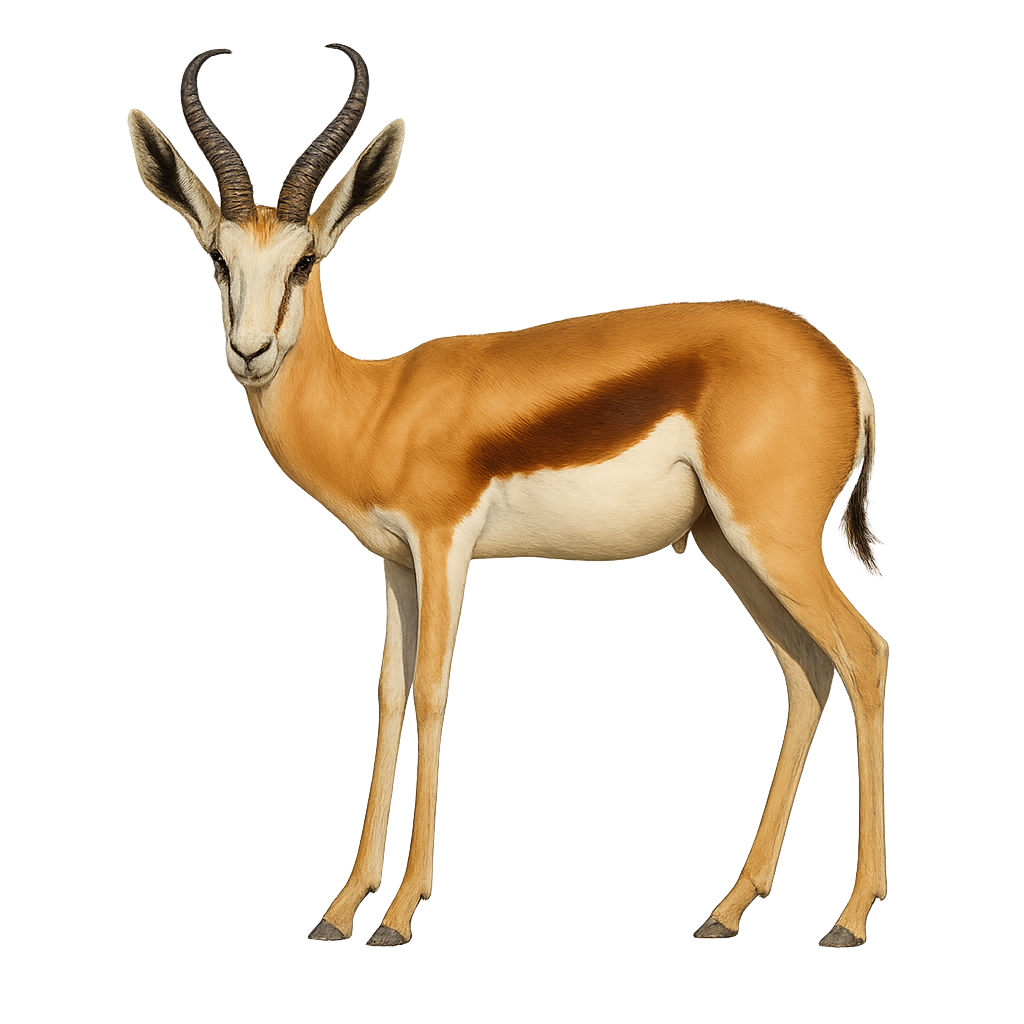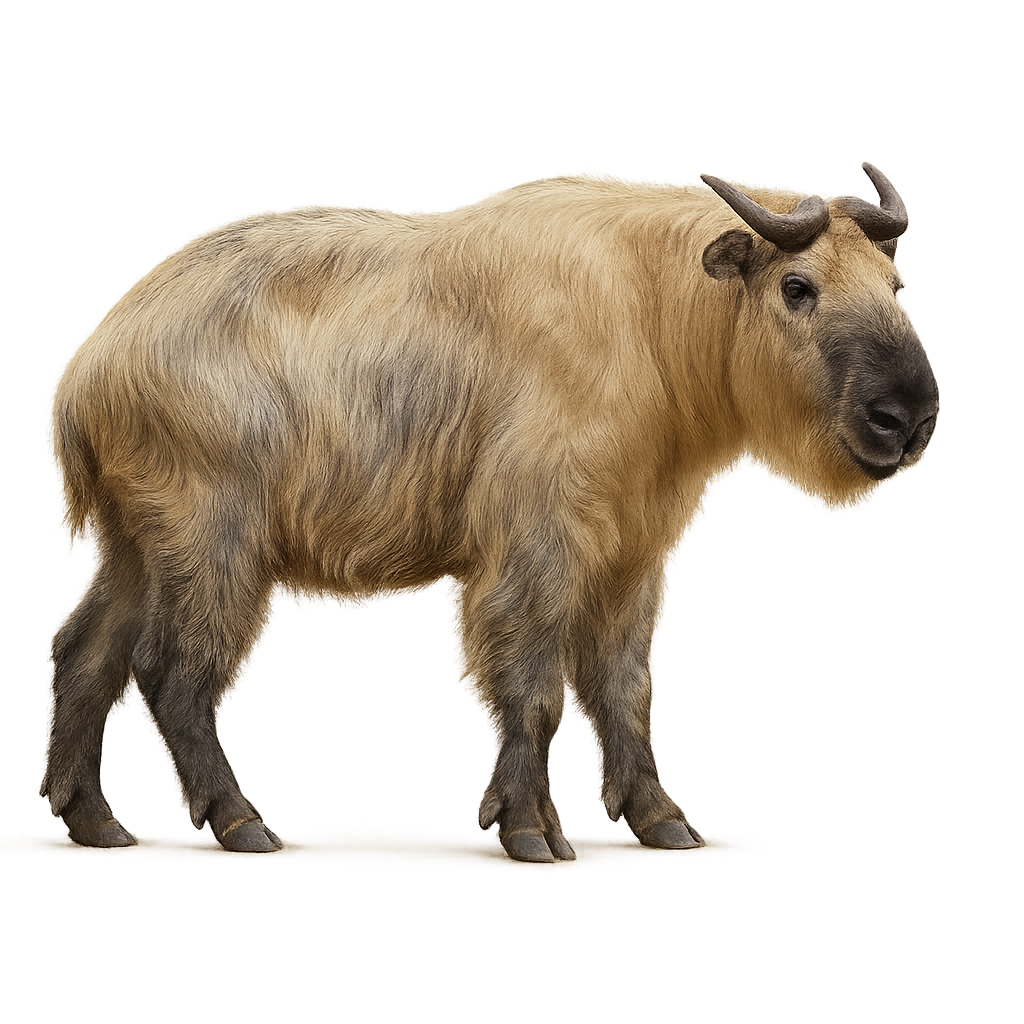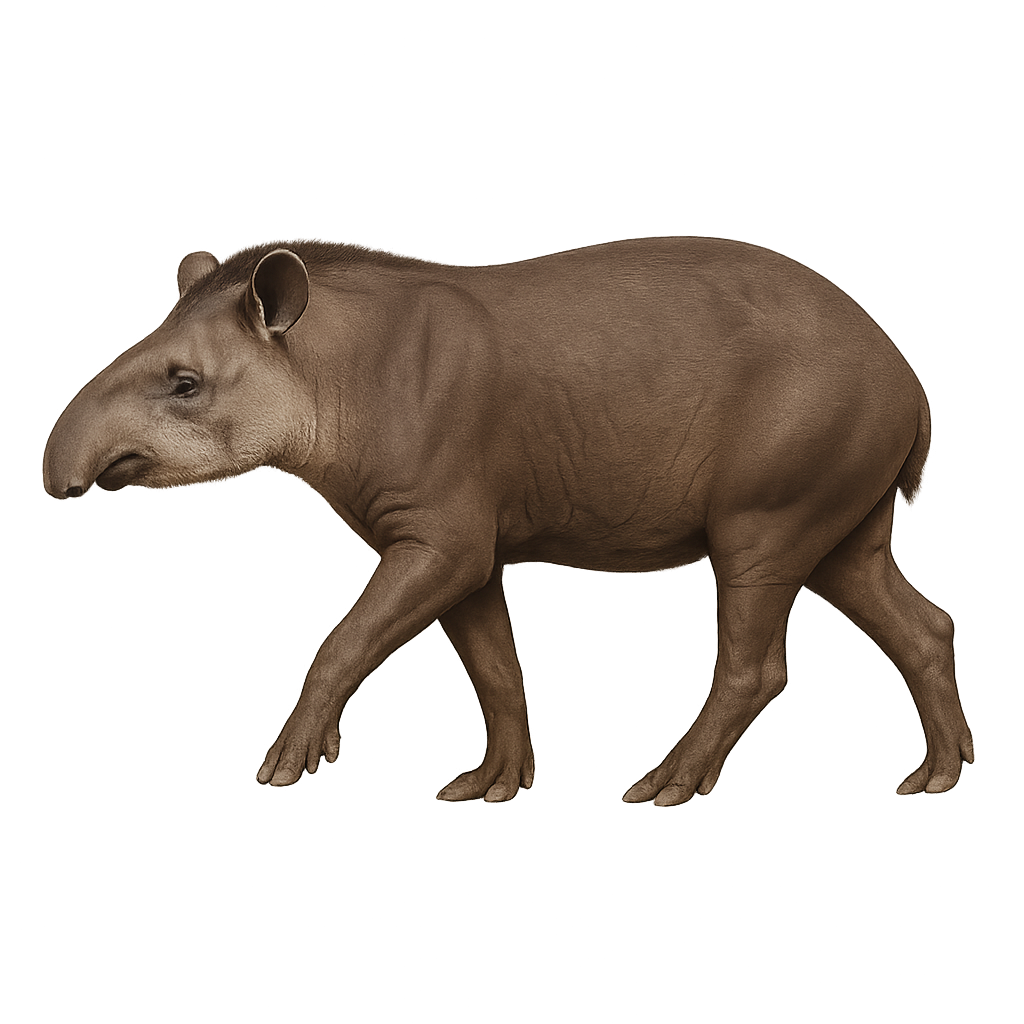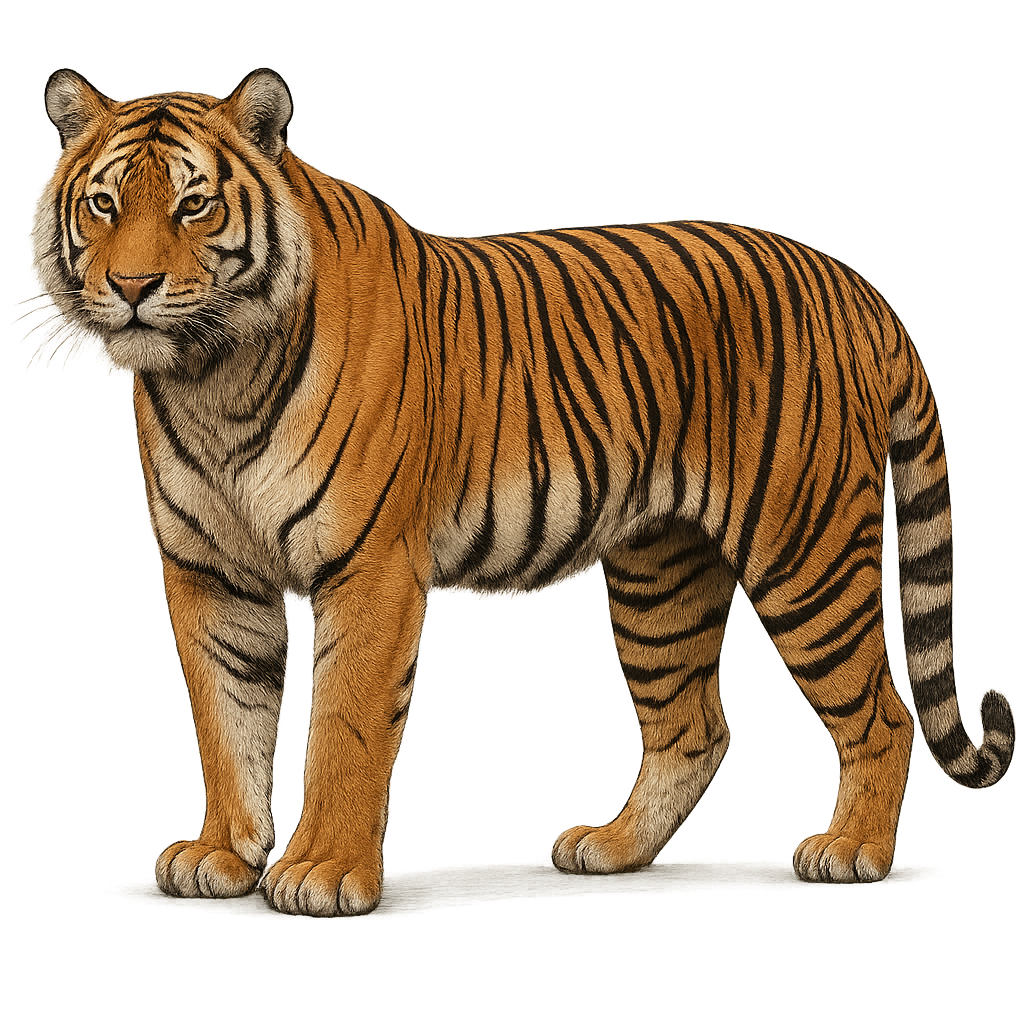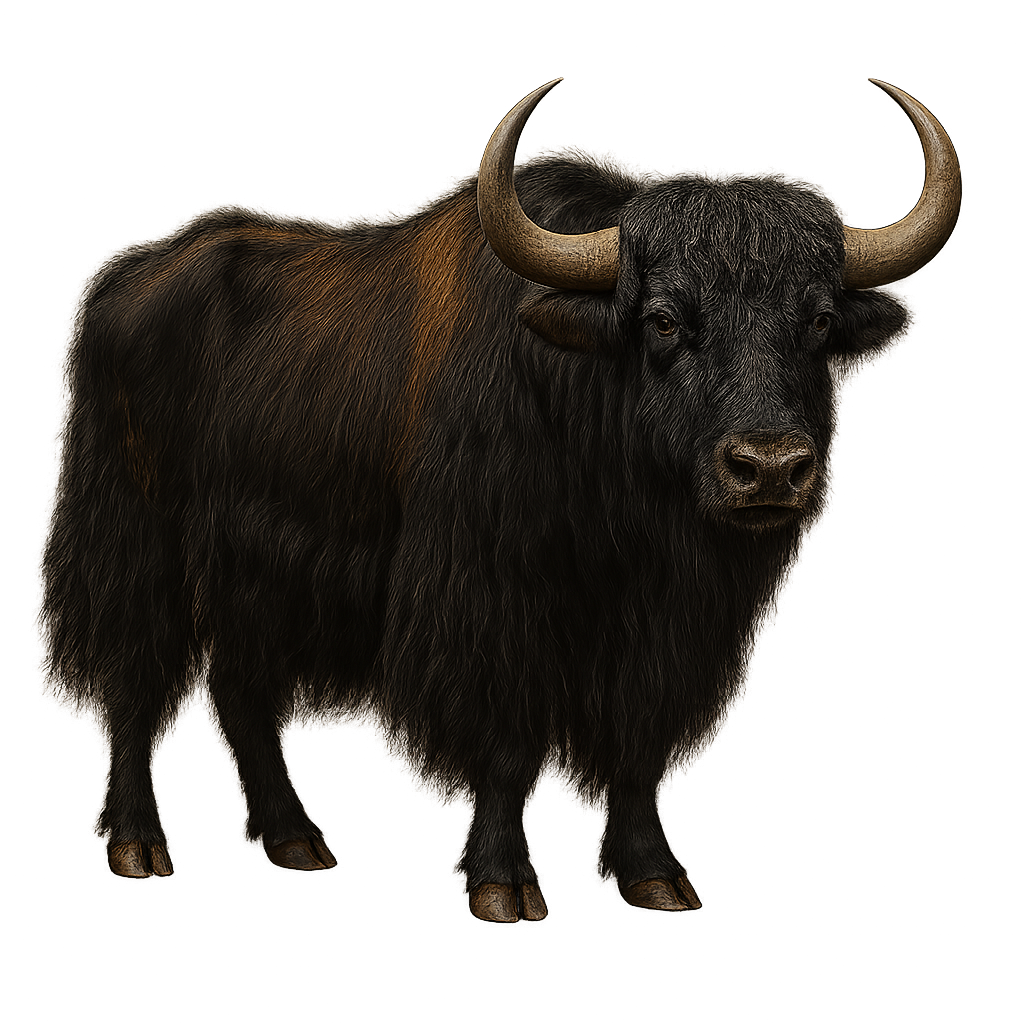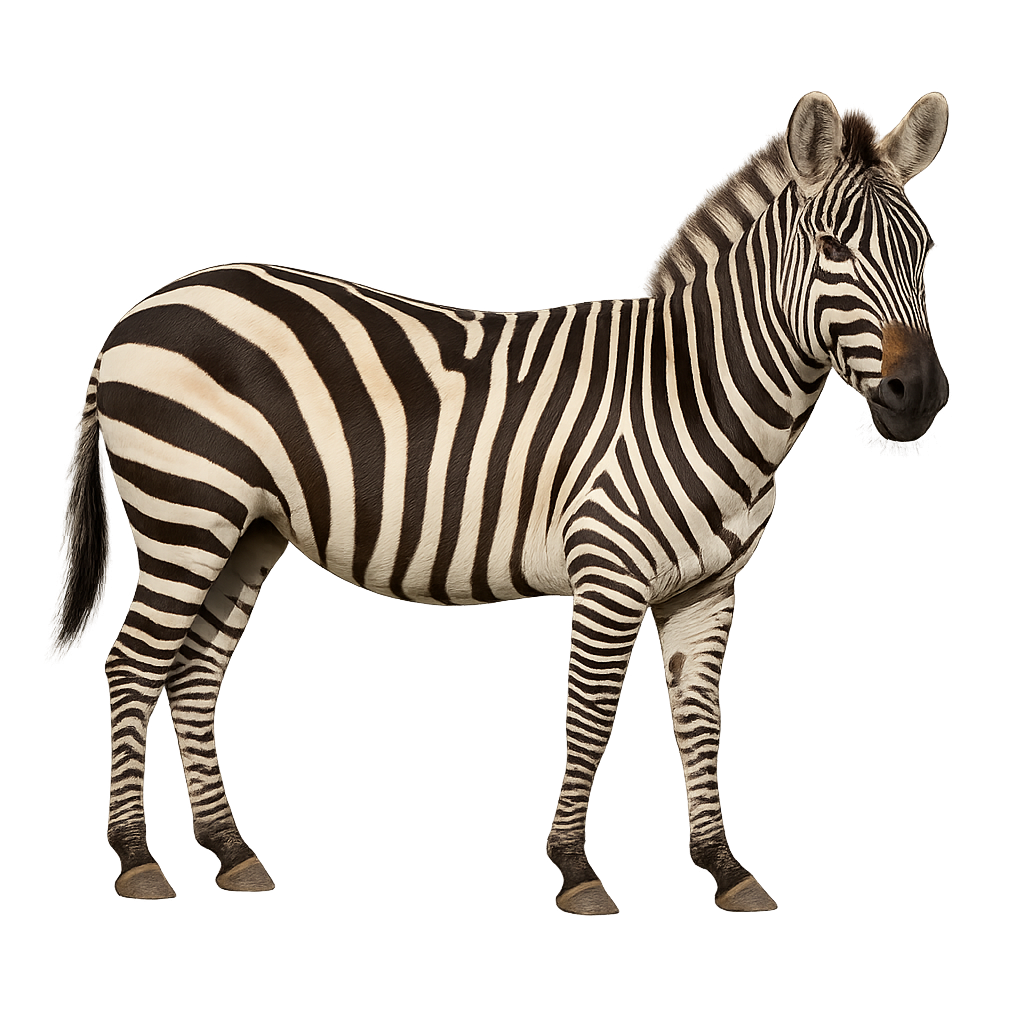The Argali is the largest wild sheep in the world, known for its imposing size and majestic spiral horns. It primarily inhabits the mountains of Central Asia, where it frequents the arid and semi-arid regions of steppes and high plateaus. This large ungulate is perfectly adapted to mountainous environments, moving nimbly on steep terrain at high altitudes. The Argali is a herbivore, feeding on grasses and woody plants.
The Argali is also a symbol of strength and resilience, but it is threatened by habitat loss and overhunting. Conservation efforts are underway to protect this iconic species and preserve its natural habitat.
Aye-aye
Daubentonia madagascariensis
The Aye-aye is a nocturnal lemur endemic to Madagascar, known for its strange appearance, notably its extremely long and thin middle finger which it uses to extract insects and larvae from tree trunks. It is a shy and secretive animal, primarily living in the tropical forests of the island. Due to its unique feeding method, it is sometimes viewed as an omen of misfortune by local populations, though its ecological role in maintaining forest balance is crucial. The Aye-aye is listed as vulnerable due to deforestation and cultural beliefs surrounding it.
Blainville's beaked whale is a little-known species of beaked whale, primarily inhabiting the deep waters of the Atlantic and Pacific Oceans. It is easily recognized by its long, narrow rostrum. This species is difficult to observe due to its deep-ocean habitat and migratory habits. The Blainville's beaked whale is still poorly studied but is threatened by pollution, ship collisions, and underwater noise.
Cuvier's beaked whale, also known as the Cuvier's whale, is a deep-diving cetacean found primarily in tropical and temperate oceans worldwide. It is easily recognized by its elongated head and prominent beak. This cetacean is one of the deepest diving whales, capable of descending more than 2000 meters in search of food. Its diet primarily consists of squid and deep-sea fish. Although it is a difficult animal to observe due to its deep habitat, it is sometimes seen at the surface to breathe. Cuvier's beaked whale is known for its long dives and mysterious behaviors.
The Humpback Whale is one of the most iconic whale species, known for its spectacular jumps and fascinating songs. This massive whale can grow up to 16 meters long and weigh up to 36 tons. It is found in oceans worldwide, migrating between the cold waters of the Arctic and the warmer tropical waters to breed. Humpback whales primarily feed on krill and small fish, which they capture using a group hunting technique known as "bubble netting," where they create bubbles underwater to trap their prey.
In addition to their impressive hunting behaviors, Humpback Whales are also famous for their complex songs, which males use to attract females during the breeding season.
The Blue Whale is the largest animal ever known to have existed on Earth. This impressive cetacean can grow up to 30 meters long and weigh as much as 180 tons. Its gray-blue skin and streamlined body are perfectly adapted to ocean life, and despite its enormous size, the Blue Whale primarily feeds on small marine organisms such as krill, which it consumes in large quantities. Using its massive tongue and enormous mouth, it can swallow up to 4 tons of krill in a single gulp.
Unfortunately, although once abundant, the Blue Whale is now classified as an endangered species due to commercial whaling, which has significantly reduced its population. Conservation efforts are now in place to protect this majestic creature.
The Greenland whale is one of the largest baleen whales, with a size that can reach 16 to 18 meters. It lives in the icy waters of the Arctic and primarily feeds on krill and small fish, filtering them through its baleen plates. It is a long-lived animal, with a lifespan that can exceed 200 years. While protected, it is threatened by climate change, pollution, and ship collisions.
The North Atlantic right whale is a large baleen whale, recognized for its imposing size and rough black skin. This cetacean, once hunted for its oil, is now protected and classified as critically endangered. It primarily lives in the coastal waters of the North Atlantic, from New England to Eastern Canada. Feeding on plankton and krill, it uses its baleen plates to filter food. Due to pollution, underwater noise, and ship collisions, the species remains severely threatened.
The European Weasel is the smallest carnivore in Europe, easily recognizable by its tiny size and brown coat with a white throat and belly. It primarily inhabits a variety of environments such as forests, meadows, and agricultural areas, where it hunts small mammals, birds, insects, and eggs. Agile and fast, the European Weasel is a stealthy hunter, capable of slipping into tight spaces to capture its prey.
Solitary and territorial, the European Weasel is active both day and night, and it uses its own burrows or those of other animals to hide and rest. Though small, it is a formidable predator, often seen as beneficial for regulating small rodent populations. However, it can be threatened by habitat destruction and changes in agricultural practices.
The Beluga is a remarkable cetacean, easily recognizable by its immaculate white color and streamlined shape. Unlike many other dolphins, the Beluga has a rounded forehead, called a "melon," which allows it great head flexibility. What also makes the Beluga unique is its ability to produce a wide variety of sounds, which it uses to communicate and navigate in the cold waters of the Arctic seas, the North Atlantic, and rivers. It primarily feeds on fish, crustaceans, and mollusks, hunting them with its excellent echolocation ability.
Belugas live in social groups called "pods" and are known for their social behavior and interaction with humans. Despite its popularity, the Beluga is vulnerable to water pollution and climate change, which affect its natural habitats.
The binturong is an arboreal mammal with a stocky body and long prehensile tail. Its shaggy black fur and unique scent reminiscent of popcorn make it easily identifiable. Active at night, it moves slowly through the canopy of Southeast Asian rainforests in search of fruits, small animals, and eggs. Solitary and elusive, it is increasingly rare due to habitat loss.
The American Bison is one of the largest land mammals in North America, recognizable by its massive head, thick fur, particularly on its back. Once widespread, it nearly went extinct in the 19th century due to overhunting and habitat loss. Today, thanks to conservation efforts, the population of American Bison is growing, though the species remains protected in many areas.
The American Bison lives in herds, primarily in grasslands and plains. Herbivorous, it feeds on grasses, woody plants, and some vegetation. As it moves, it creates powerful tracks in the plains. This social mammal is also known for its territorial behavior, with males fighting for dominance within the group.
The European Bison is the largest land mammal in Europe, characterized by its imposing size, thick fur, and arched back. Once widespread across the forests of Europe, it nearly went extinct in the early 20th century, but thanks to conservation programs, wild populations have been reintroduced in several European regions. The European Bison primarily inhabits forests and wooded meadows, where it feeds on grasses, leaves, twigs, and young tree shoots.
This bison is a social animal, living in small groups or large herds, with males fighting for dominance. While its population is growing, the European Bison remains a vulnerable species due to habitat loss and fragmentation of its territory. The protection and management of its habitats remain essential for its survival.
The American Badger is a medium-sized carnivore, easily recognizable by the distinctive white stripes on its head and its sturdy, stocky body. It primarily inhabits prairies and semi-arid areas in North America, where it digs complex burrows for shelter and raising its young. The American Badger is mainly insectivorous, feeding on worms, insects, and occasionally small mammals and reptiles. Its powerful claws allow it to dig quickly and efficiently into the ground.
The American Badger is a solitary animal, often active at dusk and during the night. While not immediately endangered, it can be affected by habitat loss and illegal hunting in some regions.
The European Badger is a medium-sized carnivorous mammal, easily recognizable by its gray fur, white stripes on its head, and stocky build. It primarily inhabits forests and hedgerows in Europe, where it digs complex burrows called "setts" for shelter and raising its young. The European Badger is omnivorous, feeding mainly on worms, insects, fruits, roots, and small mammals. Its nocturnal habits and solitary nature make it a difficult animal to observe.
It is an excellent digger and uses its powerful claws to modify its environment in search of food or to expand its burrow. While its population is generally stable, the European Badger faces threats such as habitat loss and road accidents. Protecting its habitats and managing its territories are crucial for the species' conservation.
The Musk Ox is a large herbivorous mammal, easily recognized by its thick brown fur that protects it from the freezing temperatures of the Arctic. This robust animal, with curved horns and a massive build, primarily inhabits the cold regions of Canada, Greenland, Alaska, and Norway. The Musk Ox feeds on woody plants, lichens, and mosses, which it finds in Arctic and sub-Arctic zones. It forms social groups to protect itself from predators and extreme weather conditions.
Adapted to harsh environments, the Musk Ox is an extremely resilient animal, capable of surviving extremely low temperatures due to its dense coat. However, it remains vulnerable to climate change, habitat loss, and human disturbances, which threaten its population.
Bongo
Cephalophus eurycerus
The Bongo is a large forest antelope native to Central Africa, recognized for its beautiful white stripes and bright orange coat. It primarily lives in dense forests, where it feeds on leaves, fruits, and bark. This antelope is usually solitary or lives in small family groups. Due to habitat loss and hunting, the Bongo is classified as a vulnerable species. Its discretion and ability to blend into its environment make it a difficult animal to spot.
The Siberian Ibex, also known as the Asiatic Ibex, is a majestic wild goat species that lives in the rocky mountains of Central Asia, particularly in Russia, Kazakhstan, China, and Mongolia. This imposing animal, with long, curved horns and a dense coat that protects it from harsh winters, typically inhabits the steep slopes of high-altitude mountains.
Herbivorous, the Siberian Ibex primarily feeds on alpine vegetation, grasses, and woody plants. It is particularly agile, capable of moving across rugged terrain and leaping between rocks with ease. While it was once heavily hunted for its valuable horns and meat, conservation efforts have helped stabilize its population, although the Siberian Ibex remains vulnerable due to habitat loss and poaching.
The Alpine Ibex is a large herbivorous mammal, easily recognized by its long, curved horns and light brown or grayish coat. It primarily inhabits the rugged mountains of the Alps, southern Europe, and some mountainous regions of the Middle East. The Alpine Ibex feeds on alpine vegetation, grasses, and woody plants, and it is particularly adapted to life at high altitudes due to its great agility on rocky terrain and its thick coat.
This animal is social and lives in family groups, although adult males, called "ibex", form separate groups. After nearly disappearing in the early 20th century due to overhunting, conservation programs have helped stabilize its population. However, it remains vulnerable to habitat loss and human disturbances.
The Iberian Ibex is a large herbivore native to the mountains of the Iberian Peninsula, primarily in the mountain ranges of the Pyrenees and the Sierra de Gredos in Spain. It is easily recognizable by its massive, backward-curved horns and brown and gray coat. This ibex lives in rocky, steep terrain, where it feeds mainly on grasses, woody plants, and alpine vegetation.
The Iberian Ibex is a social animal that forms family groups consisting of females and young, while adult males, called "ibex," form separate groups. The species nearly went extinct in the 20th century due to overhunting, but thanks to conservation efforts, its population has been restored in several regions of Spain. However, the Iberian Ibex remains vulnerable to habitat loss and human disturbances.
The Hartebeest is a medium-sized antelope, easily recognized by its slender body, long legs, and slightly curved horns. It primarily inhabits the savannas and open plains of North and West Africa, where it forms large herds. The Hartebeest feeds mainly on grasses and low vegetation, and it is particularly well adapted to life in arid and semi-arid environments.
This species is mainly active at dawn and dusk, avoiding the intense heat of the day. The Hartebeest is threatened by habitat loss due to agriculture and hunting, and although conservation efforts have been made, its population remains vulnerable. It is listed as "Near Threatened" on the IUCN Red List.
The African Buffalo is one of the largest and most powerful herbivorous mammals on the African continent, easily recognizable by its massive body, impressive horns, and dark coat. It primarily inhabits the savannas, grasslands, and open forests of sub-Saharan Africa. This social animal moves in large herds, sometimes composed of hundreds of individuals, which offer protection from predators through the collective strength of the group.
The African Buffalo is a strict herbivore, feeding mainly on grasses and woody vegetation. Although it has a rather calm temperament, it can become extremely aggressive when threatened, and its physical strength makes it a formidable opponent for predators. Despite being a secondary predator, it is vulnerable due to hunting and habitat loss, although conservation efforts have helped stabilize some populations.
The Sperm Whale is the largest of the toothed cetaceans and the largest living marine predator today. It is easily recognizable by its massive head, which makes up about one-third of its total body length, and its streamlined body. This cetacean, which can reach up to 20 meters in length and weigh several dozen tons, is a deep-sea creature, primarily feeding on squid, including giant squids, which it hunts at extreme depths.
The Sperm Whale is known for its long migrations, traveling thousands of kilometers between breeding grounds in the tropics and feeding areas in colder waters. Although it was intensively hunted for its oil and blubber in past centuries, it remains a protected species. The Sperm Whale also plays a crucial role in the marine ecosystem by regulating prey populations and maintaining the balance of food chains.
The White-faced Capuchin is a small, intelligent, and social monkey, easily recognizable by its pale face, framed by darker fur, and its agile, slender body. This primate lives in the tropical forests of Central and South America, primarily inhabiting the canopy, where it feeds on fruits, seeds, insects, and occasionally small vertebrates.
White-faced Capuchins are highly social animals, living in family groups or bands of up to twenty individuals. They are known for their great learning ability and curious behavior, often used in behavioral studies due to their intelligence and problem-solving skills. Unfortunately, like many other primate species, they are threatened by deforestation and habitat loss.
The Capybara is the largest rodent in the world, easily recognizable by its massive body and short, light brown fur. This semi-aquatic mammal primarily inhabits wetland areas of South America, near rivers, lakes, and swamps. The Capybara is an excellent swimmer and spends much of its time in the water, where it feeds mainly on aquatic grasses, plants, and fallen fruits.
Naturally social, the Capybara lives in large groups of 10 to 20 individuals, often organized around a social hierarchy. The groups spend a lot of time grooming each other and protecting each other from predators. Although it is a calm and docile animal, the Capybara is threatened by the loss of its natural habitat due to urbanization and pollution of rivers. However, its population remains relatively stable, and it is often seen in protected areas.
The Caracal is an elegant feline, easily recognizable by its pointed ears adorned with tufts of black fur. It has a short tawny coat that allows it to blend into the dry, rocky environments where it lives, primarily in savannas, steppes, and semi-desert areas in Africa and Western Asia. This agile and fast predator primarily hunts birds, small mammals, and reptiles, often catching prey by leaping great heights to snatch them in mid-air.
The Caracal is a solitary and territorial hunter. It uses its long back legs to make impressive jumps, capable of reaching up to three meters high. While the species is relatively widespread, it faces threats due to habitat loss and poaching. The Caracal is protected in several regions, and its population is monitored.
The Caribou, or Reindeer in Europe, is a large cervid adapted to cold and northern environments. It is easily recognizable by its distinctive antlers, which are present in both males and females, a unique trait among cervids. Its thick, woolly coat, typically brown with lighter shades on the belly and neck, allows it to survive in the harshest climates. Caribou populations are found primarily in arctic and subarctic regions, including Iceland, where they were introduced and have thrived in the mountainous and tundra landscapes.
The Caribou is a migratory species, undertaking long seasonal migrations to find food resources. It primarily feeds on lichens, grasses, and tundra plants, which it digs out from under the snow during the winter. The Caribou plays a crucial role in its ecosystem by affecting vegetation and serving as prey for large carnivores such as wolves. However, it is threatened by climate change and habitat loss.
The American Beaver is a large, semi-aquatic rodent famous for its construction skills and its ability to modify its environment. It is easily recognizable by its wide head, large orange incisors, and its flat, scaly tail. The American Beaver primarily lives in rivers, lakes, and wetlands, where it builds dams and lodges using branches, tree trunks, and mud to create safe, stable habitats.
This rodent is an excellent swimmer and spends much of its life in the water, where it feeds mainly on bark, roots, and young tree shoots. The American Beaver plays a crucial role in its ecosystem by altering waterways, creating ponds and wetlands that are beneficial to many other species. However, it is sometimes threatened by habitat loss due to urbanization and water management.
The European Beaver is a large, semi-aquatic rodent renowned for its exceptional ability to alter its environment. This rodent is easily identifiable by its brown fur, large orange incisors, and flat, scaly tail. It primarily inhabits rivers, lakes, and wetlands, where it builds dams to create ponds and wetlands that serve as refuges. The European Beaver is an excellent swimmer, capable of staying underwater for several minutes to move or escape danger.
It feeds mainly on bark, roots, and young tree shoots. In addition to its ability to modify waterways, the European Beaver plays a crucial role in the ecosystem by promoting the regeneration of wetland areas, which benefits many other animal species. Although its population was historically threatened by hunting and habitat loss, conservation efforts have stabilized its numbers, and the species is now protected in many regions.
The black-fronted duiker is a species of duiker, a small antelope found in the dense forests of West and Central Africa. It is easily recognizable by its distinctive black flanks and small size. This species is primarily herbivorous, feeding on fruits, leaves, and young shoots. While generally discreet and difficult to observe, it is threatened by deforestation and hunting. Its population is declining.
The Zebra du forest is a small antelope living in the dense forests of Central Africa. It is easily recognizable by its white and black stripes that cover its body, which help it camouflage in the underbrush. This discreet herbivore primarily feeds on leaves and fruits and remains mostly nocturnal or crepuscular. While it is a shy animal and difficult to spot, it is threatened by habitat loss and poaching.
The Diademed Monkey is a primate of the Cercopithecidae family, native to the tropical forests of Central Africa, primarily in the Democratic Republic of Congo, Uganda, and Kenya. This monkey is recognizable by the crest of hair on the top of its head, forming a 'diadem,' from which it gets its name. The Diademed Monkey is a social animal living in groups and feeds primarily on fruits, leaves, and insects. It is also known for its complex vocalizations and marked social behaviors, communicating with other group members to establish relationships and organize movements.
The axis deer is a cervid native to the Indian subcontinent, recognized for its characteristic spotted coat. It primarily inhabits forests and open grasslands, where it feeds on leaves, fruits, and grasses. This social animal forms herds and is often seen grazing or resting in wooded areas. Although not threatened, it faces dangers from habitat loss and illegal hunting.
The Kashmir Stag, also known as the Hangul, is a majestic species primarily found in the mountains of the Himalayas and Kashmir. This deer is easily recognizable by its dense, woolly coat, which helps it withstand the cold temperatures of high altitudes. It has impressive antlers, which can grow to a considerable size in adult males. The females, on the other hand, are generally smaller and do not have antlers.
This deer inhabits high-altitude forests, alpine meadows, and mountainous regions covered in snow. It feeds primarily on herbaceous vegetation, foliage, and young shoots. The Kashmir Stag is a relatively shy and discreet animal, often living in small groups or family units. While its population remains relatively stable, it faces threats such as habitat loss due to deforestation and poaching, especially for its antlers.
The Sika Deer is a medium-sized cervid, native to East Asia, that is distinguished by its spotted coat, especially visible in young individuals and females. Its coat ranges from light brown to reddish, often sprinkled with small white spots that help it blend into its forested environment. The Sika Deer has antlers that, although smaller than those of the Red Deer, are well-developed in adult males. It primarily inhabits deciduous and coniferous forests, as well as mountainous areas.
The Sika Deer is an herbivore, feeding mainly on herbaceous plants, young shoots, and leaves. It is a social animal, living in groups, especially during the breeding season. Outside of this period, Sika Deer may be more solitary or live in small family units. While its population remains stable in certain regions, the Sika Deer is sometimes considered an invasive species in other parts of the world, particularly in Europe, where it has been introduced and can compete with local species.
The Black-backed Jackal, also known as the silver-backed jackal, is a small canid native to Africa, particularly found in savannas and open grasslands. It is distinguished by its grayish coat with a black stripe running along its back, hence the name "black-backed". This coat helps it blend effectively into its environment. The Black-backed Jackal has a slender body and relatively long legs, allowing it to run at high speeds.
An opportunistic carnivore, it primarily feeds on small mammals, birds, insects, and carrion, but it can also eat fruits and plants. Although it is a solitary animal, the Black-backed Jackal can occasionally be seen in small groups, especially during the breeding season. While its status is not particularly threatened, it faces competition from other predators and the loss of its natural habitat.
The Striped Jackal is a small canid found primarily in Africa, inhabiting savannas, open forests, and mountainous regions. It is distinguished by the dark stripes along its flanks, which give it a unique appearance among other jackals. Its coat is typically brown-gray, with lighter markings on the belly and underside of the legs, helping it blend into its natural environment.
The Striped Jackal is an opportunistic carnivore, feeding on small mammals, insects, fruits, and sometimes carrion. While it is primarily solitary, it can occasionally be seen in small groups while foraging for food. A skilled hunter, it uses strategies to capture its prey. Like many canids, it faces threats such as habitat loss and competition with other predators, but its population remains relatively stable.
The Golden Jackal is a small canid found primarily in South Asia, the Middle East, and Southeastern Europe. It is easily recognizable by its golden fur, which ranges from pale yellow to golden brown, allowing it to blend into the landscapes of grasslands, open forests, and savannas. The Golden Jackal has a more slender body and relatively long legs compared to other jackals, enabling it to be an excellent runner.
Opportunistic by nature, the Golden Jackal feeds on a wide variety of prey, ranging from small mammals and birds to fruits and carrion. Although often solitary or in small family groups, the Golden Jackal can occasionally be seen in larger groups while foraging for food. It is also known for its varied vocalizations and skilled hunting behavior. While its population remains relatively stable, it faces threats such as habitat loss and human conflict.
The Alpine Chamois is an elegant and agile ungulate, well adapted to the mountainous environments of the Alps, Pyrenees, and other mountain regions of Europe. It is distinguished by its reddish-brown coat in the summer, which becomes more gray and thicker in the winter, helping it endure the cold temperatures. The Alpine Chamois has small, curved horns, present in both males and females, but larger in adult males.
This ruminant primarily inhabits rocky slopes, mountain forests, and alpine meadows, where it feeds mainly on herbaceous vegetation, mosses, and lichens. The Alpine Chamois is an excellent climber, able to move with agility over steep and rocky terrain. It is usually solitary or lives in small family groups, but may also gather in larger herds during the winter. Although its population is stable in many areas, the Alpine Chamois remains vulnerable to hunting and human disturbances in its mountainous habitats.
The African Golden Cat is a rare and mysterious small feline, characterized by its silky golden coat and pointed ears adorned with tufts of black hair. This medium-sized cat primarily inhabits the forests and savannas of West Africa, where it preys mainly on birds, small mammals, and reptiles. Its golden coat, which gives it its name, is perfect for camouflaging in tall grasses and foliage.
The African Golden Cat is a discreet and solitary hunter, primarily active at dawn and dusk. Although it is rare and difficult to observe due to its nocturnal habits, it plays an important role in regulating prey populations. The species is threatened by habitat loss and poaching, although conservation efforts are in place to protect this elusive feline.
The African Wildcat is a small, discreet, and nocturnal feline, primarily found in desert regions, savannas, and open forests of North and Sub-Saharan Africa. It is often compared to the domestic cat but has a more uniform coat, typically sandy or gray-brown, with light markings on the head and paws. Its eyes are large, adapted for nocturnal vision, and its ears are pointed, enhancing its wild appearance.
This cat is a solitary hunter, feeding mainly on small mammals, birds, and insects. Although shyer than its domestic cousin, it plays an essential role in regulating prey populations in its habitat. It is also known as the ancestor of the domestic cat, which was domesticated from this species around 10,000 years ago. While the African Wildcat is still relatively widespread, it is threatened by habitat loss and human conflict.
The Scottish Wildcat is a rare and endemic subspecies of the European Wildcat, primarily found in the mountains and forests of Scotland. It is recognizable by its dense, thick coat, which ranges from gray-brown to brown with characteristic dark markings on the head, legs, and tail. Smaller and stockier than the domestic cat, the Scottish Wildcat has slightly rounded ears and a sharp gaze, allowing it to blend perfectly into its wooded and hilly environment.
This cat is a discreet and solitary hunter, primarily active at night, feeding on small mammals, birds, and occasionally insects. It is also an excellent climber and can often be seen in trees or rocky areas. The Scottish Wildcat is considered an endangered species due to habitat loss, hybridization with domestic cats, and poaching. Conservation programs are in place to protect this unique subspecies and preserve its habitats.
The European Wildcat is a small, nocturnal, and discreet feline, often considered the ancestor of the domestic cat. It has a thick coat, typically gray-brown with dark stripes, which allows it to blend into its forested environment. Its size and behavior make it an agile and efficient hunter, primarily active at dusk. The European Wildcat has pointed ears and a slender body, with relatively long legs that allow it to move easily in varied environments, such as deciduous forests and mountainous regions.
This solitary cat feeds mainly on small mammals, birds, and insects, hunting them stealthily. While its population remains stable in some regions, it faces threats, including habitat loss, hybridization with domestic cats, and poaching. Conservation efforts are in place to protect this species, which is considered an important part of the forest ecosystem.
Przewalski's horse is a rare and hardy species of wild horse native to the steppes of Central Asia. It is the last true wild horse species still in existence, descended from ancestors that survived the Ice Age. This horse is characterized by its small size, tawny coat, and erect mane. Although it disappeared from the wild, it has been successfully reintroduced to its native habitats. Threatened by habitat loss and hunting, it is currently considered a vulnerable species.
The Mountain Goat is a robust mammal well adapted to life in the rugged mountains and rocky terrain of North America. This herbivore is easily recognizable by its white or cream-colored coat, which helps it blend into the snow and rocks. Its legs are specially adapted for climbing, with wide and rigid hooves that provide excellent traction on steep slopes.
The Mountain Goat feeds primarily on herbaceous plants, lichens, and moss, which it finds in rocky slopes and alpine meadows. While it is often perceived as a hardy species, it faces threats from habitat loss, poaching, and diseases transmitted by domestic animals. The population of Mountain Goats is closely monitored, and efforts are underway to protect this iconic species of the mountains.
The Roe Deer is an elegant, small cervid, recognizable by its slender figure and long legs. It has a coat that changes with the seasons: reddish-brown in summer, becoming more gray-brown in winter. Males carry antlers, which grow back each year and are generally smaller than those of other cervids. The Roe Deer primarily lives in forests, wooded areas, and heathlands, where it hides during the day and becomes more active at dusk and night, particularly for feeding.
Its diet is varied, consisting of leaves, fruits, young shoots, and bark. While it is generally discreet and solitary, it can sometimes be seen in small groups, especially in winter. The Roe Deer is an agile and fast animal, capable of covering large distances in a short time when threatened. While its population remains relatively stable, it faces threats from hunting and habitat loss.
The Siberian Roe Deer, also known as the Asian Roe Deer, is a slightly larger species of cervid compared to the European Roe Deer. It is easily recognizable by its darker coat, ranging from brown to gray, with white markings around the mouth and belly. Males carry antlers that, while smaller than those of other large cervids, are still distinct and visible. This species primarily inhabits coniferous forests and wooded areas of Siberia, Central Asia, and Mongolia, where it hides during the day and becomes more active at dusk and night.
The Siberian Roe Deer is an herbivore, primarily feeding on vegetation, including young shoots, leaves, fruits, and bark. It is known for its great agility and speed, allowing it to move easily through the rugged terrain of its habitat. While its population remains stable in some regions, it is threatened by deforestation, hunting, and habitat fragmentation.
The African Wild Dog is an exceptional social predator, easily recognized by its unique spotted coat, which ranges in color from yellow-orange to black, with irregular markings. It has large, rounded ears and an expressive face. This carnivore primarily lives in organized packs, which allow it to effectively hunt large mammals such as gazelles and impalas. Their hunting strategy is based on cooperation, speed, and endurance, with long and energetic chases.
The African Wild Dog is also known for its social behavior, with pack members maintaining strong bonds through vocalizations, play, and grooming rituals. Unfortunately, this species is endangered due to habitat loss, illegal hunting, and conflicts with humans. It is a protected species, and efforts are underway to preserve remaining populations in wildlife reserves.

The Chimpanzee is one of humans' closest relatives, sharing about 98% of its DNA with humans. This large primate is easily recognizable by its expressive face, dark or brown skin, and sharp eyes. It has a powerful body, although it is smaller and less robust than other large primates like the gorilla. The Chimpanzee primarily inhabits tropical forests and savannas in West and Central Africa, where it forms complex social groups, called communities, which can include several dozen individuals.
An omnivore, the Chimpanzee feeds on a wide range of foods, including fruits, leaves, insects, and sometimes meat. It is also known for its use of tools, such as sticks to extract termites or stones to crack nuts. This primate has exceptional intelligence, capable of solving complex problems, communicating in sophisticated ways, and adopting cultural behaviors. However, it is threatened by deforestation, poaching, and habitat loss, leading to a decline in its wild populations. The chimpanzee is classified as an endangered species.
The Long-tailed chinchilla is a small rodent native to the mountains of South America, particularly the Andes. It is known for its extremely soft and dense fur, which helps protect it from the cold in its natural high-altitude habitat. Although its fur is an asset for survival, it is also the primary reason for the animal's hunting, although it is now protected. The Long-tailed chinchilla is a nocturnal and climbing animal, feeding primarily on plants, seeds, and fruits. It is active at night and spends the day hidden in crevices or burrows.
The Coati is a mammal belonging to the raccoon family, easily recognized by its long ringed tail and elongated snout shaped like a trunk. Its fur is typically light brown to reddish-brown, with darker markings on the face and back. This small carnivore is known for its great agility, especially in trees where it moves with ease in search of food. It primarily inhabits tropical and subtropical forests in Central and South America.
The Coati is omnivorous and feeds on a wide variety of foods, including fruits, insects, small vertebrates, and eggs. It is often seen in family groups, especially females, while adult males tend to live alone. Although the Coati is a relatively adaptable animal, it is threatened by deforestation, hunting, and habitat loss. It plays an important role in seed dispersal and regulating populations of insects and small animals.
The White-nosed Coati is a mammal from the raccoon family, easily recognized by its distinctive white snout that contrasts with its reddish-brown fur. It has a long, ringed tail that it uses to maintain balance while moving through trees. This small carnivore is primarily found in the tropical and subtropical forests of Central America, Mexico, and the southern Costa Rica, where it lives in social groups, often led by a dominant female.
Omnivorous, the White-nosed Coati feeds on fruits, insects, small vertebrates, eggs, and even small mammals. Its social lifestyle is marked by complex interactions within its family groups. Although its population remains relatively stable in certain protected areas, it is still threatened by deforestation, hunting, and habitat disruption. Conservation efforts aim to protect the forest areas of this agile and adaptable animal.
The Guereza Colobus is a large primate belonging to the family Cercopithecidae, easily recognized by its distinctive black and white fur. It has a white mane around its face, white limbs, and a long, bushy tail that helps it stabilize in the trees. Its black body is contrasted by tufts of white fur along the sides and back, making it one of the most elegant primates of the forest. It primarily lives in the tropical and subtropical forests of East Africa, spending most of its time in the trees.
The Guereza Colobus is primarily herbivorous, feeding on leaves, fruits, seeds, and flowers. With its specialized stomach, it can digest tough, fibrous leaves that other animals cannot consume. It lives in social groups led by a dominant male and is generally very calm, moving gracefully and agilely through the forest canopy. Although its population remains stable in some protected areas, it faces threats due to deforestation and hunting, causing some populations to be classified as vulnerable.
The Colugo, also known as the flying lemur, is a small tree-dwelling mammal native to Southeast Asia. While not a true lemur, it is often called so due to its gliding abilities, which it performs using a thin membrane of skin that connects its limbs to its body. This gliding allows it to move efficiently from tree to tree in search of food, primarily consisting of leaves, fruits, and flowers. The Colugo is a nocturnal and rather discreet animal, using its dense fur and camouflage to blend into the forest environment.

The Coyote is a medium-sized canine, very similar to the wolf but smaller and more agile. Its fur varies from gray to light brown, with a face often marked by black traits, a white chest and belly, and dark legs. The Coyote is easily recognizable by its pointed muzzle, relatively large ears, and bushy tail. It typically stands between 60 and 80 cm at the shoulder, with a total length of 75 to 90 cm for the body, excluding the tail.
This canine is an opportunistic feeder, primarily hunting small mammals such as rodents, rabbits, and sometimes birds, but it can also eat fruits and carrion. Highly adaptable, the Coyote inhabits a wide variety of environments, ranging from prairies and deserts to urban areas, and it is particularly active at dusk and during the night. Unlike other predators, the Coyote often hunts alone or in small groups. Although its population is stable across much of its range, it is sometimes seen as a nuisance in certain areas and faces threats from hunting and habitat loss.

The Fallow Deer, also known by the scientific name Dama dama, is a medium-sized cervid native to Europe and Asia Minor. It stands between 90 and 120 cm tall at the withers and can weigh between 30 and 100 kg, depending on sex and environment. Its coat, usually brown or gray, is spotted with white during the summer season, helping it blend into its forest habitat. The Fallow Deer primarily inhabits forests and woodlands, where it feeds on a variety of vegetation, including grasses, leaves, fruits, and bark. It is also known for its habit of moving in herds, often forming separate groups of males or females. The Fallow Deer is a ruminant herbivore that is primarily active at dawn and dusk. Although it is mostly sedentary, it can travel long distances in search of food or new habitats. During the breeding season, males fight for females, producing characteristic sounds such as roars. This species is listed as of least concern, but it can be threatened by habitat loss and excessive hunting.
The White-fronted Damalisque is a medium-sized antelope, recognizable by its reddish-brown coat and the distinctive white band that crosses its forehead, which gives it its name. It stands between 1.30 and 1.50 meters tall at the withers and weighs between 50 and 70 kg. This mammal primarily inhabits open savannas, grasslands, and semi-desert areas, preferring open terrain where it can graze on grasses, leaves, and stems. It is well adapted to heat and drought, thanks to its short coat and behavior of seeking shade during the hottest parts of the day. The White-fronted Damalisque lives in small groups, often consisting of females and young, while adult males usually live alone or in small groups. It is mainly active in the morning and late afternoon, when it is easier to feed while avoiding the heat of the day. While the species is currently in good health, it faces threats such as illegal hunting, habitat loss due to human expansion, and competition with livestock for food resources.
The Common Damalisque is a medium-sized antelope, recognizable by its reddish-brown or gray-brown coat, with distinctive white markings on the legs and belly. It stands about 1.10 to 1.30 meters tall at the withers and weighs between 45 and 70 kg. This mammal primarily inhabits the savannas and open grasslands of East Africa, notably in Kenya, Tanzania, and Uganda. It mainly feeds on grasses and herbaceous plants but can also consume leaves and fruits when grass resources are limited. The Common Damalisque is known for its social behaviors, typically living in groups of females and young, while adult males are often solitary or form small groups. During the breeding season, males fight to defend their territory and access females. While it is currently listed as of least concern, the Common Damalisque faces threats such as habitat loss due to agriculture and urban expansion, as well as hunting for its meat and skin.
The White-beaked Dolphin is a small cetacean from the Delphinidae family, easily recognizable by its white beak and distinctive markings on its body. It typically measures between 1.5 and 2.5 meters in length and weighs between 70 and 150 kg. This dolphin primarily inhabits the cold and temperate waters of the North Atlantic, particularly around Iceland, Greenland, and the North American coasts. It primarily feeds on fish and cephalopods, using group hunting techniques to capture its prey. The White-beaked Dolphin is often seen in small groups or families, and it is known for its complex social behaviors, including group play and acrobatic leaps. This dolphin has a lifespan of about 20 to 30 years in the wild. Although the species is not currently endangered, it faces threats from pollution, underwater noise, and ship collisions. Managing its marine habitats is crucial for the preservation of this species.
The Common Dolphin is a medium-sized cetacean, easily recognizable by its streamlined body and distinctive beak. It typically measures between 2 and 2.5 meters in length and weighs between 100 and 150 kg. This dolphin is widely distributed in temperate and tropical waters, particularly in the Mediterranean, the Atlantic, and the seas around Asia. The Common Dolphin primarily feeds on fish, cephalopods, and sometimes small crustaceans, hunting in highly coordinated groups. Its social structure is complex, with groups ranging from a few individuals to several hundred, depending on environmental conditions and the availability of food resources. It is also known for its acrobatic behaviors, such as jumping and group play, and is often seen following boats. While this species is not currently endangered, it faces threats from pollution, disturbances caused by human activities at sea, and bycatch in fishing nets.
Hector's dolphin is one of the smallest dolphin species in the world, with an average size of 1.2 to 1.5 meters. It primarily inhabits shallow coastal waters of New Zealand, where it feeds on fish and squid. This dolphin is recognizable by its small, compact body, rounded fins, and distinctive face. Threatened by pollution, bycatch, and habitat loss, it is classified as endangered.
The Tasmanian Devil is a medium-sized carnivorous marsupial, easily recognized by its black fur and white patches on its chest and hips. It measures about 50 cm in length, with a tail of 25 cm, and weighs between 5 and 10 kg. This nocturnal predator is found exclusively on the island of Tasmania, where it primarily feeds on small mammals, birds, insects, and carcasses of dead animals. The Tasmanian Devil is known for its aggressive feeding behavior, often making growling and screaming noises. It is also a solitary animal, only coming together during breeding or when it finds a large carcass. While this species plays an important scavenging role in its ecosystem, it is now threatened by a devastating infectious disease, Devil Facial Tumour Disease (DFTD), which has significantly reduced its population. Habitat loss and vehicle collisions also pose threats to its survival.
The Kirk's Dik-dik is a small antelope, recognizable by its modest size and distinctive features, including its elongated snout and large, expressive eyes. Standing about 40 cm tall at the withers and weighing between 3 and 6 kg, it is one of the smallest members of the antelope family. Its coat is usually light brown or gray, with a paler belly and distinct facial markings. The Kirk's Dik-dik primarily inhabits savannas and wooded areas in East Africa, notably in Somalia, Kenya, Tanzania, and Ethiopia. It feeds mainly on leaves, fruits, and herbaceous plants. This small herbivore is mostly active at dusk and during the night, using its well-developed sense of smell to detect predators, emitting a characteristic call to alert other members of its group. The Kirk's Dik-dik is typically solitary or lives in small family groups. Although it is not currently threatened, it faces dangers such as habitat loss due to agricultural expansion and hunting.
The Dugong is a marine mammal and herbivore primarily found in warm, shallow coastal waters of the Indian Ocean and Pacific. Closely related to manatees, it is more agile, with a streamlined body designed for swimming. The Dugong feeds on seagrasses, primarily seagrass species, which it pulls from the ocean floor. Although a protected species, the Dugong is threatened by habitat loss, pollution, accidental fishing, and climate change.
The Red Squirrel is a small tree-dwelling mammal, well-known for its reddish-brown fur and long ears, often tipped with tufts of hair. It typically measures between 20 and 25 cm in length, with a bushy tail that can reach up to 25 cm in length. This rodent is mainly found in deciduous and mixed forests across Europe and Asia, but it is also present in urban parks and gardens. The Red Squirrel is omnivorous, feeding mainly on nuts, seeds, mushrooms, and occasionally insects or bird eggs. Highly agile, it moves with ease between trees, using its tail as a stabilizer. It is a territorial animal that builds ball-shaped nests made of twigs, moss, and leaves, often placed in tree trunks or branches. While the species is still fairly widespread, it faces threats such as habitat loss, competition with the introduced Grey Squirrel, and collisions with vehicles.
The Moose is a large herbivorous mammal, the largest member of the deer family, easily recognizable by its imposing silhouette and large ears. It can stand up to 2 meters tall at the withers, with a weight ranging from 300 to 700 kg, with males typically being larger than females. Its fur is thick, usually dark brown or black, and it has long legs that allow it to move easily through forested or marshy areas. The Moose is primarily found in the boreal forests of Europe, Asia, and North America, where it mainly feeds on leaves, bark, branches, and aquatic plants. It is a solitary animal, preferring quiet areas and is mainly active at dusk and night. During the breeding season, males emit powerful calls to attract females and mark their territory. While the species is not currently endangered, it faces threats such as habitat loss, vehicle collisions, and hunting.
The Common Eland is a large herbivorous ungulate, belonging to the bovidae family, and one of the largest species of antelope. It can stand up to 1.5 meters tall at the withers and weigh between 400 and 900 kg, with males generally being larger than females. Its coat is usually light brown or gray, with lighter vertical stripes on the flanks. The Common Eland has large, spiral horns that can reach up to 80 cm in males. It primarily inhabits savannas and grasslands in sub-Saharan Africa, where it feeds mainly on grasses, leaves, and bushes. It is a social animal, living in large groups, especially during the breeding season. While the Common Eland is currently listed as of least concern, it faces threats such as habitat loss, hunting, and competition with livestock for food resources.
The Giant Eland, or Tragelaphus derbianus, is a large, robust, and majestic antelope, easily recognizable by its spiral-shaped horns, present only in males. It measures between 1.4 and 1.7 meters at the shoulder and can reach a length of 2.5 to 3 meters, including its tail. Its weight ranges between 600 and 1,000 kg, making it one of the largest antelopes. Its coat is generally light brown to gray, with white markings on the belly and throat. The Giant Eland primarily inhabits open savannas, light forests, and mountainous regions in Central and West Africa, mainly in the Democratic Republic of Congo, Cameroon, Gabon, and Angola. Herbivorous, the Giant Eland primarily feeds on grasses, leaves, and fruits, and it is capable of consuming a wide variety of vegetation, allowing it to adapt to different environments. It is a social animal that lives in family groups or small herds. While the species is classified as of least concern, it is threatened by habitat loss and hunting.

The Asian Elephant is a large land mammal, known for its imposing size and large rounded ears. It typically stands between 2 and 3.5 meters at the withers and weighs between 2,000 and 5,000 kg. Its coat is generally grayish, although some individuals may have a more brownish tint. The Asian Elephant differs from the African Elephant in its smaller size, narrower ears, and its trunk, which has a single "finger" at the tip. This elephant primarily inhabits tropical forests, savannas, and wetland areas in South and Southeast Asia, including India, Thailand, Sri Lanka, and Cambodia. It is herbivorous, feeding on leaves, bark, fruits, and grasses. The Asian Elephant has often been associated with human communities due to its historical role in labor, transport, and religious ceremonies. However, the species is threatened by habitat loss due to agriculture, poaching for its valuable tusks, and conflicts with human populations. It is listed as endangered by the International Union for Conservation of Nature (IUCN).
The Forest Elephant is a large land mammal, characterized by its smaller size compared to the Asian Elephant and the African Savannah Elephant, standing around 2 to 3 meters at the withers and weighing between 2,000 and 5,000 kg. Its coat is gray, but its skin is often rougher than other elephants, and its ears are smaller, adapted to its forest habitat. The Forest Elephant primarily inhabits the dense forests of Central and West Africa, where it feeds on a wide variety of vegetation, including leaves, bark, fruits, and roots. Unlike the Savannah Elephant, it is more discreet and less social, though it may form small family groups. This elephant plays a key role in its ecosystem, contributing to seed dispersal and forest regeneration. However, the species is threatened by deforestation, poaching for its valuable tusks, and conflicts with human communities. It is currently listed as vulnerable by the International Union for Conservation of Nature (IUCN).

The African Savannah Elephant is the largest land mammal, and the largest of all terrestrial animals. It can stand up to 4 meters tall at the withers and weigh between 4,000 and 7,500 kg. Its coat is gray, with rough skin often covered in dust or mud to protect it from the sun and parasites. The African Savannah Elephant is easily recognizable by its large ears, shaped like the map of Africa, which help regulate its body temperature. This elephant is primarily herbivorous, feeding on leaves, bark, fruits, and plants. It inhabits savannas, grasslands, and open forests across sub-Saharan Africa. The African Savannah Elephant is a social animal, living in family groups led by an older female. It plays a crucial role in its ecosystem by creating openings in vegetation and dispersing seeds. However, the species is threatened by habitat loss, poaching for its valuable tusks, and conflicts with human communities. The African Savannah Elephant is currently listed as vulnerable by the International Union for Conservation of Nature (IUCN).
The False killer whale is a large cetacean belonging to the dolphin family, known for its resemblance to the orca. However, unlike the orca, the false killer whale generally lives in warmer waters and is more discreet. It primarily feeds on fish, squid, and small marine mammals. Although its social behavior and ability to hunt in groups are remarkable, the false killer whale is threatened by marine pollution and accidental captures in fishing nets.

The Fennec is a small fox, easily recognized by its large ears, which can measure up to 15 cm long, nearly a third of its body size. It measures about 24 to 41 cm in length, with a tail measuring 18 to 30 cm, and weighs between 0.8 and 1.5 kg. Its fur is light beige to sandy, allowing it to blend perfectly into its desert environment. The large ears of the Fennec are not only a distinctive feature but also play a crucial role in regulating its body temperature by dissipating excess heat. The Fennec primarily inhabits the deserts and semi-desert regions of North Africa, especially the Sahara. It is a nocturnal animal, hunting primarily at night to avoid the intense heat of the day. Its diet is omnivorous, consisting of small mammals, insects, fruits, and roots. Thanks to its digging skills, it is able to find water beneath the sand, allowing it to survive in an environment where water is scarce. While the Fennec is not currently threatened, it may face risks related to habitat destruction and illegal capture for the pet trade.
The Fossa is a carnivorous predator endemic to Madagascar, a unique mix between a feline and a mongoose, with a sleek body and a long tail. It is the largest land predator on the island, primarily feeding on lemurs, but also small mammals, birds, and reptiles. The Fossa is particularly agile and capable of climbing, but it often prefers to hunt its prey on the ground. Although secretive and difficult to observe, it plays an important role in the ecosystem of Madagascar. The Fossa is endangered due to the loss of its natural habitat.
The Beech Marten is a small carnivorous mammal belonging to the mustelid family. It measures between 40 and 50 cm in length, with a tail that can reach up to 30 cm, and typically weighs between 1.5 and 2 kg. Its fur is dense and smooth, typically brown in color, with a lighter belly and a distinctive white patch on the throat. The Beech Marten is agile and opportunistic, primarily hunting small mammals, birds, eggs, as well as fruits and insects. It is mainly nocturnal and solitary, but can be observed in a wide variety of habitats, including forests, orchards, and even urban areas. It is known for its ability to climb trees and enter attics and lofts of human dwellings. While the Beech Marten is relatively common in Europe, it faces threats related to habitat loss and human activities, such as road traffic and deforestation.
The Senegal bush baby, also known as Galago moholi, is a small nocturnal primate native to the forests and savannas of West Africa, particularly Senegal and Gambia. This primate is easily recognized by its large eyes, pointed ears, and silky fur. It primarily feeds on insects, fruits, and nectar. The Senegal bush baby is an excellent climber and moves quickly from tree to tree using its long legs and prehensile tail. It is a social animal, often living in small groups, and is mainly active at night, using powerful vocalizations to communicate.
The Gaur is a large bovine, considered one of the most impressive species of wild cattle. It stands between 1.8 and 2 meters at the withers and can weigh from 500 to 1,000 kg, with males generally being larger and heavier than females. Its coat is dark, typically black or dark brown, with light markings on the legs and a distinctive mane around the neck. The Gaur primarily inhabits dense forests and mountains in South and Southeast Asia, especially in India, Nepal, Indonesia, and Malaysia. Herbivorous, it primarily feeds on grasses, young shoots, leaves, and fruits. The Gaur is a social animal, living in groups, although it is often observed alone or in small groups while foraging. Due to hunting, habitat loss, and conflicts with human populations, the Gaur is listed as vulnerable by the International Union for Conservation of Nature (IUCN).
The Bright's Gazelle is an elegant, medium-sized antelope, recognizable for its slender proportions and long, thin legs. It stands about 75 cm at the withers and weighs between 30 and 40 kg. Its coat is generally light beige, with darker markings on the flanks and a distinctive black stripe running along its lateral line. Adult males have fine, curved horns, while females generally lack them. The Bright's Gazelle primarily inhabits the savannas and steppes of East Africa, particularly in Ethiopia and Kenya. It is herbivorous, feeding mainly on grasses, leaves, and plants. Like all gazelles, it is fast and agile, capable of running at speeds of up to 80 km/h to escape predators. Although the Bright's Gazelle is not currently endangered, it faces threats related to habitat loss, hunting, and competition with livestock for food resources.
The Grant's Gazelle is an elegant, medium-sized antelope, easily recognizable by its long legs and generally sandy-colored coat with distinctive markings. It stands about 75 cm at the withers and weighs between 40 and 60 kg. The coat of the Grant's Gazelle is primarily beige with darker vertical stripes along the flanks and a black stripe running across its back. Adult males have long, slightly curved horns in the shape of a lyre, while females generally lack them. This gazelle primarily inhabits savannas, grasslands, and wooded areas in East Africa, particularly in Kenya, Tanzania, and Uganda. Herbivorous, it primarily feeds on herbaceous plants, leaves, fruits, and bark. Very fast and agile, the Grant's Gazelle can reach speeds of up to 80 km/h, allowing it to escape many predators. Although the species is not endangered, it faces threats such as habitat loss, hunting, and competition with livestock for food resources.
The Thomson's Gazelle is a small, elegant gazelle known for its speed and grace. It stands about 60 cm at the withers, with a body length of 90 cm, and weighs between 20 and 30 kg. Its coat is mainly beige, with distinct white markings on its belly and a black stripe running along each side of its body. The adult male has curved lyre-shaped horns, while females generally lack them. The Thomson's Gazelle primarily inhabits the savannas and grasslands of East Africa, particularly in Tanzania and Kenya. It is herbivorous, feeding mainly on grasses, young shoots, and leaves. Very fast, the Thomson's Gazelle can reach speeds of 80 to 90 km/h, allowing it to escape many predators. Although it is currently relatively common, the Thomson's Gazelle faces threats related to habitat loss and human activities, including hunting and competition with livestock.
The Gemsbok is a large, sturdy antelope native to the arid regions of Southern Africa. It stands between 1.2 and 1.5 meters at the withers and weighs between 200 and 250 kg. Its coat is primarily gray or beige, with white markings on the belly, legs, and face, giving it a distinctive appearance. It has long, straight horns, which can reach up to 1 meter in length, and are characteristic of the species. The Gemsbok inhabits savannas, steppes, and deserts, where it feeds primarily on herbaceous plants, roots, and fruits. It is well adapted to extreme heat and drought conditions, thanks to its ability to reduce its body temperature and feed on sparse vegetation. While the Gemsbok is capable of surviving in desert environments, it is also able to travel long distances in search of food and water. The species is not currently endangered, but it faces threats related to habitat loss and hunting.
The Common Genet is a small, agile, and elegant carnivore, easily recognizable by its long and slender body, as well as its characteristic spots. It measures between 45 and 60 cm in length, with a tail measuring 40 to 50 cm, and typically weighs between 1.5 and 2.5 kg. Its coat is usually light gray or brown, speckled with dark spots that form a distinctive pattern on its back and flanks. The Common Genet has a bushy tail and a body shape that allows it to easily climb trees and slip into narrow spaces. It primarily inhabits forests, woodlands, and wooded areas in North and South Africa, as well as the Iberian Peninsula. This carnivore is omnivorous, feeding mainly on small mammals, birds, insects, fruits, and berries. The Common Genet is also an excellent climber, often seen moving through trees in search of food or to escape danger. While the Genet is not currently threatened, it faces threats related to habitat loss and human persecution.
The Gerenuk is a unique species of antelope from East Africa, recognizable by its long neck and graceful posture. It lives in savannas and semi-deserts, where it primarily feeds on shrubs and tree leaves. The Gerenuk is an excellent climber, capable of standing on its hind legs to reach high vegetation. This ability allows it to feed efficiently and avoid competition with other ground-dwelling herbivores. Although relatively discreet, the Gerenuk is threatened by habitat loss and poaching.

Gibbons, members of the Hylobatidae family, are primates particularly known for their agility and their ability to move through the canopy. They are the smallest of the great apes, measuring between 40 and 70 cm in height, with long, powerful arms that can reach up to 2.5 times the length of their body. Their weight typically ranges from 5 to 15 kg, depending on the species. Gibbons are primarily known for their mode of locomotion called "brachiation," where they move by swinging from branch to branch at impressive speeds, often at high altitudes. Their fur is typically dense, varying in color from black to light brown, and some species have distinct facial markings. Gibbons primarily inhabit the tropical forests of Southeast Asia, where they feed mainly on fruits, leaves, and small insects. These primates are social and typically live in small family groups. While gibbons are not all at immediate risk, several species are endangered due to habitat loss, poaching, and the illegal wildlife trade.
The Northern Giraffe is a subspecies of giraffe, characterized by its slender body and long neck. It stands about 4.5 to 5.5 meters tall, with males being larger and bulkier than females. Northern giraffes weigh between 800 and 1,200 kg. Their coat is light beige with irregular patches of brown or orange, which are smaller and more closely spaced than those of other giraffe subspecies. These patches are outlined in white, creating a distinctive pattern. The Northern Giraffe primarily inhabits the savannas and open woodlands of northern Kenya, particularly in the Samburu National Reserve and surrounding areas. Herbivorous, it feeds mainly on acacia leaves and other tall vegetation, which it reaches with its long neck and prehensile tongue. The Northern Giraffe is an endangered species, due to habitat loss and human conflicts, including poaching and encroachment on its land.
The Southern Giraffe is a subspecies of giraffe, characterized by its slender body, long neck, and robust legs. It typically stands between 4.3 and 4.8 meters tall, with males being larger and heavier than females, weighing between 800 and 1,200 kg. Its coat is light brown to beige, with irregular darker patches that are bordered by white. The patches of the Southern Giraffe are larger and more spaced out than those of other subspecies, giving it a distinctive pattern. It primarily inhabits the savannas and woodlands of southern Africa, notably in South Africa, Namibia, Botswana, and Zimbabwe. Herbivorous, it feeds primarily on acacia leaves, berries, and fruits, which it reaches with its long neck and prehensile tongue. While the species is currently less threatened than other giraffe subspecies, the Southern Giraffe faces risks related to habitat loss and population fragmentation.
The Maasai Giraffe is a subspecies of giraffe, easily recognized by its irregular and jagged patches, which differ from those of other subspecies. It typically stands between 4.3 and 4.8 meters tall, with males being larger and heavier than females, weighing between 800 and 1,200 kg. Its coat is light beige to light brown, with irregularly shaped leaf-like patches that are bordered in white. These patches are smaller and more scattered than those of the Southern Giraffe. The Maasai Giraffe primarily inhabits the savannas and grasslands of East Africa, particularly in Kenya and Tanzania. It is herbivorous, feeding mainly on acacia leaves and other tall vegetation, which it reaches with its long neck and prehensile tongue. Although the Maasai Giraffe is currently considered less threatened than other giraffe subspecies, it faces threats such as habitat loss and poaching.
The Wolverine is a robust and solitary carnivore, often compared to a small bear due to its size and strength. It measures about 65 to 87 cm in length, with a tail measuring 30 to 40 cm, and weighs between 10 and 30 kg. Its fur is typically dark brown, with lighter markings on the legs and throat, forming a distinctive "mask" around its face. The Wolverine has powerful musculature, allowing it to capture prey much larger than itself, such as deer or reindeer, although it primarily feeds on small mammals, insects, and carcasses. It is an opportunist, capable of stealing food from other predators such as wolves or bears. The Wolverine primarily inhabits the northern forests of Asia and North America, including Scandinavia, Russia, Canada, and Alaska. It is an excellent climber and swimmer, well-adapted to cold, snowy environments. Although its population remains relatively stable in some areas, the Wolverine faces threats related to habitat loss, climate change, and human persecution.
The Blue Wildebeest is a large herbivorous antelope, easily recognizable by its massive body, imposing head, and black mane. It stands about 1.3 to 1.5 meters at the withers and typically weighs between 150 and 250 kg. Its coat is generally grayish-blue, with black markings on the head, legs, and shoulders. The Blue Wildebeest has curved horns that can reach 80 cm in length. It primarily inhabits the savannas, grasslands, and woodlands of Southern Africa, notably in South Africa, Botswana, and Namibia. Herbivorous, the Blue Wildebeest mainly feeds on grasses and low vegetation, often seen in large herds in open plains. It is commonly seen during large migrations, moving in search of food and water. While the species is not currently endangered, it faces risks related to habitat loss and hunting.
The Black Wildebeest is a large herbivorous antelope, easily recognizable by its robust build and massive head. It stands about 1.3 to 1.5 meters at the withers and weighs between 150 and 250 kg, with males generally being larger and heavier than females. Its coat is a deep black, with white markings on the throat and legs, and a black mane that distinguishes its neck. The Black Wildebeest is particularly known for its curved horns, which can reach up to 80 cm in length. It primarily inhabits the savannas and grasslands of West and Southern Africa, notably in Senegal, Namibia, and Botswana. Herbivorous, it primarily feeds on grasses and other herbaceous vegetation. The Black Wildebeest often lives in large groups, which helps protect it from predators. While the species is not endangered, it is threatened by habitat loss and climate change, which alters its living conditions.
The Mountain Gorilla is a subspecies of gorilla, primarily found in the volcanic mountains of Central Africa, notably in the forests of the Virunga region, between Rwanda, Uganda, and the Democratic Republic of the Congo. This gorilla is smaller than its cousin, the lowland gorilla, with an average height of 1.4 to 1.8 meters and a weight ranging from 140 to 220 kg for males, and 90 to 120 kg for females. Its fur is dense, typically black, with silver-gray hair on the backs of adult males, hence the name "silverback." Mountain Gorillas live in family groups led by a dominant male, the silverback, who is responsible for the protection and well-being of the group. They primarily feed on plants, fruits, leaves, and stems. Although they are peaceful and shy animals, Mountain Gorillas are critically endangered due to habitat loss, illegal hunting, and diseases transmitted by humans.
The Western Gorilla is a large primate species, closely related to its cousin the mountain gorilla. It is slightly smaller, with an average size of 1.6 to 1.8 meters for males and 1.4 to 1.6 meters for females, weighing between 140 and 200 kg for males and 70 to 120 kg for females. Its fur is generally black, with lighter hair on the back of adult males, who are referred to as "silverbacks" due to the silver color of their back fur. Western Gorillas primarily inhabit the tropical forests of West and Central Africa, notably in Cameroon, the Republic of Congo, the Central African Republic, and Guinea. They feed mainly on plants, fruits, leaves, and stems, and they are predominantly herbivores. Western Gorillas live in social groups led by a dominant male, and they are known for their calm and peaceful behavior. While they are not as endangered as mountain gorillas, Western Gorillas are still at risk due to habitat loss, poaching, and disease.
The bottlenose dolphin is one of the most well-known and widely distributed dolphin species across warm and temperate seas. It is easily recognizable by its 'bottle-shaped' rostrum and dynamic social behavior. Highly intelligent, it lives in social groups called 'pods,' and its communication is varied and sophisticated. The bottlenose dolphin primarily feeds on fish and squid, often using group hunting techniques. Although not currently threatened, it is sometimes affected by marine pollution and accidental captures.
The Greater Kudu is an elegant, large antelope, easily recognized by its long, slender legs, streamlined body, and impressive spiral-shaped horns. It stands between 1.3 and 1.6 meters at the withers, with males weighing between 190 and 270 kg, and females weighing between 120 and 180 kg. Its coat is light gray to brown, with vertical white stripes on the body, which help it blend into forests and savannas. Males have long, spiral-shaped horns that can reach up to 1.5 meters in length, while females lack horns. The Greater Kudu primarily inhabits open forests, wooded areas, and savannas of sub-Saharan Africa, notably in East and Southern Africa. Herbivorous, it feeds mainly on leaves, bark, and fruits. This antelope is rather discreet and shy, typically living alone or in small family groups. While it is not currently in immediate danger, the Greater Kudu is threatened by habitat loss and hunting.
The Grizzly Bear is a subspecies of the brown bear, imposing and robust, often considered one of the most powerful land predators in North America. It measures between 2 and 3 meters in length, with a shoulder height ranging from 1 to 1.5 meters, and weighs between 200 and 680 kg, with males generally being larger than females. Its fur is dense and can range from light to dark brown, sometimes with silver hues that give it a grizzled appearance. The Grizzly primarily inhabits forests, mountains, and prairie areas in North America, notably in Alaska, Canada, the Rocky Mountains, and U.S. national parks like Yellowstone. Omnivorous, it primarily feeds on berries, roots, fish, but also small mammals and sometimes animal carcasses. While feared due to its size and strength, the Grizzly is a shy animal and prefers to avoid human contact. The species is protected in many regions, although its population is still threatened by habitat loss, illegal hunting, and conflicts with humans.

The Cheetah is a large feline known for its exceptional speed, making it the fastest land mammal. It measures about 1.1 to 1.5 meters in length, with a shoulder height of around 75 cm, and weighs between 40 and 65 kg. Its coat is short, golden to light brown with distinct black spots, allowing it to blend effectively in the savannas. It has a round head with large nostrils, sharp eyes, and distinctive black tear marks on its cheeks, which help it focus its vision while hunting. The Cheetah primarily inhabits sub-Saharan Africa, with small populations in Iran, in open habitats such as savannas, grasslands, and deserts. Carnivorous, it mainly feeds on gazelles, springboks, and other small animals. Unlike other large cats, the Cheetah hunts using speed rather than brute strength. It can reach speeds of 100 to 110 km/h in a few seconds, but this speed can only be maintained for short distances. Although the Cheetah is not critically endangered, it faces threats like habitat loss, poaching, and reduced natural prey.
The Hartebeest is a medium-sized antelope, easily recognizable by its large lyre-shaped horns and distinctive coat. It stands about 1.1 to 1.3 meters tall at the shoulder, with a weight ranging from 90 to 150 kg. Its coat is generally reddish-brown, with characteristic white markings on the belly, legs, and around the eyes, and a darker coat on the back. The Hartebeest primarily inhabits savannas, grasslands, and grassy areas in East and Southern Africa, notably in Kenya, Tanzania, South Africa, and Namibia. Herbivorous, it primarily feeds on grasses, leaves, and young shoots. It lives in social groups, usually composed of females and young, while adult males often live alone or in small groups. While the Hartebeest is not currently endangered, it faces threats such as habitat loss, hunting, and disease.
The Ermine is a small carnivorous mammal of the weasel family, easily recognizable by its immaculate white winter coat, which contrasts with its black-tipped tail. It measures about 25 to 35 cm in length, with a tail that can reach up to 10 cm, and weighs between 100 and 350 g. During the summer, its coat is typically brown with a lighter belly, but it turns completely white in winter, except for the black tip of its tail. The Ermine primarily inhabits forests, grasslands, and mountainous areas across Eurasia and North America. It is an excellent hunter, feeding mainly on small mammals such as mice, voles, but also on birds and eggs. The Ermine uses its hunting skills to capture prey with great agility and speed. While it is not endangered, the Ermine can be affected by habitat loss and climate change, particularly affecting the color of its fur.
The Common Hippopotamus is a large semi-aquatic mammal, easily recognizable by its massive body and thick skin. It measures between 3.3 and 4.5 meters in length, with a weight reaching 1,500 to 1,800 kg, or more. Its body is primarily gray, with pink skin underneath the belly and ears and eyes positioned high on its head, allowing it to see and hear while submerged in water. Hippos are primarily herbivores, feeding on grass and aquatic vegetation in large quantities, mostly at night. They spend most of their time in the water to regulate their body temperature and prevent dehydration, while still being able to move quickly on land. The Common Hippopotamus primarily inhabits sub-Saharan Africa, in rivers, lakes, and swamps. Although it is a powerful and territorial animal, it is threatened by habitat loss, hunting, and conflicts with human populations.
The Pygmy Hippopotamus is a smaller species of hippopotamus, much smaller than its cousin the Common Hippopotamus, with an adult size measuring about 1.5 to 1.75 meters in length and weighing between 180 and 275 kg. Its coat is gray-olive or dark brown, with smooth and thick skin. Unlike the Common Hippopotamus, the Pygmy Hippopotamus primarily inhabits the forests of West Africa, particularly in Liberia, Sierra Leone, Guinea, and Côte d'Ivoire, and prefers shallow rivers and swamps rather than vast expanses of water. It is primarily herbivorous, feeding on aquatic vegetation and foliage, but unlike its cousin, it does not spend all its time in the water and can be more active on land. The Pygmy Hippopotamus is a nocturnal and solitary species, often elusive and difficult to observe. Although it is less exposed to threats than the Common Hippopotamus, it is still endangered due to habitat loss, hunting, and human disturbance.
The huemul is a species of deer native to the mountains of Patagonia, in Argentina and Chile. It is distinguished by its medium size and graceful antlers. It lives in mountain forests, where it primarily feeds on plants, moss, and bark. Unfortunately, it is classified as endangered due to illegal hunting and habitat loss. The huemul is a symbol of the region's wildlife, but its populations are becoming increasingly rare.
The Striped Hyena is a medium-sized carnivore, easily recognizable by its striped coat and unique behavior among hyenas. It measures about 90 cm in length, with a shoulder height of 60 cm, and weighs between 40 and 60 kg. Its coat is mainly gray or beige, with black stripes on the flanks, helping it blend into its environment. The Striped Hyena has a wide head, large ears, and an elongated muzzle, along with a short tail. Unlike the spotted hyena, the Striped Hyena is more solitary and prefers to hunt alone or in small groups. It primarily feeds on small mammals, reptiles, and insects, but is also opportunistic and a scavenger, feeding on the carcasses of dead animals. It is found mainly in North Africa, in arid and semi-arid areas such as deserts and savannas. While the Striped Hyena is not endangered, it is threatened by habitat loss and human conflict.
The Spotted Hyena is a robust carnivore, known for its complex social behavior and distinctive call. It measures between 90 and 150 cm in length, with a shoulder height of about 70 cm, and weighs between 40 and 80 kg. Its coat is characterized by black and brown spots on a yellow-gray background, giving it a unique appearance. The Spotted Hyena primarily inhabits savannas, open grasslands, and wooded areas in sub-Saharan Africa, where it forms large clans organized around a strict hierarchy. It is primarily carnivorous, feeding on large prey such as gazelles and zebras, but it is also an opportunistic scavenger, feeding on carcasses of animals killed by other predators. It is an effective hunter, using group strategies to capture prey. Although the species is relatively abundant, it is sometimes viewed negatively due to its reputation as a scavenger, but it plays an important role in ecosystems by eliminating carcasses and regulating animal populations.
The Impala is a medium-sized, slender, and graceful antelope, easily recognizable by its elegant, curved horns and its light brown to reddish coat, with a white belly and tail. It stands about 70 to 90 cm at the shoulder, with a total length of 1.2 to 2 meters, and weighs between 40 and 75 kg. Males have long, fine, lyre-shaped horns that can reach up to 90 cm in length, while females, which lack horns, are generally smaller. The Impala primarily inhabits savannas and woodland grasslands in East and Southern Africa, where it forms complex social groups. It primarily feeds on grass, but may also eat leaves and fruits when grass is less abundant. The Impala is an excellent runner, capable of making long leaps to escape its predators. Although the Impala is quite widespread, it is vulnerable to habitat loss and excessive hunting.
The Indri is one of the largest lemurs in Madagascar, known for its piercing call that echoes through the forest. With its thick fur and long arms, it primarily inhabits the tropical forests of eastern Madagascar. The Indri feeds mainly on leaves, fruits, and flowers, and remains loyal to a small territory which it defends with its songs. Due to deforestation and poaching, the Indri is critically endangered.

The Pyrenean Chamois, or Rupicapra pyrenaica, is a medium-sized ungulate, easily recognizable by its reddish-brown coat and curved horns. It measures about 70 to 80 cm at the shoulder, with a length of 1 to 1.2 meters, and weighs between 25 and 50 kg. Its body is compact and robust, adapted for mountainous terrain, with long and powerful legs, perfect for moving on steep slopes. The Pyrenean Chamois primarily inhabits the mountains of the Pyrenees, the northern region of Spain, and southern France. It prefers rocky slopes and wooded areas, where it feeds mainly on grasses, plants, berries, and young shoots. The Pyrenean Chamois is a shy and elusive animal, living in family groups during the winter, but often separating into small groups or remaining solitary during the summer. Although the species nearly disappeared in the early 20th century, conservation efforts have led to its recovery. The Pyrenean Chamois is currently classified as a species of least concern, but it remains vulnerable to hunting and habitat loss.
The Jaguar is a large, robust, and powerful feline, easily recognizable by its spotted coat, characterized by dark rosettes on a golden or yellow background. It measures between 1.2 and 1.8 meters in length, with a tail of 60 to 80 cm, and weighs between 45 and 100 kg, with males generally being larger than females. Its body is massive and muscular, adapted for hunting in a variety of environments, from tropical forests to savannas. The Jaguar possesses one of the most powerful jaws in the animal kingdom, capable of piercing the thick skin of its prey, such as capybaras, deer, and even reptiles like caimans. It is also capable of swimming and often hunts aquatic animals. This feline primarily inhabits Central and South America, from southern Mexico to Argentina, preferring tropical forests, swamps, and riparian zones. While the species is still relatively widespread, it is threatened by deforestation, illegal hunting, and habitat loss.
The Kangaroo is an iconic marsupial, famous for its large size, powerful hind legs, and long tail. It typically measures between 1 and 1.8 meters in length, with a tail length of 80 to 100 cm, and can weigh between 18 and 90 kg, depending on the species. Its coat varies depending on the species but is generally gray or red, with dense fur that protects it from the extreme temperatures of Australia. The Kangaroo is an excellent jumper, capable of covering large distances with its powerful hind legs and its tail, which serves as a counterbalance when it moves. Herbivorous, it primarily feeds on grass, leaves, and young shoots. Kangaroos primarily inhabit open plains, forests, and savannahs in Australia. They are social animals, often living in groups called "mobs," although they can also be solitary. While the species is not endangered, it is sometimes threatened by habitat loss, bushfires, and competition with livestock.
The Red Kangaroo is one of the most iconic and largest species of kangaroos in Australia. It is easily recognizable by its red-brown fur and large size, with adult males reaching over 2 meters in length, including their tail. The Red Kangaroo lives in the dry and semi-arid regions of the Australian Outback, where it primarily feeds on grasses and plants. This animal is an excellent jumper and uses its powerful hind legs to travel at high speeds, often performing impressive leaps. While it is mainly active at dusk and dawn, it can also adapt to the extreme temperatures of its environment.
The Kiang is a large wild equid, closely related to the horse, primarily found in the high plateaus and mountains of the Himalayas and Tibet. It stands about 1.3 to 1.5 meters at the shoulder and weighs between 300 and 400 kg. Its coat is typically brownish-red or gray-brown with lighter shades on the belly and around the legs, and it has a short and sparse mane. The Kiang has a broad head and a bushy tail, similar to that of a horse. It primarily inhabits arid regions and high-altitude grasslands, feeding on grasses and woody plants. Highly social, the Kiang lives in large groups that move together in search of food. Unlike other wild equids, it is more tolerant of cold conditions and can survive at extremely high altitudes, up to 5,000 meters. While the species is relatively abundant in its range, it can be threatened by habitat loss due to climate change and human pressure, particularly from grazing and hunting.
Koala
Phascolarctos cinereus
The Koala is an iconic tree-dwelling marsupial from Australia, easily recognizable by its grey-silver fur, large round ears, and heart-shaped black nose. It measures about 60 to 85 cm in length and weighs between 4 and 15 kg, with males generally being larger than females. The Koala has powerful claws adapted for its tree-dwelling lifestyle, spending almost its entire life in trees and feeding primarily on eucalyptus leaves. Its diet is very specific, and while eucalyptus is an abundant food source, it is also toxic to most other animals, providing the Koala with some degree of protection from predators. The Koala is a nocturnal and solitary animal, spending the majority of the day sleeping in trees, seeking refuge in Australia's forested areas. It is a symbol of Australian wildlife, but its habitat is threatened by deforestation, bushfires, and disease, which has led to a decline in its population. Conservation efforts are underway to protect this marsupial and its natural habitat.
The West Indian manatee is a large marine mammal, often called the 'sea cow.' It primarily lives in shallow coastal waters, estuaries, and rivers of the Caribbean, Gulf of Mexico, and Florida. This herbivorous mammal feeds mostly on aquatic plants and can consume up to 100 kg of vegetation per day. The West Indian manatee is a calm and slow-moving animal, with thick skin and sensitive whiskers that help it detect food in the water. While not aggressive, it is endangered due to habitat loss, boat collisions, and water pollution.
The Langur is a type of monkey primarily found in the forests of South and Southeast Asia. There are several species of langurs, all characterized by dense and typically colorful fur, ranging from black to gray, sometimes with golden or white tints depending on the species. These primates typically measure between 40 and 70 cm in length, with a long, prehensile tail that can exceed the length of their body. They weigh between 10 and 20 kg, with males generally being larger than females. Langurs are herbivores, primarily feeding on leaves, fruits, seeds, and flowers, and they often live in organized social groups. They are known for their ability to move quickly through trees thanks to their long and agile limbs. While some langurs are threatened by deforestation and habitat loss, many species are still relatively widespread within their range. Langurs play a crucial role in the ecosystem by helping to disperse seeds and maintaining the balance of forest vegetation.
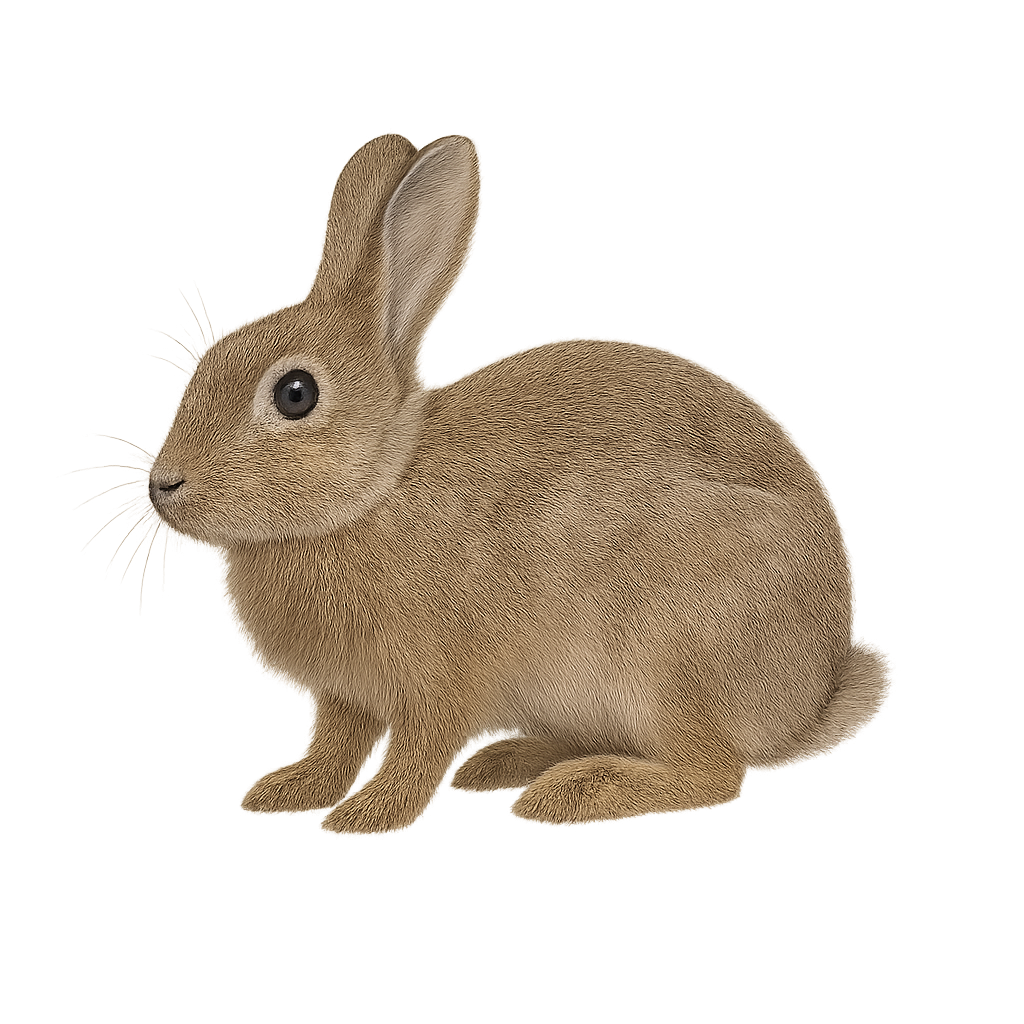
The European Rabbit is a small herbivorous mammal, widely distributed across Europe and in certain parts of the world where it has been introduced. It measures about 40 to 50 cm in length, with a short tail and soft fur that varies from light gray to brown, with a white belly. The European Rabbit is known for its long ears, bright eyes, and powerful hind legs that allow it to leap quickly. It typically lives in groups in burrows called "warrens," which it digs in soft soils or dense vegetation. This rabbit is primarily herbivorous, feeding on grasses, roots, leaves, and fruits. While it is an excellent breeder, with several litters a year, it is vulnerable to predators such as foxes, birds of prey, and carnivores. Despite its large population, the European Rabbit is threatened in some areas by excessive hunting, habitat loss, and the spread of diseases. It plays an important role in ecosystems as prey for many carnivores and as an ecological engineer, digging burrows that alter soil structure.
The Pallas's Cat, or Otocolobus manul, is a small wild cat primarily found in the steppes and mountains of Central Asia. It measures about 50 cm in length, with a tail of about 20 to 30 cm, and weighs between 2 and 5 kg. It has a thick, dense coat that is light gray to beige, with dark stripes on the back and lighter spots on the belly, allowing it to blend perfectly into its environment. The cat is also known for its large, rounded ears and piercing eyes. The Pallas's Cat is a solitary, primarily nocturnal hunter that feeds on small mammals, birds, and insects. While it is an excellent predator, it is often difficult to spot due to its elusive nature and lifestyle in harsh terrain. The species is threatened by habitat loss, hunting, and competition with humans for natural resources. Conservation efforts are underway to protect the Pallas's Cat and its habitats.
The Cavendish Dik-dik is a small antelope found mainly in the semi-arid zones and savannas of East Africa. It stands about 40 cm tall at the shoulder, with a body length of 60 to 70 cm, and weighs between 3 and 6 kg. This small herbivore is easily recognized by its compact size, sharp muzzle, and bright eyes. Its coat is typically gray-brown, with lighter shades on the belly and distinct markings around the eyes, giving it an alert expression. The Cavendish Dik-dik is a discreet animal, often seen alone or in small family groups, preferring to avoid large human concentrations. It primarily feeds on herbaceous plants, fruits, seeds, and leaves. Its small size allows it to slip easily through bushes and tall grasses to escape predators. While the species is not currently endangered, it is vulnerable to habitat loss and pressures from human activities.
The White-fronted lemur is a species of lemur endemic to Madagascar, where it primarily lives in the humid tropical forests of the island's northwest. It is easily recognized by its gray-brown fur and the large white patch on its forehead, from which it derives its name. This lemur is primarily frugivorous, feeding on fruits, flowers, and nectar. It lives in complex social groups and exhibits strong territorial behaviors, including loud vocalizations to define its territory. Although often active during the day, it is also known to be particularly active at dusk.
The Leopard is a powerful and agile big cat, easily recognizable by its spotted coat, formed by black rosettes on a golden or yellow background. It typically measures between 1.2 and 1.9 meters in length, with a tail of 60 to 100 cm, and weighs between 30 and 90 kg, with males generally being larger than females. The Leopard is a solitary, nocturnal hunter, known for its ability to climb trees, often to hide its prey and avoid other carnivores. It is an opportunist, feeding on various types of prey, ranging from small mammals to medium-sized ungulates, and sometimes even reptiles and birds. This big cat is found across much of sub-Saharan Africa and in certain regions of Asia, including India, China, and parts of the Middle East. While the Leopard is a relatively widespread species, it is threatened by habitat loss, illegal hunting, and the depletion of its natural prey. It remains one of the most formidable and adaptable predators in the savanna, forests, and mountains.
The Garden Dormouse is a small nocturnal rodent, often compared to a miniature squirrel, found primarily in Europe and Asia. It measures about 20 cm in length, with a tail of around 12 cm, and weighs between 100 and 150 g. Its coat is typically light gray or brown, with a dark line running from its eyes to its back and a lighter area on its belly. The Garden Dormouse is primarily nocturnal and arboreal, feeding on fruits, nuts, seeds, as well as small insects and larvae. It is an excellent climber and takes refuge in trees or crevices to sleep during the day. This rodent is a hibernator, retreating into its nest in the fall to survive the winter, which is essential for its survival in the cold. Although the Garden Dormouse is protected in some areas, it is threatened by deforestation and the reduction of its natural habitat.
The European Hare is a large herbivorous mammal, easily recognizable by its long ears and powerful hind legs. It measures about 50 to 70 cm in length, with a short tail and a wingspan of 70 to 90 cm, and weighs between 3 and 5 kg. Its coat varies with the seasons: in winter, it becomes lighter, while in summer, it takes on a brown or gray hue, allowing it to blend effectively into fields and meadows. The European Hare is a solitary and territorial animal, primarily found in open areas such as fields, meadows, and sparse woodlands. It is particularly fast and agile, capable of running at speeds of over 60 km/h when pursued. This hare primarily feeds on grasses, leaves, fruits, and roots. Although the species is widespread in Europe, it faces threats from hunting, habitat loss, and human disturbances.
The Cape Hare is a large herbivorous mammal native to sub-Saharan Africa, particularly found in open areas, savannas, and semi-arid regions. It measures between 50 and 70 cm in length, with a tail of 10 to 12 cm, and weighs between 2 and 4 kg. Its coat is generally light brown or gray with a lighter belly, allowing it to blend effectively into its environment. The Cape Hare is a nocturnal and crepuscular animal, primarily feeding on plants, grasses, fruits, and roots. While it is a fast runner, reaching speeds of 50 to 60 km/h, it prefers discretion and often remains hidden during the day in bushes or tall grasses. This hare is also known for its ability to remain motionless and quickly adapt to its surroundings, making it difficult for predators to spot. While the species is relatively common, it can be threatened by habitat loss and hunting.
The Iberian Hare is a rodent endemic to the Iberian Peninsula, primarily found in Spain and Portugal. It measures between 50 and 60 cm in length, with a tail of 6 to 9 cm, and weighs between 2 and 3 kg. This hare is smaller than its European cousin, with a lighter coat, often gray-brown or light brown, with darker markings on the back and a paler hue on the belly. The Iberian Hare primarily inhabits open plains, oak forests, and meadows, where it feeds on vegetation, mainly grasses, roots, leaves, and sometimes young shrub shoots. It is a crepuscular and nocturnal animal, most active at dusk and during the night. While the species is not immediately endangered, it is threatened by habitat loss, hunting, and the introduction of predators such as foxes and dogs.
The Mountain Hare is a small mammal, easily recognizable for its ability to change color according to the seasons. In winter, its coat becomes completely white, allowing it to blend perfectly into the snow, while in summer, it has a brown or gray coat, with darker shades on its back and lighter hues on its belly. It measures about 50 to 70 cm in length, with a tail of 6 to 8 cm, and weighs between 2 and 4 kg. The Mountain Hare is primarily found in the cold, mountainous regions of Northern Europe, Northern Asia, and certain mountainous areas of North America. It is a herbivorous animal that feeds on a variety of vegetation, primarily grasses, roots, fruits, and young shoots. It is mainly active at dusk and during the night, hiding in bushes or under grasses during the day. Although it is quite resilient to cold temperatures, the species is threatened by habitat loss and climate changes affecting its natural environment.
The Lion is one of the largest land predators, often called the "king of the animals." It measures between 1.2 and 2.5 meters in length, with a tail of about 80 to 100 cm, and weighs between 120 and 250 kg, with males generally being larger and more massive than females. Male lions are easily recognizable by their majestic mane, which varies in color from light blonde to dark brown. Their coat is generally golden to light brown, with lighter patches on the belly and under the legs. Lions primarily live in Africa, with a small population in Asia (particularly in Gir National Park, India). They prefer open savannas, grasslands, and light forests. The lion is a social predator that typically hunts in groups, with females doing most of the hunting. Their diet consists mainly of large herbivores such as zebras, gazelles, and buffaloes. While the lion is an iconic species, it is threatened by habitat loss, human conflicts, and the depletion of its natural prey.
The Dormouse with a Bushy Tail is a small nocturnal rodent, easily recognizable by its large bushy tail, which is one of its distinctive features. It measures about 20 to 25 cm in length, with a tail of around 10 to 15 cm, and weighs between 50 and 150 g. Its coat is generally gray or brown, with a lighter shade on the belly, and it has large round ears and bright eyes. The Dormouse with a Bushy Tail primarily lives in forests, hedgerows, and gardens, where it feeds on fruits, seeds, nuts, as well as small creatures like insects. It is mainly active at night, taking refuge in tree holes or burrows during the day. This rodent hibernates during the winter, entering a state of torpor for several months, which allows it to survive the cold temperatures. While the species is not currently endangered, it faces threats from deforestation and the reduction of its natural habitat.
The Common Dormouse is a small nocturnal rodent, often compared to a miniature squirrel, found mainly in forests, hedgerows, and gardens across Europe. It measures about 7 to 9 cm in length, with a tail of 5 to 7 cm, and weighs between 15 and 30 g. Its coat is typically brown or gray with a light belly, and it has large black eyes and round ears. The Common Dormouse is an arboreal and nocturnal animal that primarily feeds on fruits, seeds, nuts, and sometimes insects. It is an excellent climber, often living in trees or natural cavities. This small rodent is known for its hibernation behavior: it enters torpor during the winter months, retreating into its nest to survive the cold temperatures. Although it is widespread, it is threatened by habitat loss and human disturbances.
The Gray Dormouse is a small nocturnal rodent, closely related to the Common Dormouse, found mainly in Europe in forests, hedgerows, and gardens. It measures between 10 and 15 cm in length, with a tail of about 8 to 12 cm, and weighs between 40 and 100 g. Its coat is generally light gray or brown-gray, with lighter shades on the belly and dark eyes that give it a lively expression. The Gray Dormouse is an excellent climber and is primarily arboreal. It feeds on fruits, seeds, nuts, and sometimes insects and small worms. This rodent is known for its ability to hibernate during the winter, retreating into natural cavities or nests made of leaves and moss to survive the cold temperatures. While it is relatively common, it is threatened by habitat loss, deforestation, and disturbances caused by human activity.
The Maned Wolf is a large carnivore native to South America, particularly known for its distinctive mane that surrounds its neck, giving the animal a majestic and unique appearance. It measures about 1 meter in body length, with a tail of about 30 to 40 cm, and weighs between 20 and 30 kg. Its coat is generally orange or golden in color, with darker shades on the head and legs, and a dark mane extending along its neck and throat. The Maned Wolf primarily inhabits the prairies and open savannas of Brazil, especially in the Pantanal region. It is an opportunistic predator, mainly feeding on small mammals, birds, and reptiles, but it can also consume fruits and plants. This wolf is an excellent runner and uses its speed to capture prey. Although the Maned Wolf is little known, it is an endangered species due to habitat loss, cattle trampling of land, and diseases. Conservation efforts are in place to protect this unique species.
The Arctic Wolf is a subspecies of the gray wolf, primarily found in the cold and snowy regions of the Arctic, particularly in northern Canada, Alaska, and Greenland. It measures about 1.5 to 2 meters in length, including its tail, and weighs between 30 and 50 kg, with males generally being larger than females. Its coat is thick and pure white, allowing it to blend perfectly into the snowy landscapes. This wolf has evolved to adapt to the extreme conditions of its environment, with wide paws that allow it to walk in deep snow, and dense fur that protects it from the cold. The Arctic Wolf lives in family groups, typically consisting of 5 to 10 individuals, who hunt together for prey such as caribou, birds, and other mammals. Although this subspecies is adapted to its environment, it is vulnerable to climate change, which affects the distribution of its prey and natural habitat. The Arctic Wolf is also threatened by hunting and habitat loss due to human activity.
The Coastal Wolf is a subspecies of the gray wolf primarily found along the coasts of Alaska and the North Pacific, as well as on certain islands. This wolf is adapted to its coastal environment, where it primarily hunts marine prey such as seals, fish, and seabirds. It measures about 1.3 to 1.5 meters in length, with a tail of about 30 to 40 cm, and weighs between 30 and 50 kg. Its coat is typically gray, brown, or black, with lighter shades on the belly and a thick mane around the neck. The Coastal Wolf is a social predator that lives in family groups and hunts in packs, often in areas close to water or on beaches. In addition to marine prey, it may also feed on deer, bears, and small mammals. While this subspecies is less widespread than others, it is well adapted to its environment and plays an important role in maintaining the balance of coastal ecosystems. However, it is threatened by habitat loss, human disturbances, and hunting.
The Eastern Wolf is a subspecies of the gray wolf, primarily found in the regions of Eastern Europe, notably in Poland, Romania, Bulgaria, and Ukraine. It measures about 1.2 to 1.5 meters in length, with a tail of 35 to 45 cm, and weighs between 25 and 45 kg, with males generally being larger and more massive than females. Its coat is thick and generally light gray to dark gray, with brown and white shades on the belly and legs. The Eastern Wolf primarily inhabits forests, mountains, and protected areas, where it hunts prey such as deer, wild boars, roe deer, and sometimes small mammals. It is a social predator, living in packs, and cooperates with other members of its group to capture prey. Although this subspecies has been the subject of conservation programs, it remains vulnerable to hunting, habitat loss, and conflicts with humans.
The Golden Wolf is a medium-sized canid native to the Middle East and certain regions of East Africa. It measures about 1.2 to 1.5 meters in length, including its tail, and weighs between 11 and 20 kg. Its coat is generally golden yellow or light brown, with black markings on its back and legs, and lighter shades on its belly. It has long, pointed ears and a narrow, elongated head. The Golden Wolf is primarily carnivorous, feeding on small mammals, birds, reptiles, and sometimes fruits. It lives in family groups or small packs and often hunts cooperatively with other members of the group. The Golden Wolf prefers open areas such as savannas, steppes, and mountains and is particularly adapted to semi-arid environments. Although the species is not immediately endangered, it is threatened by habitat loss, human conflict, and competition with larger carnivores such as jackals and lions.
The Gray Wolf is a large carnivore, often considered the ancestor of all modern subspecies of wolves. It measures between 1.2 and 1.8 meters in length, with a tail of 30 to 50 cm, and weighs between 25 and 40 kg, though some individuals can reach 70 kg. Its coat is typically gray, but it can also include shades of white, brown, and black depending on the region and season. The Gray Wolf lives in a variety of habitats, from deep forests to tundra regions, and from mountains to plains. It is a social predator that lives in packs, cooperating with other members of its group to hunt prey such as deer, elk, bison, and other large mammals. The Gray Wolf plays an essential role in ecosystem balance by regulating herbivore populations. Although it is protected in many areas, it remains threatened by habitat loss, hunting, and conflicts with humans.
The Eurasian Otter is a semi-terrestrial aquatic mammal found primarily in rivers, lakes, and coastal areas of Eurasia. It measures between 60 and 90 cm in length, with a tail of about 30 to 40 cm, and weighs between 5 and 12 kg. Its coat is thick and waterproof, dark brown on the back and lighter on the belly, allowing it to stay warm and move easily in the water. The Eurasian Otter is an excellent swimmer, using its hind limbs to propel itself and its tail to stabilize. It primarily feeds on fish but can also hunt amphibians, crustaceans, and small mammals. It is a solitary animal or lives in small family groups, marking its territory with traces and droppings. Although the species is protected in many areas, it is threatened by water pollution, habitat loss, and poaching.
The Sea Otter is a marine aquatic mammal primarily found along the coasts of the Pacific Ocean, particularly in North America and Northeast Asia. It measures between 1 and 1.5 meters in length, with a short tail of about 30 cm, and weighs between 14 and 45 kg, with females generally being smaller than males. Its coat is extremely dense and waterproof, with fine hairs that help it stay warm in the cold ocean waters. Unlike many other marine mammals, the Sea Otter does not have a layer of fat beneath its skin, making its fur all the more crucial for survival. This carnivore primarily feeds on shellfish, crustaceans, mollusks, fish, and sea urchins, often using rocks as tools to open them. The Sea Otter often lives in family groups called "rafts," floating together on the water's surface. Although it is protected in many areas, the Sea Otter is still threatened by pollution, habitat loss, and hunting.
The Canada Lynx is a medium-sized cat characterized by its thick paws and large pointed ears adorned with black tufts of fur. It measures about 80 to 105 cm in length, with a short tail of about 10 to 15 cm, and weighs between 8 and 14 kg. Its coat is generally light gray to reddish-brown, with darker spots on the flanks and a lighter underside. The Canada Lynx primarily inhabits the boreal forests of North America, particularly in Canada and northern parts of the United States. It primarily feeds on hares, particularly the Snowshoe Hare, but may also hunt small mammals, birds, and fish. This solitary predator is known for its great stealth and ability to blend into its snowy environment. While the species remains relatively stable, it faces threats such as habitat loss, competition with other predators, and the impacts of climate change.
The Iberian Lynx is a medium-sized cat endemic to the Iberian Peninsula, primarily found in southern Spain and Portugal. It measures about 80 to 100 cm in length, with a tail of about 10 to 15 cm, and weighs between 8 and 14 kg, with males generally being larger than females. Its coat is pale beige to light brown, with darker spots on the back and flanks, and a lighter underside. It has pointed ears, adorned with tufts of black fur, and a small beard on its chin. The Iberian Lynx primarily inhabits wooded and semi-desert areas, where it hunts prey such as hares, birds, and especially ungulates like deer and rabbits, which are its main food source. This solitary predator is highly territorial and uses calls and claw marks to demarcate its territory. Although it is one of the most endangered cats in the world, conservation efforts have helped increase its population, but it remains vulnerable to habitat loss and the decline of its natural prey.
The Bobcat is a medium-sized cat native to North America, where it is widespread, particularly in the United States, Canada, and Mexico. It measures about 80 to 110 cm in length, with a short tail of 10 to 15 cm, and weighs between 8 and 14 kg, although some males can reach 20 kg. Its coat is typically tawny or grayish with dark spots, and it has black tufts of fur on its ears, a characteristic feature of this species. The Bobcat is an excellent solitary hunter, primarily feeding on hares, rabbits, as well as birds and small mammals. It is particularly known for its ability to hunt in a variety of environments, ranging from dense forests to more open regions. This predator uses its great stealth to approach its prey before launching a quick attack. While the Bobcat remains relatively stable in terms of population, it is threatened by habitat loss and illegal hunting in some areas.
The Black-faced macaque is a primate native to the islands of Sulawesi in Indonesia. It is recognizable by its distinctive black face and gray or brown fur. This macaque is primarily frugivorous but also feeds on insects and small animals. It lives in complex social groups, often near rivers and tropical forests. The species is threatened by deforestation and the loss of its natural habitat.
The Slender mongoose is a small species of mongoose often found in the savannas and dry forests of East Africa. It primarily feeds on small insects, reptiles, and occasionally small mammals. With its slender body and quick movements, it is highly agile and often lives in family groups. Slender mongooses are very social and communicate with each other through vocalizations and visual signals. Although abundant, this species may be locally threatened by habitat loss.
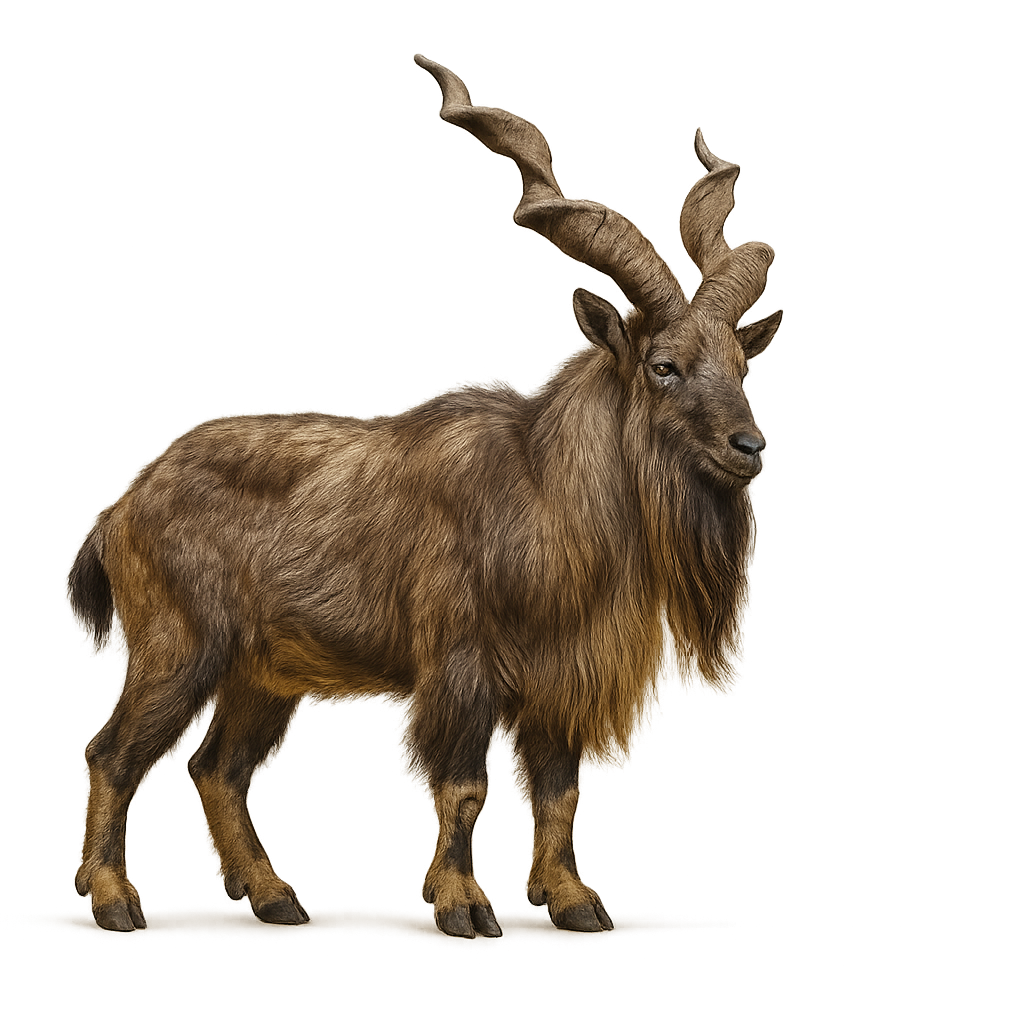
The Markhor is a wild goat species native to the mountains of Central Asia, primarily found in Afghanistan, Pakistan, Tajikistan, and India. It stands about 1.2 to 1.5 meters tall at the shoulder, with a body length of 1.5 to 2 meters, and weighs between 30 and 115 kg, with males generally being larger and more massive than females. The Markhor is famous for its impressive spiral horns, which can grow up to 1.5 meters long in adult males. Its coat is thick, typically brown or gray, with lighter fur on the belly and legs. It lives in mountainous and rocky areas, often at altitudes between 1,000 and 3,000 meters. The Markhor is an herbivore, feeding on mountain vegetation, including shrubs, leaves, and grasses. Although it is an agile climber and skilled at navigating steep terrain, it is also preyed upon by large predators such as snow leopards. The Markhor is classified as vulnerable due to overhunting, habitat loss, and human disturbances, but conservation efforts have helped stabilize its population in some areas.
The Alpine Marmot is a large rodent primarily found in the mountainous regions of Europe, especially in the Alps, the Pyrenees, and the mountains of Italy. It measures about 40 to 60 cm in length, with a tail of 10 to 15 cm, and weighs between 3 and 7 kg, with females generally being a little smaller than males. Its coat is thick and typically brown-gray, with a lighter belly, allowing it to blend into its rocky and grassy environment. The Alpine Marmot lives in burrows dug into the ground, where it takes refuge to sleep, escape predators, and hibernate during the winter, a period when it enters a state of torpor for several months. During the summer season, it primarily feeds on grasses, roots, flowers, and berries. The Alpine Marmot is a social animal, typically living in family groups or colonies. While its population remains relatively stable, it is threatened by climate change and human development of its natural habitat.
The Common Porpoise is a small cetacean from the Phocoenidae family, found primarily in the temperate and cold waters of the North Atlantic and the North Sea, although its range also extends to certain parts of the Baltic Sea. It typically measures between 1.3 and 2 meters in length and weighs between 40 and 65 kg. Its coat is dark on the back and light on the belly, and it has a small dorsal fin located near the back. The Common Porpoise has a rounded snout and is easily recognizable by its small, rounded pectoral fins. It primarily feeds on fish, crustaceans, and cephalopods, hunting using echolocation to locate prey in the water. Although it is often seen in small groups, it generally prefers to swim alone or in small family units. While the species is classified as of least concern, it faces threats such as pollution, accidental bycatch in fishing nets, and disturbances caused by maritime traffic.
The European Marten is a small carnivorous mammal, measuring between 45 and 55 cm in length, with a tail of 25 to 30 cm. It typically weighs between 1.5 and 2 kg, with males being slightly larger than females. Its fur is reddish-brown on the back, with a lighter belly, sometimes pale yellow, and a distinctive white patch on the throat. The European Marten primarily inhabits forests, woodlands, and mountains across Europe, although it can also be found in agricultural areas and urban parks. It is an excellent climber and spends a lot of time in trees, where it primarily hunts birds, small mammals, insects, and fruits. The European Marten is a solitary, territorial animal, with nocturnal and crepuscular behavior. While its population remains relatively stable, it is threatened by habitat loss, hunting, and road collisions.
The Walrus is a large marine mammal from the Odobenidae family, measuring between 3 and 4 meters in length and weighing between 800 and 1,500 kg. Males are generally much larger than females. This cetacean is distinguished by its long tusks, which can reach up to 1 meter in length in adult individuals, and its large, sensitive whiskers that help detect food on the ocean floor. The Walrus has short fur, typically brown or gray, but its skin is covered by a thick layer of blubber that helps it stay warm in the icy waters of the Arctic and North Atlantic. Walruses primarily inhabit coastal regions, where they feed mostly on mollusks, crustaceans, and fish. They spend a large part of their time on the ice, where they rest and socialize in large groups. While their population remains relatively stable, walruses face threats such as hunting, habitat loss, and the effects of climate change on their environment.
The Mouflon is a small wild sheep found primarily in the mountains of Europe, the Middle East, and Central Asia. It measures between 70 and 80 cm in height at the withers and weighs between 40 and 80 kg, with males generally being larger and more imposing than females. What distinguishes the Mouflon is the presence of large, curved horns in males, while females have smaller and less pronounced horns. Their coat is generally reddish-brown in the summer, with a white belly and a darker mane along the back, which becomes thicker and fuller in the winter. The Mouflon primarily inhabits mountainous areas, forests, and meadows, where it feeds on grasses, leaves, shrubs, and roots. It is an excellent climber and moves easily across rocky and steep terrain. While its population remains stable, the Mouflon may be threatened by habitat loss, hunting, and competition with domesticated livestock.
The Corsican Mouflon is a subspecies of the Mouflon, native to the island of Corsica, where it primarily inhabits mountains and rocky areas. It measures about 70 cm in height at the withers and weighs between 40 and 70 kg. What distinguishes the Corsican Mouflon are its horns, which are particularly large and spirally curved in males, while females have smaller horns. Its coat is generally reddish-brown with lighter shades on the belly and a darker mane along the back. The Corsican Mouflon is an agile animal and an excellent climber, capable of moving easily through the steep and rocky terrain of its natural habitat. It feeds primarily on grasses, shrubs, leaves, and roots. While its population remains relatively stable on the island, it faces threats related to habitat loss and hunting. These animals are solitary or live in small groups, primarily during the breeding season.
The Narwhal is a unique cetacean, often referred to as the "unicorn of the seas" due to the long twisted tusk it possesses, typically in males. It measures between 4 and 5 meters in length and can weigh up to 1,600 kg. The narwhal's tusk can reach up to 3 meters in length and is actually a tooth that grows asymmetrically, often spiraling. Its body is gray to white with black and white patches that vary from one individual to another. The Narwhal primarily inhabits the cold waters of the Arctic, where it feeds on fish, crustaceans, and cephalopods. It is an excellent diver, capable of descending to great depths in search of food. While its population remains relatively stable, it is threatened by climate change, water pollution, and human disturbances. Due to its beauty and rarity, it is also highly sought after for illegal horn trade.
The Proboscis Monkey is a large primate native to the tropical forests of Borneo and Sumatra. It measures about 60 to 75 cm in length and weighs between 15 and 25 kg. It is easily recognizable by its prominent, elongated nose, which can measure up to 10 cm in adult males. This nose is particularly developed in males and plays a role in vocalizations and attracting females. Its coat is generally brown or reddish, with a lighter belly. The Proboscis Monkey primarily inhabits mangroves, lowland forests, and mountain forests, where it feeds mainly on leaves, fruits, seeds, and roots. It is an excellent climber and spends much of its time in the trees, typically living in social groups consisting of several females and their young. While its population remains relatively stable, it faces threats such as deforestation, hunting, and habitat loss.
The Ocelot is a medium-sized wild cat, measuring between 55 and 100 cm in length (excluding the tail) and weighing between 8 and 16 kg. It is distinguished by its spotted and striped coat, which helps it blend effectively into dense forests and wooded areas where it lives. Its fur is generally golden or grayish, with black marks in the form of spots or rosettes across the body. The Ocelot is a nocturnal and solitary hunter, primarily feeding on small mammals, birds, reptiles, and fish. It is agile and fast, capable of climbing trees to hunt or escape predators. This cat is primarily found in Central and South America, in tropical forests, savannas, and mountainous areas. While its population remains stable in some regions, the Ocelot is threatened by deforestation, illegal hunting, and habitat loss.
The Okapi is a herbivorous mammal native to the rainforests of the Democratic Republic of Congo in Central Africa. It measures between 1.5 and 2 meters in length and weighs between 200 and 350 kg, resembling a combination of a giraffe and a horse. Its coat is generally dark brown with characteristic white bands on its legs, similar to those of a zebra, hence its nickname "zebra-headed giraffe." The Okapi is a solitary and secretive animal, primarily feeding on leaves, fruits, and plant shoots. It inhabits dense forests, where it uses its sense of smell and great discretion to escape predators. While its population remains relatively stable, the Okapi is threatened by deforestation, poaching, and human conflict.
The Bornean orangutan is a large primate, measuring about 1.2 to 1.5 meters in height and weighing between 40 and 90 kg. It is easily recognized by its reddish fur and long arms, which allow it to move effortlessly through the trees. This species is native to the island of Borneo, where it primarily inhabits tropical forests. The Bornean orangutan is an herbivore, feeding mainly on fruits, leaves, bark, and small insects. It is a solitary animal, with very discreet behaviors and a great ability to adapt to its environment. Due to deforestation, illegal hunting, and the loss of its natural habitat, this species is classified as endangered.
The Sumatran orangutan is a majestic primate, measuring between 1.2 and 1.4 meters in height and weighing between 30 and 70 kg. It has a shiny reddish fur, with long arms adapted to its arboreal lifestyle. Native to the island of Sumatra in Indonesia, this orangutan primarily inhabits tropical lowland forests and swampy areas. Its diet mainly consists of fruits, leaves, bark, and small insects. It is primarily solitary and has a great ability to camouflage among the trees. Unfortunately, this species is critically endangered due to massive deforestation, forest fires, and illegal hunting.
The Tapanuli orangutan is a recently discovered primate species, considered one of the rarest and most endangered in the world. It measures about 1.2 meters in height and weighs between 30 and 60 kg. This ape has a shiny reddish coat, with long arms adapted to its life in the trees. Native to the mountains of the Tapanuli region in northern Sumatra, Indonesia, this orangutan primarily inhabits montane tropical forests. It feeds mainly on fruits, leaves, and bark. The Tapanuli orangutan is a solitary and secretive animal and is considered critically endangered due to deforestation, mining, human conflict, and forest fires.
The Moose is a large deer found primarily in North America, particularly in coniferous forests and wetlands. It can reach up to 2 meters in height at the withers and weigh between 350 and 600 kg. Males are distinguished by their large antler racks, which can reach a span of 1.8 meters. Their coat is typically dark brown to black, with a lighter belly and a small mane of hair under the neck. The Moose is a herbivore, feeding mainly on leaves, branches, bark, fruits, and aquatic plants. It is an excellent swimmer and spends a great deal of its time feeding in lakes and rivers. While its population remains stable, it is threatened by habitat loss and hunting.
The Platypus is a unique aquatic mammal native to Australia and Tasmania. It measures between 40 and 60 cm in length and weighs around 1 to 2.5 kg. This animal is particularly remarkable due to its appearance, which combines characteristics of different animals: it has a flat bill similar to a duck's, webbed feet adapted for swimming, and a flat tail. The Platypus is a carnivore, primarily feeding on small aquatic invertebrates, worms, and crustaceans. It lives in rivers and lakes, spending much of its time diving underwater in search of food. Although it is an excellent swimmer, the Platypus is also capable of moving quickly on land. This species is listed as "near threatened" due to habitat loss and water pollution.
The Orca, also known as the "killer whale," is a large cetacean from the dolphin family, measuring between 6 and 8 meters in length and weighing up to 6 tons. It is distinguished by its striking black and white coloration, with white patches around the eyes and on the flanks. The Orca is a top predator in the food chain, primarily feeding on fish, marine mammals, sharks, and sometimes even whales. It lives in social groups called "pods," led by the dominant female, where cooperation and hunting strategies are essential. The Orca is found in all oceans around the world, but it prefers cold and temperate waters. While its population remains relatively stable, the Orca is threatened by pollution, a decline in prey, and human-caused disturbances.
Native to the savannas and forests of sub-Saharan Africa, the Aardvark is a nocturnal mammal that primarily feeds on termites and ants. It has a long sticky tongue which it uses to extract insects from their burrows. This mammal is easily recognizable by its large ears, elongated snout, and sturdy limbs. Although relatively discreet, the Aardvark is threatened by habitat loss and poaching.
The Beisa Oryx is a large antelope found primarily in the arid and semi-desert regions of East Africa, particularly in Somalia, Ethiopia, and Kenya. It stands between 1.2 and 1.5 meters at the shoulder and weighs around 100 to 150 kg. The Beisa Oryx is easily recognized by its long, straight horns, which can reach up to 1 meter in length. Its coat is sandy-colored, with black markings on the flanks, legs, and around the eyes, helping it blend into its desert environment. This herbivore feeds primarily on bushes, grasses, and succulent plants. Although the Beisa Oryx is capable of tolerating extremely high temperatures, it is also well adapted to cover large distances in search of food and water. This species is currently listed as "near threatened" due to habitat loss and hunting.
The Fur Seal, also known as the hair seal, is a marine mammal primarily found along the coasts of the Southern Hemisphere, particularly in Australia, South Africa, and subantarctic islands. It measures between 1.5 and 2.5 meters in length and weighs between 200 and 350 kg. Its dense and waterproof fur, which gives it its name, consists of short, soft hairs covering a layer of subcutaneous fat that insulates it from the cold. The Fur Seal is an excellent swimmer, capable of diving to significant depths to feed on fish, cephalopods, and crustaceans. It lives in colonies, forming strong social groups, especially during the breeding season. While the population of fur seals remains relatively stable, this species is threatened by hunting, habitat loss, and ocean pollution.
The Andean Bear, also known as the spectacled bear, is a large mammal found primarily in the tropical forests and mountains of South America, particularly in Colombia, Venezuela, Ecuador, and Peru. It measures about 1.5 to 2 meters in length and weighs between 100 and 200 kg. Its coat is generally black, with white or cream markings around its eyes in the shape of spectacles, hence its name. The Andean Bear is an omnivore, primarily feeding on fruits, plants, honey, and insects, but it may also eat small mammals or birds. It is an excellent climber, using its powerful claws to move through trees in search of food. Although its population remains stable in some areas, the Andean Bear is threatened by habitat loss, deforestation, and poaching.
The Brown Bear is one of the largest terrestrial carnivores, measuring between 1.5 and 2.5 meters in length and weighing between 100 and 800 kg, depending on the subspecies and habitat conditions. Its coat ranges from light brown to dark brown, and it is often denser during the winter. The Brown Bear primarily lives in forests, mountains, and Arctic regions, but can also be found in tundra and prairie areas. It is omnivorous, feeding on fruits, roots, small mammals, fish, and even carrion. The Brown Bear is also an excellent swimmer and climber. Due to hunting, habitat loss, and conflicts with humans, some subspecies of Brown Bears are threatened or endangered.
The Kermode Bear, also known as the "spirit bear" or "white-furred bear," is a rare subspecies of the American Black Bear. It measures between 1.2 and 1.8 meters in length and weighs between 70 and 250 kg. What particularly distinguishes the Kermode Bear is its coat, which can vary from black to creamy white, although the majority of these bears have black fur. This subspecies primarily lives in the humid forests of British Columbia, Canada, and feeds mainly on fruits, berries, fish, and small mammals. The Kermode Bear is typically solitary and inhabits remote areas. Although it is relatively rare, it is not considered to be in immediate danger, though it faces threats from habitat loss and other human-related activities.
The Sloth Bear, also known as the lip bear, is a large carnivorous mammal primarily found in the tropical and subtropical forests of India, Sri Lanka, Bangladesh, and Myanmar. It measures about 1.4 to 1.8 meters in length and weighs between 50 and 150 kg. What particularly distinguishes the Sloth Bear is its face, which has highly mobile lips and long fur around the mouth, giving it its name. Its coat is generally black with white markings on the chest and throat, forming a sort of crescent shape. The Sloth Bear is an omnivore, feeding on fruits, honey, insects, roots, and small animals. Although it is primarily terrestrial, it is also capable of climbing trees. Due to habitat loss and poaching, this species is currently listed as vulnerable.
The Malayan bear is the smallest of the bears, characterized by its small size, black fur, and a light-colored fur collar around its neck. It primarily lives in the tropical forests of Southeast Asia, where it feeds on fruits, honey, and insects. This animal is rather discreet, nocturnal, and semi-arboreal, often seen in trees looking for food. Although protected, the Malayan bear faces serious threats such as deforestation and illegal hunting.
The American Black Bear is a large carnivore primarily found in North America, in forests, mountains, and wooded areas. It measures between 1.5 and 2.5 meters in length and weighs between 45 and 250 kg, depending on the subspecies and habitat conditions. Its coat ranges from black to light brown, and it has a short muzzle and a large head. The Black Bear is an omnivore, primarily feeding on fruits, berries, nuts, roots, fish, small mammals, and sometimes carrion. It is also an excellent climber and a skilled swimmer, capable of moving through trees and crossing rivers in search of food. While its population remains relatively stable, the Black Bear is threatened by habitat loss, vehicle collisions, and hunting.
The Asiatic Black Bear, also known as the Tibetan Bear, is a medium-sized mammal found primarily in the mountains of Central Asia, the Indian subcontinent, China, and Russia. It measures between 1.2 and 1.8 meters in length and weighs between 60 and 200 kg. Its coat is typically black, with a distinctive white "V"-shaped mark on its chest. The Asiatic Black Bear is an omnivore, feeding on fruits, berries, roots, small animals, insects, and occasionally carrion. It is an excellent climber and spends much of its time in trees, where it feeds and rests. While the Asiatic Black Bear remains relatively common in some regions, it faces numerous threats such as habitat loss, illegal hunting, and poaching for its body parts.
The Polar Bear is one of the largest land carnivores, measuring between 2 and 3 meters in length and weighing between 350 and 700 kg, depending on habitat conditions and the season. It is perfectly adapted to the icy conditions of the Arctic, with dense, waterproof fur that protects it from the cold, as well as a layer of subcutaneous fat that helps it survive in extreme temperatures. Its coat is typically white or cream, allowing it to blend in with the snow and ice. The Polar Bear is an excellent swimmer and primarily feeds on seals, which it hunts by patiently waiting near breathing holes or swimming under the ice. However, the Polar Bear faces growing threats due to climate change, which is shrinking its ice habitat and affecting its ability to hunt.
The Giant Panda is a large mammal native to the mountains of China, primarily found in the regions of Sichuan, Shaanxi, and Gansu. It measures between 1.2 and 1.8 meters in length and weighs between 70 and 160 kg. What distinguishes it is its black and white coat, with black patches around its eyes, ears, and paws. The Giant Panda is a strict herbivore, feeding almost exclusively on bamboo, although it may occasionally eat fruits, roots, and small animals. It lives in bamboo forests, where it spends most of its day feeding due to the low nutritional value of its diet. The Giant Panda is a symbol of conservation due to its rarity, and although it is still considered vulnerable, conservation efforts have helped stabilize its population.
The Red Panda, also known as the Lesser Panda, is a small mammal native to the mountains of the Himalayas and southern China. It measures between 50 and 65 cm in length, with a bushy tail of 30 to 50 cm, and weighs between 3 and 6 kg. Its coat is predominantly reddish, with white patches around the eyes, ears, and muzzle. The Red Panda is primarily arboreal, living in temperate and mountainous forests, where it feeds on bamboo, fruits, berries, roots, and occasionally insects. Although it is an excellent climber, it is also active on the ground. The Red Panda is a vulnerable species, primarily threatened by habitat loss, deforestation, and illegal hunting.
The Small-scaled Pangolin is an insectivorous mammal found primarily in Central and West Africa, notably in Cameroon, Gabon, and the Republic of Congo. It measures about 50 to 80 cm in length, with a tail that can reach half its body size, and weighs between 5 and 7 kg. Its body is covered with small, hard scales made of keratin, which protect it from predators. When threatened, the Pangolin curls into a ball, exposing only its scales. It primarily feeds on ants, termites, and larvae, which it captures with its long tongue. Although the Pangolin is an excellent burrower, it is vulnerable due to intensive poaching for its scales and habitat loss. It is currently listed as "vulnerable" by the IUCN.
The Chinese pangolin is a small insectivorous mammal known for its body covered with scale-like plates. Native to China and Southeast Asia, it primarily feeds on ants and termites, which it digs up using its powerful claws. It is an excellent climber, often observed in trees where it seeks shelter from predators. Due to illegal hunting and habitat loss, the Chinese pangolin is critically endangered.
The Javan Pangolin, also known as the Malayan Pangolin, is a mammal species native to Southeast Asia. It is easily recognized by its body covered with large keratin scales, which protect it from predators. This nocturnal and solitary animal primarily feeds on ants and termites, which it captures with its long, sticky tongue. The Javan Pangolin is an endangered species, mainly due to habitat loss and poaching for its scales and meat. This pangolin is an excellent burrower, digging dens and hides for protection.
The Temminck's Pangolin is a small insectivorous mammal found primarily in Sub-Saharan Africa, notably in South Africa, Botswana, Namibia, and Zimbabwe. It measures about 50 to 60 cm in length, with a tail that makes up a significant portion of its size, and weighs between 3 and 7 kg. This pangolin is covered with large scales made of keratin, which protect it from predators. When threatened, it curls into a ball with its scales rolled outward. It primarily feeds on termites and other insects, which it captures with its long, sticky tongue. Although the Temminck's Pangolin is an excellent burrower, it is unfortunately threatened by poaching for its scales and by habitat loss.
The Giant Pangolin is the largest of the pangolin species, measuring between 1.2 and 1.5 meters in length, with a tail that can account for up to half of its total length. It weighs between 30 and 40 kg. This mammal, covered in large keratin scales, primarily lives in the forests of Central Africa, particularly in the Democratic Republic of the Congo and the Republic of the Congo. It is an excellent burrower and primarily feeds on termites and other insects, which it captures with its long tongue. The Giant Pangolin is a nocturnal and solitary species, using its powerful claws to dig burrows or open insect nests. Although its population is not well-known, the Giant Pangolin is threatened by deforestation, illegal hunting, and poaching for its scales, making it a vulnerable species.
The Snow Leopard, also known as the ounce, is a large cat primarily found in the mountains of the Himalayas, Tibet, Central Asia, and the Pamir Mountains. It measures between 1.1 and 1.3 meters in length, with a tail of 80 to 100 cm, and weighs between 27 and 55 kg. Its thick, dense fur, which is light gray to white with dark rosettes, allows it to blend perfectly into its snowy environment. The Snow Leopard is a solitary carnivore, primarily feeding on wild goats, sheep, small deer, and sometimes small mammals. It is an excellent climber and stealthy hunter, capable of pouncing on its prey from high ground. Unfortunately, this species is threatened by illegal hunting, poaching, and habitat loss. It is currently listed as "vulnerable" by the IUCN.
The Clouded Leopard is a medium-sized cat primarily found in the tropical and subtropical forests of Southeast Asia, notably in India, Nepal, Bhutan, Thailand, Malaysia, and Indonesia. It measures between 50 and 75 cm in length, with a tail ranging from 60 to 90 cm, and weighs between 12 and 20 kg. Its coat is characterized by spots and rosette patterns that help it blend perfectly into the dense vegetation of its habitat. The Clouded Leopard is an excellent climber and spends much of its time in trees, hunting birds, squirrels, monkeys, and small deer. Although the Clouded Leopard's population remains relatively stable, it is threatened by habitat loss, poaching, and forest fragmentation. This species is currently listed as "vulnerable" by the IUCN.
The Two-toed Sloth is an arboreal mammal native to the tropical forests of Central and South America, notably in Costa Rica, Panama, Colombia, and Ecuador. It measures between 50 and 60 cm in length, with a reduced tail and weighs between 4 and 8 kg. Its fur is long, thick, and gray-green in color, allowing it to blend into the foliage of trees. As its name suggests, it has two toes on its front limbs, which allow it to cling to branches and move slowly from tree to tree. The Two-toed Sloth is primarily herbivorous, feeding on leaves, fruits, and flowers. Although it is an excellent climber, it moves very slowly and often only leaves its trees once a week to descend to the ground for defecation. The species is currently listed as "vulner
The Common Sloth is an arboreal mammal native to the tropical forests of Central and South America, particularly in South America, from Costa Rica to Brazil. It measures between 50 and 70 cm in length, with a tail of 4 to 6 cm, and weighs between 4 and 8 kg. Its fur is long and thick, gray-brown in color, with lighter and sometimes greenish patches due to algae growing on its hair. The Common Sloth primarily feeds on leaves, fruits, and flowers, which it eats very slowly. It is known for its extreme slowness, moving at a speed of 0.03 km/h, making it one of the slowest animals in the world. This behavior is due to its slow metabolism and a diet that is low in calories. Although the population of common sloths is not immediately threatened, they are vulnerable to habitat loss and human disturbances.
The Minke Whale is a medium-sized cetacean, a member of the baleen whale family, found in the Atlantic, Pacific, and Southern Oceans. It measures between 7 and 10 meters in length and weighs between 5 and 10 tons. Its body is streamlined, and its color ranges from gray-blue to black, with a lighter belly. This whale primarily feeds on plankton, small fish, and crustaceans, which it filters by swimming with its mouth open. It is an excellent swimmer and can dive to impressive depths for several minutes. While its population remains stable, the Minke Whale is threatened by ocean pollution, ship collisions, and habitat loss due to human impact on marine ecosystems.
The Common Warthog is a wild mammal native to Sub-Saharan Africa. It measures about 1.2 to 1.5 meters in length, with a shoulder height of 60 to 80 cm, and weighs between 50 and 150 kg. It is easily recognizable by its broad face and large curved tusks, which serve as both a defense mechanism and a tool for digging. Its fur is generally gray or light brown, and it has thick, rough skin. The Common Warthog primarily lives in savannas, grasslands, and open forests, where it feeds mainly on roots, fruits, insects, and small animals. It is a social animal, living in groups, and is mainly nocturnal. Although the Common Warthog is widespread and its population is stable, it is sometimes affected by hunting and habitat loss.
The Common Seal, also known as the Harbor Seal, is a marine mammal found primarily along the coasts of the North Atlantic, in Europe and North America. It measures between 1.5 and 2 meters in length and weighs between 60 and 150 kg. Its fur is typically light gray with dark spots, and its head is rounded with bright black eyes. The Common Seal is an excellent swimmer and primarily feeds on fish, crustaceans, and mollusks. It is often seen lounging on rocks or beaches. Although its population remains relatively stable, the Common Seal is sometimes threatened by pollution, hunting, and human disturbance of its breeding habitats.
The Gray Seal, also known as the Horsehead Seal, is a species of seal found in the coastal waters of the North Atlantic, particularly in Europe and North America. It measures between 2 and 3 meters in length and weighs between 170 and 300 kg. Its fur is typically silver-gray with black spots, and its head is characterized by a wide and elongated snout. The Gray Seal primarily feeds on fish, but also on crustaceans and cephalopods. It spends a lot of time on beaches and rocks for resting and breeding. Although it is not currently threatened, it can be affected by marine pollution, ship collisions, and human disturbance.
The Crestless Porcupine is a large nocturnal mammal primarily found in sub-Saharan Africa, in tropical forests and savannas. It measures between 60 and 80 cm in length, with a tail of 20 to 30 cm, and weighs between 15 and 30 kg. Its fur is primarily made up of rigid, long, sharp quills covering its back, sides, and tail. At the tip of its tail, it has modified quills that produce a distinctive sound when shaken, warning predators of its presence. The Crestless Porcupine is herbivorous and primarily feeds on roots, bark, fruits, and leaves. While its population remains relatively stable, it can be threatened by habitat destruction and hunting.
The Indian Porcupine is a large nocturnal mammal primarily found in South Asia, particularly in India, Nepal, Bangladesh, and Sri Lanka. It measures about 60 to 90 cm in length, with a tail of 25 to 30 cm, and weighs between 10 and 20 kg. Its body is covered with long, rigid quills that range from black to white, forming distinct bands along its back. The Indian Porcupine uses its quills as a defense against predators and can easily detach them to throw when threatened. This porcupine is herbivorous, primarily feeding on fruits, roots, bark, and young shoots. While its population remains generally stable, it can be threatened by deforestation, habitat loss, and hunting.
The Striped hyena is a terrestrial carnivore native to North Africa and the Middle East. It is distinguished by the characteristic stripes on its back and its somewhat awkward gait. This nocturnal predator primarily feeds on carrion, small mammals, and insects. Unlike other hyenas, the Striped hyena is more solitary and less aggressive. Although relatively discreet, it is threatened by habitat destruction and human persecution.
The Puma is a large feline found primarily in the Americas, from Canada to the southern tip of South America. It measures between 1.1 and 1.8 meters in length, with a tail measuring 60 to 80 cm, and weighs between 40 and 100 kg, depending on the sex and subspecies. Its coat is typically sandy, gray, or brown, with a lighter underside. The Puma is a solitary predator, primarily hunting deer, small mammals, and birds. It is also capable of traveling great distances and adapting to different types of habitats, ranging from mountainous forests to desert areas. While its population remains relatively stable in certain regions, it can be threatened by habitat loss, fragmentation of its territories, and hunting.
The European Polecat is a small carnivore found primarily in Europe, inhabiting a variety of environments such as forests, meadows, and agricultural areas. It measures about 45 to 60 cm in length, with a tail of 20 to 30 cm, and weighs between 0.8 and 1.5 kg. Its fur is generally light brown or gray, with lighter underparts and a distinctive black mark on its face, surrounding its eyes. The European Polecat is a nocturnal and opportunistic predator, primarily feeding on small mammals, birds, eggs, as well as fruits and insects. While it is often perceived as a pest by farmers, it plays an important role in regulating populations of small animals. Its population is generally stable, but it can be threatened by habitat loss and road collisions.
The Raccoon is a small omnivorous mammal native to North America, but it has now spread widely to other regions of the world, including Europe and Asia. It measures about 40 to 70 cm in length, with a tail of 20 to 40 cm, and weighs between 4 and 10 kg. Its fur is primarily gray, with a distinctive black mask around the eyes, giving it a unique appearance. The Raccoon is an excellent climber and feeds on fruits, nuts, small animals, insects, as well as food scraps when it lives near human settlements. It is known for its curious behavior and its habit of "washing" its food, although this gesture is actually a reaction to the sensation of moisture in its paws. While its population is widespread, this species can sometimes be seen as a pest, especially due to its tendency to rummage through trash and cause damage to homes.
The Bat-eared Fox is a small carnivore primarily found in the savannas and semi-arid areas of Southern Africa. It measures about 40 to 50 cm in length, with a tail of 25 to 30 cm, and weighs between 1 and 2 kg. Its fur is primarily light gray or beige, with dark markings on the legs and face. What distinguishes it most are its large ears, which resemble those of a bat, and which are highly sensitive, allowing it to locate its prey, primarily insects, small mammals, and birds, through its acute hearing. The Bat-eared Fox is a nocturnal and highly social animal, often living in small groups. While its population remains relatively stable, it can be threatened by habitat destruction and hunting.
The Magellanic Fox is a small carnivore primarily found in the cold and coastal regions of Argentina and Chile, particularly in the Patagonian region. It measures about 60 to 70 cm in length, with a tail of 30 to 35 cm, and weighs between 3 and 5 kg. Its fur is generally gray, with lighter underparts and brown or reddish patches on its back and legs. This fox is omnivorous, feeding on small mammals, birds, insects, but also fruits and plants. It is mainly active during dusk and night, and usually lives alone or in small family groups. While its population remains relatively stable, this species can be threatened by habitat loss and hunting.
The Arctic Fox is a small carnivore found in the Arctic regions, primarily in Alaska, Canada, Scandinavia, and Russia. It measures about 45 to 50 cm in length, with a tail of 30 to 35 cm, and weighs between 3 and 9 kg, depending on the seasons. Its fur is typically white in winter, allowing it to camouflage in the snow, while it takes on a more brown or grayish hue in summer to blend in with the rocky and grassy landscapes. The Arctic Fox is an opportunistic omnivore, feeding on small mammals, birds, eggs, fruits, and berries. Although well adapted to the extreme living conditions of the Arctic, it is threatened by climate change, which is altering its natural habitat and the availability of its prey.
The Red Fox is a small carnivore primarily found in forests, meadows, and agricultural areas of Europe, Asia, and North America. It measures about 45 to 90 cm in length, with a tail of 30 to 50 cm, and weighs between 3 and 10 kg. Its fur is typically reddish with white underparts and on the legs, and its tail is bushy with a white tip. The Red Fox is an opportunistic and omnivorous animal, feeding on small mammals, birds, insects, fruits, and berries. It is primarily active at dusk and night. While its population remains relatively stable in many regions, it can be threatened by habitat loss, vehicle collisions, and diseases.
The Tibetan Fox is a small carnivore endemic to the mountainous regions of Tibet, Nepal, and northern India. It measures about 45 to 60 cm in length, with a tail of 30 to 40 cm, and weighs between 2 and 3 kg. Its fur is typically light gray to brown, with darker shades on the back and lighter underparts. It has large pointed ears and a long bushy tail. The Tibetan Fox is an opportunist, feeding on small mammals, birds, fruits, and berries. It primarily lives in dry and mountainous regions, where it digs burrows to protect itself from the cold. Although its population remains relatively stable, the Tibetan Fox is vulnerable to habitat loss and hunting.
The Southern White Rhinoceros is a large herbivorous mammal primarily found in the savannas and grasslands of Southern Africa, notably in South Africa, Botswana, Zimbabwe, and Namibia. It is one of the largest species of rhinoceros, measuring up to 4 meters in length and weighing between 1,500 and 2,400 kg. It is distinguished by its large square-shaped mouth, adapted for grazing, and its light gray to grayish skin. The Southern White Rhinoceros is a strict herbivore, primarily feeding on grass, though it may occasionally consume leaves and fruits. While its population has long been threatened by poaching and habitat loss, thanks to conservation efforts, its population has made a remarkable recovery and remains relatively stable.
The Javan Rhinoceros is a rare and critically endangered species of rhinoceros found primarily on the island of Java in Indonesia. It measures about 3 to 3.5 meters in length, with a tail of 60 to 80 cm, and weighs between 900 and 1,400 kg. Its fur is dark gray, with thick, wrinkled skin, and it has a single horn located on its nose. The Javan Rhinoceros is primarily herbivorous, feeding on fruits, leaves, shoots, and grass. It typically lives in tropical forests and swampy areas, where it hides in dense vegetation to avoid predators. It is threatened by habitat loss, illegal hunting, and habitat fragmentation, with only a very small remaining population, estimated at fewer than 75 individuals.
The Sumatran Rhinoceros is a critically endangered species of rhinoceros found primarily on the island of Sumatra in Indonesia. It measures about 2 to 3 meters in length, with a tail of 60 to 70 cm, and weighs between 500 and 800 kg. Its fur is generally light brown or reddish, with thick, wrinkled skin. This rhinoceros is one of the smallest members of the rhinoceros family and has two horns. The Sumatran Rhinoceros is herbivorous, feeding on leaves, fruits, roots, and shoots. It primarily lives in tropical lowland forests and swampy areas. While conservation efforts have been made to protect this species, it remains threatened by deforestation, poaching, and habitat loss, with a population estimated to be fewer than 80 individuals in the wild.
The Indian Rhinoceros, also known as the one-horned rhinoceros, is a large species of rhinoceros found primarily in the Indian subcontinent, particularly in India, Nepal, Bangladesh, and Bhutan. It measures about 3.5 to 4 meters in length, with a tail of 60 to 70 cm, and weighs between 2,200 and 3,000 kg. This rhinoceros is easily recognized by its thick, wrinkled skin, with a single horn located on its nose. It primarily feeds on grasses, leaves, and fruits, and lives in a variety of habitats, including grasslands, wetlands, and riverine forests. While its population has long been threatened by poaching and habitat loss, thanks to conservation efforts, the Indian Rhinoceros has experienced some recovery, but it remains vulnerable.
The Black Rhinoceros is a large species of rhinoceros primarily found in East and Southern Africa, notably in Kenya, Tanzania, Namibia, and South Africa. It measures about 3.5 to 4 meters in length, with a tail of 50 to 70 cm, and weighs between 800 and 1,400 kg. This rhinoceros is distinguished by its black skin (although some specimens may be gray) and its two horns located on its nose. Unlike the White Rhinoceros, it has a more pointed mouth, adapted for eating bushes and trees. The Black Rhinoceros is primarily herbivorous, feeding on leaves, fruits, twigs, and tree bark. While its population has long been threatened by poaching and habitat loss, conservation efforts have helped stabilize its population, although it remains critically endangered.
The Northern right whale fin is a large baleen whale that primarily lives in the cold waters of the Atlantic and Pacific Oceans. It is one of the largest cetaceans, characterized by its streamlined body and fast swimming. Unlike other whales, it prefers deeper waters and is less often observed near the coast. The Northern right whale fin is threatened by pollution, underwater noise, and ship collisions, and is classified as vulnerable due to past commercial whaling.
The Fin whale, also known as the Minke whale, is one of the largest whale species, reaching lengths of up to 18 meters and weighing 70 tons. It primarily feeds on krill and small fish, capturing them by filtering water. This migratory whale travels long distances between breeding and feeding areas and is found in all oceans worldwide. While the Fin whale is a protected species, it is still threatened by pollution, ship strikes, and illegal whaling.
The African straw-coloured fruit bat is a fruit-eating bat species native to sub-Saharan Africa. This bat is easily recognizable by its golden or straw-colored fur, which helps it blend into the foliage during the day. The African straw-coloured fruit bats primarily feed on fruits, nectar, and pollen, playing a crucial role in pollinating plants. They form large colonies and are often seen in flight at dusk as they head out to search for food. These bats can also travel long distances, making them adaptable to a wide range of habitats.
The saiga is an antelope from the Central Asian steppes, recognizable by its prominent, trunk-like nose that filters dust and warms inhaled air. Adapted to arid environments, it migrates in large herds in search of pastures. Its population, once declining, shows signs of recovery due to conservation efforts.
The Wild Boar is a large omnivorous mammal found primarily in forests, wooded areas, and mountains of Europe, Asia, and North Africa. It measures between 1.2 and 1.8 meters in length, with a tail of 15 to 25 cm, and weighs between 50 and 100 kg, though some specimens can reach up to 200 kg. Its fur is typically brown, with darker hair on the back and lighter on the sides. The Wild Boar is a nocturnal animal, primarily feeding on roots, fruits, seeds, insects, and small animals. While it is considered game, it can sometimes pose a threat to agricultural crops due to its tendency to root through the soil. This species is widely distributed, and its population remains relatively stable, although it is sometimes threatened by excessive hunting and habitat loss.
Saola
Pseudoryx nghetinhensis
The Saola, also known as the 'Asian unicorn,' is one of the rarest and most mysterious mammals on the planet, first discovered in 1992 in the mountains of Vietnam and Laos. This critically endangered cervid has spiral horns and a stealthy gait. It lives in tropical mountain forests and primarily feeds on vegetation. Due to its elusive nature and inaccessible habitat, it is very difficult to observe. It is threatened by deforestation and poaching.
The Serval is a medium-sized feline primarily found in the savannas and grasslands of sub-Saharan Africa, notably in East and Central Africa. It typically measures between 60 and 100 cm in length, with a tail of 30 to 40 cm, and weighs between 9 and 18 kg. Its coat is golden yellow, speckled with irregular black spots, which helps it camouflage effectively in its natural environment. The Serval has long legs, a small head, and large ears, which allow it to easily detect its prey, including small mammals, birds, and reptiles. It is also capable of impressive leaps to catch its prey, particularly birds in flight. While its population remains stable in some areas, the Serval is threatened by habitat loss and illegal hunting.
The Snow Monkey, also known as the Japanese macaque, is a species of primate primarily found in the mountains and snowy regions of Japan. It measures about 50 to 60 cm in length, with a tail of 20 to 25 cm, and weighs between 10 and 14 kg. Its fur is dense and thick, typically brown or gray, with a reddish face that becomes more pronounced in males, especially during the breeding season. The Snow Monkey lives in complex social groups and is especially known for its social behaviors, notably bathing in hot springs during the winter, which has become one of the most iconic images of Japan. It primarily feeds on fruits, roots, seeds, and sometimes small animals. While its population remains relatively stable, this species sometimes faces habitat loss and conflicts with human populations.
The Golden Monkey, also known as the Roxellana Rhinopithecus, is a medium-sized primate found primarily in the mountains of China, particularly in the provinces of Sichuan and Gansu. It measures about 55 to 70 cm in length, with a tail of 50 to 60 cm, and weighs between 10 and 15 kg. Its fur is a bright golden color, with reddish hues and long hair around the face that forms a kind of mane. The Golden Monkey is primarily herbivorous, feeding on leaves, fruits, seeds, and occasionally small insects. It lives in organized social groups and is often observed in mountainous forests at high altitudes. While it is protected in certain regions, this species is threatened by habitat loss, deforestation, and poaching, which has led to a decline in its population.
The Howler Monkey is a medium-sized primate found primarily in the tropical forests of Central and South America, notably in Mexico, Central America, and parts of the Amazon rainforest. It typically measures about 40 to 70 cm in length, with a prehensile tail of 50 to 75 cm, and weighs between 7 and 10 kg. Its fur varies from black to brown, and it has a large throat and powerful jaw, which allow it to produce extremely loud sounds, used to demarcate territory and communicate with other members of its group. The Howler Monkey is primarily herbivorous, feeding on leaves, fruits, and flowers. It lives in social groups and is primarily active during the day, moving slowly from tree to tree. While its population remains relatively stable, this species is threatened by deforestation and hunting.
The Geoffroy's Spider Monkey is a medium-sized primate primarily found in the tropical forests of Mexico and Central America. It typically measures about 50 to 60 cm in length, with a prehensile tail of around 70 to 80 cm, and weighs between 10 and 20 kg. Its fur is generally brown or black, with lighter spots on the belly and legs. The Geoffroy's Spider Monkey has a highly flexible and prehensile tail, which it uses to grasp tree branches and move easily through the forest canopy. It is primarily herbivorous, feeding on fruits, leaves, flowers, and sometimes small insects. These monkeys live in organized social groups and are primarily active during the day. While they are relatively numerous, they are threatened by deforestation and loss of their natural habitat.
The Springbok is a small antelope found primarily in the savannas and grasslands of South Africa, Namibia, and Botswana. It typically stands about 75 cm at the shoulder, with a body length of 1.10 to 1.30 meters, and weighs between 30 and 40 kg. Its coat is primarily white and brown, with a dark line running along its back and a large white patch on its sides. What sets the Springbok apart is its ability to perform characteristic jumps, known as "pronking," where the animal leaps into the air with its legs extended, often to signal danger or to impress another individual. The Springbok is herbivorous, feeding primarily on grass and leaves. While it remains relatively abundant in its habitat, it is sometimes threatened by hunting and habitat loss.
The Steenbok is a small antelope found primarily in dry regions and open savannas of sub-Saharan Africa, particularly in countries such as South Africa, Botswana, and Namibia. It typically stands about 45 to 60 cm at the shoulder, with a body length of 80 to 100 cm, and weighs between 8 and 15 kg. Its coat is generally fawn to light brown, with white markings on its legs and around its eyes. The Steenbok has small horns in males, but they are generally more discreet than those of other antelope species. This small herbivore feeds primarily on grasses, fruits, and leaves. It is known for its ability to hide in dense vegetation and escape quickly from predators. While its population remains relatively stable, the Steenbok is sometimes threatened by habitat loss and hunting.
The Meerkat is a small carnivorous mammal primarily found in the dry and desert regions of southern Africa, notably in South Africa, Botswana, and Namibia. It typically measures about 25 to 35 cm in length, with a tail of 20 to 25 cm, and weighs between 0.6 and 1 kg. Its fur is gray-brown, with lighter spots on the belly, and it has a small head and large black eyes. The Meerkat is especially known for its characteristic posture, standing on its hind legs to survey its surroundings. It lives in organized social groups, called "clans," and primarily feeds on insects, small reptiles, and fruits. While its population remains relatively stable, the Meerkat is threatened by habitat loss and human disturbances.
The Takin is a large herbivore found primarily in the mountainous regions of the Himalayas and China. It typically stands between 1.2 and 1.5 meters at the shoulder, with a body length of 1.5 to 2 meters, and weighs between 250 and 350 kg. Its fur is dense and ranges from golden to light brown, with longer hair around the throat and shoulders, giving it a robust appearance. The Takin is an excellent climber and primarily feeds on woody vegetation, leaves, young shoots, and fruits. It lives in social groups and is mainly active at dawn and dusk. While its population remains relatively stable in certain areas, this species is threatened by deforestation and human activities, including hunting and encroachment on its natural habitat.
The Giant Anteater, also known as the Myrmecophaga tridactyla, is a large insectivorous mammal primarily found in the tropical forests and savannas of South America, notably in Brazil, Guyana, Argentina, and Venezuela. It measures between 1.7 and 2.2 meters in length, with a tail of 60 to 90 cm, and weighs between 25 and 40 kg. Its fur is generally light gray or brown, and it has a long cylindrical snout, as well as an extremely long tongue that can reach up to 60 cm in length, which it uses to catch ants and termites. The Giant Anteater is a nocturnal animal, primarily feeding on ants, termites, and other insects found in nests. While it is an excellent digger and climber, it is threatened by habitat loss and illegal hunting.
The Mexican Tamandua, or Tamandua mexicana, is an insectivorous mammal primarily found in the tropical and subtropical forests of Mexico, Guatemala, and Honduras. It typically measures between 50 and 70 cm in length, with a tail of 40 to 50 cm, and weighs between 4 and 7 kg. Its fur is generally yellow-brown, with a black mask around the eyes and a wide black band on its back. This tamandua has a long tongue, which can reach up to 40 cm, used to catch termites and ants, its main food source. The Mexican Tamandua is also an excellent climber, spending much of its time in trees. It is generally nocturnal and primarily feeds on insects and occasionally fruits. While its population remains relatively stable, it is sometimes threatened by deforestation and the loss of its natural habitat.
The Golden Lion Tamarin is a small primate found primarily in the tropical forests of southeastern Brazil. It typically measures about 20 to 30 cm in length, with a tail of 35 to 45 cm, and weighs between 500 and 700 g. Its fur is a bright golden orange, giving it a distinctive and striking appearance. The Golden Lion Tamarin is known for its small size, great agility, and complex social behaviors. It lives in family groups and primarily feeds on fruits, insects, nectar, and small vertebrates. Although it is an excellent climber and spends most of its time in trees, this species is threatened by deforestation, habitat loss, and illegal wildlife trade.
The Baird's Tapir is a species of tapir found primarily in the tropical forests of Central America, notably in Guatemala, Honduras, Costa Rica, and Nicaragua. It typically measures about 2 to 2.5 meters in length, with a short tail of 20 to 30 cm, and weighs between 200 and 300 kg. Its fur is predominantly black or dark brown, with lighter areas on its legs and ears. The Baird's Tapir has a long, flexible snout that allows it to grasp leaves, fruits, branches, and grasses. While it is an excellent swimmer and often spends time in water, it primarily lives in dense, humid forests. This species is threatened by deforestation, illegal hunting, and habitat loss, which has led to a decline in its population.
The Brazilian tapir, also known as the Amazonian tapir, is a large herbivorous mammal that lives in the humid tropical forests and wetland areas of the Amazon basin. It is easily recognized by its massive body, short legs, and elongated trunk-like nose, which it uses to grasp branches and leaves. The Brazilian tapir is primarily nocturnal and solitary, feeding mainly on fruits, leaves, and roots. While rather calm, it is an excellent swimmer and often spends time in water to cool off or move around. This tapir is currently listed as vulnerable due to habitat loss and hunting.
The Tarsier is a small nocturnal primate found primarily in the tropical forests of Southeast Asia, notably in the Philippines, Indonesia, and Borneo. It typically measures about 10 to 15 cm in length, with a tail of 20 to 25 cm, and weighs between 100 and 150 g. The Tarsier is known for its remarkably large eyes, which account for about one-third of its head size, allowing it to see in low-light conditions. It also has long legs and large hands, which enable it to move agilely through the trees, where it primarily hunts insects, spiders, and occasionally small vertebrates. While its population remains relatively stable in some areas, the Tarsier is threatened by deforestation and habitat loss.
The Giant Armadillo is the largest of the armadillos, found primarily in the tropical forests of South America, notably in Brazil, Bolivia, Paraguay, and Argentina. It typically measures between 1.5 and 2 meters in length, including its tail, and can weigh up to 60 kg. Its fur is rough and brown, and it has a hard shell, typical of armadillos, which serves as protection against predators. The Giant Armadillo is primarily nocturnal and terrestrial, feeding mainly on insects, worms, fruits, and roots. While it is an excellent burrower, it is threatened by illegal hunting and habitat destruction, leading to a decline in its population.
The tayra is a carnivorous mammal native to the forests of Central and South America. It resembles a large marten, with dark fur and a long bushy tail. It is known for its great agility and ability to climb trees, where it hunts small mammals, birds, and fruits. It is a territorial and solitary animal, preferring forested habitats. Although its population is stable, it faces threats from deforestation and hunting.
The Tiger is a large cat primarily found in the forests, savannas, and grasslands of Asia, notably in India, China, Indonesia, and Russia. It typically measures between 2.5 and 3.5 meters in length, including the tail, and can weigh between 100 and 300 kg, depending on the subspecies. The Tiger is easily recognizable by its striped coat, which varies from yellow-orange to white, with distinctive black bands. It is a solitary and territorial predator, primarily feeding on large herbivores such as deer, wild boars, and buffalo. While it is at the top of the food chain, the Tiger is threatened by habitat loss, poaching for its fur and bones, and conflicts with human populations. Some subspecies, such as the Sumatran Tiger and the Siberian Tiger, are particularly endangered.
The Bengal Tiger is a subspecies of tiger found primarily in the forests of India, Bangladesh, Nepal, Bhutan, and Myanmar. It typically measures between 2.7 and 3.1 meters in length, with a tail of 1 to 1.2 meters, and weighs between 200 and 260 kg. Its fur is yellow-orange with distinct black stripes, and its impressive size makes it one of the largest and most powerful tiger subspecies. The Bengal Tiger is a solitary and territorial predator, primarily feeding on large herbivores such as deer, wild boars, and buffalo. Although its population is declining, the Bengal Tiger is one of the best-protected tiger subspecies, with active conservation efforts in wildlife reserves and national parks. It is still threatened by habitat loss, poaching, and human-wildlife conflicts.
The Vicuna is a wild camelid native to the high plateaus of the Andes in South America. This small animal with silky, lightweight fur is closely related to the llama and alpaca, but unlike these, the vicuna is a wild animal. It lives in the mountainous regions of Argentina, Chile, Bolivia, and Peru, at high altitudes, often above 3,000 meters. The vicuna primarily feeds on herbaceous vegetation, especially alpine grasses. Its wool, soft and fine, is highly sought after, but it is protected by strict regulations. It is a timid animal, living in small groups and often moving over great distances in search of food.
The European Mink is a small carnivorous mammal primarily found in wetlands, rivers, and marshes of Eastern Europe, notably in Russia, Ukraine, Poland, and Hungary. It typically measures between 45 and 55 cm in length, with a tail of about 15 to 20 cm, and weighs between 700 g and 1 kg. Its fur is generally dark brown on the back and lighter on the belly, with a distinctive black band running across its face. The European Mink is an excellent swimmer and fisher, primarily feeding on fish, crustaceans, and small mammals. Unfortunately, it is critically endangered due to habitat loss, water pollution, and competition with the American Mink, an invasive species. Its population has significantly declined, and it is now classified as an endangered species.
The Elk is a large cervid primarily found in North America, in forests, grasslands, and mountains, notably in Canada and the United States. It typically measures between 1.5 and 2 meters in height at the shoulder and can weigh between 300 and 500 kg. The Elk is easily recognizable by its large antlers, which can reach up to 1.2 meters in width. Its coat varies from light brown to dark brown, with a lighter area around the neck. It primarily feeds on grasses, leaves, and bark, and is especially active during the fall, during the rutting season. While the Elk population is relatively stable, some subpopulations are threatened by habitat loss and disease.
The Common Wombat is a terrestrial marsupial found primarily in Australia, notably in temperate forests and grasslands. It typically measures between 1 and 1.2 meters in length and weighs between 20 and 35 kg. Its fur is generally thick, ranging from brown to gray, and it has a broad head and a short tail. The Common Wombat is herbivorous, feeding primarily on roots, bark, and herbaceous plants. It is nocturnal and spends most of the day in burrows that it digs itself. While its population remains relatively stable, it is sometimes threatened by habitat loss due to urbanization and changes in agriculture.
The Wild Yak is a large species of cattle native to the mountains of the Himalayas, Tibet, and the high plateaus of Central Asia. It typically measures about 2 to 3 meters in length and weighs between 400 and 1,000 kg. Its coat is long, thick, and woolly, ranging from black to brown, which helps it survive in extreme cold conditions. The Wild Yak is primarily herbivorous, feeding on grasses, lichens, and woody plants. It lives in herds in mountainous environments at high altitudes, often above 3,000 meters. While it is a protected species in some areas, the Wild Yak is threatened by illegal hunting and habitat loss due to urbanization and excessive grazing.
The Grevy's Zebra is a species of zebra found primarily in the savannas and grasslands of East Africa, notably in Ethiopia and Kenya. It typically measures about 2.5 meters in length, with a shoulder height of 1.5 to 1.6 meters, and weighs between 350 and 450 kg. Its coat is characterized by narrow and tightly spaced stripes, which are generally finer than those of other zebras. It has a longer and narrower head compared to other zebra species, with long, pointed ears. The Grevy's Zebra primarily feeds on grasses and vegetation, and lives in complex social groups, often led by a dominant mare. Although its population is declining due to habitat loss and poaching, it is protected by conservation programs in some areas.
The Plains Zebra is one of the most common zebra species, primarily found in the grasslands and savannas of East and Southern Africa, notably in Kenya, Tanzania, South Africa, and Botswana. It typically measures between 2.3 and 2.5 meters in length and weighs between 300 and 400 kg. Its coat consists of black and white stripes that cover its entire body, with each individual having a unique stripe pattern. The Plains Zebra primarily feeds on grasses and vegetation, and lives in large social groups often led by a dominant male. While its population remains relatively stable, it is sometimes threatened by habitat loss, human-wildlife conflict, and diseases transmitted by livestock.


